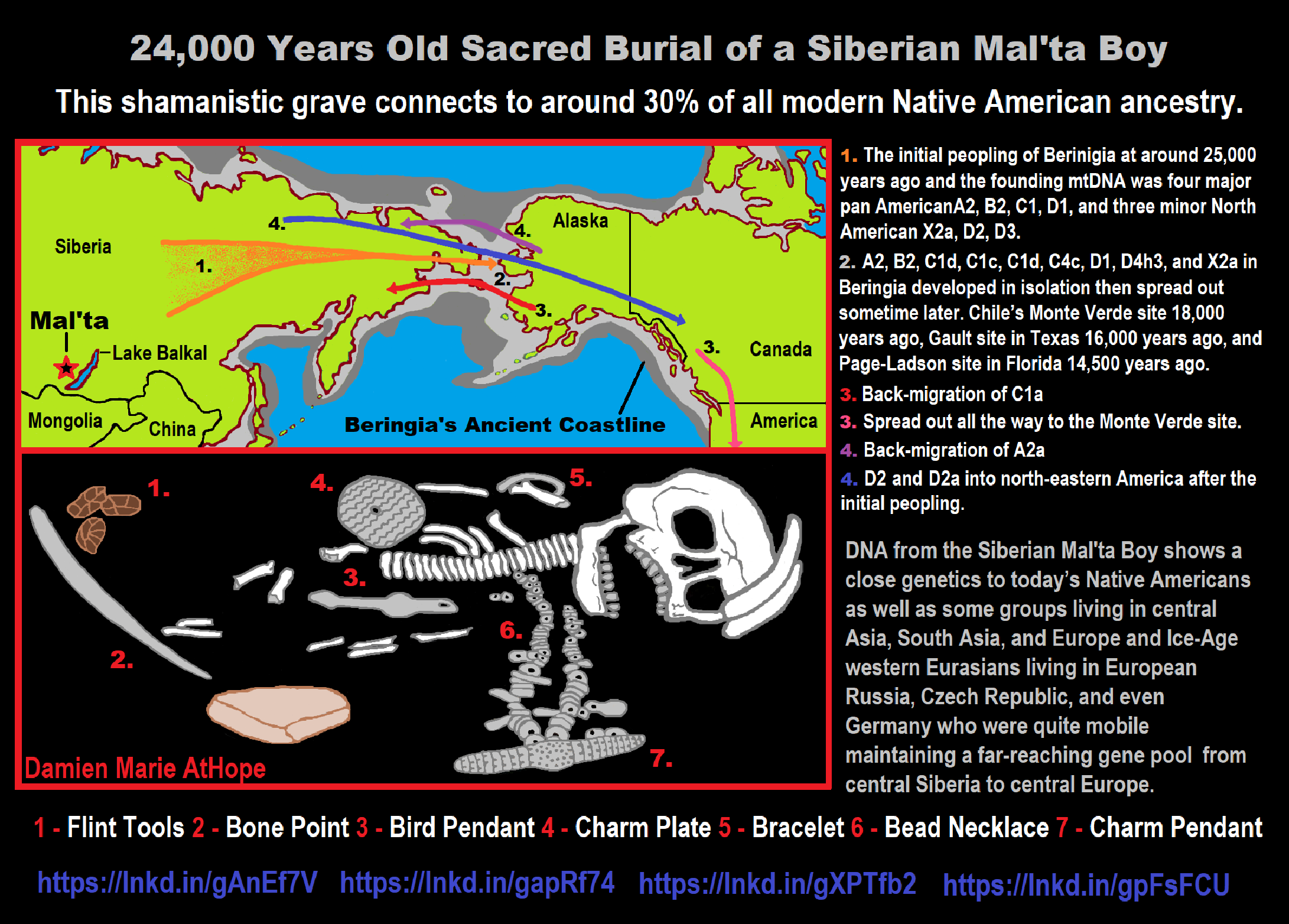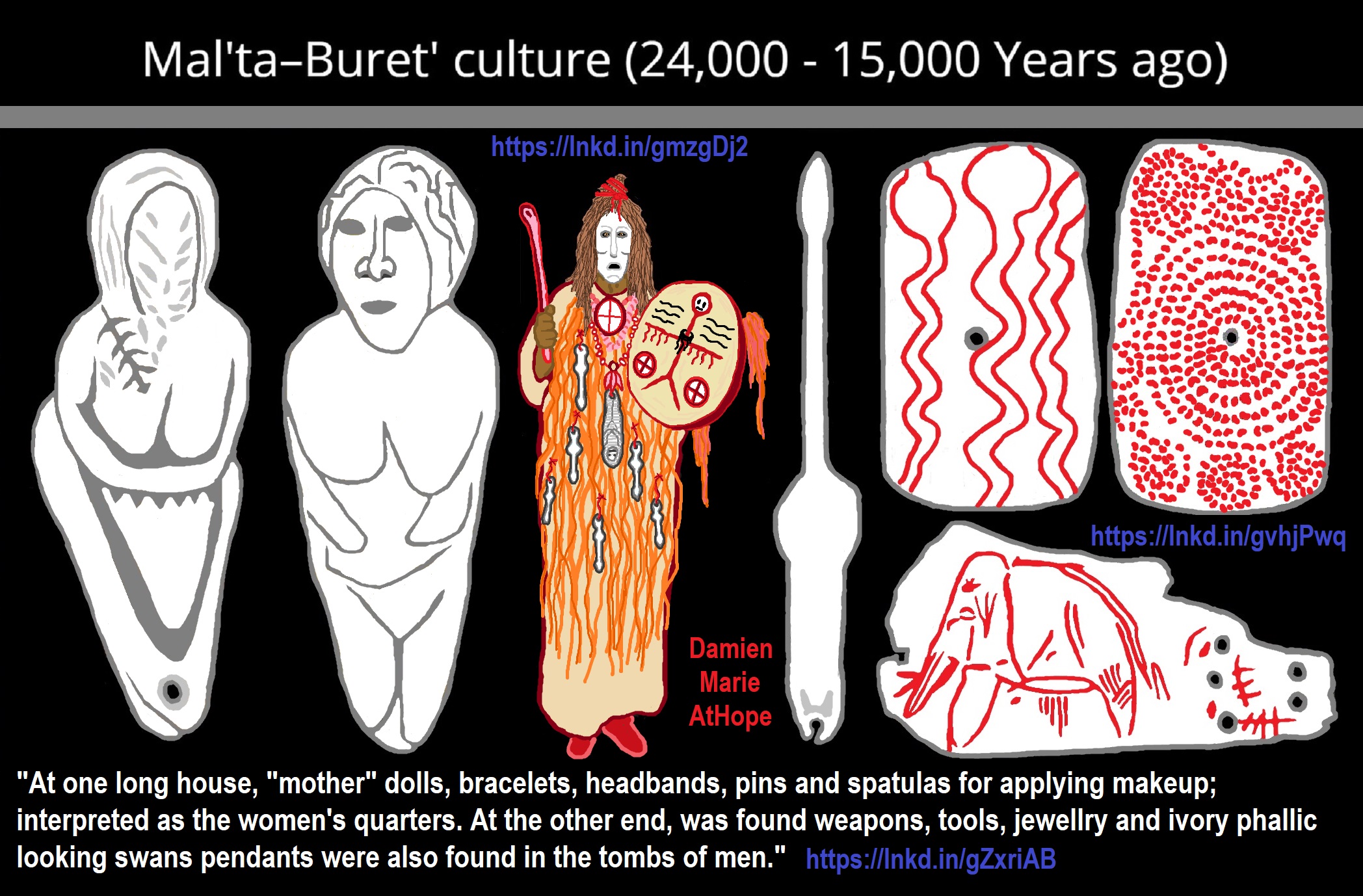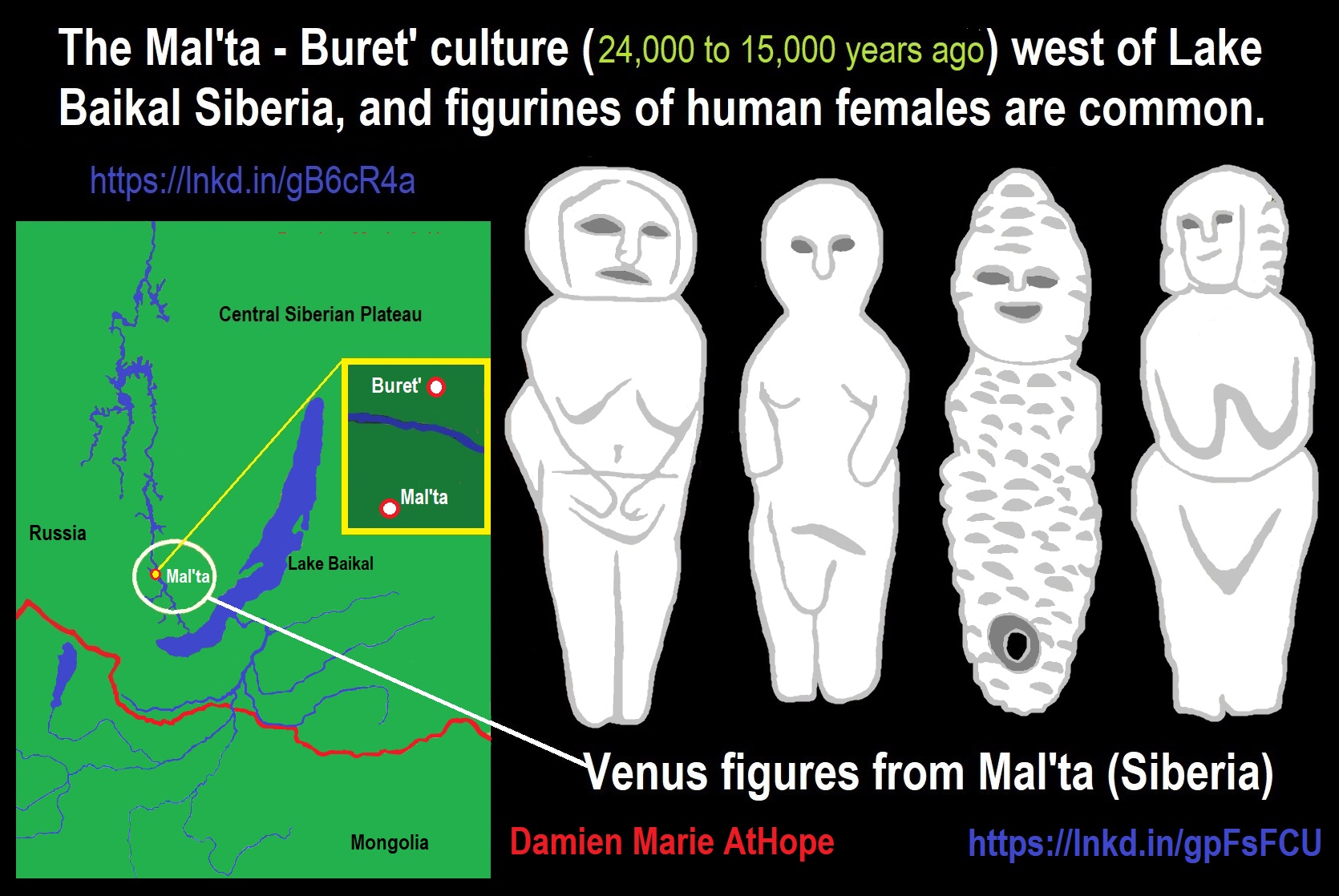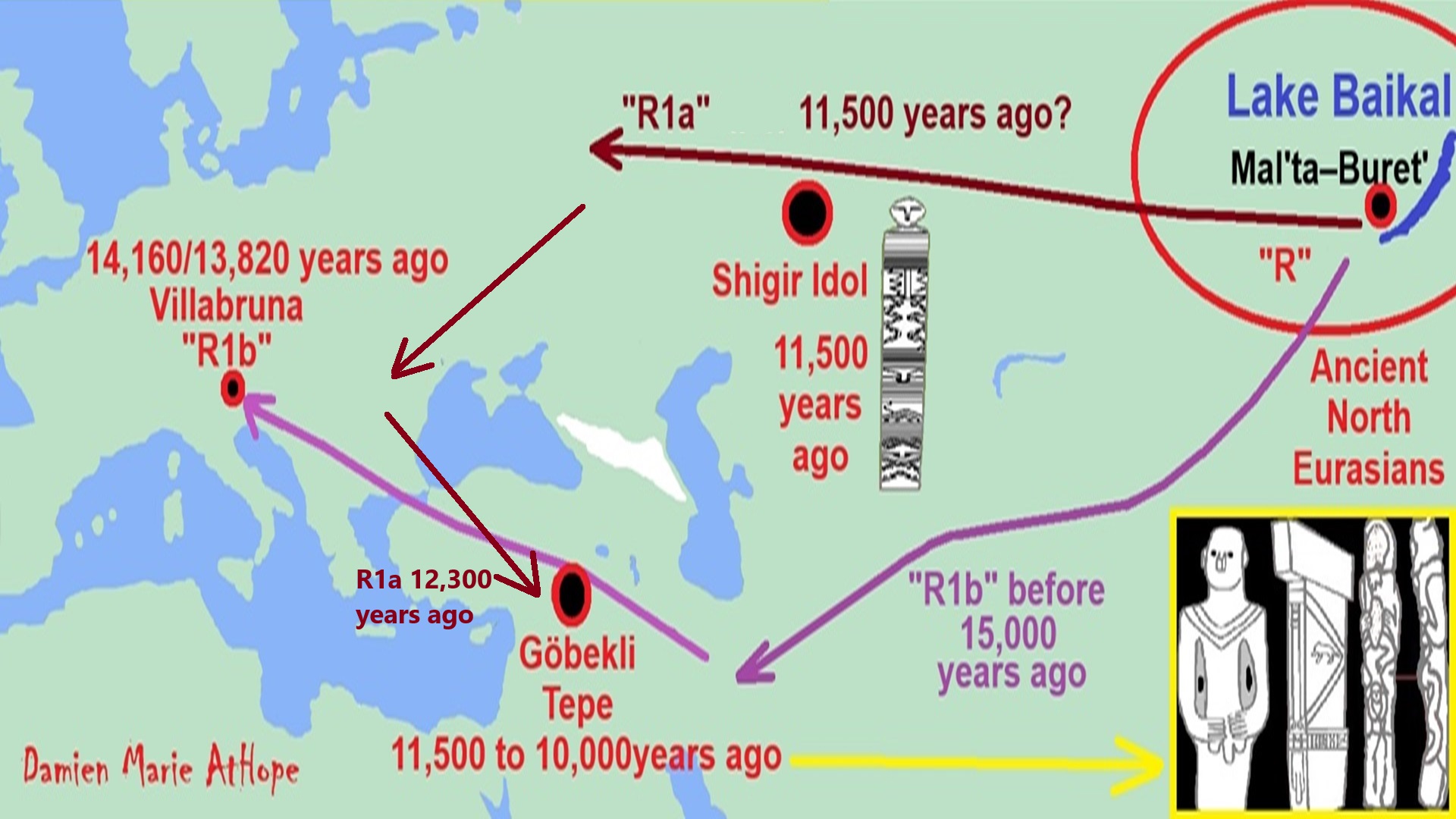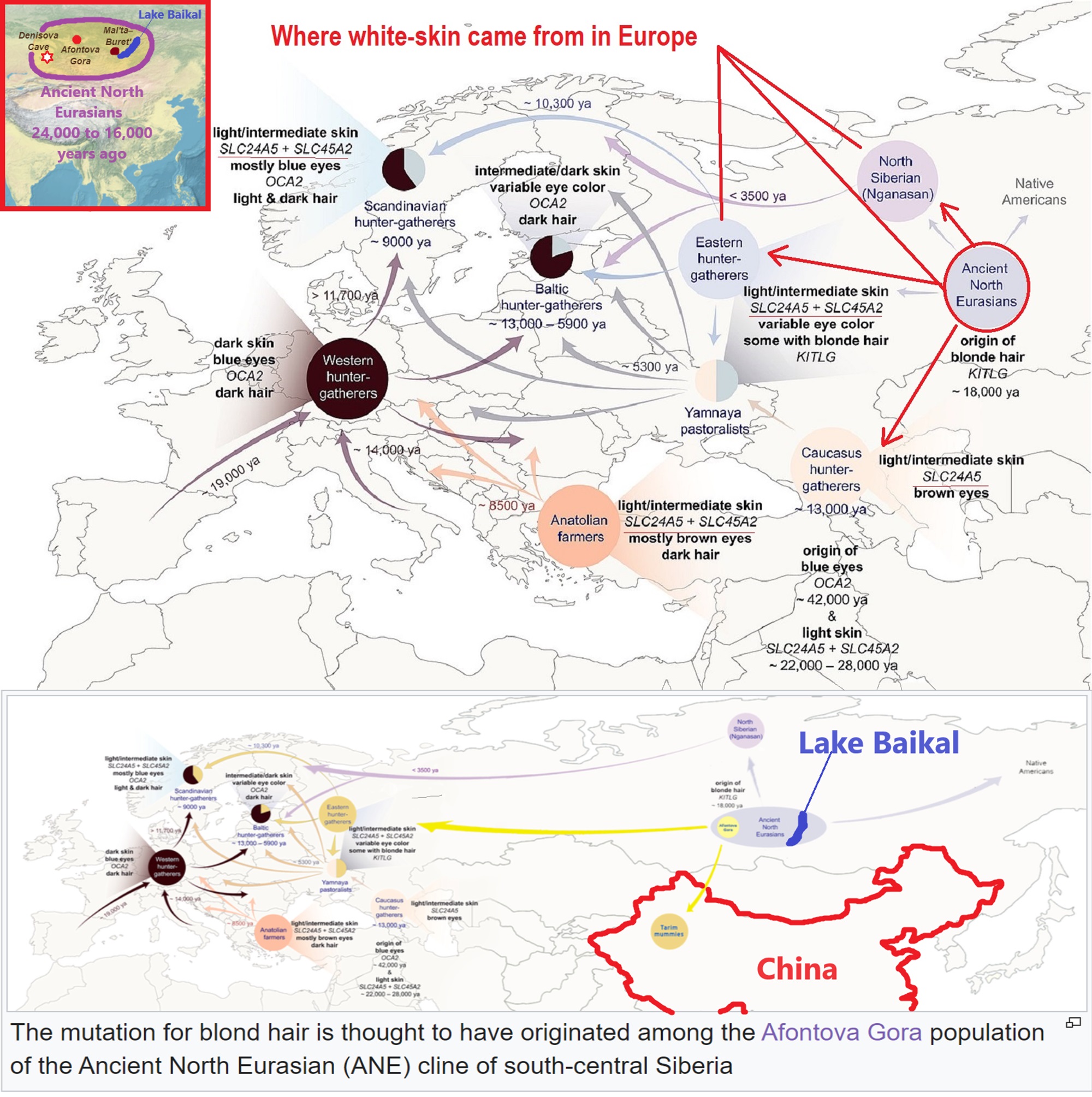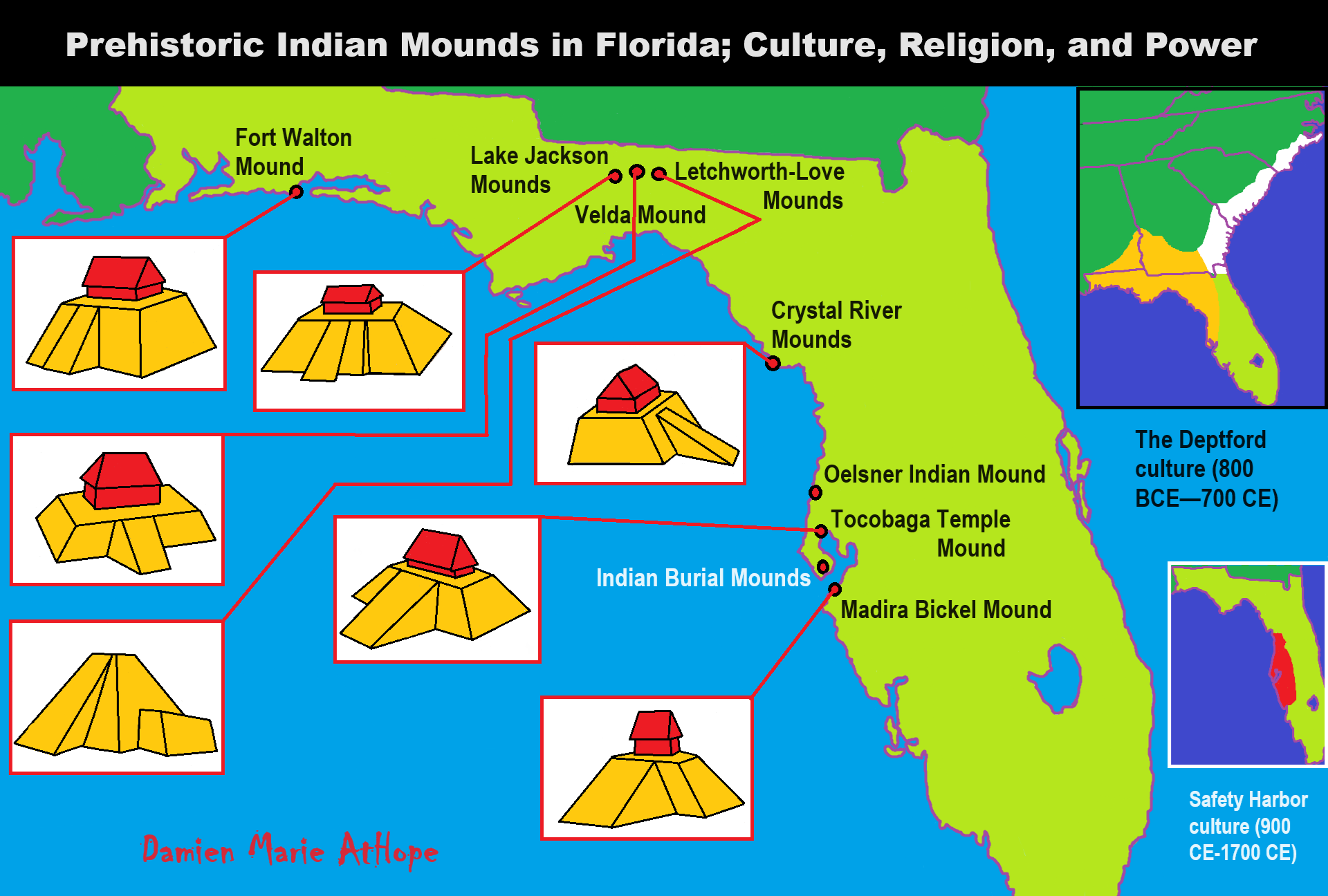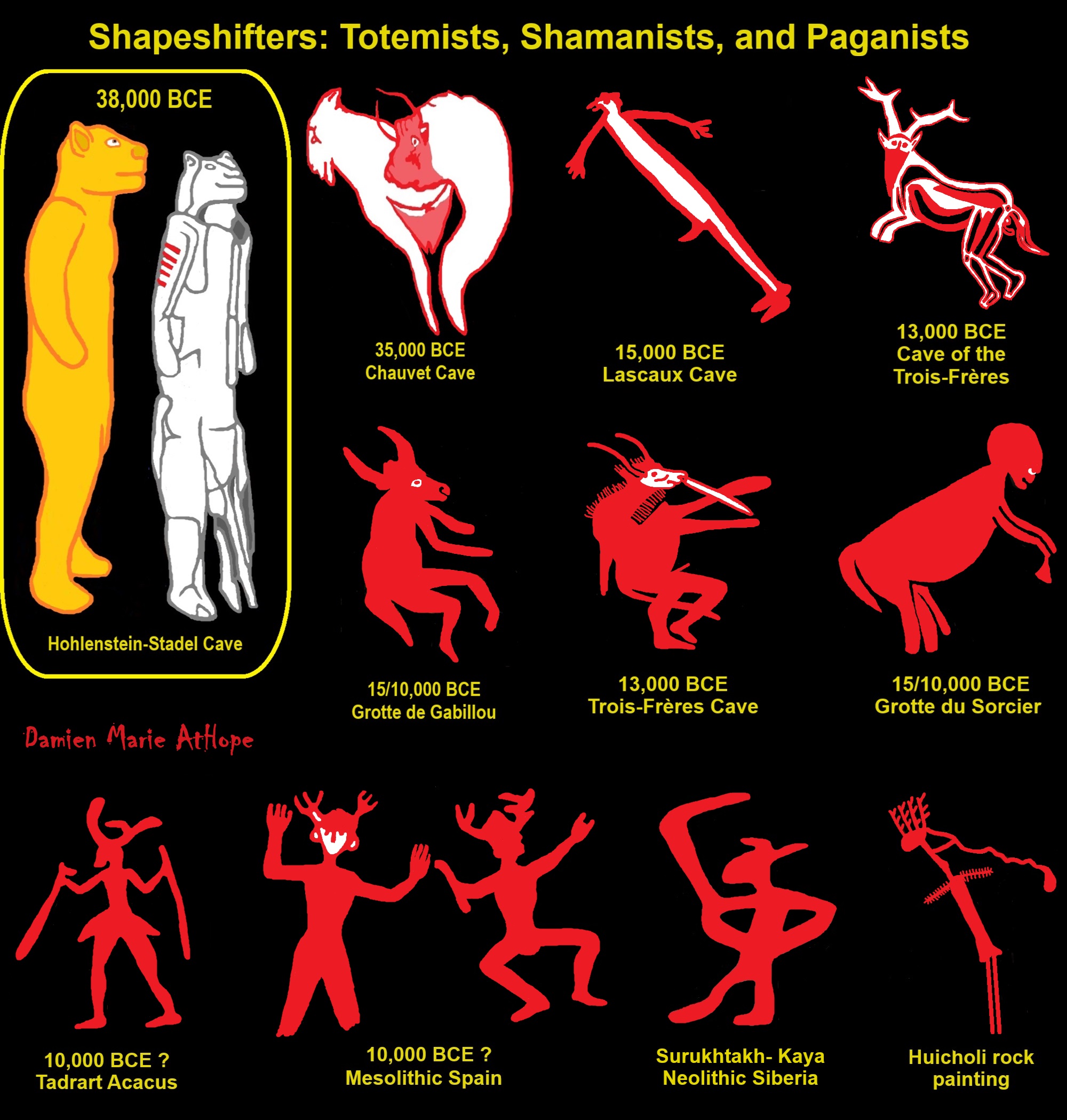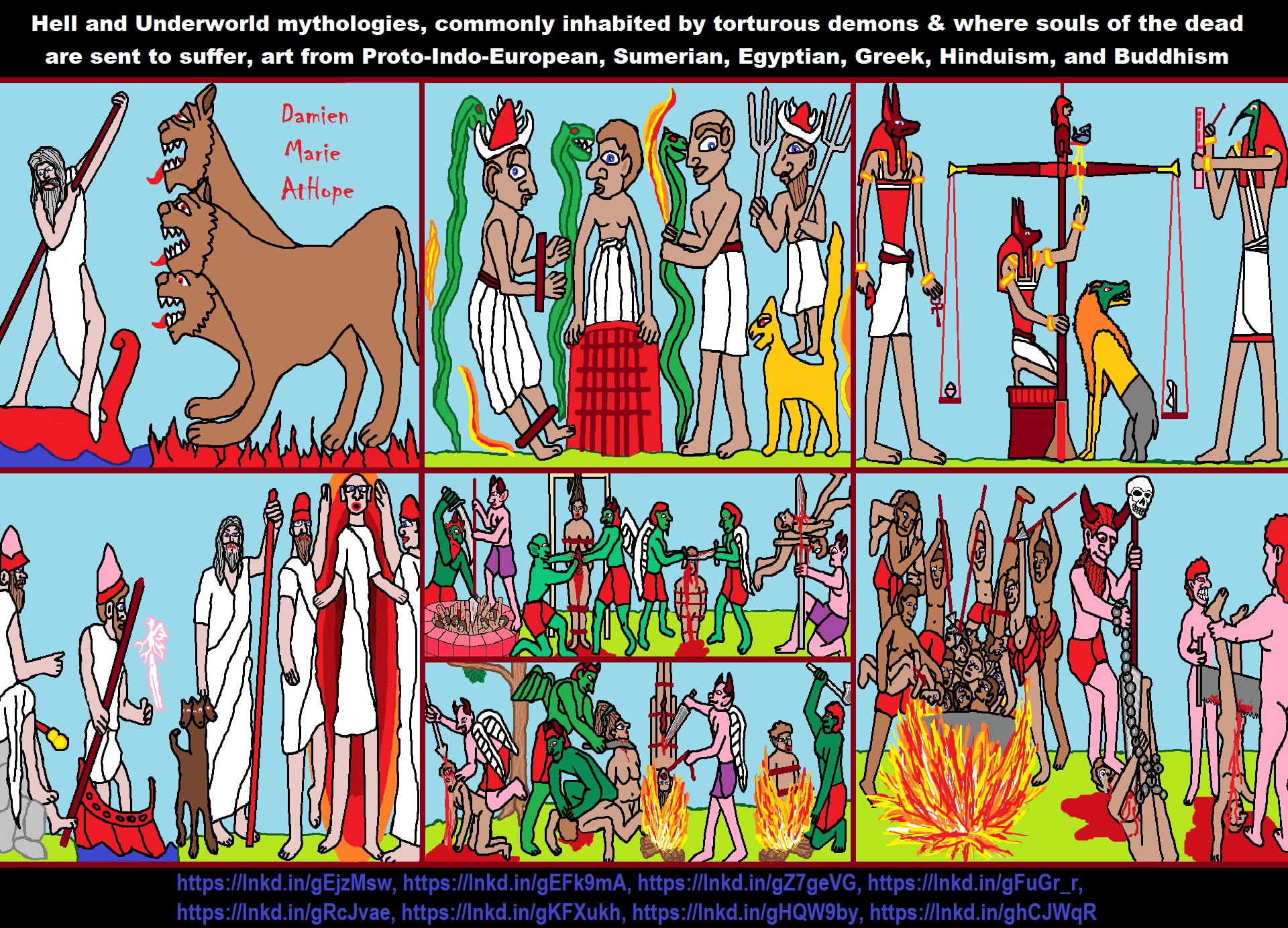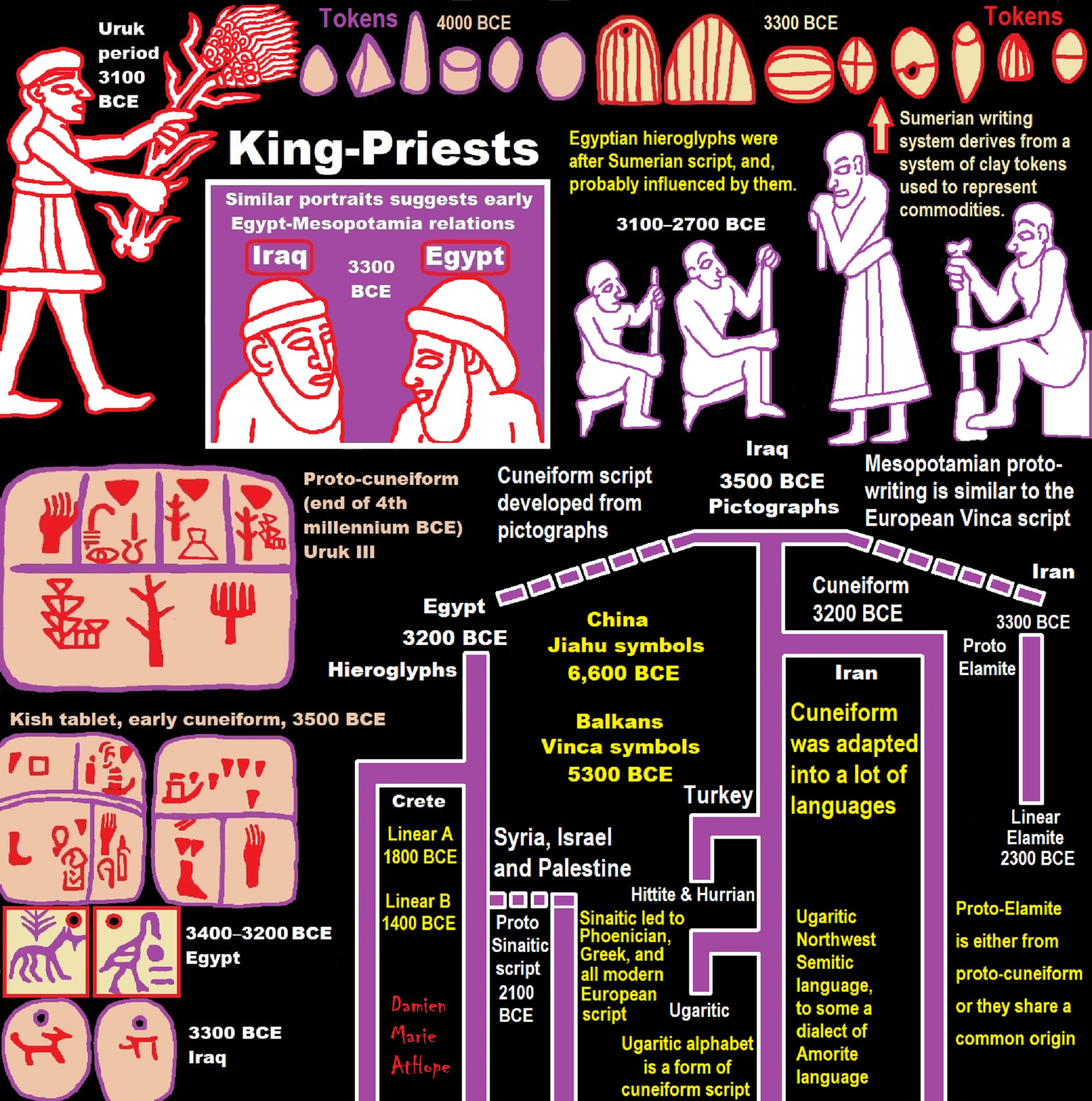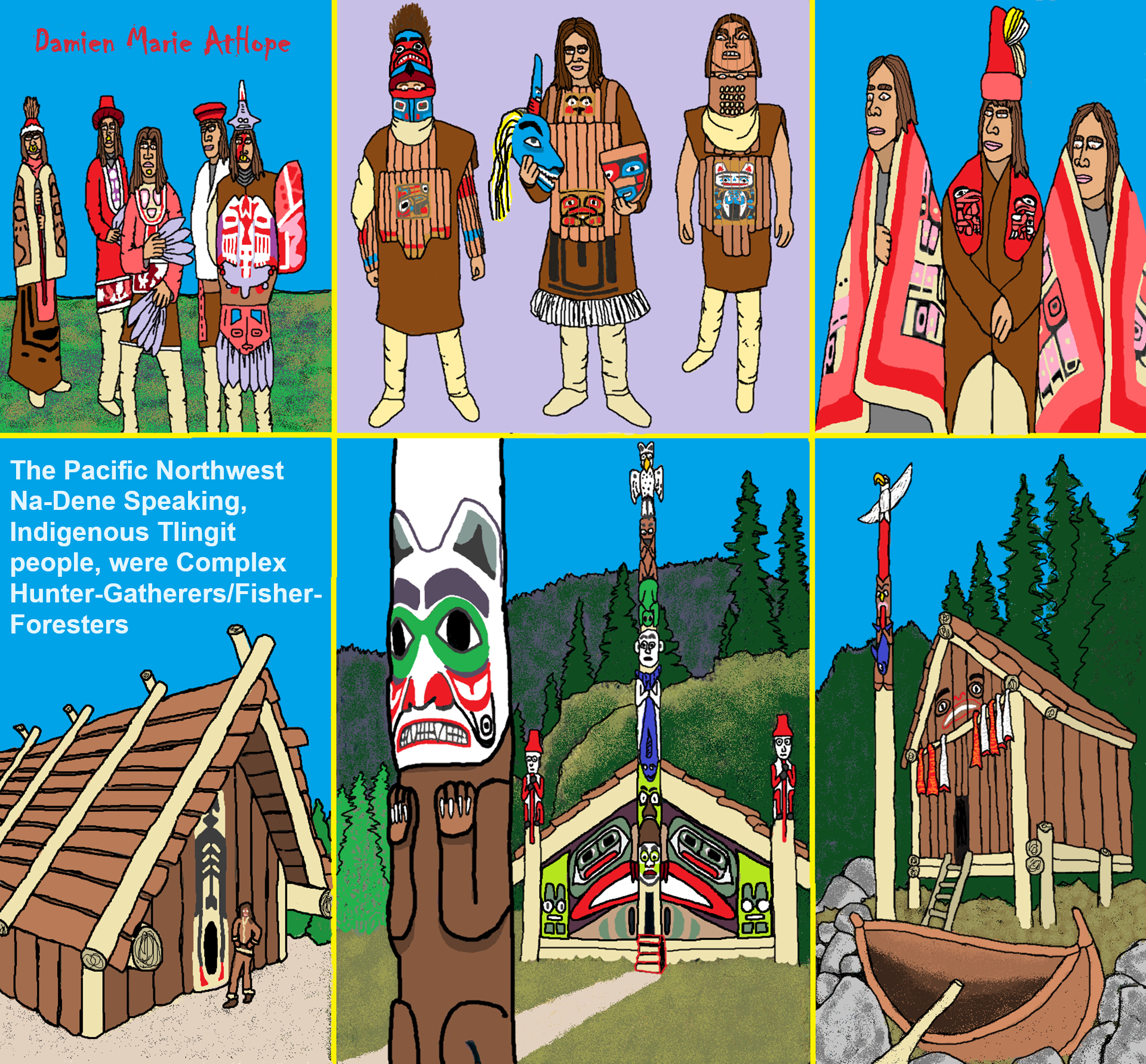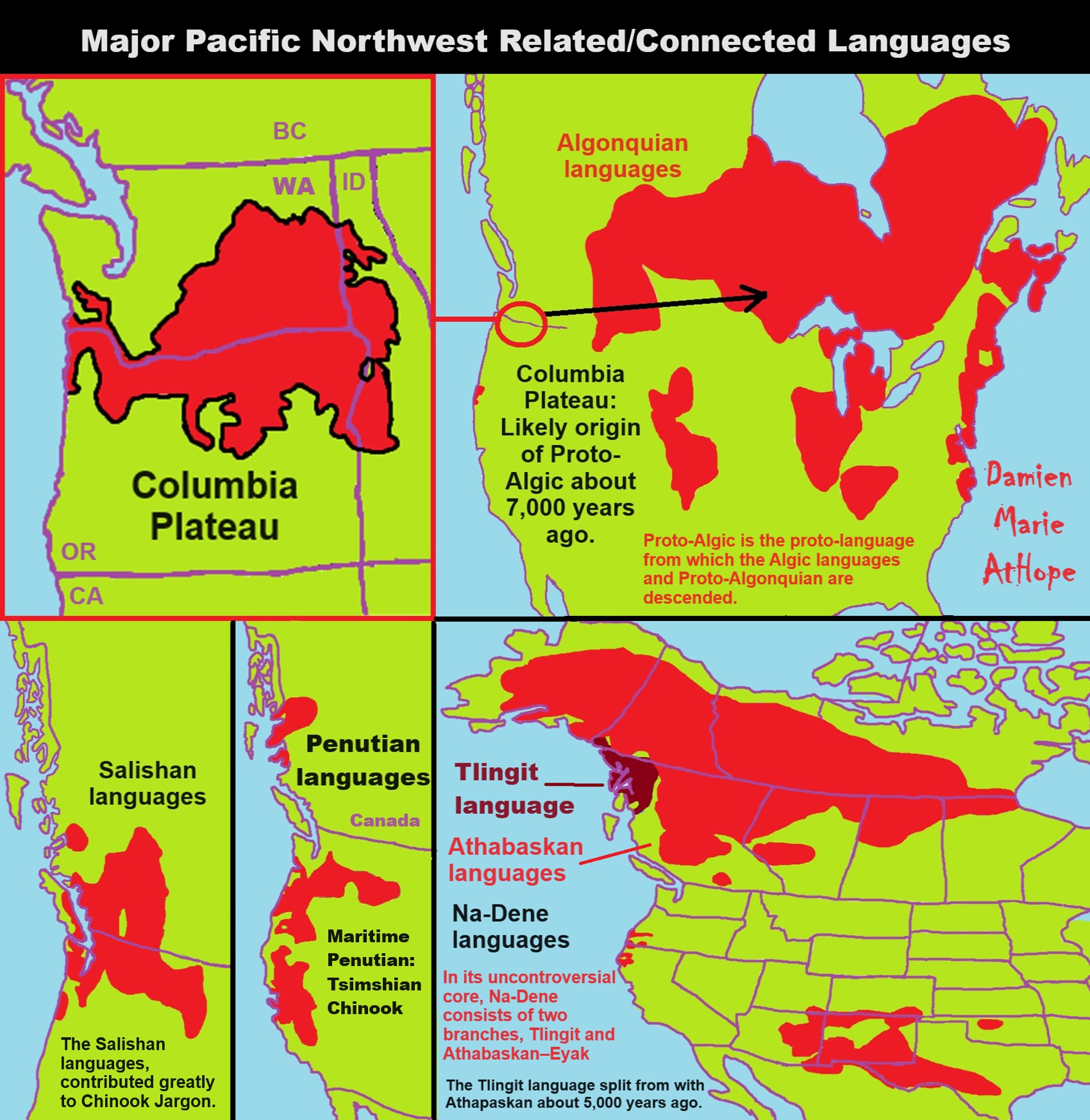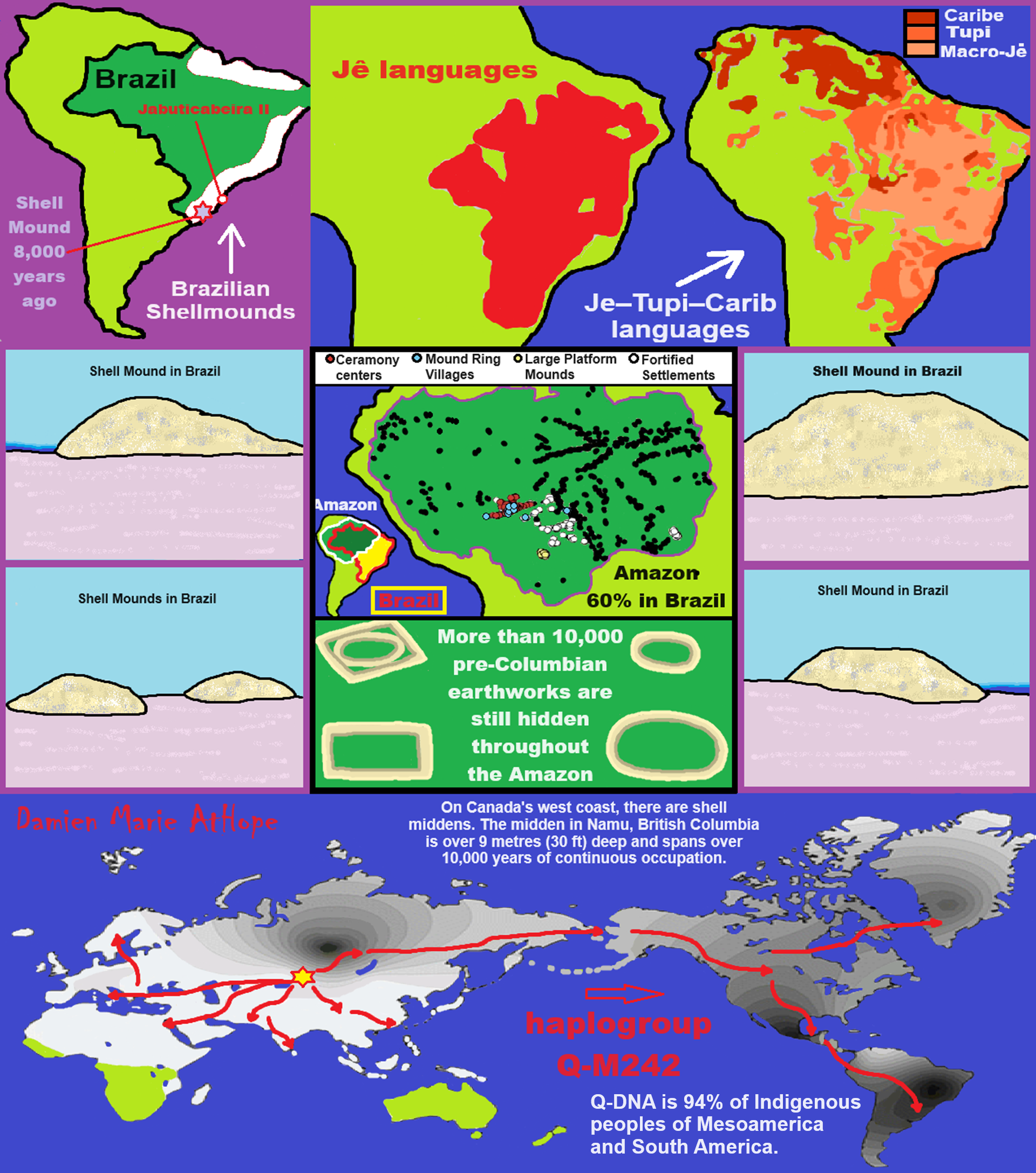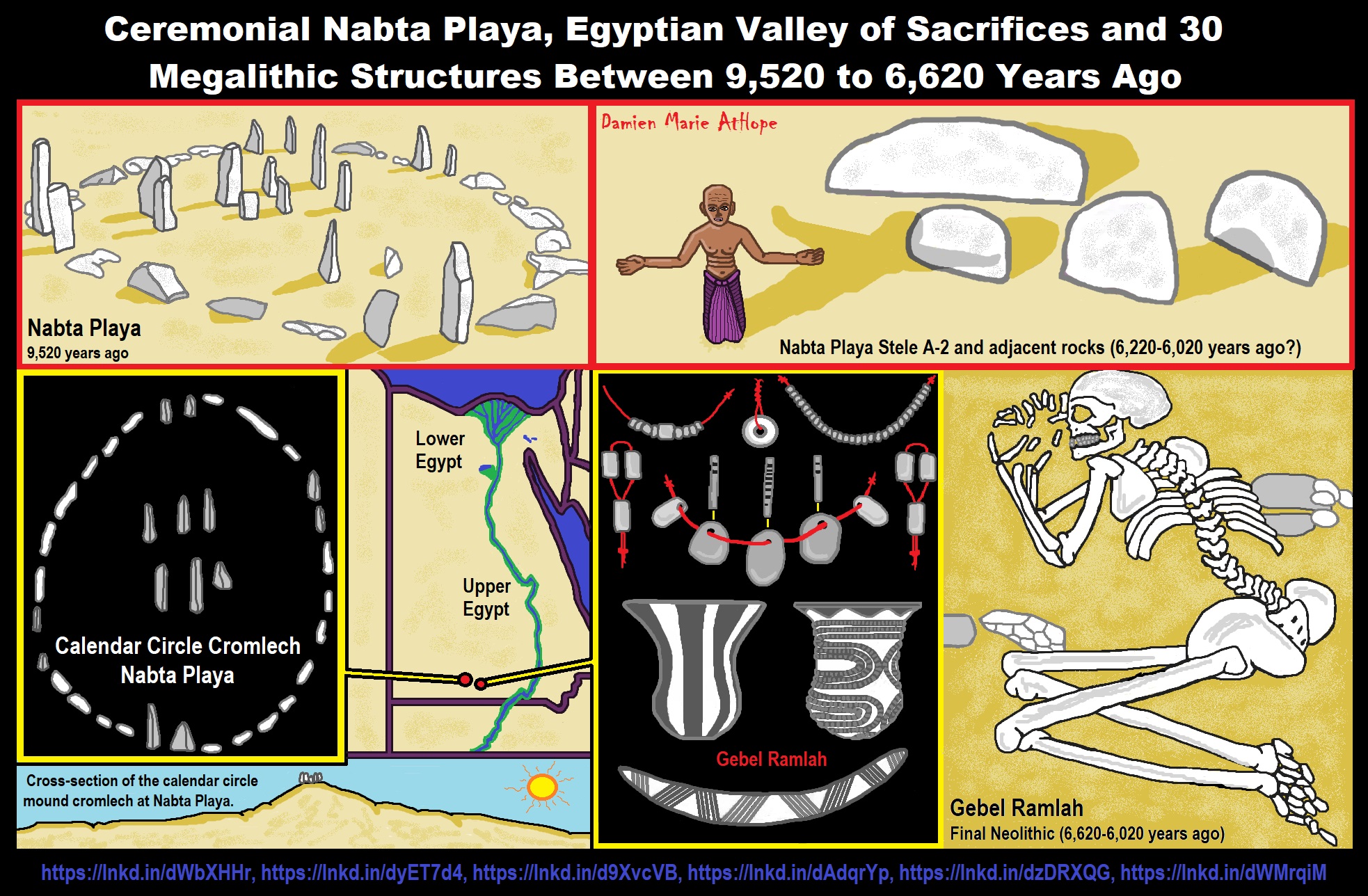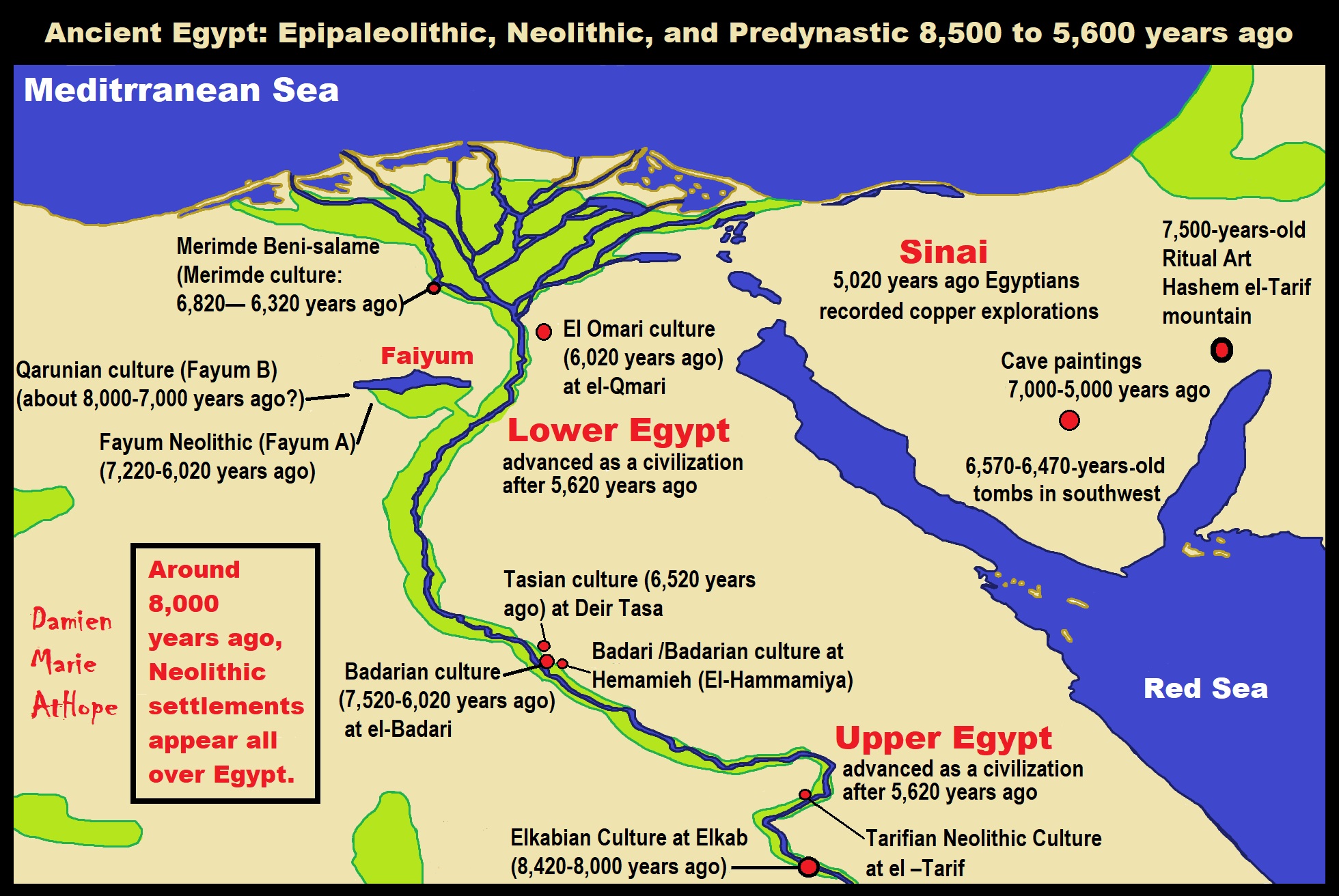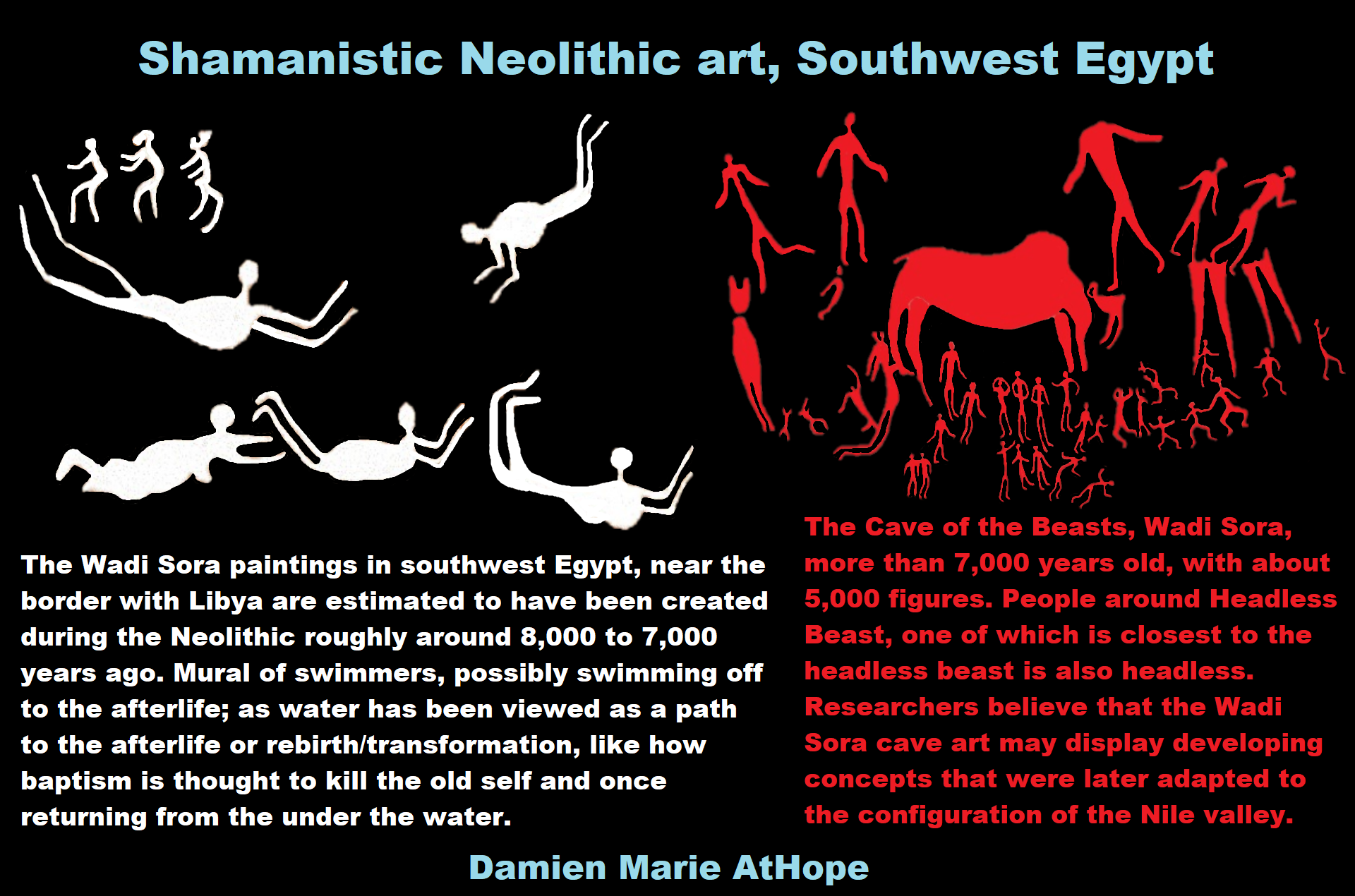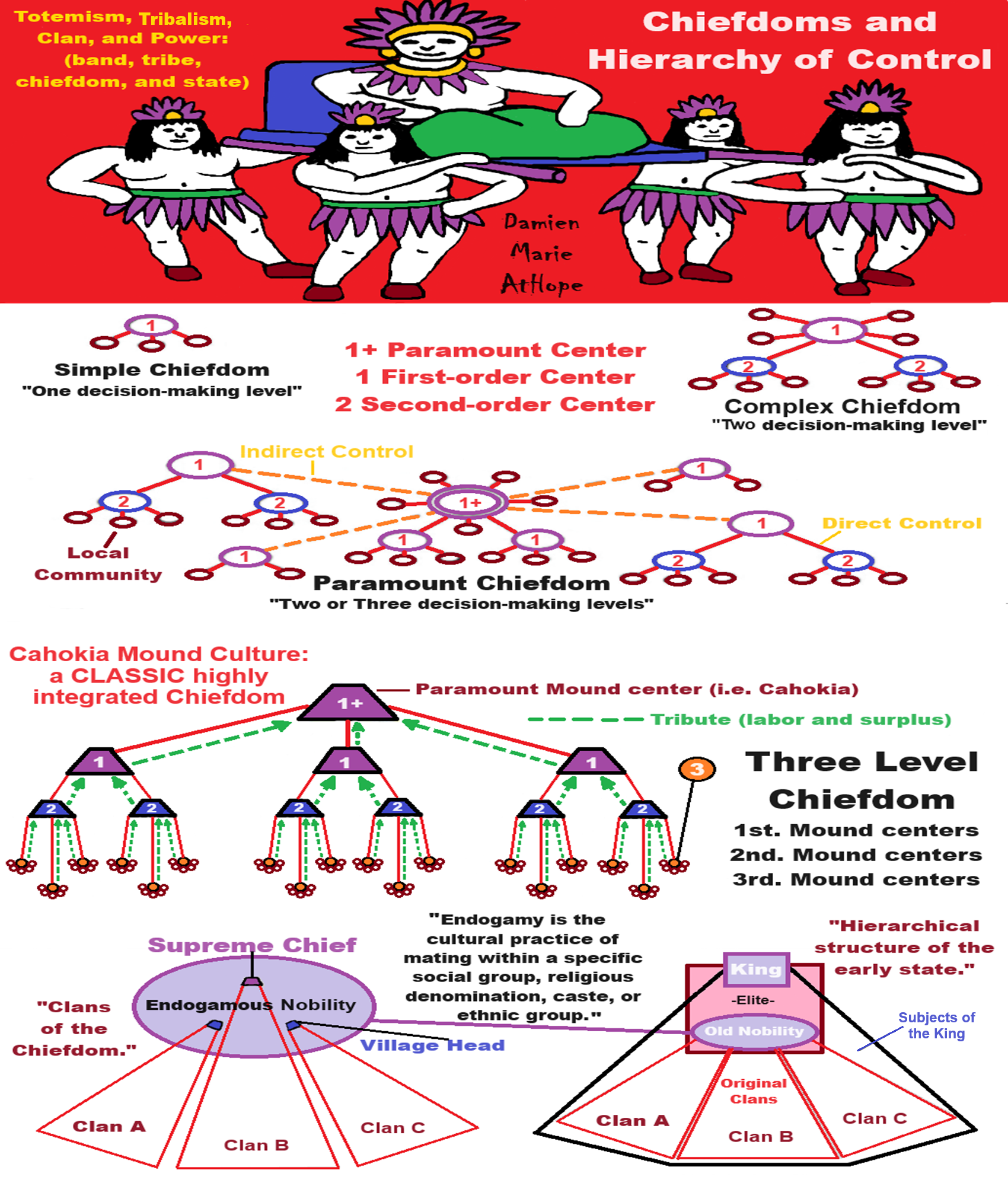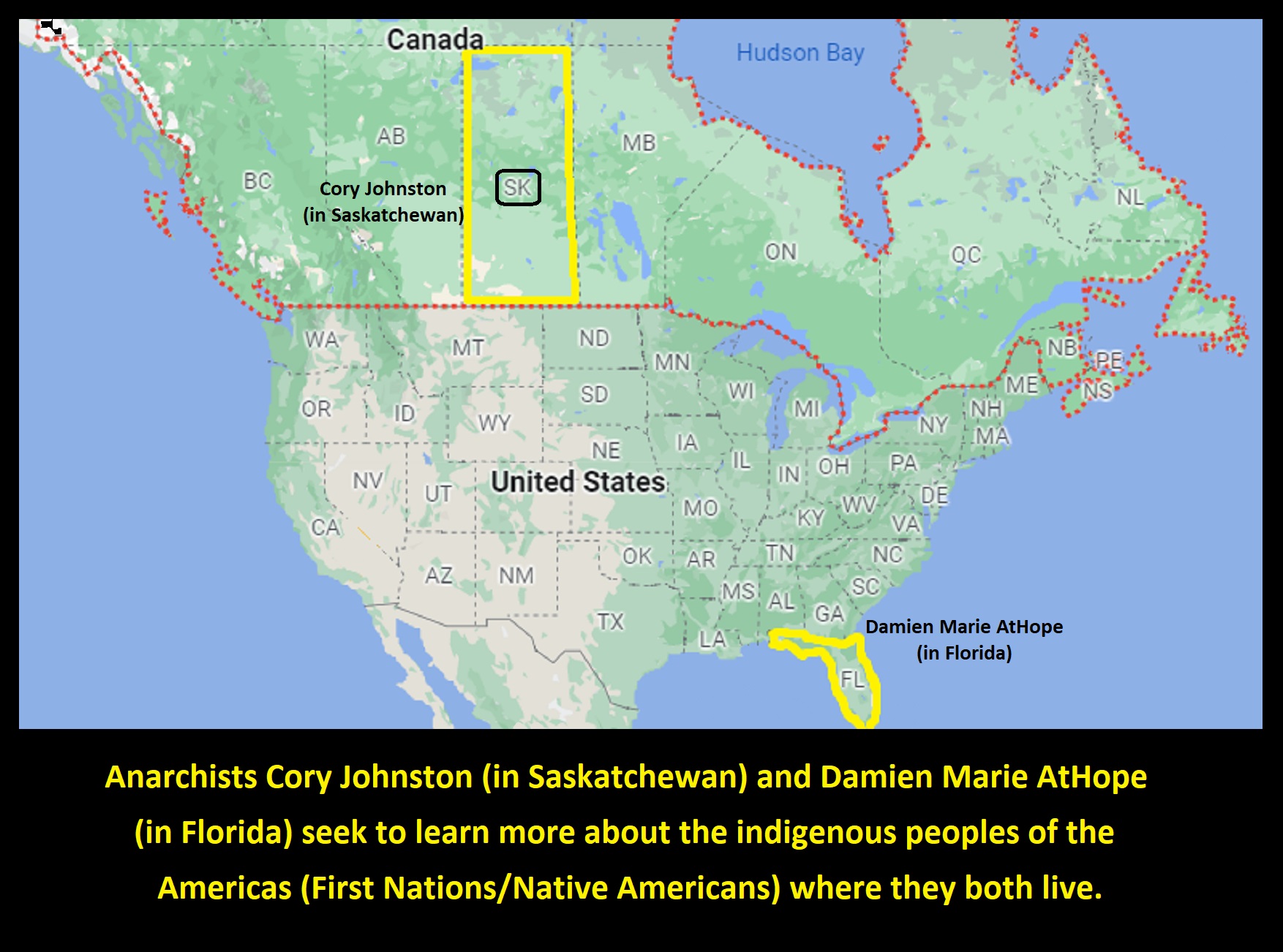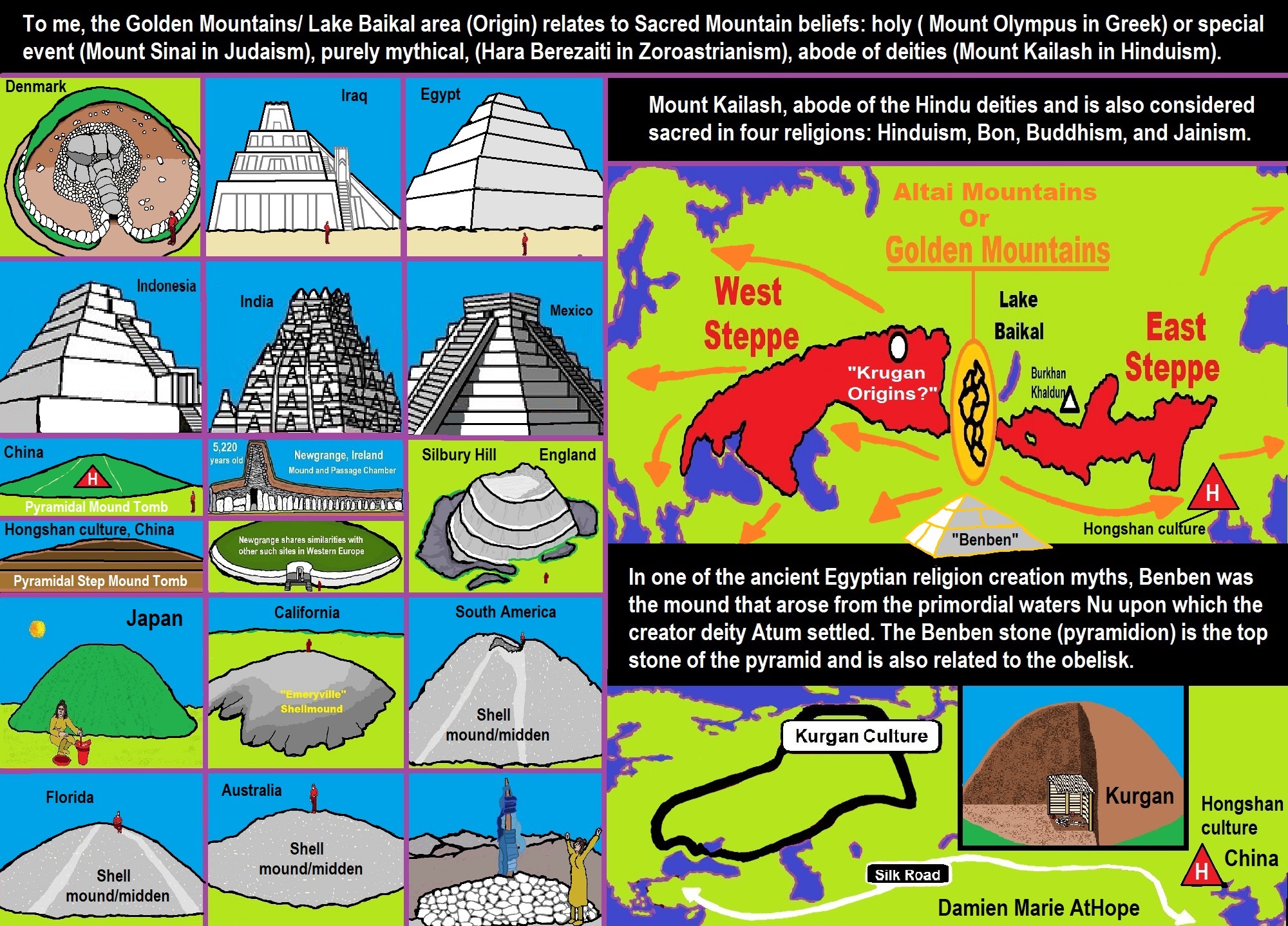
ref, ref, ref, ref, ref, ref, ref, ref, ref, ref, ref, ref, ref, ref, ref, ref, ref, ref, ref, ref, ref, ref, ref, ref
My Speculations are in Comparative Mythologies?
For instance, the mytheme of an ancient belief that is seemingly shared though changed and adapted, a fundamental generic unit of narrative structure seems to be shared a common relation with mountains/ancestors/gods or sacred animals with Sacred Mounds, Mountains, Kurgans, and Pyramids.
Sacred Mounds, Mountains, Kurgans, and Pyramids may hold deep Mythology connections?
Damien thinks the “Mound of Creation” mythology ((Axis Mundi) is a “myth” reason for mounds/pyramids.
Think ancient Hunter-Gathers were unskilled and primitive? Well, think again, because they were downright amazing! CHECK OUT THIS VIDEO: Primitive Technology: Woven bark fiber
Damien thinks Egypt and Sumerian mounds are connected and evolved somewhat related but different. A similar situation happened, to me, in the Americas. North started in mounds that later evolved into something Pryamid like. This is matched by Mesoamerica. Mounds later evolved into Pryamids. In Peru, Pryamids and mounds may have been transferred together or mounds quickly evolved into Pryamids.
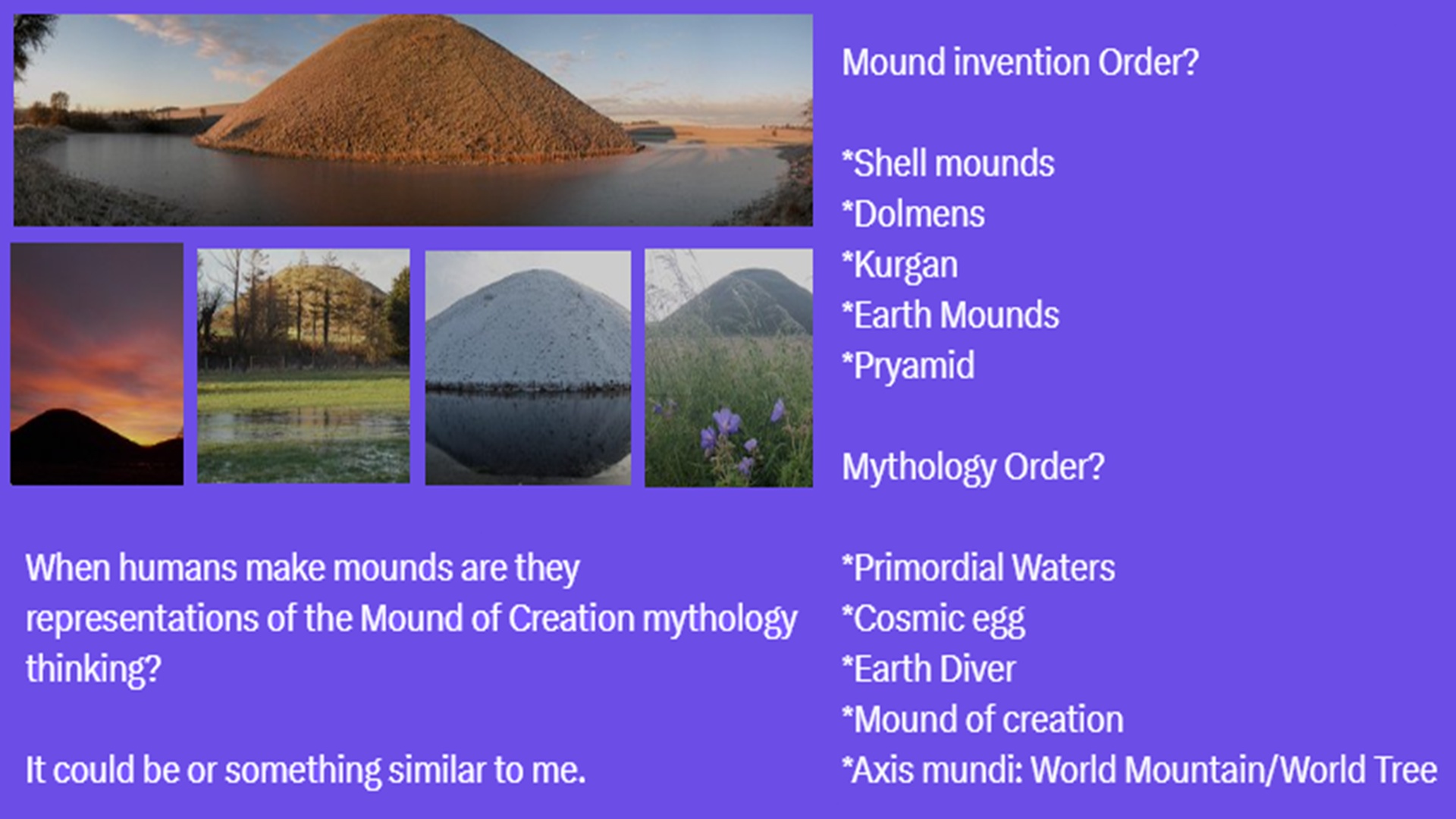
I am rather sure about the Mound order but not sure about the order of the mythology as mounds can be set in time by archaeology. To me, mounds relate mainly to the “Mound of Creation,” primeval mound/hill/mountain (that emerges out of water) or the “Axis Mundi” thinking: cosmic axis, world axis, world pillar, the center of the world, World tree, Sacred Mountain/World Mountain, etc. “(such as Mount Olympus in Greek mythology) or are related to famous events (like Mount Sinai in Judaism and descendant religions or Mount Kailash, Mount Meru in Hinduism). In some cases, the sacred mountain is purely mythical, like the Hara Berezaiti in Zoroastrianism. Mount Kailash is believed to be the abode of the deities Shiva and Parvati, and is considered sacred in four religions: Hinduism, Bon, Buddhism, and Jainism. Volcanoes, such as Mount Etna in Italy, were also considered sacred; Mount Etna is believed to have been the home of Vulcan, the Roman god of fire and the forge.” ref
I explain how all mounds shared similar myths and world views thus this is why so many seem similar. I explain how Ancient Egypt, Sumerians, and Hinduism all have something similar to a Mound of Creation, and what the Shell mounds/Kurgans/Dolmens/Earth Mounds/Pyramids relate. In Siberia/Americas it is more related to Earth Diver myths, but they also have animals build a Mound of Creation. Also, many Connect to the Axis mundi which can and often does relate to a world mountain/mound of creation.
Creation Myth
“A creation myth or cosmogonic myth is a type of cosmogony, a symbolic narrative of how the world began and how people first came to inhabit it. While in popular usage the term myth often refers to false or fanciful stories, members of cultures often ascribe varying degrees of truth to their creation myths. In the society in which it is told, a creation myth is usually regarded as conveying profound truths – metaphorically, symbolically, historically, or literally. They are commonly, although not always, considered cosmogonical myths – that is, they describe the ordering of the cosmos from a state of chaos or amorphousness.” ref
“Creation myths often share several features. They often are considered sacred accounts and can be found in nearly all known religious traditions. They are all stories with a plot and characters who are either deities, human-like figures, or animals, who often speak and transform easily. They are often set in a dim and nonspecific past that historian of religion Mircea Eliade termed in illo tempore (‘at that time’). Creation myths address questions deeply meaningful to the society that shares them, revealing their central worldview and the framework for the self-identity of the culture and individual in a universal context. Creation myths develop in oral traditions and therefore typically have multiple versions; found throughout human culture, they are the most common form of myth.” ref
“Creation myth definitions from modern references:
- A “symbolic narrative of the beginning of the world as understood in a particular tradition and community. Creation myths are of central importance for the valuation of the world, for the orientation of humans in the universe, and for the basic patterns of life and culture.”
- “Creation myths tell us how things began. All cultures have creation myths; they are our primary myths, the first stage in what might be called the psychic life of the species. As cultures, we identify ourselves through the collective dreams we call creation myths, or cosmogonies. … Creation myths explain in metaphorical terms our sense of who we are in the context of the world, and in so doing they reveal our real priorities, as well as our real prejudices. Our images of creation say a great deal about who we are.”
- A “philosophical and theological elaboration of the primal myth of creation within a religious community. The term myth here refers to the imaginative expression in narrative form of what is experienced or apprehended as basic reality … The term creation refers to the beginning of things, whether by the will and act of a transcendent being, by emanation from some ultimate source, or in any other way.” ref
“Religion professor Mircea Eliade defined the word myth in terms of creation:
Myth narrates a sacred history; it relates an event that took place in primordial Time, the fabled time of the “beginnings.” In other words, myth tells how, through the deeds of Supernatural Beings, a reality came into existence, be it the whole of reality, the Cosmos, or only a fragment of reality – an island, a species of plant, a particular kind of human behavior, an institution.” ref
“Creation myths have been around since ancient history and have served important societal roles. Over 100 “distinct” ones have been discovered. All creation myths are in one sense etiological because they attempt to explain how the world formed and where humanity came from. Myths attempt to explain the unknown and sometimes teach a lesson. Ethnologists and anthropologists who study origin myths say that in the modern context theologians try to discern humanity’s meaning from revealed truths and scientists investigate cosmology with the tools of empiricism and rationality, but creation myths define human reality in very different terms.” ref
“In the past, historians of religion and other students of myth thought of such stories as forms of primitive or early-stage science or religion and analyzed them in a literal or logical sense. Today, however, they are seen as symbolic narratives which must be understood in terms of their own cultural context. Charles Long writes: “The beings referred to in the myth – gods, animals, plants – are forms of power grasped existentially. The myths should not be understood as attempts to work out a rational explanation of deity.” ref
“While creation myths are not literal explications, they do serve to define an orientation of humanity in the world in terms of a birth story. They provide the basis of a worldview that reaffirms and guides how people relate to the natural world, to any assumed spiritual world, and to each other. A creation myth acts as a cornerstone for distinguishing primary reality from relative reality, the origin and nature of being from non-being. In this sense cosmogonic myths serve as a philosophy of life – but one expressed and conveyed through symbol rather than through systematic reason. And in this sense they go beyond etiological myths (which explain specific features in religious rites, natural phenomena, or cultural life). Creation myths also help to orient human beings in the world, giving them a sense of their place in the world and the regard that they must have for humans and nature.” ref
“Historian David Christian has summarised issues common to multiple creation myths:
How did everything begin? This is the first question faced by any creation myth and … answering it remains tricky. … Each beginning seems to presuppose an earlier beginning. … Instead of meeting a single starting point, we encounter an infinity of them, each of which poses the same problem. … There are no entirely satisfactory solutions to this dilemma. What we have to find is not a solution but some way of dealing with the mystery …. And we have to do so using words. The words we reach for, from God to gravity, are inadequate to the task. So we have to use language poetically or symbolically; and such language, whether used by a scientist, a poet, or a shaman, can easily be misunderstood.” ref
“Mythologists have applied various schemes to classify creation myths found throughout human cultures. Eliade and his colleague Charles Long developed a classification based on some common motifs that reappear in stories the world over. The classification identifies five basic types:
Brahmā, the Hindu deva of creation, emerges from a lotus risen from the navel of Viṣņu, who lies with Lakshmi on the serpent Ananta Shesha.” ref
- Creation ex nihilo in which the creation is through the thought, word, dream, or bodily secretions of a divine being.
- Earth-diver creation in which a diver, usually a bird or amphibian sent by a creator, plunges to the seabed through a primordial ocean to bring up sand or mud which develops into a terrestrial world.
- Emergence myths in which progenitors pass through a series of worlds and metamorphoses until reaching the present world.
- Creation by the dismemberment of a primordial being.
- Creation by the splitting or ordering of a primordial unity such as the cracking of a cosmic egg or a bringing order from chaos.” ref
“Marta Weigle further developed and refined this typology to highlight nine themes, adding elements such as deus faber, a creation crafted by a deity, creation from the work of two creators working together or against each other, creation from sacrifice and creation from division/conjugation, accretion/conjunction, or secretion.” ref
“An alternative system based on six recurring narrative themes was designed by Raymond Van Over:
- Primeval abyss, an infinite expanse of waters or space
- Originator deity which is awakened or an eternal entity within the abyss
- Originator deity poised above the abyss
- Cosmic egg or embryo
- Originator deity creating life through sound or word
- Life generating from the corpse or dismembered parts of an originator deity.” ref

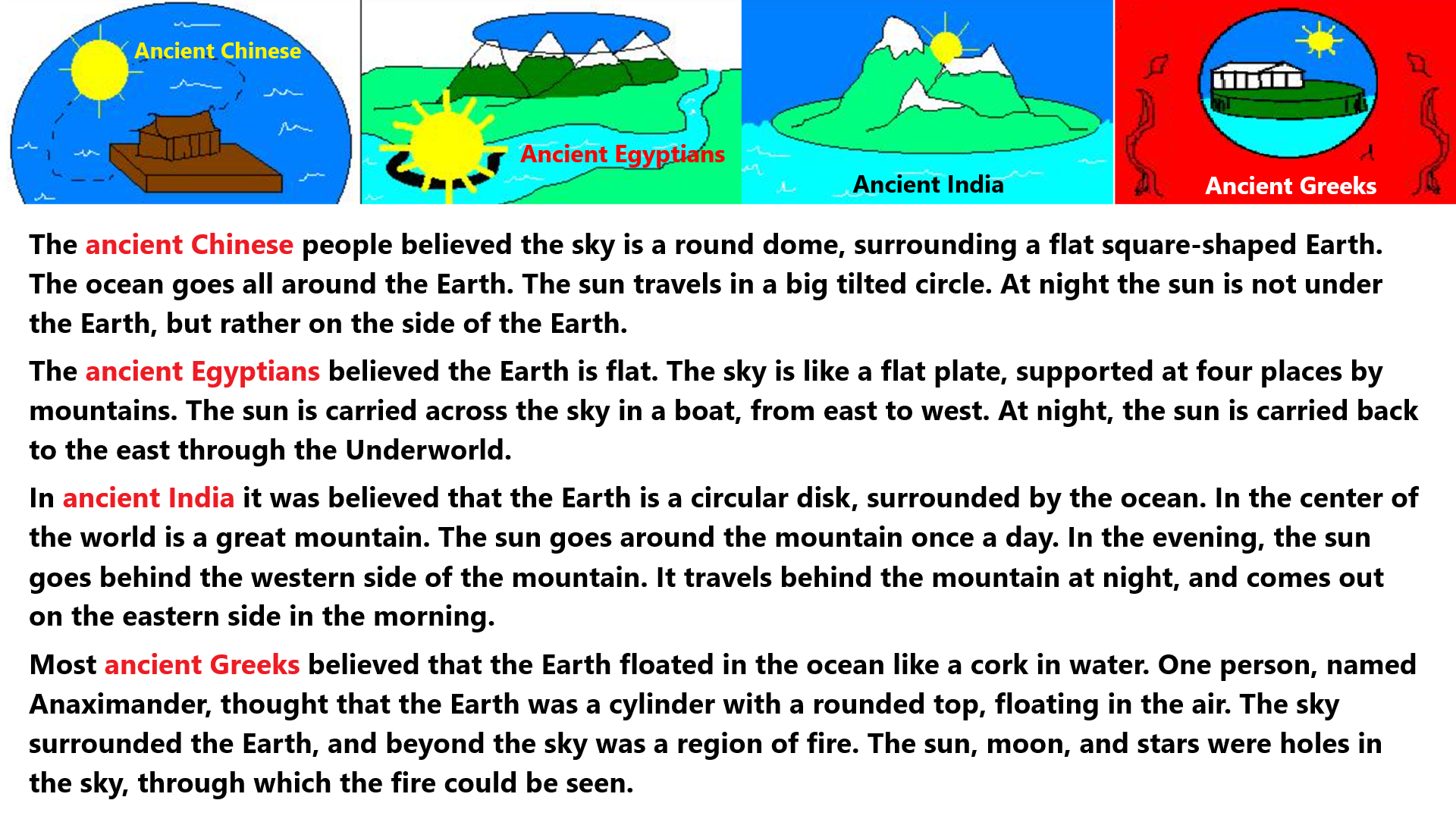
Flat Earth Mythology (a kind of square base for a mound/pyramid)?
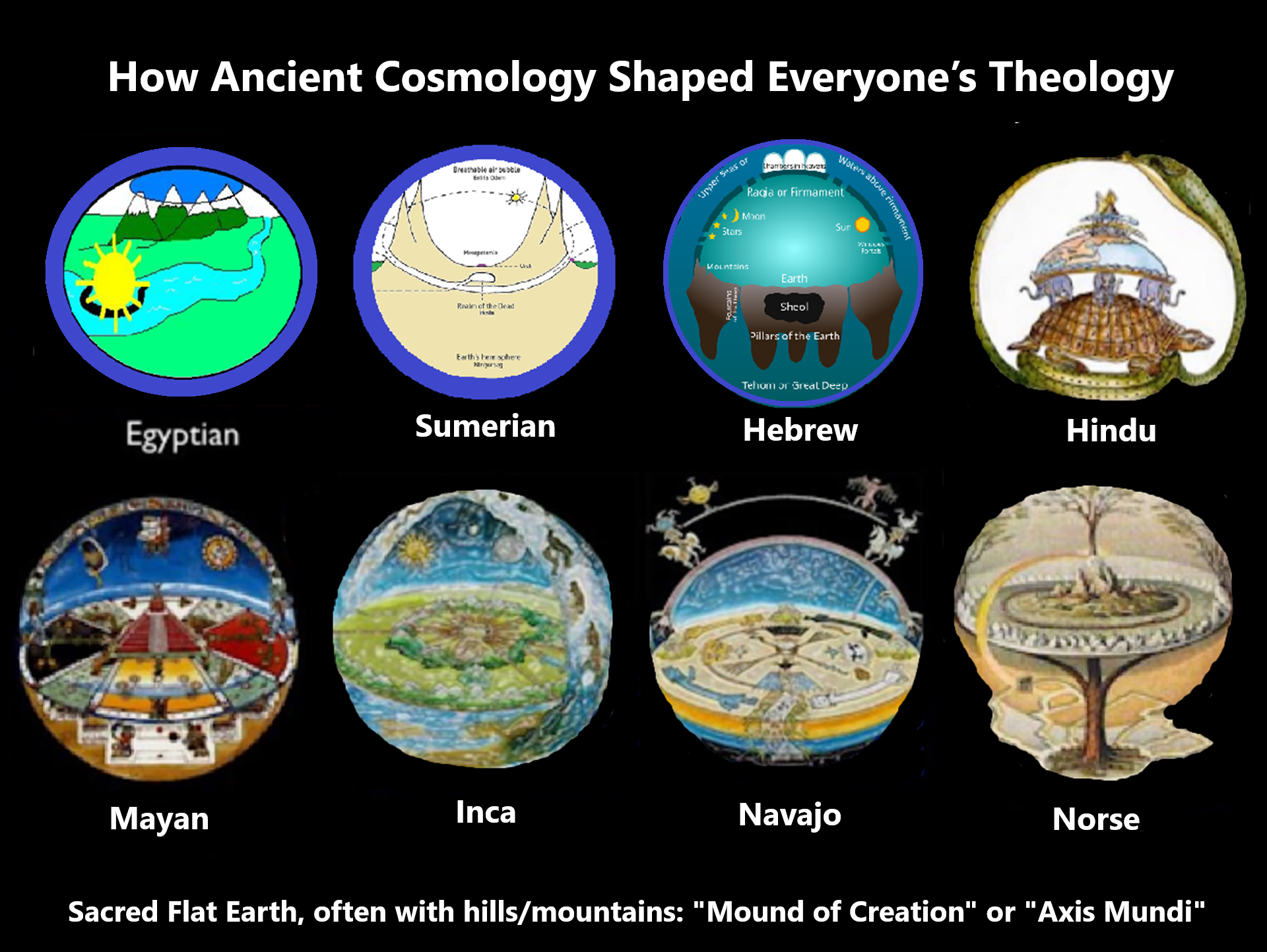
Ancient Cosmology Shaped Everyone’s Theology
Sacred Flat Earth, often with hills/mountains: “Mound of Creation” or “Axis Mundi.”
“Cosmology in the ancient Near East (ANE) refers to the plurality of cosmological beliefs in the Ancient Near East, covering the period from the 4th millennium BCE to the formation of the Macedonian Empire by Alexander the Great in the second half of the 1st millennium BCE. These beliefs include the Mesopotamian cosmologies from Babylonia, Sumer, and Akkad; the Levantine or West Semitic cosmologies from Ugarit and ancient Israel and Judah (the biblical cosmology); the Egyptian cosmology from Ancient Egypt; and the Anatolian cosmologies from the Hittites. This system of cosmology went on to have a profound influence on views in early Greek cosmology, later Jewish cosmology, patristic cosmology, and Islamic cosmology (including Quranic cosmology). Until the modern era, variations of ancient near eastern cosmology survived with Hellenistic cosmology as the main competing system. Ancient near eastern cosmology can be divided into its cosmography, the physical structure and features of the cosmos; and cosmogony, the creation myths that describe the origins of the cosmos in the texts and traditions of the ancient near eastern world. The cosmos and the gods were also related, as cosmic bodies like heaven, earth, the stars were believed to be and/or personified as gods, and the sizes of the gods were frequently described as being of cosmic proportions.” ref
Cosmography
“Ancient Near Eastern civilizations held to a fairly uniform conception of cosmography. This cosmography remained remarkably stable in the context of the expansiveness and longevity of the ancient Near East, but changes were also to occur. Widely held components of ancient near eastern cosmography included:
- a flat earth and a solid heaven (firmament), both of which are disk-shaped
- a primordial cosmic ocean. When the firmament is created, it separates the cosmic ocean into two bodies of water:
- the heavenly upper waters located on top of the firmament, which act as a source of rain
- the lower waters that the earth is above and that the earth rests on; they act as the source of rivers, springs, and other earthly bodies of water
- the region above the upper waters, namely the abode of the gods
- the netherworld, the furthest region in the direction downwards, below the lower waters.” ref
“Keyser, categorizing ancient near eastern cosmology as belonging to a larger and more cross-cultural set of cosmologies he describes as a “cradle cosmology,” offers a longer list of shared features. Some cosmographical features have been misattributed to Mesopotamian cosmologies, including the idea that ziggurats represented cosmic objects reaching up to heaven or the idea of a dome- or vault-shaped (as opposed to a flat) firmament. Another controversy concerns if the ancient near eastern cosmography was purely observational or phenomenological. However, a number of lines of evidence, including descriptions from the cosmological texts themselves, presumptions of this cosmography in non-cosmological texts (like incantations), anthropological studies of contemporary primitive cosmologies, and cognitive expectations that humans construct mental models to explain observation, support that the ancient near eastern cosmography was not phenomenological.” ref
Cosmogony
“Ancient near eastern cosmogony also included a number of common features that are present in most if not all creation myths from the ancient near east. Widespread features included:
- Creatio ex materia from a primordial state of chaos; that is, the organization of the world from pre-existing, unordered and unformed (hence chaotic) elements, represented by a primordial body of water
- the presence of a divine creator
- the Chaoskampf motif: a cosmic battle between the protagonist and a primordial sea monster
- the separation of undifferentiated elements (to create heaven and earth)
- the creation of mankind.” ref
“Lisman uses the broader category of “Beginnings” to encompass three separate though inter-related categories: the beginning of the cosmos (cosmogony), the beginning of the gods (theogony), and the beginning of humankind (anthropogeny). There is evidence that Mesopotamian creation myths reached as far as Pre-Islamic Arabia.” ref
Overview of the whole cosmos
“The Mesopotamian cosmos can be imagined along a vertical axis, with parallel planes of existence layered above each other. The uppermost plane of existence was heaven, being the residence of the god of the sky Anu. Immediately below heaven was the atmosphere. The atmosphere extended from the bottom of heaven (or the lowermost firmament) to the ground. This region was inhabited by Enlil, who was also the king of the gods in Sumerian mythology. The cosmic ocean below the ground was the next plane of existence, and this was the domain of the sibling deities Enki and Ninhursag. The lowest plane of existence was the underworld. Other deities inhabited these planes of existence even if they did not reign over them, such as the sun and moon gods. In later Babylonian accounts, the god Marduk alone ascends to the top rank of the pantheon and rules over all domains of the cosmos. The three-tiered cosmos (sky-earth-underworld) is found in Egyptian artwork on coffin lids and burial chambers.” ref
“A variety of terms or phrases were used to refer to the cosmos as a whole, acting as rough equivalents to contemporary terms like “cosmos” or “universe”. This included phrases like “heaven and earth” or “heaven and underworld”. Terms like “all” or “totality” similarly connoted the entire universe. These motifs are found in temple hymns and royal inscriptions located in temples. The temples symbolized cosmic structures that reached heaven at their height and the underworld at their depths/foundations. Surviving evidence does not specify the exact physical bounds of the cosmos or what lies beyond the region described in the texts.” ref
Three Heavens and Earths
“In Mesopotamian cosmology, heaven and earth both had a tripartite structure: a Lower Heaven/Earth, a Middle Heaven/Earth, and an Upper Heaven/Earth. The Upper Earth was where humans existed. Middle Earth, corresponding to the Abzu (primeval underworldly ocean), was the residence of the god Enki. Lower Earth, the Mesopotamian underworld, was where the 600 Anunnaki gods lived, associated with the land of the dead ruled by Nergal. As for the heavens: the highest level was populated by 300 Igigi (great gods), the middle heaven belonged to the Igigi and also contained Marduk’s throne, and the lower heaven was where the stars and constellations were inscribed into. The extent of the Babylonian universe therefore corresponded to a total of six layers spanning across heaven and Earth. Notions of the plurality of heaven and earth are no later than the 2nd millennium BC and may be elaborations of earlier and simpler cosmographies.” ref
“One text (KAR 307) describes the cosmos in the following manner, with each of the three floors of heaven being made of a different type of stone:
30 “The Upper Heavens are Luludānītu stone. They belong to Anu. He (i.e. Marduk) settled the 300 Igigū (gods) inside. 31 The Middle Heavens are Saggilmud stone. They belong to the Igīgū (gods). Bēl (i.e. Marduk) sat on the high throne within, 32 the lapis lazuli sanctuary. And made a lamp? of electrum shine inside (it). 33 The Lower Heavens are jasper. They belong to the stars. He drew the constellations of the gods on them. 34 In the … …. of the Upper Earth, he lay down the spirits of mankind. 35 [In the …] of the Middle earth, he settled Ea, his father. 36 […..] . He did not let the rebellion be forgotten. 37 [In the … of the Lowe]r earth, he shut inside 600 Anunnaki. 38 […….] … […. in]side jasper.” ref
“Another text (AO 8196) offers a slightly different arrangement, with the Igigi in the upper heaven instead of the middle heaven, and with Bel placed in the middle heaven. Both agree on the placement of the stars in the lower heaven. Exodus 24:9–10 identifies the floor of heaven as being like sapphire, which may correspond to the blue lapis lazuli floor in KAR 307, chosen potentially for its correspondence to the visible color of the sky. One hypothesis holds that the belief that the firmament is made of stone (or a metal, such as iron in Egyptian texts) arises from the observation that meteorites, which are composed of this substance, fall from the firmament.” ref
Seven heavens and earths
“Some texts describe seven heavens and seven earths, but within the Mesopotamian context, this is likely to refer to a totality of the cosmos with some sort of magical or numerological significance, as opposed to a description of the structural number of heavens and Earth. Israelite texts do not mention the notion of seven heavens or earths.” ref
Unity of the cosmos
“Mythical bonds, akin to ropes or cables, played the role of cohesively holding the entire world and all its layers of heaven and Earth together. These are sometimes called the “bonds of heaven and earth”. They can be referred to with terminology like durmāhu (typically referring to a strong rope made of reeds), markaṣu (referring to a rope or cable, of a boat, for example), or ṣerretu (lead-rope passed through an animals nose). A deity can hold these ropes as a symbol of their authority, such as the goddess Ishtar “who holds the connecting link of all heaven and earth (or netherworld)”. This motif extended to descriptions of great cities like Babylon which was called the “bond of [all] the lands,” or Nippur which was “bond of heaven and earth,” and some temples as well.” ref
Center of the cosmos
“The idea of a center to the cosmos played a role in elevating the status of whichever place was chosen as the cosmic center and in reflecting beliefs of the finite and closed nature of the cosmos. Babylon was described as the center of the Babylonian cosmos. In parallel, Jerusalem became “the navel of the earth” (Ezekiel 38:12). The finite nature of the cosmos was also suggested to the ancients by the periodic and regular movements of the heavenly bodies in the visible vicinity of the Earth.” ref
Firmament: Firmament
“The firmament was believed to be a solid boundary above the Earth, separating it from the upper or celestial waters. In the Book of Genesis, it is called the raqia. In ancient Egyptian texts, and from texts across the Near East generally, the firmament was described as having special doors or gateways on the eastern and western horizons to allow for the passage of heavenly bodies during their daily journeys. These were known as the windows of heaven or the gates of heaven. Canaanite text describe Baal as exerting his control over the world by controlling the passage of rainwater through the heavenly windows in the firmament. In Egyptian texts particularly, these gates also served as conduits between the earthly and heavenly realms for which righteous people could ascend. The gateways could be blocked by gates to prevent entry by the deceased as well. As such, funerary texts included prayers enlisting the help of the gods to enable the safe ascent of the dead. Ascent to the celestial realm could also be done by a celestial ladder made by the gods. Multiple stories exist in Mesopotamian texts whereby certain figures ascend to the celestial realm and are given the secrets of the gods.” ref
“Four different Egyptian models of the firmament and/or the heavenly realm are known. One model was that it was the shape of a bird: the firmament above represented the underside of a flying falcon, with the sun and moon representing its eyes, and its flapping causing the wind that humans experience. The second was a cow, as per the Book of the Heavenly Cow. The cosmos is a giant celestial cow represented by the goddess Nut or Hathor. The cow consumed the sun in the evening and rebirthed it in the next morning. The third is a celestial woman, also represented by Nut. The heavenly bodies would travel across her body from east to west. The midriff of Nut was supported by Shu (the air god) and Geb (the earth god) lay outstretched between the arms and feet of Nut. Nut consumes the celestial bodies from the west and gives birth to them again in the following morning. The stars are inscribed across the belly of Nut and one needs to identify with one of them, or a constellation, in order to join them after death. The fourth model was a flat (or slightly convex) celestial plane which, depending on the text, was thought to be supported in various ways: by pillars, staves, scepters, or mountains at the extreme ends of the Earth. The four supports give rise to the motif of the “four corners of the world.” ref
Earth: Flat Earth, Topography of the earth
“The ancient near eastern earth was a single-continent disk resting on a body of water sometimes compared to a raft. An aerial view of the cosmography of the earth is pictorially elucidated by the Babylonian Map of the World. Here, the city Babylon is near the Earth’s center and it is on the Euphrates river. Other kingdoms and cities surround it. The north is covered by an enormous mountain range, akin to a wall. This mountain range was traversed in some hero myths, such as the Epic of Gilgamesh where Gilgamesh travels past it to an area only accessible by gods and other great heroes. The furthest and most remote parts of the earth were believed to be inhabited by fantastic creatures. In the Babylonian Map, the world continent is surrounded by a bitter salt-water Ocean (called marratu, or “salt-sea”) akin to Oceanus described by the poetry of Homer and Hesiod in early Greek cosmology, as well as the statement in the Bilingual Creation of the World by Marduk that Marduk created the first dry land surrounded by a cosmic sea. Egyptian cosmology appears to have also shared this view, as one of the words used for sea, shen-wer, means “great encircler”. World-encircling oceans are also found in the Fara tablet VAT 12772 from the 3rd millennium BC and the Myth of Etana.” ref
Four corners of the earth (Four Mountains)
“A common honorific that many kings and rulers ascribed to themselves was that they were the rulers of the four quarters (or corners) of the Earth. For example, Hammurabi (ca. 1810–1750 BCE or around 3,810 to 3,750 years ago) received the title of “King of Sumer and Akkad, King of the Four Quarters of the World”. Monarchs of the Assyrian empire, like Ashurbanipal, also took on this title. (Although the title implies a square or rectangular shape, in this case, it is taken to refer to the four quadrants of a circle, which is joined at the world’s center.) Likewise, the ‘four corners’ motif would also appear in some biblical texts, such as Isaiah 11:12.” ref
Cosmic mountain
Further information: Sacred mountains, Mashu, Axis mundi, and World tree
“According to iconographic and literary evidence, the cosmic mountain, known as Mashu in the Epic of Gilgamesh, was thought to be located at or extend to both the westernmost and easternmost points of the earth, where the sun could rise and set respectively. As such, the model may be called a bi-polar model of diurnal solar movement. The gates for the rising and setting of the sun were also located at Mashu. Some accounts have Mashu as a tree growing at the center of the earth with roots descending into the underworld and a peak reaching to heaven. The cosmic mountain is also found in Egyptian cosmology, as Pyramid Text 1040c says that the mountain ranges on the eastern and western sides of the Nile act as the “two supports of the sky.” In the Baal Cycle, two cosmic mountains exist at the horizon acting as the point through which the sun rises from and sets into the underworld (Mot). The tradition of the twin cosmic mountains may also lie behind Zechariah 6:1.” ref
Heavenly bodies
Sun
“The sun god (represented by the god Utu in Sumerian texts or Shamash in Akkadian texts) rises in the day and passes over the earth. Then, the sun god falls beneath the earth in the night and comes to a resting point. This resting point is sometimes localized to a designated structure, such as the chamber within a house in the Old Babylonian Prayer to the Gods of the Night. To complete the cycle, the sun comes out in the next morning. Likewise, the moon was thought to rest in the same facility when it was not visible. A similar system was maintained in Egyptian cosmology, where the sun travelled beneath the surface of the earth through the underworld (known among ancient Egyptians as Duat) to rise from the same eastern location each day. These images result from anthropomorphizing the sun and other astral bodies also conceived as gods. For the sun to exit beneath the earth, it had to cross the solid firmament: this was thought possible by the existence of opening ways or corridors in the firmament (variously illustrated as doors, windows or gates) that could temporarily open and close to allow astral bodies to pass across them. The firmament was conceived as a gateway, with the entry/exit point as the gates; other opening and closing mechanisms were also imagined in the firmament like bolts, bars, latches, and keys. During the sun’s movement beneath the earth, into the netherworld, the sun would cease to flare. This enabled the netherworld to remain dark. But when it rose, it would flare up and again emit light.” ref
“This model of the course of the sun had an inconsistency that later models evolved to address. The issue was to understand how, if the sun came to a resting point beneath the earth, could it also travel beneath the earth the same distance under it that it was observed to cross during the day above it such that it would rise periodically from the east. One solution that some texts arrived at was to reject the idea that the sun had a resting point. Instead, it remained unceasing in its course. Overall, the sun god’s activities in night according to Sumerian and Akkadian texts proceeds according to a regular and systematic series of events: (1) The western door of heaven opens (2) The sun passes through the door into the interior of heaven (3) Light falls below the western horizon (4) The sun engages in certain activities in the netherworld like judging the dead (5) The sun enters a house, called the White House (6) The sun god eats the evening meal (7) The sun god sleeps in the chamber agrun (8) The sun emerges from the chamber (9) The eastern door opens and the sun passes through as it rises. In many ancient near eastern cultures, the underworld had a prominent place in descriptions of the sun journey, where the sun would carry out various roles including judgement related to the dead.” ref
“In legend, many hero journeys followed the daily course of the sun god. These have been attributed to Gilgamesh, Odysseus, the Argonauts, Heracles and, in later periods, Alexander the Great. In the Epic of Gilgamesh, Gilgamesh reaches the cosmic mountain Mashu, which is either two mountains or a single twin-peaked mountain. Mashu acts as the sun-gate, from where the sun and sets in its path to and from the netherworld. In some texts, the mountain is called the mountain of sunrise and sunset. According to the Epic:
The name of the mountain was Mashu. When [he] arrived at Mount Mashu, which daily guards the rising [of the sun,] – their tops [abut] the fabric of the heavens, their bases reach down to Hades – there were scorpion-men guarding its gate, whose terror was dread and glance was death, whose radiance was terrifying, enveloping the uplands – at both sunrise and sunset they guard the sun…” ref
“Other texts describing the relationship between the sun and the cosmic mountain reads:
O Shamash, when you come forth from the great mountain, When you come forth from the great mountain, the mountain of the deep, When you come forth from the holy hill where destinies are ordained, When you [come forth] from the back of heaven to the junction point of heaven and earth… A number of additional texts share descriptions like these.” ref
Moon
“Mesopotamians believed the moon to be a manifestation of the moon god, known as Nanna in Sumerian texts or Sîn in Akkadian texts, a high god of the pantheon, subject to cultic devotion, and father of the sun god Shamash and the Venus god Inanna. The path of the moon in the night sky and its lunar phases were also of interest. At first, Mesopotamia had no common calendar, but around 2000 BCE, the semi-lunar calendar of the Sumerian center of Nippur became increasingly prevalent. Hence, the moon god was responsible for ordering perceivable time. The lunar calendar was divided into twelve months of thirty days each. New months were marked by the appearance of the moon after a phase of invisibility.” ref
“The Enuma Elish creation myth describes Marduk as arranging the paths of the stars and then spends considerable space on Marduk’s ordering of the moon:
12 He made Nannaru (=the moon-god) appear (and) entrusted the night to him. 13 He assigned him as the jewel of the night to determine the days. 14 Month by month without cease, he marked (him) with a crown: 15 “At the beginning of the month, while rising over the land, 16 you shine with horns to reveal six days. 17 On the seventh day, (your) disc shall be halved. 18 On the fifteenth day, in the middle of each month, you shall stand in opposition. 19 As soon as Šamaš (= the sun-god) sees you on the horizon, 20 reach properly your full measure and form yourself back. 21 At the day of disappearance, approach the path of Šamaš. 22 [… 3]0. day you shall stand in conjunction. You shall be equal to Šamaš.” ref
“The ideal course of the moon was thought to form one month every thirty days. However, the precise lunar month is 29.53 days, leading to variations that made the lunar month counted as 29 or 30 days in practice. The mismatch between the predictions and reality of the course of the moon gave rise to the idea that the moon could act according to its expected course as a good omen or deviate from it as a bad omen. In the 2nd millennium BCE, Mesopotamian scholars composed the Enūma Anu Enlil, a collection of at least seventy tablets concerned with omens. The first fourteen (1–14) relate to the appearance of the moon, and the next eight (15–22) deal with lunar eclipses. The moon was also assigned other functions, such as providing illumination during the night, and already in this period, had a known influence on the tides. During the day when the moon was not visible, it was thought that the moon descended beneath the flat disk of the earth and, like the sun, underwent a voyage through the underworld. The cosmic voyage and motion of the moon also allowed it to exert influence over the world; this belief naturally allowed for the practice of divination to arise.” ref
Stars and planets
Further information: Classical planet
“Mesopotamian cosmology would differ from the practice of astronomy in terms of terminology: for astronomers, the word “firmament” was not used but instead “sky” to describe the domain in which the heavenly affairs were visible. The stars were located on the firmament. The earliest texts attribute to Anu, Enlil, and Enki (Ea) the ordering of perceivable time by creating and ordering the courses of the stars. Later, according to the Enuma Elish, the stars were arranged by Marduk into constellations representing the images of the gods. The year was fixed by organizing the year into twelve months, and by assigning (the rising of) three stars to each of the twelve months. The moon and zenith were also created. Other phenomena introduced by Marduk included the lunar phases and lunar scheme, the precise paths that the stars would take as they rose and set, the stations of the planets, and more.” ref
“Another account of the creation of the heavenly bodies is offered in the Babyloniaca of Berossus, where Bel (Marduk) creates stars, sun, moon, and the five (known) planets; the planets here do not help guide the calendar (a lack of concern for the planets also shared in the Book of the Courses of the Heavenly Luminaries, a subsection of 1 Enoch). Concern for the establishment of the calendar by the creation of heavenly bodies as visible signs is shared in at least seven other Mesopotamian texts. A Sumerian inscription of Kudur-Mabuk, for example, reads “The reliable god, who interchanges day and night, who establishes the month, and keeps the year intact.” Another example is to be found in the Exaltation of Inanna. The word “star” (mul in Sumerian; kakkabu in Akkadian) was inclusive to all celestial bodies, stars, constellations, and planets. A more specific term for planets existed however (udu.idim in Sumerian; bibbu in Akkadian, literally “wild sheep”) to distinguish them from other stars (of which they were a subcategory): unlike the stars thought to be fixed into their location, the planets were observed to move.” ref
“By the 3rd millennium BCE, the planet Venus was identified as the astral form of the goddess Inanna (or Ishtar), and motifs such as the morning and evening star were applied to her. Jupiter became Marduk (hence the name “Marduk Star”, also called Nibiru), Mercury was the “jumping one” (in reference to its comparatively fast motion and low visibility) associated with the gods Ninurta and Nabu, and Mars was the god of pestilence Nergal and thought to portend evil and death. Saturn was also sinister. The most obvious characteristic of the stars were their luminosity and their study for the purposes of divination, solving calendrical calculations, and predictions of the appearances of planets, led to the discovery of their periodic motion. From 600 BC onwards, the relative periodicity between them began to be studied.” ref
Upper waters
Main article: Cosmic ocean
“Above the firmament was a large, cosmic body of water which may be referred to as the cosmic ocean or celestial waters. In the Tablet of Shamash, the throne of the sun god Shamash is depicted as resting above the cosmic ocean. The waters are above the solid firmament that covers the sky. In the Enuma Elish, the upper waters represented the waters of Tiamat, contained by Tiamat’s stretched out skin. Canaanite mythology in the Baal Cycle describes the supreme god Baal as enthroned above the freshwater ocean. Egyptian texts depict the sun god sailing across these upper waters. Some also convey that this body of water is the heavenly equivalent of the Nile River.” ref
Lower waters
“Both Babylonian and Israelite texts describe one of the divisions of the cosmos as the underworldly ocean. In Babylonian texts, this is coincided with the region/god Abzu. In Sumerian mythology, this realm was created by Enki. It was also where Enki lived and ruled over. Due to the connection with Enki, the lower waters were associated with wisdom and incantational secret knowledge. In Egyptian mythology, the personification of this subterranean body of water was instead Nu. The notion of a cosmic body of water below the Earth was inferred from the realization that much water used for irrigation came from under the ground, from springs, and that springs were not limited to any one part of the world. Therefore, a cosmic body of water acting as a common source for the water coming out of all these springs was conceived.” ref
Underworld
Main articles: Ancient Mesopotamian underworld and Egyptian underworld
“The Underworld/Netherworld (kur or erṣetu in Sumerian) is the lowest region in the direction downwards, below even Abzu (the primeval ocean/lower waters). It is geographically parallel with the plane of human existence, but was so low that both demons and gods could not descend to it. One of its names was “Earth of No Return”. It was, however, inhabited by beings such as ghosts, demons, and local gods. The land was depicted as dark and distant: this is because it was the opposite of the human world and so did not have light, water, fields, and so forth. According to KAR 307, line 37, Bel cast 600 Annunaki into the underworld. They were locked away there, unable to escape, analogous to the enemies of Zeus who were confined to the underworld (Tartarus) after their rebellion during the Titanomachy. During and after the Kassite period, Annunaki were largely depicted as underworld deities; a hymn to Nergal praises him as the “Controller of the underworld, Supervisor of the 600”. In Canaanite religion, the underworld was personified as the god Mot. In Egyptian mythology, the underworld was known as Duat and was ruled by Osiris, the god of the afterlife. It was also the region where the sun (manifested by the god Ra) made its journey from west (where it sets) to the east (from where it would rise again the next morning).” ref
Origins of the cosmos
“The world was thought to be created ex materia. That is, out of pre-existing, and unformed, eternal matter. This is in contrast to the later notion of creation ex nihilo, which asserts that all the matter of the universe was created out of nothing. The primeval substance had always existed, was unformed, divine, and was envisioned as an immense, cosmic, chaotic mass of water or ocean (a representation that still existed in the time of Ovid). In the Mesopotamian theogonic process, the gods would be ultimately generated from this primeval matter, although a distinct process is found in the Hebrew Bible where God is initially distinct from the primeval matter. For the cosmos and the gods to ultimately emerge from this formless cosmic ocean, the idea emerged that it had to be separated into distinct parts and therefore be formed or organized. This event can be imagined of as the beginning of time. Furthermore, the process of the creation of the cosmos is coincident or equivalent to the beginning of the creation of new gods.” ref
“In the 3rd millennium BCE, the goddess Nammu was the one and singular representation of the original cosmic ocean in Mesopotamian cosmology. From the 2nd millennium BCE onwards, this cosmic ocean came to be represented by two gods, Tiamat and Abzu who would be separated from each other to mark the cosmic beginning. The Ugaritic god Yam from the Baal Cycle may also represent the primeval ocean. Sumerian and Akkadian sources understand the matter of the primordial universe out of which the cosmos emerges in different ways. Sumerian thought distinguished between the inanimate matter that the cosmos was made of and the animate and living matter that permeated the gods and went on to be transmitted to humans. In Akkadian sources, the cosmos is originally alive and animate, but the deaths of Abzu (male deity of the fresh waters) and Tiamat (female sea goddess) give rise to inanimate matter, and all inanimate matter is derived from the dead remains of these deities.” ref
Origins of the gods
“The core Mesopotamian myth to explain the gods’ origins begins with the primeval ocean, personified by Nammu, containing Father Sky and Mother Earth within her. In the god-list TCL XV 10, Nammu is called ‘the mother, who gave birth to heaven and earth’. The conception of Nammu as mother of Sky-Earth is first attested in the Ur III period (early 2nd millennium BCE), though it may go back to an earlier Akkadian era. Earlier in the 3rd millennium BCE, Sky and Earth were the starting point with little apparent question about their own origins. The representation of Sky as male and Earth as female may come from the analogy between the generative power of the male sperm and the rain that comes from the sky, which respectively fertilize the female to give rise to newborn life or the Earth to give rise to vegetation. In the desert-dweller milieu, life depended on pastureland.” ref
“Sky and Earth are in a union. Because they are the opposite sex, they inevitably reproduce and their offspring are successive pairs or generations of gods known as the Enki-Ninki deities. The name comes from Enki and Ninki (“Lord and Lady Earth”) being the first pair in all versions of the story. The only other consistent feature is that Enlil and Ninlil are the last pair. In each pair, one member is male (indicated by the En- prefix) and the other is female (indicated by the Nin- prefix). The birth of Enlil results in the separation of heaven and earth as well as the division of the primordial ocean into the upper and lower waters. Sky, now Anu, can mate with other deities after being separated from Earth: he mates with his mother Nammu to give birth to Enki (different from the earlier Enki) who takes dominion over the lower waters. The siblings Enlil and Ninlil mate to give birth to Nanna (also known as Sin), the moon god, and Ninurta, the warrior god. Nanna fathers Utu (known as Shamash in Akkadian texts), the sun god, and Inanna (Venus). By this point, the main features of the cosmos had been created/born. A variation of this myth existed in Egyptian cosmology. Here, the primordial ocean is given by the god Nu. The creation act neither takes its materials from Nu, unlike in Mesopotamian cosmology, nor is Nu eliminated by the creation act.” ref
Separation of heaven and earth
“3rd millennium BCE texts speak of the cosmic marriage or union of Heaven and Earth. Only one towards the end of this era, the Song of the hoe, mentions their separation. By contrast, 2nd millennium texts entirely shift in focus to their separation. The tradition spread into Sumerian, Akkadian, Phoenician, Egyptian, and early Greek mythology. The cause of the separation involves either the agency of Enlil or takes place as a spontaneous act. One recovered Hittite text states that there was a time when they “severed the heaven from the earth with a cleaver”, and an Egyptian text refers to “when the sky was separated from the earth” (Pyramid Text 1208c). OIP 99 113 ii and 136 iii says Enlil separated Earth from Sky and separated Sky from Earth. Enkig and Ninmah 1–2 also says Sky and Earth were separated in the beginning. The introduction of Gilgamesh, Enkidu, and the Netherworld says that heaven is carried off from the earth by the sky god Anu to become the possession of the wind god Enlil. Several other sources also present this idea.” ref
“There are two strands of Mesopotamian creation myths regarding the original separation of the heavens and earth. The first, older one, is evinced from texts in the Sumerian language from the 3rd millennium BC and the first half of the 2nd millennium BCE. In these sources, the heavens and Earth are separated from an original solid mass. In the younger tradition from Akkadian texts, such as the Enuma Elish, the separation occurs from an original water mass. The former usually has the leading gods of the Sumerian pantheon, the King of Heaven Anu and the King of Earth Enlil, separating the mass over a time-frame of “long days and nights”, similar to the total timeframe of the Genesis creation narrative (six days and nights). The Sumerian texts do not mention the creation of the cosmic waters, but it may be surmised that water was one of the primordial elements.” ref
Stretching out the heavens
“The idiom of the heavens and earth being stretched out plays both a cultic and cosmic role in the Hebrew Bible where it appears repeatedly in the Book of Isaiah (40:22; 42:5; 44:24; 45:12; 48:13; 51:13, 16), with related expressions in the Book of Job (26:7) and the Psalms (104:2). One example reads “The one who stretched out the heavens like a curtain / And who spread them out like a tent to dwell in” (Is 40:22). The idiom is used in these texts to identify the creative element of Yahweh‘s activities and the expansion of the heavens signifies its vastness, acting as Yahweh’s celestial shrine. In Psalmic tradition, the “stretching” of the heavens is analogous to the stretching out of a tent. The Hebrew verb for the “stretching” of the heavens is also the regular verb for “pitching” a tent. The heavens, in other words, may be depicted as a cosmic tent (a motif found in many ancient cultures). This finds architectural analogy in descriptions of the tabernacle, which is itself a heavenly archetype, over which a tent is supposed to have been spread. The phrase is frequently followed by an expression that God sits enthroned above and ruling the world, paralleling descriptions of God being seated in the Holy of Holies of the Tabernacle where he is stated to exercise rule over Israel. Biblical references to stretching the heavens typically occur in conjunction with statements that God made or laid the foundations of the earth.” ref
“Similar expressions may be found elsewhere in the ancient near east. A text from the 2nd millennium BC, the Ludlul Bēl Nēmeqi, says “Wherever the earth is laid, and the heavens are stretched out”, though the text does not identify the creator of the cosmos. The Enuma Elish also describes the phenomena, in IV.137–140:
137 He split her into two like a dried fish: 138 One half of her he set up and stretched out as the heavens. 139 He stretched the skin and appointed a watch. 140 With the instruction not to let her waters escape. In this text, Marduk takes the body of Tiamat, who he has killed, and stretches out Tiamat’s skin to create the firmamental heavens which, in turn, comes to play the role of preventing the cosmic waters above the firmament from escaping and being unleashed onto the earth. Whereas the Masoretic Text of the Hebrew Bible states that Yahweh stretched heaven like a curtain in Psalm 104:2, the equivalent passage in the Septuagint instead uses the analogy of stretching out like “skin”, which could represent a relic of Babylonian cosmology from the Enuma Elish. Nevertheless, the Hebrew Bible never identifies the material out of which the firmament was stretched. Numerous theories about what the firmament was made of sprung up across ancient cultures.” ref
Origins of humanity
“Many stories emerged to explain the creation of humanity and the birth of civilization. Earlier Sumerian language texts from the 3rd and 2nd millennia BC can be divided into two traditions: those from the cities of Nippur or Eridu. The Nippur tradition asserts that Heaven (An) and Earth (Ki) were coupled in a cosmic marriage. After they are separated by Enlil, Ki receives semen from An and gives rise to the gods, animals, and man. The Eridu tradition says that Enki, the offspring of An and Namma (in this tradition, the freshwater goddess) is the one who creates everything. Periodical relations between Enki and Ninhursaga (in this tradition, the personification of Earth) gives rise to vegetation. With the help of Namma, Enki creates man from clay. A famous work of the Eridu tradition is Eridu Genesis.” ref
“A minority tradition in Sumerian texts, distinct from Nippur and Eridu traditions, is known from KAR 4, where the blood of a slaughtered deity is used to create humanity for the purpose of making them build temples for the gods. Later Akkadian language tradition can be divided into various minor cosmogonies, cosmogonies of significant texts like Enuma Elish and Epic of Atrahasis, and finally the Dynasty of Dunnum placed in its own category. In the Atrahasis Epic, the Anunnaki gods force the Igigi gods to do their labor. However, the Igigi became fed up with this work and rebel. To solve the problem, Enlil and Mami create humanity by mixing the blood of gods with clay, who in the stead of the Igigi are assigned the gods’ work. In the Enuma Elish, divine blood alone is used to make man.” ref
Main texts
“The Hebrew Bible, especially in the Genesis creation narrative, undergirds known beliefs about biblical cosmology in ancient Israel and Judah. From Mesopotamia, cosmological evidence has fragmentarily survived in cuneiform literature especially in the Sumerian and Akkadian languages, like the Enuma Elish. Cosmogonic information has been sourced from Enki-Ninki god lists. Cosmogonic prologues preface texts falling in the genre of the Sumerian and Akkadian disputation poems, as well as individual works like the Song of the hoe, Gilgamesh, Enkidu, and the Netherworld, and Lugalbanda I. Evidence is also available in Ugaritic (Ritual Theogony of the Gracious Gods) and Hittite (Song of Emergence) sources. Egyptian papyri and inscriptions, like the Memphite Theology, and later works such as the Babyloniaca of Berossus, offer additional evidence. A less abundant source are pictorial/iconographic representations, especially the Babylonian Map of the World. Limitations of these types of texts (papyri, cuneiform, etc) is that the majority are administrative and economic in their nature, saying little about cosmology. Detailed descriptions are unknown before the first millennium BCE. As such, reconstructions from that time depend on gleaning information from surviving creation myths and etiologies.” ref
Enuma Elish
“The Enuma Elish is the most famous Mesopotamian creation story and was widely known in among learned circles across Mesopotamia, influencing both art and ritual. It is also the only complete cosmogony, whereas others must be reconstructed from disparate sources. The story was, in many ways, an original work, and as such is not a general representative of ancient near eastern or even Babylonian cosmology as a whole, and its survival as the most complete creation account appears to be a product of it having been composed in the milieu of Babylonian literature that happened to survive and get discovered in the present day. On the other hand, recent evidence suggests that after its composition, it played an important role in Babylonian scribal education. The story is preserved foremost in seven clay tablets discovered from the Library of Ashurbanipal in Nineveh. The creation myth seeks to describes how the god Marduk created the world from the body of the sea monster Tiamat after defeating her in battle, after which Marduk ascends to the top of the heavenly pantheon. The Enuma Elish is one of a broader set of near eastern traditions describing the cosmic battle between the storm and sea gods, but only Israelite cosmogonies share with it the act of creation that follows the storm gods victory.” ref
“The following is a synopsis of the account. The primordial universe is alive and animate, made of Abzu, commonly identified as a male deity of the fresh waters, and Tiamat, the female sea goddess of salt waters. The waters mingle to create the next generations of deities. However, the younger gods are noisy and this noise eventually incenses Abzu so much that he tries to kill them. In trying to do so, however, he is killed by Ea (Akkadian equivalent of the Sumerian Enki). This eventually leads to a battle between Tiamat and the son of Ea, Marduk. Marduk kills Tiamat and fashions the cosmos, including the heavens and Earth, from Tiamat’s corpse. Tiamat’s breasts are used to make the mountains and Tiamat’s eyes are used to open the sources of the Tigris and Euphrates rivers. Parts of the watery body were used to create parts of the world including its wind, rain, mist, and rivers. Marduk forms the heavenly bodies including the sun, moon, and stars to produce periodic astral activity that is the basis for the calendar, before finally setting up the cosmic capital at Babylon. Marduk attains universal kingship and the Tablet of Destinies. Tiamat’s helper Kingu is also slain, and his life force is used to animate the first human beings.” ref
“The Enuma Elish is in continuity with other texts like the Myth of Anzû, the Labbu Myth, and KAR 6. In both the Enuma Elish and the Myth of Anzu, a dragon (Anzu or Tiamat) steals the Tablet of Destinies from Enlil, the chief god and in response, the chief god looks for someone to slay the dragon. Then, in both stories, a champion among the gods is chosen to fight the dragon (Ninurta or Marduk) after two or three others before them reject the offer to fight. The champion wins, after which he is acclaimed and given many names. The Enuma Elish may have also drawn from the myth of the Ninurta and the dragon Kur. The dragon is formerly responsible for holding up the primordial waters. Upon being killed, the waters begin to rise; this problem is solved by Ninurta heaping stones upon them until the waters are held back. One of the most significant differences between the Enuma Elish and earlier creation myths is in its exaltation of Marduk as the highest god. In prior myths, Ea was the chief god and creator of mankind.” ref
Genesis creation narrative
Main article: Genesis creation narrative
“The Genesis creation narrative, composed perhaps in the 7th or 6th century BC, spans Gen 1:1–2:3 and covers a one-week (seven-day) period. In each of the first three days there is an act of division: day one divides the darkness from light, day two the “waters above” from the “waters below”, and day three the sea from the land. In each of the next three days, these divisions are populated: day four populates the darkness and light with “greater light” (Sun), “lesser light” (Moon), and stars; day five populates seas and skies with fish and fowl; and finally land-based creatures and mankind populate the land. According to Victor Hamilton, most scholars agree that the choice of “greater light” and “lesser light”, rather than the more explicit “Sun” and “Moon”, is anti-mythological rhetoric intended to contradict widespread contemporary beliefs that the Sun and the Moon were deities themselves. In 1895, Hermann Gunkel related this narrative to the Enuma Elish via an etymological relationship between Tiamat and təhôm (“the deep” or “the abyss”) and a sharing of the Chaoskampf motif. Today, another view rejects these connections and groups the Genesis creation narrative with other West Semitic cosmologies like those of Ugarit.” ref
More biblical cosmogonies
“Other prominent biblical cosmogonies include Psalm 74:12–17; Psalm 89:6–13; and Job 26:7–13, with a variety of additional briefer passages expounding on subsections of these lengthier passages (like Isaiah 51:9–10). Like traditions from Babylon, Egypt, Anatolia, Canaan, and the Levant, these cosmogonies describe a cosmic battle (on the part of Yahweh in the biblical versions) with a sea god (named Leviathan, Rahab) but only with Babylonian versions like the Enuma Elish is the victory against the sea god followed by an act of creation. The seemingly well-known cosmogony proceeded as follows: Yahweh fights and subdues the sea god while portrayed as holding a weapon and fighting with meteorological forces; the Sea that previously covered the earth is forced to make way for dry land and parts of it are confined behind the seashore, in the clouds, and into storehouses below the earth; Mount Zaphon is established and a temple for Yahweh is erected; finally, Yahweh is enthroned above all the gods.” ref
“An alternative cosmogony appears in the doxologies of Amos (4:13; 5:8; 9:5–6). Instead of the earth being already covered by a primal sea, the earth is originally in a dry state, and only later is the sea stretched over it. No cosmic battle takes place. The winds and mountains, which elsewhere primordially exist, in this account are both created. Like some passages in Deutero-Isaiah, these doxologies appear to present a view of creation ex-nihilo. These cosmogonies are relatively mythologized compared to the Genesis cosmogony. In addition, the Genesis cosmogony differs by describing the separation of the upper and lower waters by the creation of a firmament, whereas here, they are typically assembled into clouds. The closest cosmogony to Genesis is the one in Psalm 104.” ref
Babyloniaca of Berossus
Main article: Babyloniaca (Berossus)
“The first book of the Babyloniaca of the Babylonian priest Berossus, composed in the third century BC, offers a variant (or, perhaps, an interpretation) of the cosmogony of the Enuma Elish. This work is not extant but survives in later quotations and abridgements. Berossus’ account begins with a primeval ocean. Unlike in the Enuma Elish, where sea monsters are generated for combat with other gods, in Berossus’ account, they emerge by spontaneous generation and are described in a different manner to the 11 monsters of the Enuma Elish, as it expands beyond the purely mythical creatures of that account in a potential case of influence from Greek zoology. The fragments of Berossus by Syncellus and the Armenian of how he described his cosmogony are as follows:
Syncellus: There was a time, he says, when everything was [darkness and] water and that in it fabulous beings with peculiar forms came to life. For men with two wings were born and some with four wings and two faces, having one body and two heads, male and female, and double genitalia, male and female … [a list of monstrous beings follows]. Over all these a woman ruled named Omorka. This means in Chaldaean Thalatth, in Greek, it is translated as ‘Sea’ (Thalassa) … When everything was arranged in this way, Belos rose up and split the woman in two. Of one half of her he made earth, of the other half sky; and he destroyed all creatures in her … For when everything was moist, and creatures had come into being in it, this god took off his own head and the other gods mixed the blood that flowed out with earth and formed men.” ref
“For this reason, they are intelligent and share in divine wisdom. Belos, whom they translate as Zeus, cut the darkness in half and separated earth and sky from each other, and ordered the universe. The creatures could not endure the power of the light and were destroyed. When Belos saw the land empty and barren, he ordered one of the gods to cut off his own head and to mix the blood that flowed out with earth and to form men and wild animals that were capable of enduring the air. Belos also completed the stars, the sun, the moon, and the five planets. Alexander Polyhistor says that Berossus asserts these things in his first book. Syncellus: They say that in the beginning, all was water, which was called Sea (Thalassa). Bel made this one by assigning a place to each, and he surrounded Babylon with a wall.” ref
“Armenian: All, he said, was from the start water, which was called Sea. And Bel placed limits on them (the waters) and assigned a place to each, allocated their lands, and fortified Babylon with an enclosing wall. The conclusion of the account states that Belus then created the stars, sun, moon, and five planets. The account of Berossus agrees largely with the Enuma Elish, such as its reference to the splitting of the woman whose halves are used to create heaven and earth, but also contain a number of differences, such as the statement about allegorical exegesis, the self-decapitation of Belus in order to create humans, and the statement that it is the divine blood which has made humans intelligent. Some debate has ensued about which elements of these may or may not go back to the original account of Berossus. Some of the information Berossus got for his account of the creation myth may have come from the Enuma Elish and the Babylonian Dynastic Chronicle.” ref
Other cosmogonies
“Additional minor texts also present varying cosmogonical details. The Bilingual Creation of the World by Marduk describes the construction of Earth as a raft over the cosmic waters by Marduk. An Akkadian text called The Worm describes a series of creation events: first Heaven creates Earth, Earth creates the Rivers, and eventually, the worm is created at the end of the series and it goes to live in the root of the tooth that is removed during surgery.” ref
Influence
“Copies from the Sippar Library indicate the Enuma Elish was copied into Seleucid times. One Hellenistic-era Babylonian priest, Berossus, wrote a Greek text about Mesopotamian traditions called the Babyloniaca (History of Babylon). The text survives mainly in fragments, especially by quotations in Eusebius in the fourth-century. The first book contains an account of Babylonian cosmology and, though concise, contains a number of echoes of the Enuma Elish. The creation account of Berossus is attributed to the divine messenger Oannes in the period after the global flood and is derivative of the Enuma Elish but also has significant variants to it. Babylonian cosmology also received treatments by the lost works of Alexander Polyhistor and Abydenus. The last known evidence for reception of the Enuma Elish is in the writings of Damascius (462–538), who had a well-informed source. As such, some learned circles in late antiquity continued to know the Enuma Elish. Echoes of Mesopotamian cosmology continue into the 11th century.” ref
Early Greek cosmology: Early Greek cosmology
Early Greek cosmology was closely related to the broader domain of ancient Near Eastern cosmology, reflected 8th century BC works like the Theogony of Hesiod and the works of Homer, and prior to the emergence of an independent and systematic Hellenistic system of cosmology that was represented by figures such as Aristotle and the astronomer Ptolemy, starting with the Ionian School of philosophy at the city of Miletus from the 6th to 4th centuries BC. In early Greek cosmology, the Earth was conceived of as being flat, encircled by a cosmic ocean known as Oceanus, and that heaven was a solid firmament held above the Earth by pillars. Many believe that a Hurro-Hittite work from the 13th century BCE, the Song of Emergence (CTH 344), was directly used by Hesiod on the basis of extensive similarities between their accounts. The notion of heaven and earth originally being in unity followed by their separation continues to be attested in later Greek cosmological texts, such as in the descriptions of Orphic cosmology according to the Wise Melanippe of Euripides in the 5th century BC and the Argonautica by Apollonius of Rhodes in the 3rd century BCE, as well as in other and still later Greek accounts, such as the writings of Diodorus Siculus in the 1st century BCE.” ref
Zoroastrian cosmology: Zoroastrian cosmology
“The earliest Zoroastrian sources describe a tripartite sky, with an upper heaven where the sun exists, a middle heaven where the moon exists, and a lower heaven where the stars exist and are fixed. Significant work has been done on comparing this cosmography to ones present in Mesopotamian, Greek, and Indian parallels. In light of evidence which has emerged in recent decades, the present view is that this idea entered into Zoroastrian thought through Mesopotamian channels of influence. Another influence is that the name that one of the planets took on in Middle Persian literature, Kēwān (for Saturn), was derived from the Akkadian language.” ref
Jewish cosmology: Jewish cosmology
“Mesopotamian cosmology, especially as it manifested in the biblical Genesis creation narrative, exerted continued substantial influence on Jewish cosmology, especially as it is described in the rabbinic literature. Not all influence appears to have been mediated through the Bible. The dome-shaped firmament was described in Hebrew as a kippah, which has been related to its Akkadian cognate kippatšamê, though the latter only refers to flat objects. The Jewish belief in the seven heavens, as it is absent from the Hebrew Bible, has often been interpreted as being taken from early interactions with Mesopotamian cosmologies.” ref
Christian cosmology: Hexaemeron
“Christian texts were familiar with ancient Near Eastern cosmology insofar as it had shaped the Genesis creation narrative. A genre of literature emerged among Jews and Christians dedicated to the composition of texts commenting precisely on this narrative to understand the cosmos and its origins: these works are called Hexaemeron. The first extant example is the De opificio mundi (“On the Creation of the World”) by the first-century Jewish philosopher Philo of Alexandria. Philo preferred an allegorical form of exegesis, in line with that of the School of Alexandria, and so was partial to a Hellenistic cosmology as opposed to an ancient near eastern one. In the late fourth century, the Hexaemeral genre was revived and popularized by the Hexaemeron of Basil of Caesarea, who composed his Hexaemeron in 378, which subsequently inspired numerous works including among Basil’s own contemporaries. Basil was much more literal in his interpretation than Philo, closer instead to the exegesis of the School of Antioch. Christian authors would heavily dispute the correct degree of literal or allegorical exegesis in future writings. Among Syrian authors, Jacob of Serugh was the first to produce his own Hexaemeron in the early sixth century, and he was followed later by Jacob of Edessa‘s Hexaemeron in the first years of the eighth century. The most literal approach was that of the Christian Topography by Cosmas Indicopleustes, which presented a cosmography very similar to the traditional Mesopotamian one, but in turn, John Philoponus wrote a harsh rebuttal to Cosmas in his own De opificio mundi. Syrian Christian texts also shared topographical features like the cosmic ocean surrounding the earth.” ref
“Cosmographies were described in works other than those of the Hexaemeral genre. For example, in the genre of novels, the Alexander Romance would portray a mythologized picture of the journeys and conquests of Alexander the Great, ultimately inspired by the Epic of Gilgamesh. The influence is evident in the texts cosmography, as Alexander reaches an outer ocean circumscribing the Earth which cannot be passed. Both in the Alexander Romance, and in later texts like the Syriac Alexander Legend (Neshana), Alexander journeys to the ends of the Earth which is surrounded by an ocean. Unlike in the story of Gilgamesh, however, this ocean is an unpassable boundary that marks the extent to which Alexander can go. The Neshana also aligns with a Mesopotamian cosmography in its description of the path of the sun: as the sun sets in the west, it passes through a gateway in the firmament, cycles to the other side of the earth, and rises in the east in its passage through another celestial gateway. Alexander, like Gilgamesh, follows the path of the sun during his journey. These elements of Alexander’s journey are also described as part of the journey of Dhu al-Qarnayn in the Quran. Gilgamesh’s journey takes him to a great cosmic mountain Mashu; likewise, Alexander reaches a cosmic mountain known as Musas. The cosmography depicted in this text greatly resembles that outlined by the Babylonian Map of the World.” ref
Quranic cosmology: Quranic cosmology
“The Quran conceives of the primary elements of the ancient near eastern cosmography, such as the division of the cosmos into the heavens and the Earth, a solid firmament, upper waters, a flat Earth, and seven heavens. As with rabbinic cosmology, however, these elements were not directly transmitted from ancient near eastern civilization. Instead, work in the field of Quranic studies has identified the primary historical context for the reception of these ideas to have been in the Christian and Jewish cosmologies of late antiquity. This conception of the cosmos was carried on into the traditionalist cosmologies that were held in the caliphate, though with a few nuances that appear to have emerged.” ref
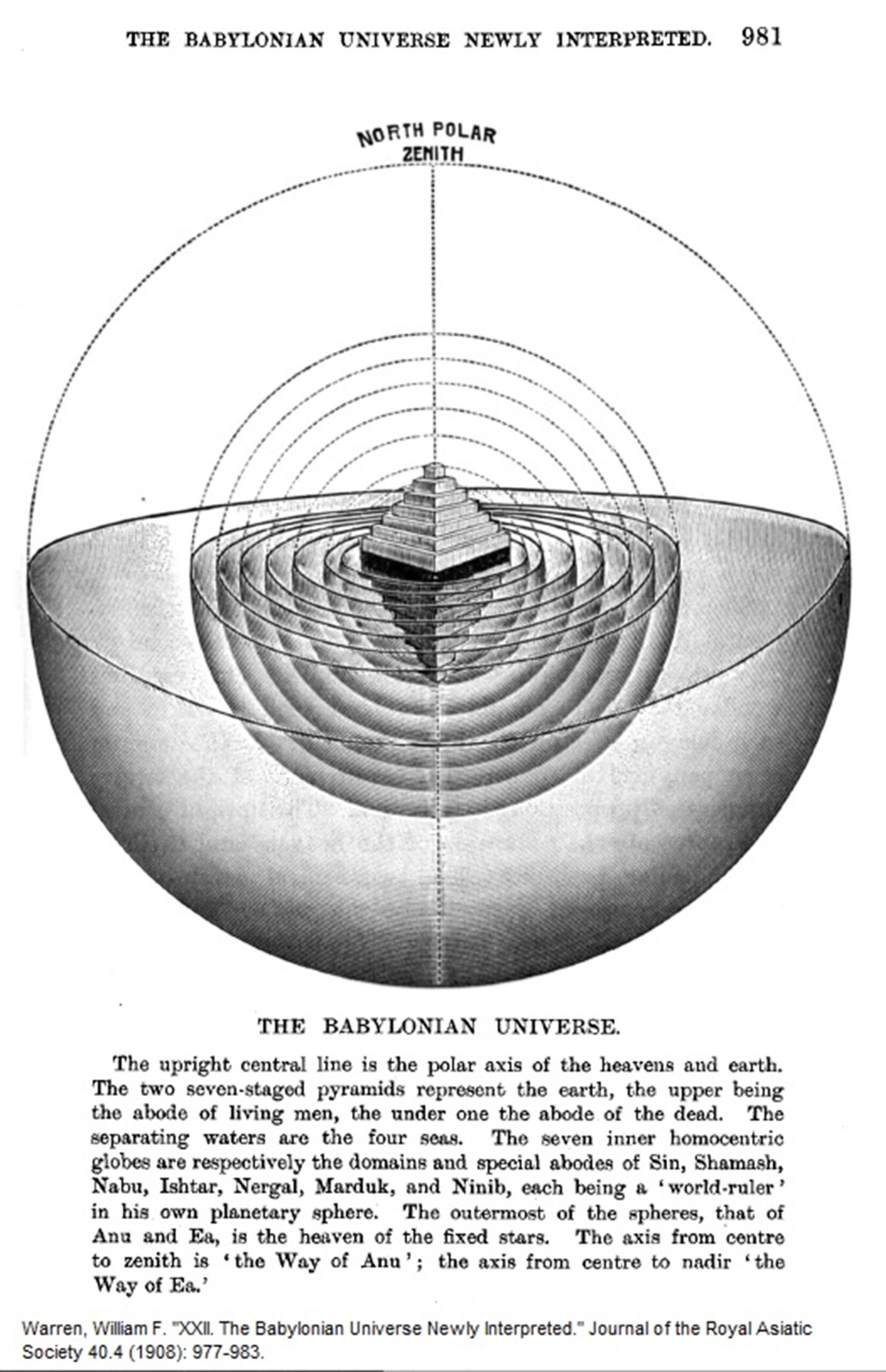
The Babylonian Universe Newly Interpreted
“Few studies in ancient cosmology can more entertain or instruct the investigator of to-day than a careful comparison of the seven diagrams published as correct pictures of the Babylonian universe in the works named below. No two of the seven agree. Moreover, the first represents the Zodiac as at a vast distance above the sphere of the fixed stars, a proceeding which at the start disarranges all ordinary astronomic ideas. Equally unpicturable in my imagination is the seventh of the series, the world sketched by Radau. Again and again have I tried to construct it in thought, but every time have failed. Even Jensen in his great work gives us for “the place of the Convocation of the Gods” (Du-azag), only a pitch-dark cavern in the thin crust of his sea-filled hemispherical earth, and has no place for Hades but another cavern located in the same thin crust and oddly enough far above the cave of the gods. Surely there is a call for new attempts to think the thoughts of these ancient Semites after them.” ref
“The circulation of Earth’s atmosphere and oceans would be very simple, and straightforward if it were not for the planet’s shape and rotation. That revolutionary idea that the Earth was essentially a rotating sphere did not appear until the sixteenth century CE. Earlier ideas had been that the Earth was flat surrounded by a dome or spheres that held the Sun, Moon, the known planets, and stars. Later it was more generally recognized that the Earth was a globe, surrounded by those spheres. The origins of many of these ideas are lost in the depths of time, but here are some of the highlights.” ref
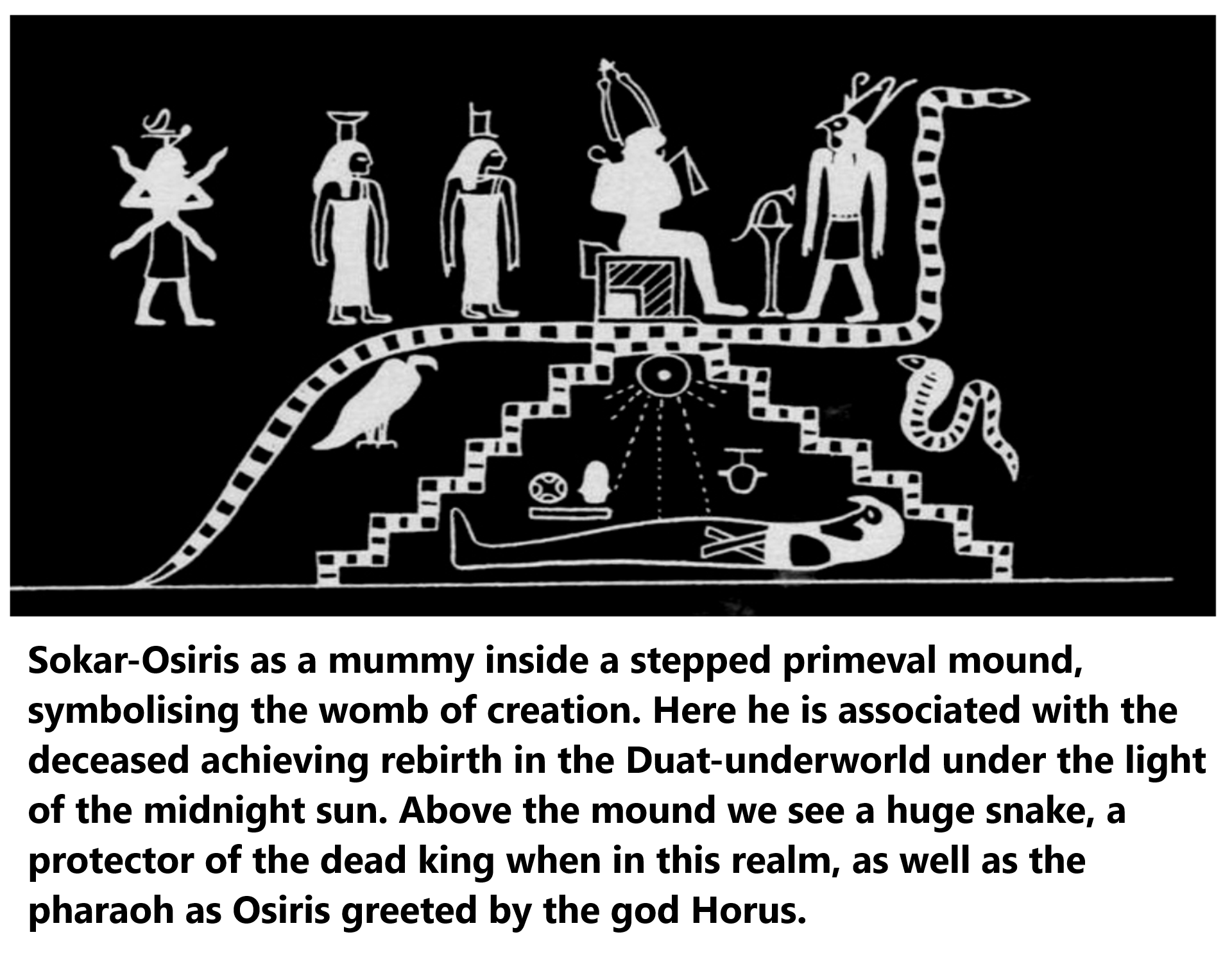
“Sokar-Osiris is a mummy inside a stepped primeval mound, symbolizing the womb of creation. Here, he is associated with the deceased achieving rebirth in the Duat-underworld under the light of the midnight sun. Above the mound we see a huge snake, a protector of the dead king when in this realm, as well as the pharaoh as Osiris greeted by the god Horus.” ref
Book of the Dead chapter 149
“The composition designated ‘chapter 149’ by Lepsius, from its position in the Ptolemaic Period papyrus of Iufankh, presents a numbered series of fourteen ‘mounds’ in the underworld. Each mound is addressed with reference to its inhabitants or landscape, and the encounter is used to empower the deceased: in this way, each potential obstacle to new life is converted into empowerment of the deceased. Most of the fourteen parts of chapter 149 occur for the first time in the Eighteenth Dynasty, and are only known from this chapter; some parts recur as separate compositions in the Book of the Dead, some already occur in the Middle Kingdom (about 2025-1700 BCE) among the funerary compositions written on the sides of coffins (the ‘Coffin Texts’), and one section echoing one of the compositions inscribed on the walls within the Old Kingdom (about 2686-2181 BCE) pyramids (‘Pyramid Texts’).” ref
“O this mound of the West, where one lives on cakes and fine vegetables, Unwind your headcloths at my approach, just as for the Eldest God among you. May he bind my bones and make my limbs firm. Bring me Ihy, lord of hearts, to have my bones built, to establish the Great Crown of Atum. Make firm my head for me, O Nehebkau, fill and make firm the balance. Rule over the gods, Min, the builder. O this mound of spirits, on which there is no sailing, which bears the spirits, while the flame is an engulfing fire. O gods who are in that mound of spirits, your faces downwards, sacred in your mounds, pure in your bindings. This is what you are commanded to do for me by Osiris for eternity. I am the great one of the Red Crown at the fore of the spirits, who brings the Two Lands and all their people to life, by the flame of its mouth, who rescues Ra from Aapep. O he who dominates the secret mound, O this tall and mighty mountain that is in the underworld on which sky and earth alight, measuring 300 rods in length and 10 rods in width, with a serpent on it called Shooter of Two Knives,
measuring 70 cubits in its circuit, living on cutting down spirits and damned in the underworld. I stand in your stronghold, so that the sailing may be smooth, for I have seen the way past you. I am the united one, I am the male: cover your head.
I am well: I am the great in power, my eyes are given to me, and I am transfigured. What is this, going on its belly, your strength at your mountain? Look at me, I have gone against you; your strength is with me. I am the one who raises strength. I have come and taken the earth gods for Ra. I have rested in the evening, at the circling of this sky. You are in your chains. This is the order for you from the beginnings.” ref


To me, Animism starts in Southern Africa, then to West Europe, and becomes Totemism. Another split goes near the Russia and Siberia border becoming Shamanism, which heads into Central Europe meeting up with Totemism, which also had moved there, mixing the two which then heads to Lake Baikal in Siberia. From there this Shamanism-Totemism heads to Turkey where it becomes Paganism.

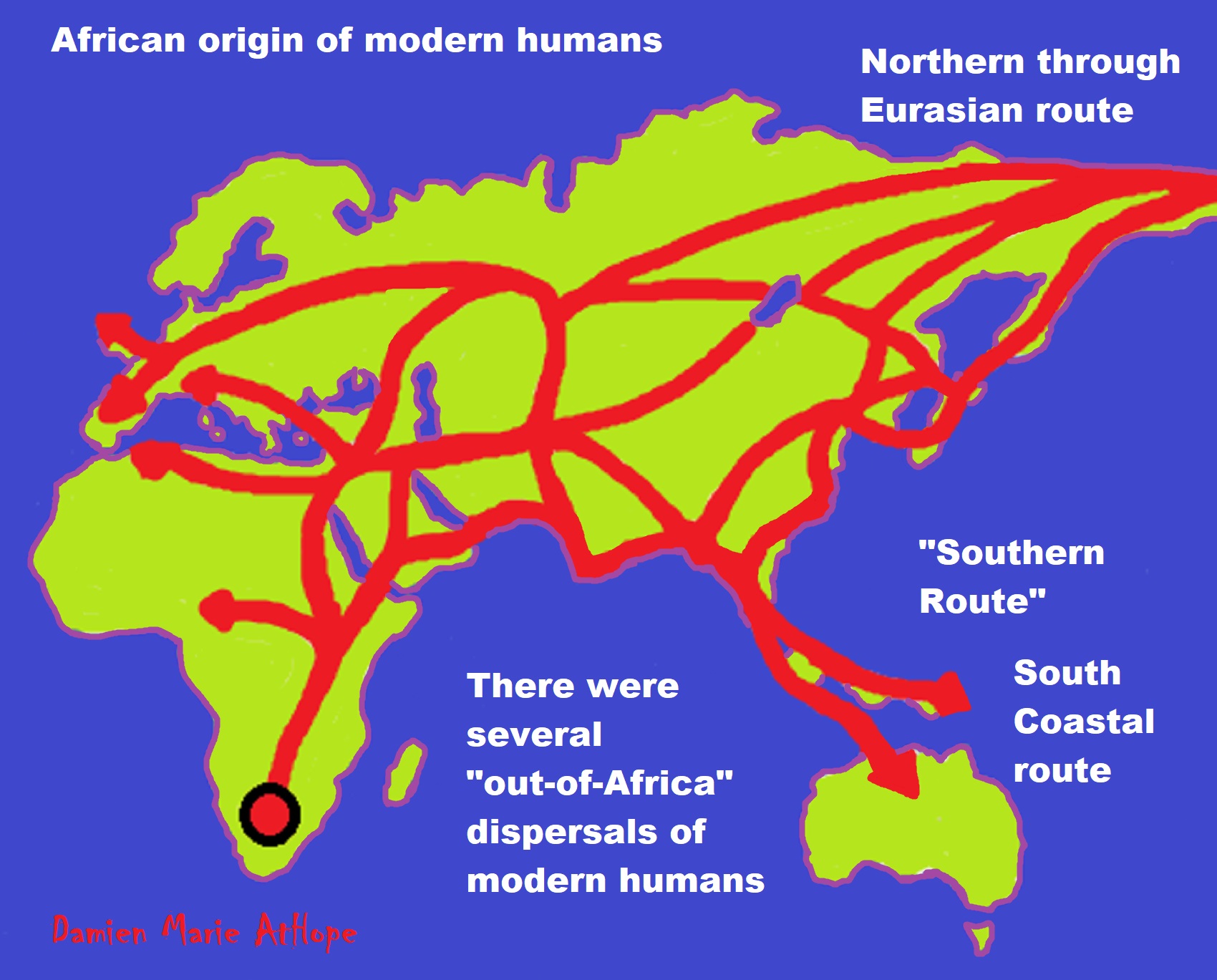
ref, ref, ref, ref, ref, ref, ref, ref
“There are two geographically plausible routes that have been proposed for humans to emerge from Africa: through the current Egypt and Sinai (Northern Route), or through Ethiopia, the Bab el Mandeb strait, and the Arabian Peninsula (Southern Route).” ref
“Although there is a general consensus on the African origin of early modern humans, there is disagreement about how and when they dispersed to Eurasia. This paper reviews genetic and Middle Stone Age/Middle Paleolithic archaeological literature from northeast Africa, Arabia, and the Levant to assess the timing and geographic backgrounds of Upper Pleistocene human colonization of Eurasia. At the center of the discussion lies the question of whether eastern Africa alone was the source of Upper Pleistocene human dispersals into Eurasia or were there other loci of human expansions outside of Africa? The reviewed literature hints at two modes of early modern human colonization of Eurasia in the Upper Pleistocene: (i) from multiple Homo sapiens source populations that had entered Arabia, South Asia, and the Levant prior to and soon after the onset of the Last Interglacial (MIS-5), (ii) from a rapid dispersal out of East Africa via the Southern Route (across the Red Sea basin), dating to ~74,000-60,000 years ago.” ref
“Within Africa, Homo sapiens dispersed around the time of its speciation, roughly 300,000 years ago. The so-called “recent dispersal” of modern humans took place about 70–50,000 years ago. It is this migration wave that led to the lasting spread of modern humans throughout the world. The coastal migration between roughly 70,000 and 50,000 years ago is associated with mitochondrial haplogroups M and N, both derivative of L3. Europe was populated by an early offshoot that settled the Near East and Europe less than 55,000 years ago. Modern humans spread across Europe about 40,000 years ago, possibly as early as 43,000 years ago, rapidly replacing the Neanderthal population.” ref, ref
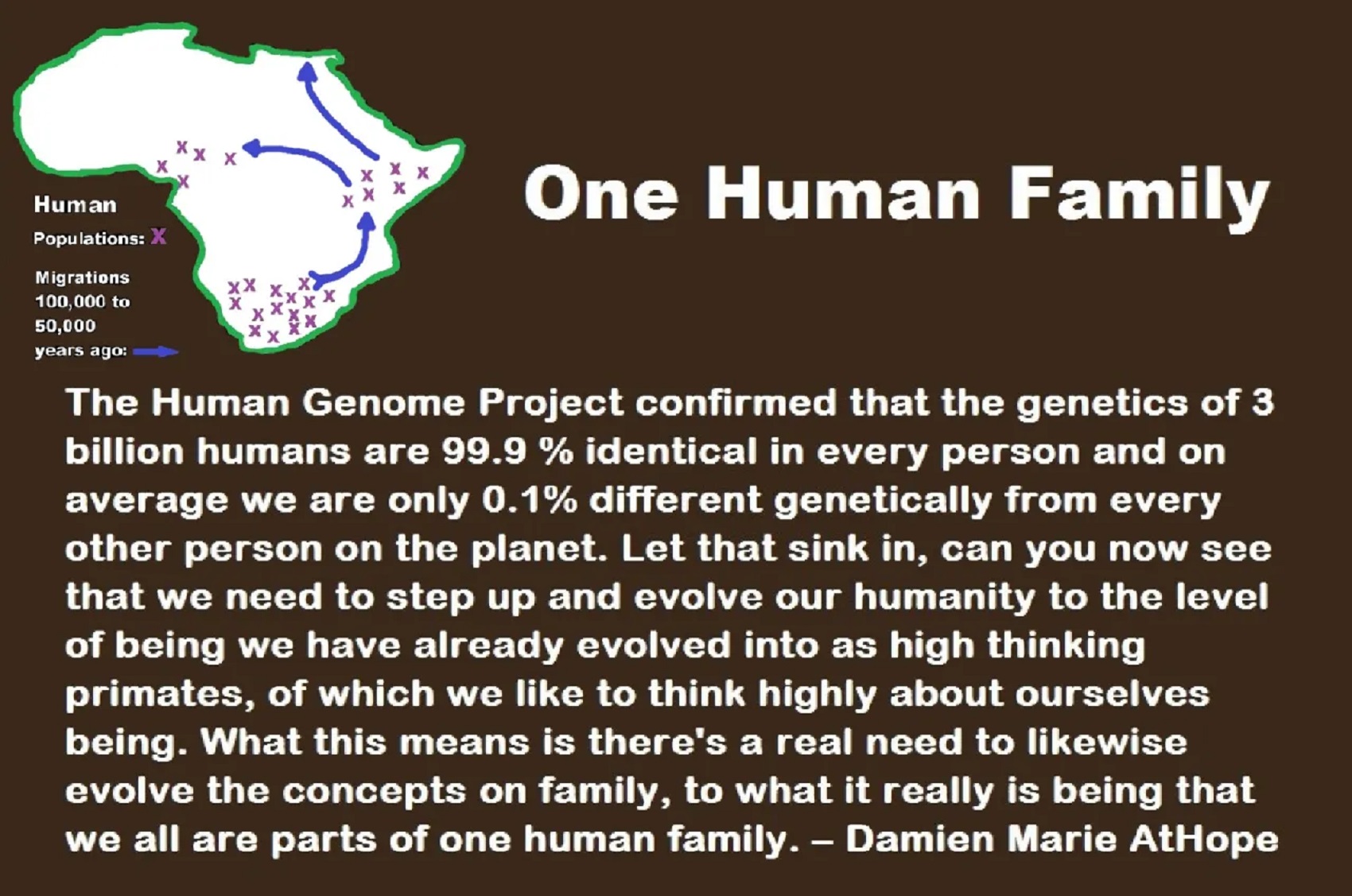
“When researchers completed the final analysis of the Human Genome Project in April 2003, they confirmed that the 3 billion base pairs of genetic letters in humans were 99.9 percent identical in every person. It also meant that individuals are, on average, 0.1 percent different genetically from every other person on the planet. And in that 0.1 percent lies the mystery of why some people are more susceptible to a particular illness or more likely to be healthy than their neighbor – or even another family member.” ref
“Ancient people in Africa, invented boats, probably before 100,000 years ago. Around 60,000 years ago, African explorers left Africa and settled in India and Australia. Soon, they reached West Asia, Central Asia, Europe, and China. A little later, they got to the Americas. The Africans who stayed behind in Africa – most of the people alive at that time – kept right on inventing things. Around 50,000 years ago, they began to make fish-hooks. By around 35,000 years ago, African people were using tally sticks to keep track of numbers.” ref
Animism (simplified to me as a belief in a perceived spirit world) passably by at least 100,000 years ago “the primal stage of early religion” To me, Animistic Somethingism: You just feel/think there has to be something supernatural/spirit-world or feel/think things are supernatural/spirit-filled.
Totemism (simplified to me, as a belief that these perceived spirits could be managed or related with by created physical expressions) passably by at least 50,000 years ago “progressed stage of early religion” A totem is a representational spirit being, a sacred object, or symbol of a group of people, clan, or tribe.
Shamanism (simplified to me as a belief that some special person can commune with these perceived spirits on the behalf of others by way of rituals) passably by at least 30,000 years ago Shamanism is an otherworld connection belief thought to heal the sick, communicate with spirits/deities, and escort souls of the dead.
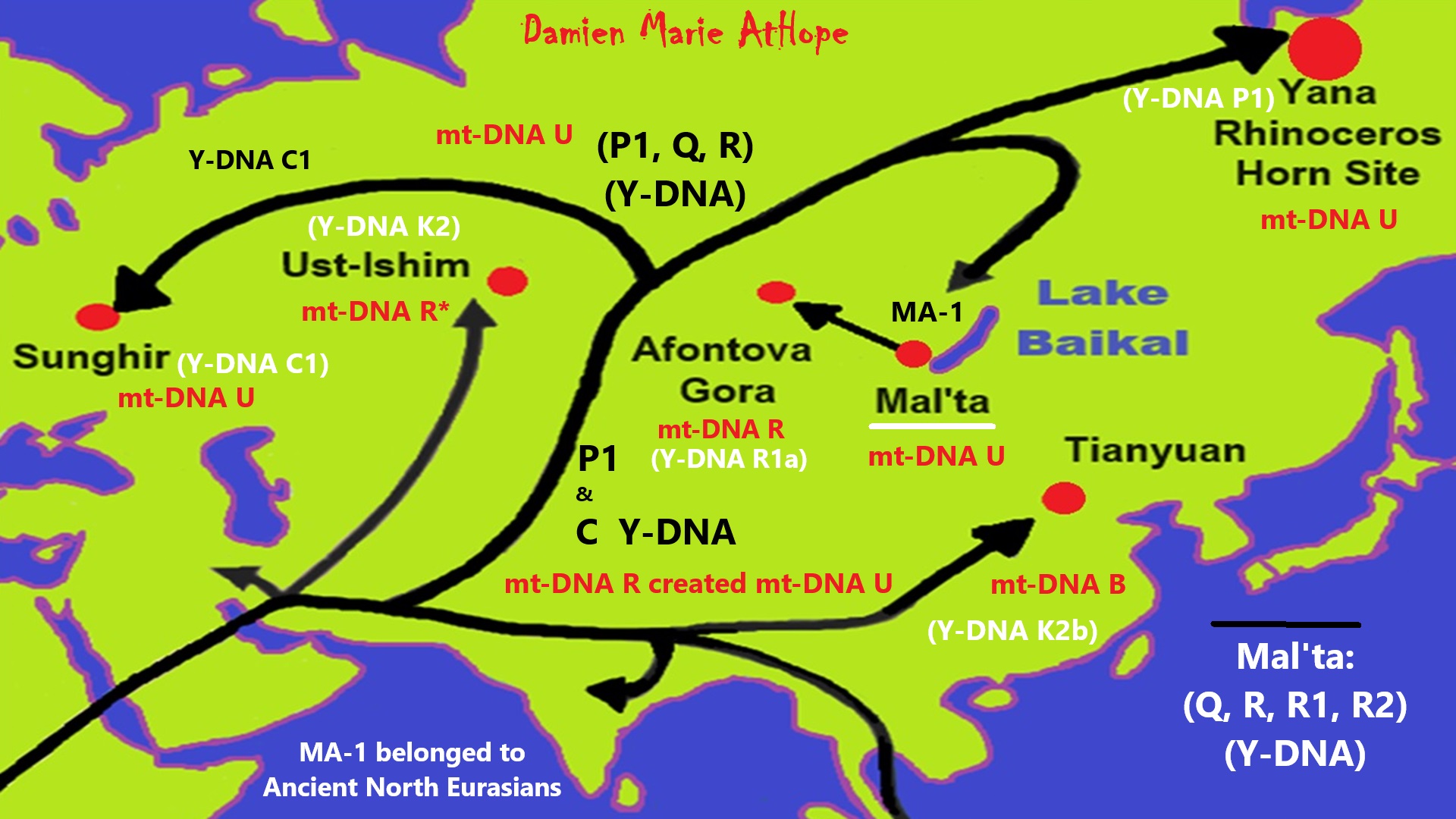
ref, ref, ref, ref, ref, ref, ref, ref, ref, ref, ref, ref, ref
“The genetic prehistory of humans in Asia, based on research using sequence data from humans who lived in Asia as early as 45,000 years ago. Genetic studies comparing present-day Australasians and Asians show that they likely derived from a single dispersal out of Africa, rapidly differentiating into three main lineages: one that persists partially in South Asia, one that is primarily found today in Australasia, and one that is widely represented across Siberia, East Asia, and Southeast Asia. Studies of ancient DNA from human remains in Asia dating from as far back as 45,000 years have greatly increased our understanding of the population dynamics leading to the current Asian populations.” ref
Ust’-Ishim man: Y-DNA haplogroupK2 and mt-DNA haplogroupR*
Tianyuan man: Y-DNA haplogroup K2b and mt-DNA haplogroup B
Yana Rhinoceros Horn Site: Y-DNA haplogroup P1 and mt-DNA haplogroup U
Sungir/Gravettian burials: Y-DNA haplogroup C1 and mt-DNA haplogroups U8c & U2
Ancient North Eurasians: Y-chromosome haplogroups P and its subclades R and Q and mt-DNA haplogroups U and R
Mal’ta–Buret’ culture: basalY-DNA haplogroup R* and mt-DNA haplogroup U
“MA-1 is the only known example of basal Y-DNA R* (R-M207*) – that is, the only member of haplogroup R* that did not belong to haplogroups R1, R2 or secondary subclades of these. The mitochondrial DNA of MA-1 belonged to an unresolved subclade of haplogroup U.” ref
“ANE ancestry has spread throughout Eurasia and the Americas in various migrations since the Upper Paleolithic, and more than half of the world’s population today derives between 5 and 42% of their genomes from the Ancient North Eurasians. Significant ANE ancestry can be found in Native Americans, as well as in Europe, South Asia, Central Asia, and Siberia. It has been suggested that their mythology may have featured narratives shared by both Indo-European and some Native American cultures, such as the existence of a metaphysical world tree and a fable in which a dog guards the path to the afterlife.” ref
Afontova Gora culture: Y-DNA haplogroup R and mt-DNA haplogroup R1b
“The bodies of two individuals, known as Afontova Gora 2 (AG2) and Afontova Gora 3 (AG3) were discovered within the complex (the name Afontova Gora 1 refers to the remains of a candid).” ref
Afontova Gora 2 “human remains”
“The human fossil remains of Afontova Gora 2 were discovered in the 1920s at Afontova Gora II and stored at the Hermitage Museum. The remains are dated to around 17,000 years ago (16,930-16,490 years ago). In 2009, researchers visited the Hermitage Museum and extracted DNA from the humerus of Afontova Gora 2. Despite significant contamination, researchers succeeded in extracting low coverage genomes. DNA analysis confirmed that the individual was male. The individual showed close genetic affinities to Mal’ta 1 (Mal’ta boy). Afontova Gora 2 also showed greater genetic affinity for the Karitiana people than for the Han Chinese. Around 1.9-2.7% of the genome was Neanderthal in origin.” ref
Afontova Gora 3 “human remains”
“In 2014, more human fossil remains were discovered at Afontova Gora II during salvage excavation before the construction of a new bridge over the Yenesei River. The remains belonged to two different females: the atlas of an adult female and the mandible and five lower teeth of a teenage girl (Afontova Gora 3), estimated to be around 14–15 years old. Initially, the new findings were presumed to be roughly contemporaneous with Afontova Gora 2. In 2017, direct AMS dating revealed that Afontova Gora 3 is dated to around 16,090 cal BCE. The mandible of Afontova Gora 3 was described as being gracile. Researchers analyzing the dental morphology of Afontova Gora 3 concluded that the teeth showed distinct characteristics with most similarities to another fossil (the Listvenka child) from the Altai-Sayan region and were neither western nor eastern. Afontova Gora 3 and Listvenka showed distinct dental characteristics that were also different from other Siberian fossils, including those from Mal’ta.” ref
“DNA was extracted from one of the teeth of Afontova Gora 3 and analyzed. Compared to Afontova Gora 2, researchers were able to obtain higher coverage genomes from Afontova Gora 3. DNA analysis confirmed that the individual was female. mtDNA analysis revealed that Afontova Gora 3 belonged to the mitochondrial Haplogroup R1b. Around 2.9-3.7% of the genome was Neanderthal in origin. In a 2016 study, researchers determined that Afontova Gora 2, Afontova Gora 3, and Mal’ta 1 (Mal’ta boy) shared common descent and were clustered together in a Mal’ta cluster. Genetically, Afontova Gora 3 is not closer to Afontova Gora 2 when compared to Mal’ta 1. When compared to Mal’ta 1, the Afontova Gora 3 lineage apparently contributed more to modern humans and is genetically closer to Native Americans.” ref
Afontova Gora 3 with Blond hair?
“Phenotypic analysis shows that Afontova Gora 3 carries the derived rs12821256 allele associated with, and likely causal for, blond hair color, making Afontova Gora 3 the earliest individual known to carry this derived allele. The allele was found in three later members of the largely ANE-derived Eastern Hunter-Gatherers populations from Samara, Motala and Ukraine c. 10,000 years ago, suggesting that it originated in the Ancient North Eurasian population before spreading to western Eurasia. The hundreds of millions of copies of this mutated alelle (a single-nucleotide polymorphism) are at the root of the classic European blond hair mutation, as massive population migrations from the Eurasian steppe, by a people who had substantial Ancient North Eurasian ancestry, entered continental Europe.” ref
The genetic proximity of Afontova Gora 3 with the Tarim mummies?
“A 2021 genetic study on the Tarim mummies found that they were primarily descended from a population represented by the Afontova Gora 3 specimen (AG3), genetically displaying “high affinity” with it. The genetic profile of the Afontova Gora 3 individual represented about 72% of the ancestry of the Tarim mummies, while the remaining 28% of their ancestry was derived from Baikal EBA (Early Bronze Age Baikal populations). The Tarim mummies are thus one of the rare Holocene populations who derive most of their ancestry from the Ancient North Eurasians (ANE, specifically the Mal’ta and Afontova Gora populations), despite their distance in time (around 14,000 years). More than any other ancient populations, they can be considered as “the best representatives” of the Ancient North Eurasians.” ref
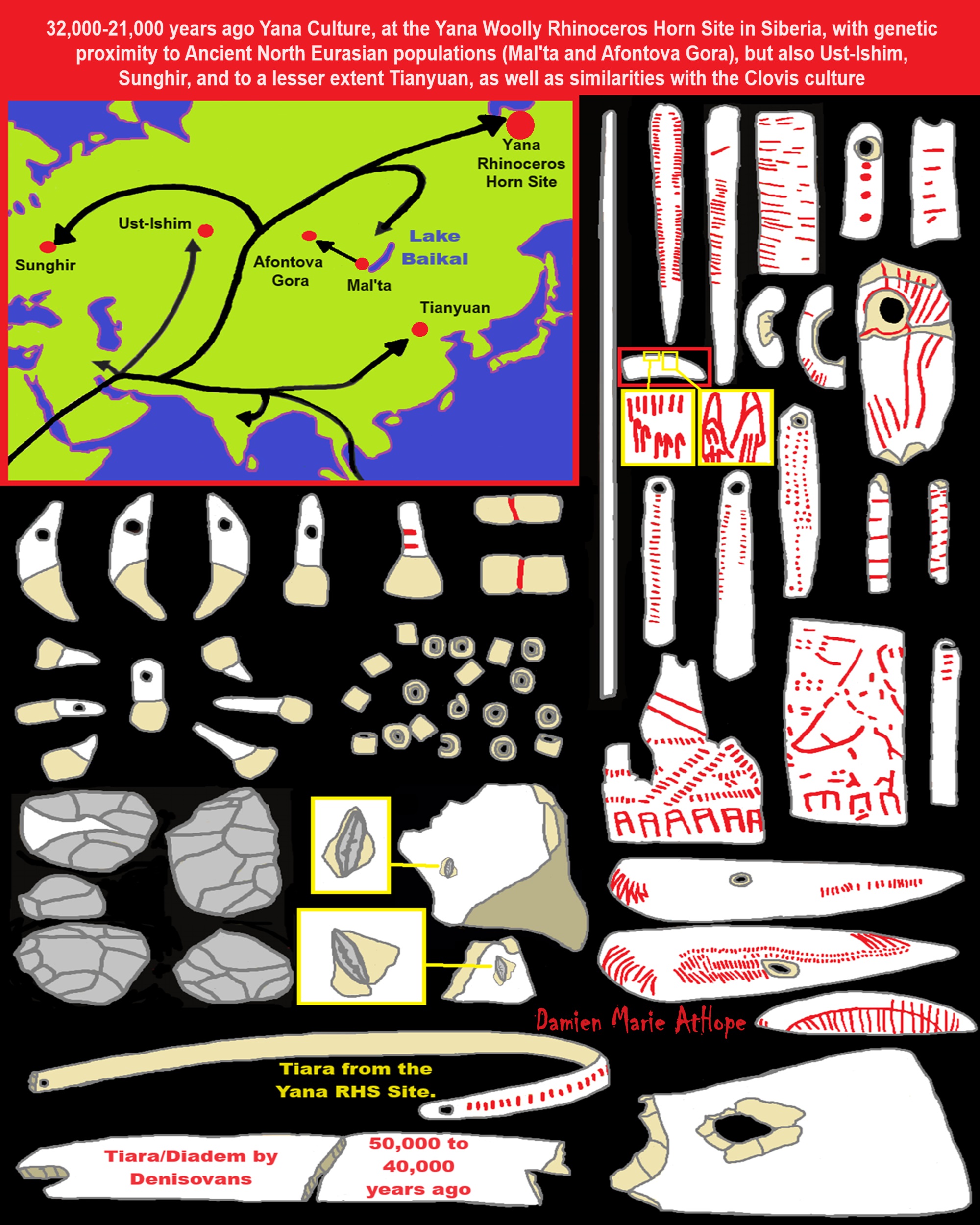
32,000-21,000 years ago, Yana Culture, at the Yana Woolly Rhinoceros Horn Site in Siberia, with genetic proximity to Ancient North Eurasian populations (Mal’ta, Afontova Gora), but also Ust-Ishim, Sunghir, and to a lesser extent Tianyuan, as well as similarities with the Clovis culture
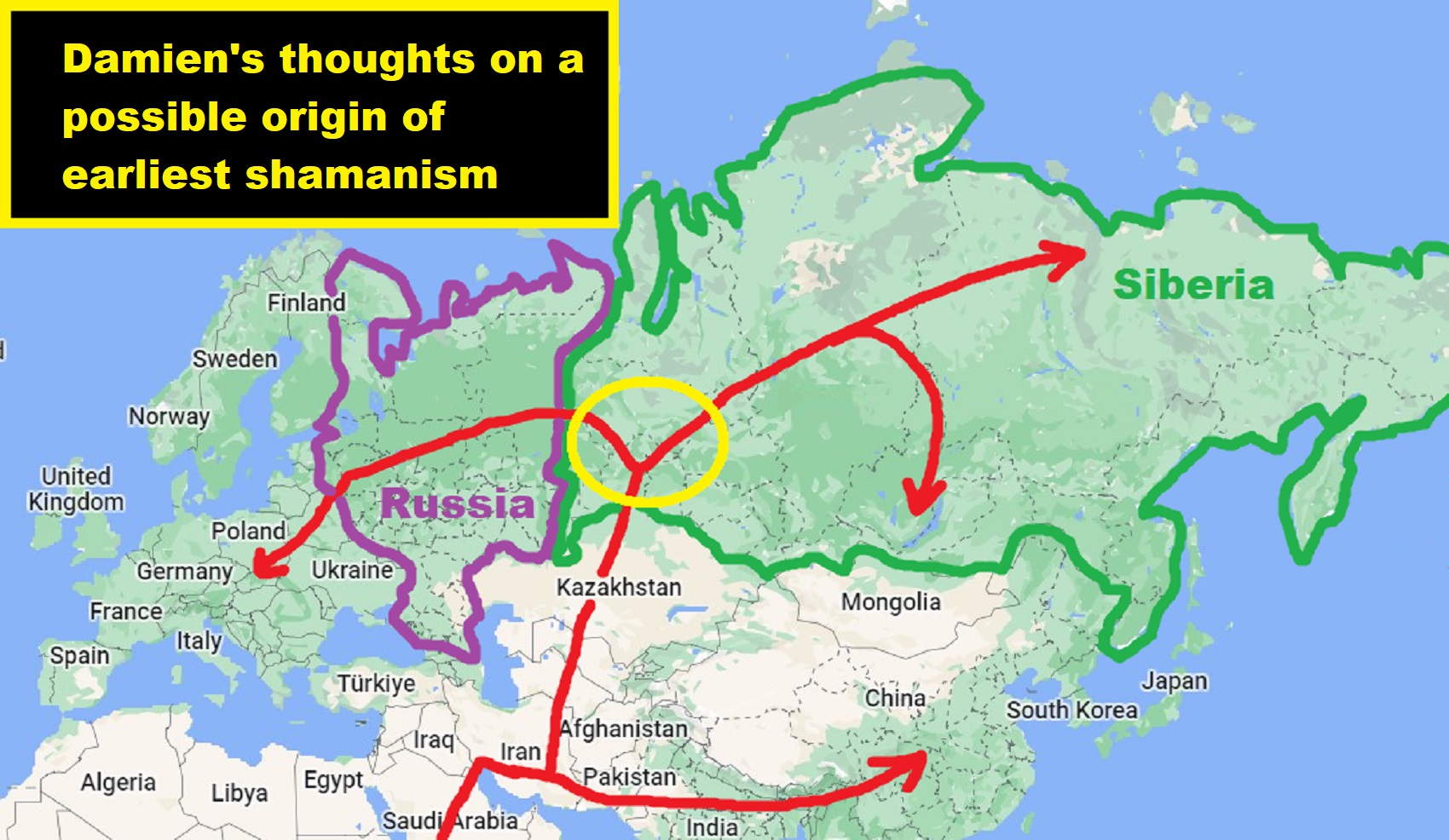
“Haplogroup U is a human mitochondrial DNA haplogroup (mtDNA). The clade arose from haplogroup R, likely during the early Upper Paleolithic. Its various subclades (labeled U1–U9, diverging over the course of the Upper Paleolithic) are found widely distributed across Northern and Eastern Europe, Central, Western, and South Asia, as well as North Africa, the Horn of Africa, and the Canary Islands. Basal U was found in the 26,000-year-old remains of Ancient North Eurasian, Mal’ta boy (MA1). The age of U5 is estimated at between 25,000 and 35,000 years old, roughly corresponding to the Gravettian culture. and is the DNA associated with the seeming first Gravettian shaman burial seen in the Pavlovian culture, around Dolní Věstonice in southern Moravia. One of the Dolní Věstonice burials, located near the huts, revealed a human female skeleton aged to 40+ years old, ritualistically placed beneath a pair of mammoth scapulae, one leaning against the other. Surprisingly, the left side of the skull was disfigured in the same manner as the aforementioned carved ivory figure, indicating that the figure was an intentional depiction of this specific individual. The bones and the earth surrounding the body contained traces of red ocher, a flint spearhead had been placed near the skull, and one hand held the body of a fox. This evidence suggests that this was the burial site of a shaman. This is the oldest site not only of ceramic figurines and artistic portraiture, but also of evidence of female shamans.” ref, ref, ref, ref
“Approximately 11% of Europeans (10% of European-Americans) have some variant of haplogroup U5. U5 was the predominant mtDNA of mesolithic Western Hunter Gatherers (WHG). U5 has been found in human remains dating from the Mesolithic in England, Germany, Lithuania, Poland, Portugal, Russia, Sweden, France, and Spain. Neolithic skeletons (~7,000 years old) that were excavated from the Avellaner cave in Catalonia, northeastern Spain included a specimen carrying haplogroup U5. Haplogroup U5 and its subclades U5a and U5b today form the highest population concentrations in the far north, among Sami, Finns, and Estonians. However, it is spread widely at lower levels throughout Europe. This distribution, and the age of the haplogroup, indicate individuals belonging to this clade were part of the initial expansion tracking the retreat of ice sheets from Europe around 10,000 years ago. The modern Basques and Cantabrians possess almost exclusively U5b lineages (U5b1f, U5b1c1, U5b2).” ref
6 Ice Age Humans (30,000 Years Ago)
“Abstract: Starting about 35,000 years ago, humans seem to have made a great leap forward culturally. The authors argue that this wasn’t because of genetic changes that caused the human brain to have increased capacity. It was because some groups culturally evolved the “social tools” that allowed them to maintain connections and share information over long distances. The groups with the most effective social tools managed to stay connected and to survive, and their descendants inherited this culture of connectedness. It’s likely that forming greater connectedness and more complex culture was necessary in order to survive the periods of high climate variability that were a feature of the last ice age.” ref
“Archaeologists usually describe two regional variants: the western Gravettian, known mainly from cave sites in France, Spain, and Britain, and the eastern Gravettian in Central Europe and Russia. The eastern Gravettians, which include the Pavlovian culture, were specialized mammoth hunters, whose remains are usually found not in caves but in open air sites. Gravettian culture thrived on their ability to hunt animals. They utilized a variety of tools and hunting strategies. Compared to theorized hunting techniques of Neanderthals and earlier human groups, Gravettian hunting culture appears much more mobile and complex. They lived in caves or semi-subterranean or rounded dwellings which were typically arranged in small “villages”. Gravettians are thought to have been innovative in the development of tools such as blunted-back knives, tanged arrowheads, and boomerangs. Other innovations include the use of woven nets and oil lamps made of stone. Blades and bladelets were used to make decorations and bone tools from animal remains.” ref
“Gravettian culture extends across a large geographic region, as far as Estremadura in Portugal. but is relatively homogeneous until about 27,000 years ago. They developed burial rites, which included simple, purpose-built offerings and/or personal ornaments owned by the deceased, placed within the grave or tomb. Surviving Gravettian art includes numerous cave paintings and small, portable Venus figurines made from clay or ivory, as well as jewelry objects. The fertility deities mostly date from the early period; there are over 100 known surviving examples. They conform to a very specific physical type, with large breasts, broad hips and prominent posteriors. The statuettes tend to lack facial details, and their limbs are often broken off. During the post glacial period, evidence of the culture begins to disappear from northern Europe but was continued in areas around the Mediterranean. The Mal’ta Culture (c. 24,000 years ago) in Siberia is often considered as belonging to the Gravettian, due to its similar characteristics, particularly its Venus figurines, but any hypothetical connection would have to be cultural and not genetic: a 2016 genomic study showed that the Mal’ta people have no genetic connections with the people of the European Gravettian culture (the Vestonice Cluster).” ref
“Fu et al. (2016) examined the remains of fourteen Gravettians. The eight males included three samples of Y-chromosomal haplogroup CT, one of I, one IJK, one BT, one C1a2, and one sample of F. Of the fourteen samples of mtDNA, there were thirteen samples of U and one sample of M. The majority of the sample of U belonged to the U5 and U2. Teschler et al. (2020) examined the remains of one adult male and two twin boys from a Gravettian site in Austria. All belonged to haplogroup Y-Haplogroup I. and all had the same mtDNA, U5. According to Scorrano et al. (2022), “the genome of an early European individual from Kostenki 14, dated to around 37,000 years ago, demonstrated that the ancestral European gene pool was already established by that time.” ref
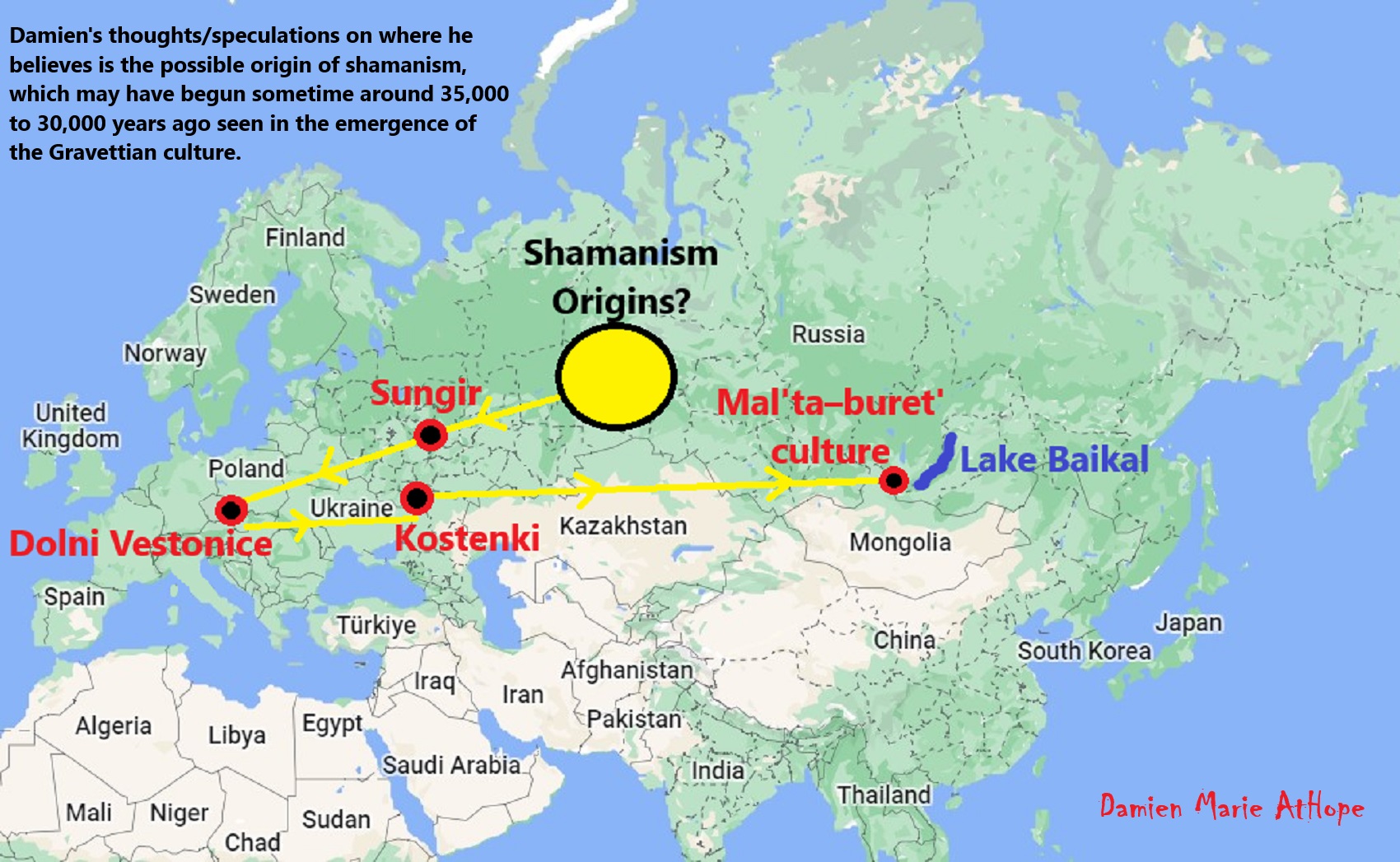
Here are Damien’s thoughts/speculations on where he believes is the possible origin of shamanism, which may have begun sometime around 35,000 to 30,000 years ago seen in the emergence of the Gravettian culture, just to outline his thinking, on what thousands of years later led to evolved Asian shamanism, in general, and thus WU shamanism as well. In both Europe-related “shamanism-possible burials” and in Gravettian mitochondrial DNA is a seeming connection to Haplogroup U. And the first believed Shaman proposed burial belonged to Eastern Gravettians/Pavlovian culture at Dolní Věstonice in southern Moravia in the Czech Republic, which is the oldest permanent human settlement that has ever been found. It is at Dolní Věstonice where approximately 27,000-25,000 years ago a seeming female shaman was buried and also there was an ivory totem portrait figure, seemingly of her.
“The Pavlovian is an Upper Paleolithic culture, a variant of the Gravettian, that existed in the region of Moravia, northern Austria, and southern Poland around 29,000–25,000 years ago. Its name is derived from the village of Pavlov, in the Pavlov Hills, next to Dolní Věstonice in southern Moravia. The culture used sophisticated stone age technology to survive in the tundra on the fringe of the ice sheets around the Last Glacial Maximum. Excavation has yielded flint implements, polished and drilled stone artifacts, bone spearheads, needles, digging tools, flutes, bone ornaments, drilled animal teeth, and seashells. Art or religious finds are bone carvings and figurines of humans and animals made of mammoth tusk, stone, and fired clay.” ref
“One of the burials, located near the huts, revealed a human female skeleton aged to 40+ years old, ritualistically placed beneath a pair of mammoth scapulae, one leaning against the other. Surprisingly, the left side of the skull was disfigured in the same manner as the aforementioned carved ivory figure, indicating that the figure was an intentional depiction of this specific individual. The bones and the earth surrounding the body contained traces of red ocher, a flint spearhead had been placed near the skull, and one hand held the body of a fox. This evidence suggests that this was the burial site of a shaman. This is the oldest site not only of ceramic figurines and artistic portraiture, but also of evidence of female shamans.” ref
“A burial of an approximately forty-year-old woman was found at Dolní Věstonice in an elaborate burial setting. Various items found with the woman have had a profound impact on the interpretation of the social hierarchy of the people at the site, as well as indicating an increased lifespan for these inhabitants. The remains were covered in red ochre, a compound known to have religious significance, indicating that this woman’s burial was ceremonial in nature. Also, the inclusion of a mammoth scapula and a fox are indicative of a high-status burial.” ref
“In the Upper Paleolithic, anatomically modern humans began living longer, often reaching middle age, by today’s standards. Rachel Caspari argues in “Human Origins: the Evolution of Grandparents,” that life expectancy increased during the Upper Paleolithic in Europe (Caspari 2011). She also describes why elderly people were highly influential in society. Grandparents assisted in childcare, perpetuated cultural transmission, and contributed to the increased complexity of stone tools (Caspari 2011). The woman found at Dolní Věstonice was old enough to have been a grandparent. Although human lifespans were increasing, elderly individuals in Upper Paleolithic societies were still relatively rare. Because of this, it is possible that the woman was attributed with great importance and wisdom, and revered because of her age. Because of her advanced age, it is also possible she had a decreased ability to care for herself, instead relying on her family group to care for her, which indicates strong social connections.” ref
“Furthermore, a female figurine was found at the site and is believed to be associated with the aged woman, because of remarkably similar facial characteristics. The woman was found to have deformities on the left side of her face. The special importance accorded with her burial, in addition to her facial deformity, makes it possible that she was a shaman in this time period, where it was “not uncommon that people with disabilities, either mental or physical, are thought to have unusual supernatural powers” (Pringle 2010).” ref
“In 1981, Patricia Rice studied a multitude of female clay figurines found at Dolní Věstonice, believed to represent fertility in this society. She challenged this assumption by analyzing all the figurines and found that, “it is womanhood, rather than motherhood that is symbolically recognized or honored” (Rice 1981: 402). This interpretation challenged the widely held assumption that all prehistoric female figurines were created to honor fertility. The fact is that we have no idea why these figurines proliferated nor of their purpose or usage.” ref
“Haplogroup U5 is estimated to be about 30,000 years old, and it is primarily found today in people with European ancestry. Both the current geographic distribution of U5 and testing of ancient human remains indicate that the ancestor of U5 expanded into Europe before 31,000 years ago. A 2013 study by Fu et al. found two U5 individuals at the Dolni Vestonice burial site in the Czech Republic that has been dated to 31,155 years ago. A third person from the same burial was identified as haplogroup U8. The Dolni Vestonice samples have only two of the five mutations ( C16192T and C16270T) that are found in the present day U5 population. This indicates that the U5-(C16192T and C16270T) mtDNA sequence is ancestral to the present day U5 population that includes the additional three mutations T3197C, G9477A and T13617C.” ref
“Haplogroup U5 is thought to have evolved in the western steppe region and then entered Europe around 30,000 to 55,000 years ago. Results support previous hypotheses that haplogroup U5 mtDNAs expanded throughout Northern, Southern, and Central Europe with more recent expansions into Western Europe and Africa. The results further allow us to explain how U5 mtDNAs are now found with high frequency in Northern Europe, as well as delineate the origins of the specific U5 subhaplogroups found in that part of Europe.” ref
“Haplogroup U5 is found throughout Europe with an average frequency ranging from 5% to 12% in most regions. U5a is most common in north-east Europe and U5b in northern Spain. Nearly half of all Sami and one fifth of Finnish maternal lineages belong to U5. Other high frequencies are observed among the Mordovians (16%), the Chuvash (14.5%) and the Tatars (10.5%) in the Volga-Ural region of Russia, the Estonians (13%), the Lithuanians (11.5%) and the Latvians in the Baltic, the Dargins (13.5%), Avars (13%) and the Chechens (10%) in the Northeast Caucasus, the Basques (12%), the Cantabrians (11%) and the Catalans (10%) in northern Spain, the Bretons (10.5%) in France, the Sardinians (10%) in Italy, the Slovaks (11%), the Croatians (10.5%), the Poles (10%), the Czechs (10%), the Ukrainians (10%) and the Slavic Russians (10%). Overall, U5 is generally found in population with high percentages of Y-haplogroups I1, I2, and R1a, three lineages already found in Mesolithic Europeans. The highest percentages are observed in populations associated predominantly with Y-haplogroup N1c1 (the Finns and the Sami), although N1c1 is originally an East Asian lineage that spread over Siberia and Northeast Europe and assimilated indigenous U5 maternal lineages.” ref
“The age of haplogroup U5 is uncertain at present. It could have arisen as recently as 35,000 years ago, or as early was 50,000 years ago. U5 appear to have been a major maternal lineage among the Paleolithic European hunter-gatherers, and even the dominant lineage during the European Mesolithic. In two papers published two months apart, Posth et al. 2016 and Fu et al. 2016 reported the results of over 70 complete human mitochondrial genomes ranging from 45,000 to 7,000 years ago. The oldest U5 samples all dated from the Gravettian culture (c. 32,000 to 22,000 years ago), while the older Aurignacian samples belonged to mt-haplogroups M, N, R*, and U2. Among the 16 Gravettian samples that yielded reliable results, six belonged to U5 – the others belonging mostly to U2, as well as isolated samples of M, U*, and U8c. Two Italian Epigravettian samples, one from the Paglicci Cave in Apulia (18,500 years ago), and another one from Villabruna in Veneto (14,000 years ago), belonged to U5b2b, as did two slightly more recent Epipaleolithic samples from the Rhône valley in France. U5b1 samples were found in Epipalaeolithic Germany, Switzerland (U5b1h in the Grotte du Bichon), and France. More 80% of the numerous Mesolithic European mtDNA tested to date belonged to various subclades of U5. Overall, it appears that U5 arrived in Europe with the Gravettian tool makers, and that it particularly prospered from the end of the glacial period (from 11,700 years ago) until the arrival of Neolithic farmers from the Near East (between 8,500 and 6,000 years ago).” ref
“Carriers of haplogroup U5 were part of the Gravettian culture, which experienced the Last Glacial Maximum (LGM, 26,000 to 19,000 years ago). During this particularly harsh period, Gravettian people would have retreated into refugia in southern Europe, from which they would have re-expanded to colonise the northern half of the continent during the Late Glacial and postglacial periods. For reasons that are yet unknown, haplogroup U5 seems to have resisted better to the LGM to other Paleolithic haplogroups like U*, U2 and U8. Mitochondrial DNA being essential for energy production, it could be that the mutations selected in early U5 subclades (U5a1, U5a2, U5b1, U5b2) conferred an advantage for survival during the coldest millennia of the LGM, which had for effect to prune less energy efficient mtDNA lineages.” ref
“It is likely that U5a and U5b lineages already existed prior to the LGM and they were geographically scattered to some extent around Europe before the growing ice sheet forced people into the refugia. Nonetheless, founder effects among the populations of each LGM refugium would have amplified the regional division between U5b and U5a. U5b would have been found at a much higher frequency in the Franco-Cantabrian region. We can deduce this from the fact that modern Western Europeans have considerably more U5b than U5a, but also because the modern Basques and Cantabrians possess almost exclusively U5b lineages. What’s more, all the Mesolithic U5 samples from Iberia whose subclade could be identified belonged to U5b.” ref
“Conversely, only U5a lineages have been found so far in Mesolithic Russia (U5a1) and Sweden (U5a1 and U5a2), which points at an eastern origin of this subclade. Mesolithic samples from Poland, Germany and Italy yielded both U5a and U5b subclades. German samples included U5a2a, U5a2c3, U5b2 and U5b2a2. The same observations are valid for the Neolithic and Chalcolithic periods too, with U5a1 being found in Russia and Ukraine, U5b in France (Cardium Pottery and Megalithic), U5b2 in Portugal. U5b1b1 arose approximately 10,000 years ago, over two millennia after the end of the Last Glaciation, when the Neolithic Revolution was already under way in the Near East. Despite this relatively young age, U5b1b1 is found scattered across all Europe and well beyond its boundaries. The Saami, who live in the far European North and have 48% of U5 and 42% of V lineages, belong exclusively to the U5b1b1 subclade. Amazingly, the Berbers of Northwest Africa also possess that U5b1b1 subclade and haplogroup V.” ref
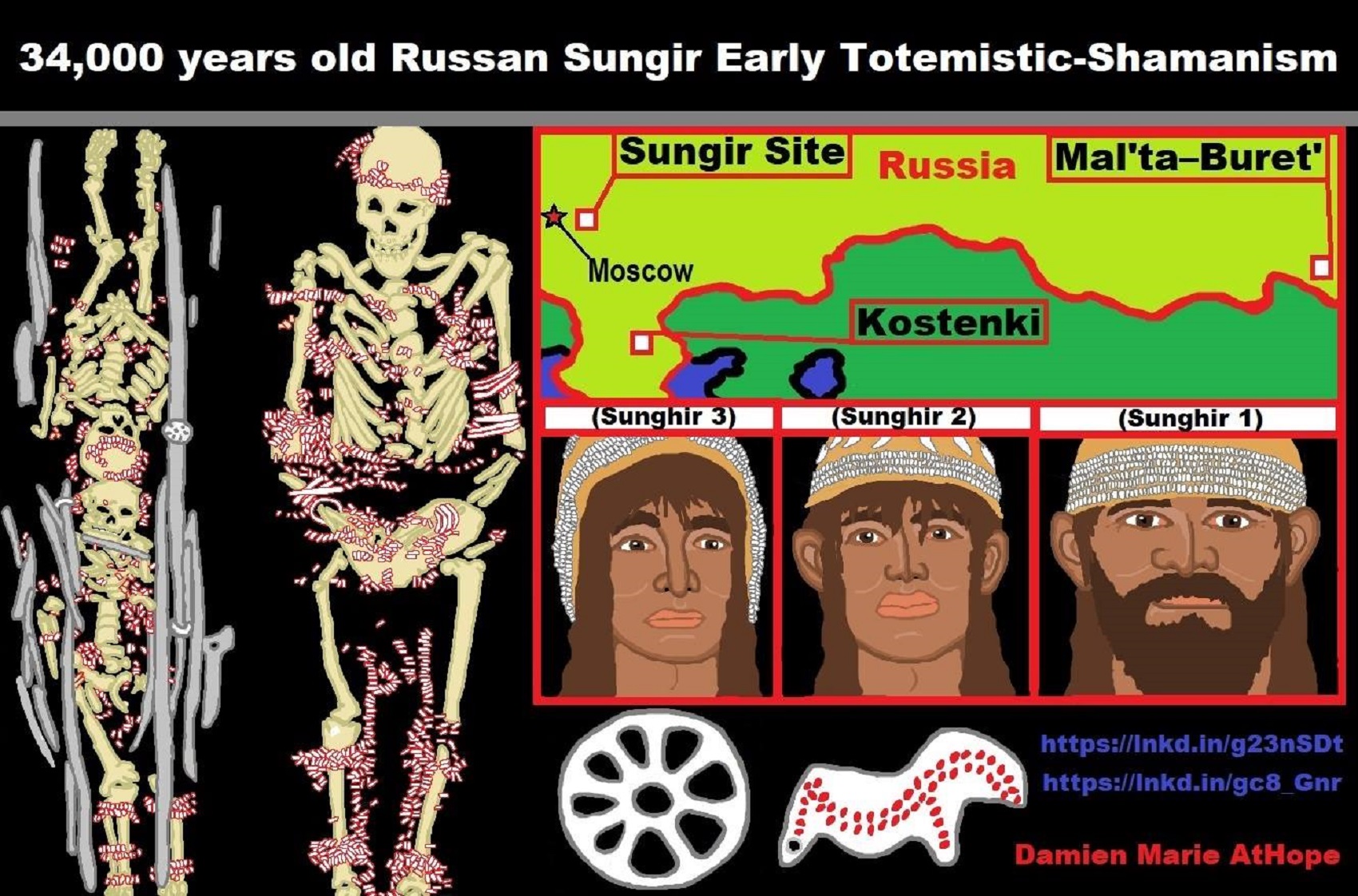
“Probably occupied from as much as around 38,900–32,630 years ago. It had previously been dated at a lower date as low as around 23,000-19,000 years ago which changed.” ref
Sungar “Gravettian culture” (Russia) and related Dolni Vestonice Pavlovian/Gravettian culture (Czech Republic).
Sungar (Russia), found posable evidence of shamanistic Gravettian culture burials and that seem to match the latter indigenous American shamanistic burials in Alaska at the Tanana River site with around 11,500 years old duel infant burial very similar shamanistic grave offerings like decorated stone weapons. To further a clear connection is the Bluefish Cave (Yukon Territory Canada) that held bones with cut marks which is possibly as old as 24,000 to 19,650 years ago and the youngest are around 12,000 years old seem to offer strong support for the “Beringian hypothesis” human population dispersed to North and South America. ref
To me, is seems Siberian is the general origin of native Americans at least by around 11,000 years ago, by the land bridge “Beringia” from Asia by way of Siberia in Russia over to Alaska in the Americas, which the Paleoindians had crossover on, finally flooded over by rising sea levels and was submerged. Siberia has a large variety of climate, vegetation, and landscape. Siberia’s Prehistory demonstrates several distinct cultures sometimes transferring ideas, other times not, and some split from earlier cultures creating new ones often in illation, mainly starting with hunter-gatherer nomadism. During glaciation around 115,000 to 15,000 years ago, the Siberia tundra extended south and an ice sheet covered area of Russia around the Ural Mountains that while some of the oldest mountains are more like large hills, and the area to the east of the lower Yenisei River basin, which in the general area of central and southern Siberia. ref
Some of the first nomadic peoples entered Siberia about 50,000 years ago. Ancient nomadic tribes such as the Ket people and the Yugh people a separate but similar group lived along its banks. Shamanism among Kets shares characteristics with those of Turkic and Mongolic peoples thus not at all homogeneous in expression though neither is shamanism in Siberia in general. As for shamanism among Kets had several types of Ket shamans and shared characteristics with those of Turkic and Mongolic peoples. The Yana River sites, in Siberia, demonstrate that modern human populations had reached Western Beringia by 32,000 years ago then engaging in an early dispersal possibly by 24,000 years ago. ref
SHAMANISM IN RUSSIA AND MONGOLIA
“Shamanism is still practiced in Russia, particularly in the Lake Baikal area of southern Siberia near the Mongolian border and in the middle Volga regions. The word Shamanism comes from Siberia. And believed shamanistic powers are passed on from generation to generation or by spontaneous vocation during an initiation ceremony that usually involves some kind of ecstatic death, rebirth, vision or experience. Though a for some shaman cultures a distinction is made between hereditary ones and those who have become shaman after suffering a serious illness. A shamanist is a one person cult-authority, spirit medium, soul-traveler, meteorologist, physician, philosopher, and ideologist.” ref
“Shaman have traditionally been important religious figures and healers among many Siberian peoples and commonly connect to and revolved around hunting and family/ancestor cults. The word “shaman” comes to us from the Tungus language via Russian. In Siberia, shamans have traditionally been called upon to heal the sick, solve problems, protect groups from hostile spirts, make predictions and mediate between the spiritual world and human world and guide dead souls to the afterlife.” ref
“After death it was believed that the breath soul left through the nostrils.
Many groups make wooden images of dolls of the deceased and for a period of time, they are treated like the real person. A wide variety of goods may be placed in the graves of the deceased, depending on the group. These generally include things the deceased needs in the next life. Often totems are broken or defaced in some way to “kill” them so they don’t assist the dead in returning. Some groups placed the dead in graves others on the ground covering them with something, while other groups placed the dead on a special platform on the trees.” ref
“Shaman cults tend to revolve around animals, natural objects, heroes and clan leaders have also been central to the lives of many of Siberia’s indigenous people. Many groups have strong beliefs in spirits, in realms of the sky and earth and follow cults associated with animals, especially the Raven. Things like illness and other misfortunes were attributed to spirits. Many Arctic people believe that each person has two souls: (1) a shadow soul that may leave the body during sleep or unconsciousness and take the form of a bee or a butterfly, and (2) a “breath” soul that provides life to humans and animals. Many groups believe the life forces lies within the bones, blood, and vital organs. For this reason the bones of the dead are treated with great reverence so a new life can be regenerated from them.” ref
“The Khanty (an indigenous people calling themselves Khanti, Khande, Kantek, living in Khanty–Mansi Autonomous Okrug, a region historically known as “Yugra” in Russia) shamans who believe the forest is inhabited by invisible people and spirits of animals, forest, rivers and natural landmarks. The most important spirits belong to the sun, moon, and bear. Khanty shaman work as intermediaries between the living worlds and the spiritual world. The invisible people are like gremlins or trolls. They are blamed for missing puppies, strange events and unexplained behavior.” ref
Why This Paleolithic Burial Site Is So Strange (and So Important)
“In addition to beads and ochre, carefully manufactured mammoth ivory spears, ivory disks, and pierced cervid antlers were found with the skeletons. And this is not supersizing because by approximately 40,000 years ago, narrow stone blades and tools made of bone, ivory, and antler appeared, along with simple wood instruments. Yet these extravagant burials are only part of the reason why Sungir stands out as the site is characterized by a much greater diversity of mortuary behaviors than archaeologists previously thought. ” ref, ref
“Sungir – Sunghir is a site that held multiple burials of least 10 individuals and specifically two of the most extraordinary Upper Paleolithic burials known: one of an adult male “Sungir-1” and another of two children “Sungir-2 and Sungir-3. The two children originally thought to be a boy and girl,are now thought to be two boys interred head-to-head. All remains were covered in ochre and were accompanied by rich grave goods including ivory beads and spears, armbands, and carvings, as well as arctic fox canines. Adjacent to Sungir-2 was the femoral diaphysis (main or midsection (shaft) of a long bone) of an adult “Sungir 4″ that had been polished, hollowed out, and filled with red ochre. The site also yielded other less complete human remains, some of uncertain stratigraphic provenance [Sunghir 5 to 9. Radiocarbon analyses place the age of Sungir-1 to Sungir 4 date between 33,600-34,600 years ago. The homogeneity in morphological traits (e.g., metopism) among the remains, as well as signs of possible congenital pathologies in SIII, have been interpreted as evidence of inbreeding. Other Upper Paleolithic individuals with reported congenital or degenerative pathologies (e.g., at Barma Grande and Dolní Věstonice) reinforce the view that Upper Paleolithic groups were small and susceptible to inbreeding, possibly as extensive as what has been reported for the Altai Neandertal. However, genomic data available for some of those individuals were of insufficient coverage to infer population sizes or inbreeding levels.” ref, ref
Picture: link
“There where at least three different forms of burials were practiced at Sunghir. While an adult femur shaft was found in the grave with the two youngsters, another femur bone was discovered isolated near the graves, with indications that the body had been abandoned on the surface without receiving any formal treatment. A cranium, was found with artifacts just above the adult’s lavish grave. This cranium represents only one part of the skeleton, it appears to have been deposited there in the context of a funerary ritual.” ref
“Sungir may thus be considered as the earliest modern human burial site in Europe with evidence of a social structure that would not have solely depended on people’s acquired status. And as can be indicative to a general shamanism thinking about body difference being special, both the juvenile and the adolescent appear to have suffered from physical abnormalities and likely their disabilities would have been visible to others. Their difference may have been part of the reason they were given an extravagant burial.” ref
“Analyses of mtDNA genomes from Sungir1 to Sungir 4 put them in haplogroup U, consistent with West Eurasian and Siberian Paleolithic and Mesolithic genomes. Sungir1 belongs to haplogroup U8c; the sequences for the three individuals from the double burial ( Sungir 2 to Sungir 4) are identical and belong to haplogroup U2, which is closely related to the Upper Paleolithic Kostenki 12 and Kostenki 14 individuals. Phylogenetic analyses of the Y chromosome sequences place all Sungir individuals in an early divergent lineage of haplogroup C1a2. Y chromosome haplogroup C1, which is rare among contemporary Eurasians, has been found in other early European individuals, including the ~36,000-year-old Kostenki 14.” ref
“Haplogroup C1a2 (also known as Haplogroup C-V20): which has been discovered in the remains of Palaeolithic people in Czech Republic (30,000 years ago), Belgium (35,000 years ago), and the Sunghir archaeological site near Vladimir, Russia. Regarding more recent prehistory, Haplogroup C-V20 has been found in the remains of a male (died ca. 7,000 years ago) associated with a late group of the Alföld Linear Pottery culture at Kompolt-Kigyósér, Hungary whose mtDNA belonged to haplogroup J1c1, the remains of a male (died ca. 7,000 years ago) associated with the LBK Culture at Apc-Berekalja (I.), Hungary whose mtDNA belonged to haplogroup K1a3a3, and the remains of a male (died ca. 7,000 years ago) associated with Mesolithic culture at La Braña-Arintero, León, Spain whose mtDNA belonged to haplogroup U5b2c1. Haplogroup C-V20 Y-DNA also has been found in a small number of modern Europeans, Algerian Berbers,[6]Armenians, and Nepalis. It includes many Y-DNA samples associated with the oldest currently known population of anatomically modern humans in Europe (Cro-Magnons), and it is considered to be a carrier of the Upper Paleolithic Aurignacian culture that began 40,000 years ago.” ref
“There is significant Totamistic-Shamanism activity from Dolni Vestonice in the Czech Republic, with triple burial three teenagers to larger males DV 13 and DV 14 side by side flanking a smaller handicap male DV 15 in the middle position of the burial, a single older woman shaman burial with a carved portrait, and a Venus of Dolní Věstonice, 27,000 and 25,000 years ago. The Dna of three inhabitants of Dolni Vestonice, lived 31,155 years ago and to have mitochondrial haplogroup U, and one inhabitant mitochondrial haplogroup U8.” ref, ref, ref, ref, ref
Early Gravettian – The Pavlovian
“As the most important component of the Early Gravettian in Danubian Europe, the Pavlovian (30 – 25 ky) occupies a central location within the Lower Austrian – Moravian – South Polish geomorphological corridor (fig. 2a). Both the Pavlovian settlement archaeology and the resource analysis suggest a discontinuity compared to the previous Early Upper Paleolithic settlement strategies: the typical formation of the large open-air settlements in an axial manner, in lower altitudes and along the rivers; the long-distance transport of lithic raw materials; the intensive exploitation of mammoths supplemented by a variety of small animals; and, finally, aspects of ritual and style.” ref
“The art production at this stage of the Gravettian is remarkably complex, and includes carvings and engravings, soft stone carvings, and especially the ceramic plastic production. A majority of the human skeletal remains are equally dated to this period (Predmostí, Dolní Vestonice – Pavlov, Krems). Some of the ritual burials are covered by ochre, and some are covered by mammoth shoulderblades. It should be underlined, however, that they are poorly equipped by additive artifacts (if any, so just a few pierced decorative objects. The earliest Pavlovian occupation is best documented at Willendorf II, layer 5 (around and after 30 ky BP), Krems, and Dolní Vestonice II (a complex occupation horizons dated to 27 ky). The industry is dominated by burins, backed implements, and endscrapers, where burins are about the twice as numerous as endscrapers. The number of microliths, and especially geometric microliths, is usually low. A variety of pointed blades (including the Jerzmanowice-type points) and pointed microblades (including the Krems or Font Yves points) occur as well.” ref
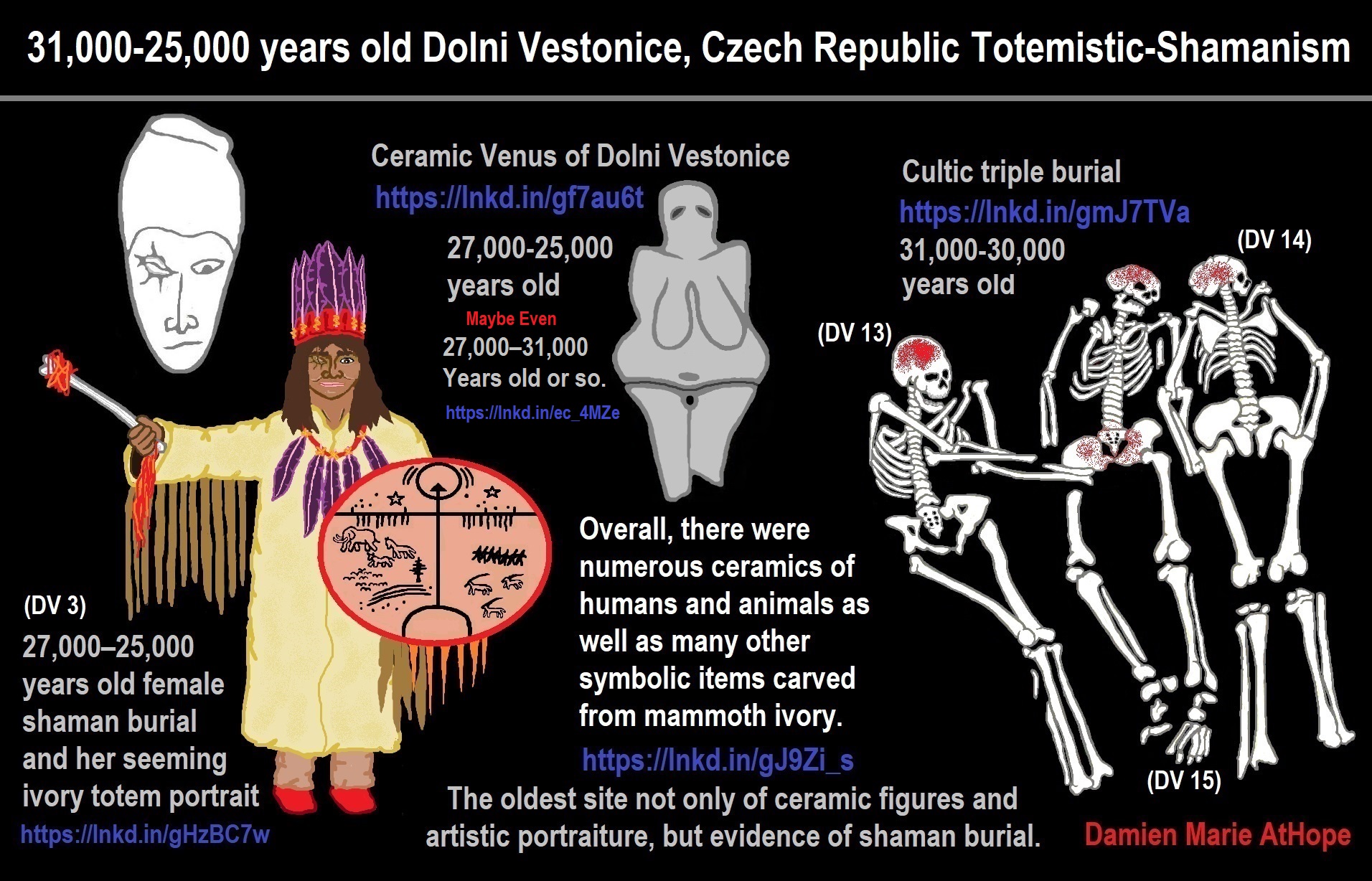
31,000-25,000 Dolni Vestonice, Czech Republic Totemistic-Shamanism
“A remarkable cluster of Pavlovian radiocarbon dates is recorded during the following two millennia, between 27,000 – 25,000 years ago. These dates were received from Willendorf II (layers 6-8), Aggsbach, Krems, Grub/Kranawetberg, Dolní Vestonice – Pavlov, Milovice (settlement), Borsice, Jarosov (settlement), Spytihnev, and Predmostí (the main occupation layer). An increase of microliths, including the geometric microliths (lunates, triangles, trapezes), is typical at this stage, especially within the Dolní Vestonice – Pavlov area. A variety of pointed blades and micro blades continue to occur, but the typical leaf-points are absent at this stage. A few of the 14 C datings from sites like Dolní Vestonice, Milovice, and Jarosov are later than 25,000 years ago; so, for example, the mammoth bone deposits at Milovice and Jarosov are dated later than the related settlements. If these dates are correct, they would suggest a prolongation of occupation at these sites after the Pavlovian.” ref
“The most typical example of another type of Early Gravettian, non-Pavlovian site, is Bodrogkeresztúr-Henye in eastern Hungary. The site provided two dates, 28,700 and 26,300 years ago that place it chronologically to the Early Gravettian. Contrary to the Pavlovian sites, however, the fauna is dominated by horse and elk, and the lithic industry, dominated by burins, retouched blades, endscrapers, and sidescrapers, lacks the typical microliths. In addition, there are differences of a rather functional nature. Nemsová, a workshop site with an Early Gravettian date in western Slovakia, is located near an important raw material source: the radiolarite. Two smaller cave sites, Slaninova Cave and Dzeravá skala Cave, yielded early Gravettian dates in association with fragments of the typical ivory points with circular sections. This may be an evidence for periodical visits of Gravettian hunters in the karstic regions.” ref
31,000-25,000 years old Dolni Vestonice, Czech Republic Totemistic-Shamanism
31,000 – 30,000 Years Ago – Dolni Vestonice (Czech Republic) an Odd Triple Shamanistic Burial

ref, ref, ref, ref, ref, ref, ref, ref, ref, ref, ref, ref, ref
24,000 Years Old Sacred Burial of a Siberian Mal’ta Boy
“The Mal’ta–Buret’ culture is an archaeological culture of the Upper Paleolithic (around 24,000 to 15,000 years ago) on the upper Angara River in the area west of Lake Baikal in the Irkutsk Oblast, Siberia, Russian Federation. The type sites are named for the villages of Mal’ta, Usolsky District and Buret’, Bokhansky District (both in Irkutsk Oblast).” ref
“The “Mal’ta Cluster” is composed of three individuals from the Glacial Maximum 24,000-17,000 years ago from the Lake Baikal region of Siberia.” ref
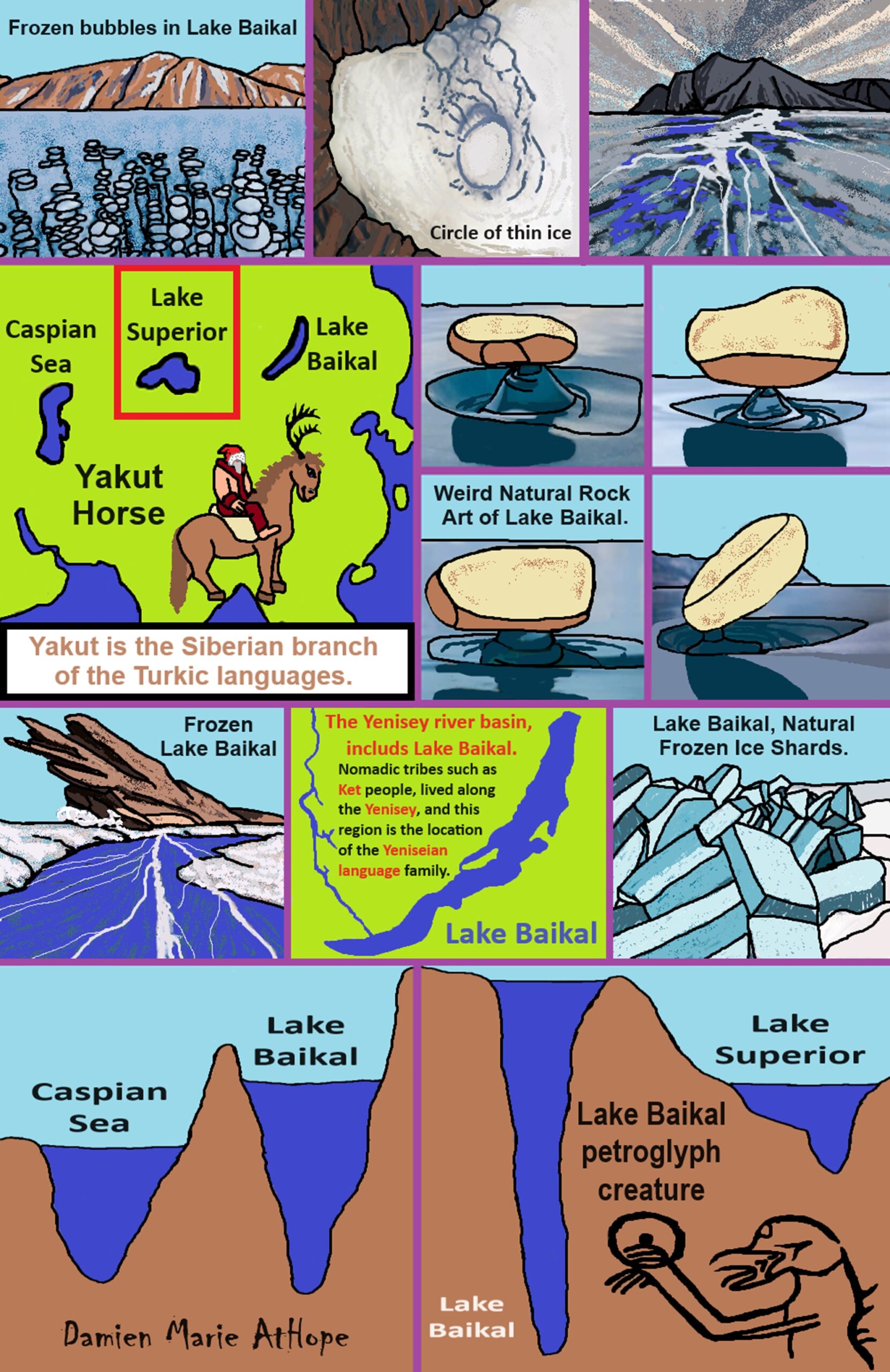
People reached Lake Baikal Siberia around 25,000 years ago. They (to Damien) were likely Animistic Shamanists who were also heavily totemistic as well. Being animistic thinkers they likely viewed amazing things in nature as a part of or related to something supernatural/spiritual (not just natural as explained by science): spirit-filled, a sprit-being relates to or with it, it is a sprit-being, it is a supernatural/spiritual creature, or it is a great spirit/tutelary deity/goddess-god. From there comes mythology and faith in things not seen but are believed to somehow relate or interact with this “real world” we know exists.
Both areas of Lake Baikal, one on the west side with Ancient North Eurasian culture and one on the east side with Ancient Northern East Asian culture (later to become: Ancient Northeast Asian culture) areas are the connected areas that (to Damien) are the origin ancestry religion area for many mythologies and religious ideas of the world by means of a few main migrations and many smaller ones leading to a distribution of religious ideas that even though are vast in distance are commonly related to and centering on Lake Baikal and its surrounding areas like the Amur region and Altai Mountains region.
“Lakes are often mysterious bodies of water, especially if they are very deep or surrounded by mountains. No wonder legends and mysteries thrive about them, including monsters that supposedly lurk in their bottomless depths.” ref
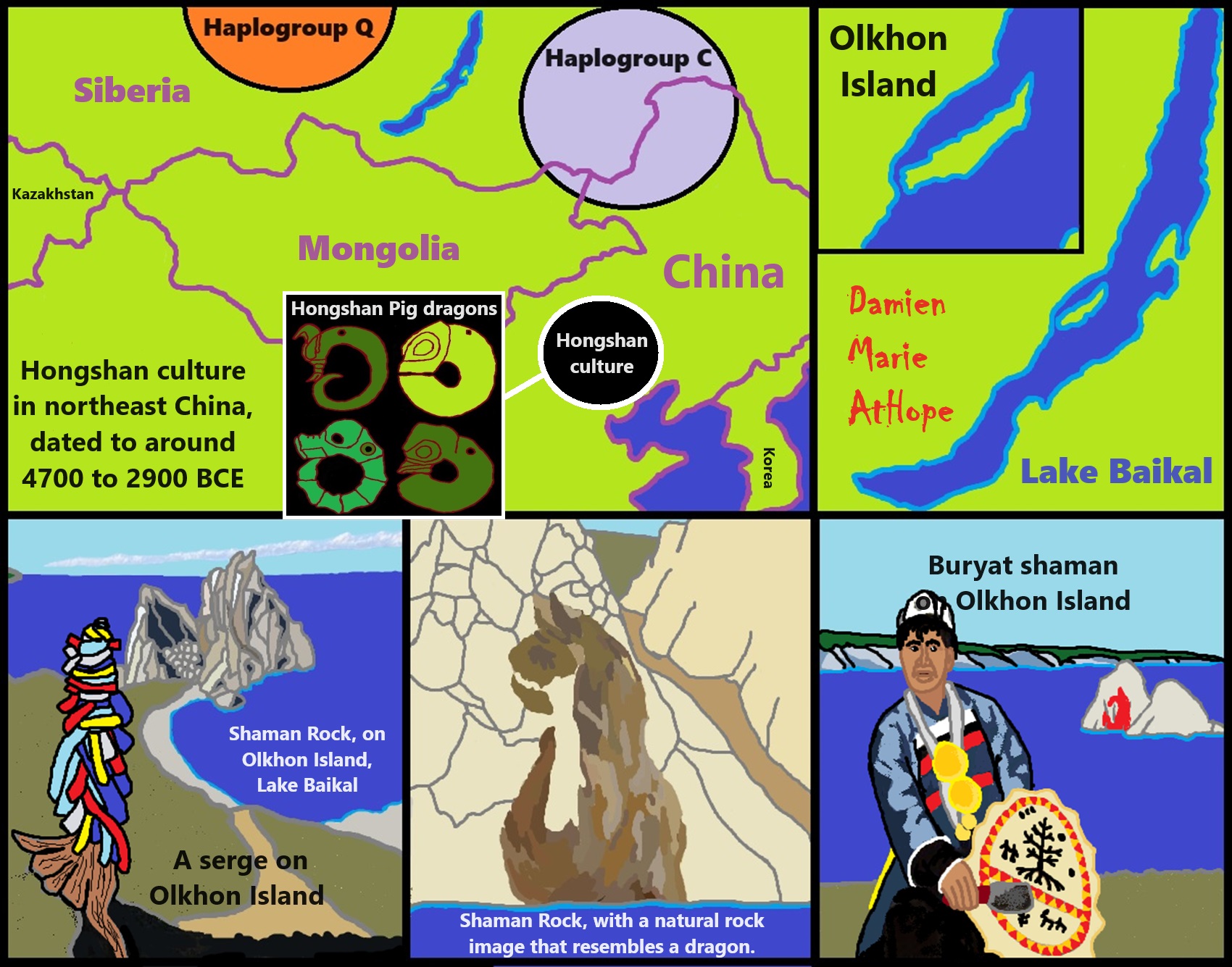
People may have first seen the Shaman Rock with the natural brown rock formation resembling a dragon between 30,000 to 25,000 years ago.
Genetic Relations to Ancient North Eurasians: Zagros/Iranian, Anatolian, Eastern, Caucasus, Western, Scandinavian, and Iberian hunter-gatherers

ref, ref, ref, ref, ref, ref, ref, ref, ref, ref, ref, ref, ref, ref, ref, ref, ref, ref, ref
Here are my thoughts/speculations on where I believe is the possible origin of shamanism, which may have begun sometime around 35,000 to 30,000 years ago seen in the emergence of the Gravettian culture, just to outline his thinking, on what thousands of years later led to evolved Asian shamanism, in general, and thus WU shamanism as well. In both Europe-related “shamanism-possible burials” and in Gravettian mitochondrial DNA is a seeming connection to Haplogroup U. And the first believed Shaman proposed burial belonged to Eastern Gravettians/Pavlovian culture at Dolní Věstonice in southern Moravia in the Czech Republic, which is the oldest permanent human settlement that has ever been found. It is at Dolní Věstonice where approximately 27,000-25,000 years ago a seeming female shaman was buried and also there was an ivory totem portrait figure, seemingly of her.
And my thoughts on how cultural/ritual aspects were influenced in the area of Göbekli Tepe. I think it relates to a few different cultures starting in the area before the Neolithic. Two different groups of Siberians first from northwest Siberia with U6 haplogroup 40,000 to 30,000 or so. Then R Haplogroup (mainly haplogroup R1b but also some possible R1a both related to the Ancient North Eurasians). This second group added its “R1b” DNA of around 50% to the two cultures Natufian and Trialetian. To me, it is likely both of these cultures helped create Göbekli Tepe. Then I think the female art or graffiti seen at Göbekli Tepe to me possibly relates to the Epigravettians that made it into Turkey and have similar art in North Italy. I speculate that possibly the Totem pole figurines seen first at Kostenki, next went to Mal’ta in Siberia as seen in their figurines that also seem “Totem-pole-like”, and then with the migrations of R1a it may have inspired the Shigir idol in Russia and the migrations of R1b may have inspired Göbekli Tepe.
“Migration from Siberia behind the formation of Göbeklitepe: Expert states. People who migrated from Siberia formed the Göbeklitepe, and those in Göbeklitepe migrated in five other ways to spread to the world, said experts about the 12,000-year-old Neolithic archaeological site in the southwestern province of Şanlıurfa.“ The upper paleolithic migrations between Siberia and the Near East is a process that has been confirmed by material culture documents,” he said.” ref
“Semih Güneri, a retired professor from Caucasia and Central Asia Archaeology Research Center of Dokuz Eylül University, and his colleague, Professor Ekaterine Lipnina, presented the Siberia-Göbeklitepe hypothesis they have developed in recent years at the congress held in Istanbul between June 11 and 13. There was a migration that started from Siberia 30,000 years ago and spread to all of Asia and then to Eastern and Northern Europe, Güneri said at the international congress.” ref
“The relationship of Göbeklitepe high culture with the carriers of Siberian microblade stone tool technology is no longer a secret,” he said while emphasizing that the most important branch of the migrations extended to the Near East. “The results of the genetic analyzes of Iraq’s Zagros region confirm the traces of the Siberian/North Asian indigenous people, who arrived at Zagros via the Central Asian mountainous corridor and met with the Göbeklitepe culture via Northern Iraq,” he added.” ref
“Emphasizing that the stone tool technology was transported approximately 7,000 kilometers from east to west, he said, “It is not clear whether this technology is transmitted directly to long distances by people speaking the Turkish language at the earliest, or it travels this long-distance through using way stations.” According to the archaeological documents, it is known that the Siberian people had reached the Zagros region, he said. “There seems to be a relationship between Siberian hunter-gatherers and native Zagros hunter-gatherers,” Güneri said, adding that the results of genetic studies show that Siberian people reached as far as the Zagros.” ref
“There were three waves of migration of Turkish tribes from the Southern Siberia to Europe,” said Osman Karatay, a professor from Ege University. He added that most of the groups in the third wave, which took place between 2600-2400 BCE, assimilated and entered the Germanic tribes and that there was a genetic kinship between their tribes and the Turks. The professor also pointed out that there are indications that there is a technology and tool transfer from Siberia to the Göbeklitepe region and that it is not known whether people came, and if any, whether they were Turkish.” ref
“Around 12,000 years ago, there would be no ‘Turks’ as we know it today. However, there may have been tribes that we could call our ‘common ancestors,’” he added. “Talking about 30,000 years ago, it is impossible to identify and classify nations in today’s terms,” said Murat Öztürk, associate professor from İnönü University. He also said that it is not possible to determine who came to where during the migrations that were accepted to have been made thousands of years ago from Siberia. On the other hand, Mehmet Özdoğan, an academic from Istanbul University, has an idea of where “the people of Göbeklitepe migrated to.” ref
“According to Özdoğan, “the people of Göbeklitepe turned into farmers, and they could not stand the pressure of the overwhelming clergy and started to migrate to five ways.” “Migrations take place primarily in groups. One of the five routes extends to the Caucasus, another from Iran to Central Asia, the Mediterranean coast to Spain, Thrace and [the northwestern province of] Kırklareli to Europe and England, and one route is to Istanbul via [Istanbul’s neighboring province of] Sakarya and stops,” Özdoğan said. In a very short time after the migration of farmers in Göbeklitepe, 300 settlements were established only around northern Greece, Bulgaria, and Thrace. “Those who remained in Göbeklitepe pulled the trigger of Mesopotamian civilization in the following periods, and those who migrated to Mesopotamia started irrigated agriculture before the Sumerians,” he said.” ref
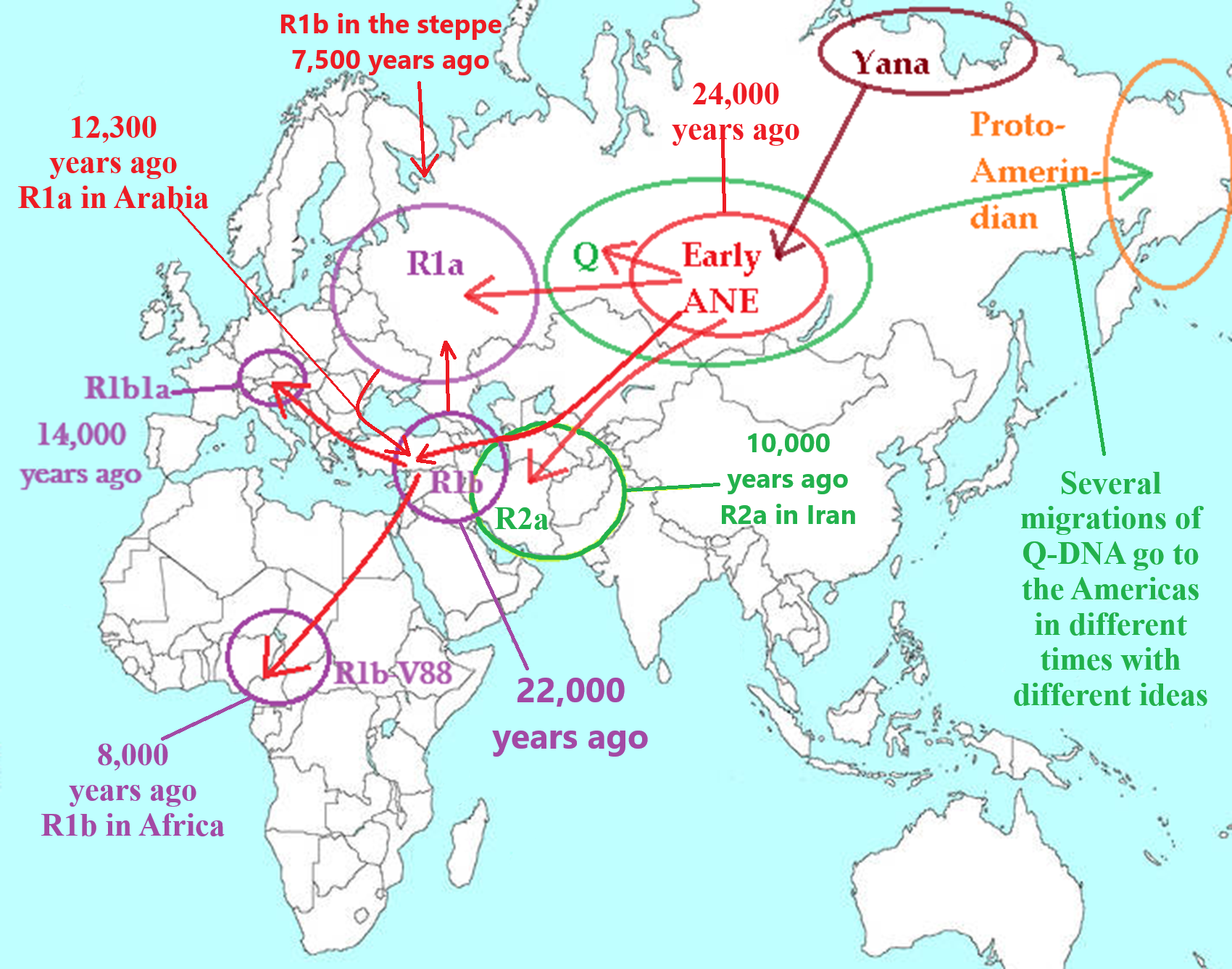
Haplogroup migrations related to the Ancient North Eurasians: I added stuff to this map to help explain.
People reached Lake Baikal Siberia around 25,000 years ago. They (to Damien) were likely Animistic Shamanists who were also heavily totemistic as well. Being animistic thinkers they likely viewed amazing things in nature as a part of or related to something supernatural/spiritual (not just natural as explained by science): spirit-filled, a sprit-being relates to or with it, it is a sprit-being, it is a supernatural/spiritual creature, or it is a great spirit/tutelary deity/goddess-god. From there comes mythology and faith in things not seen but are believed to somehow relate or interact with this “real world” we know exists.
Both areas of Lake Baikal, one on the west side with Ancient North Eurasian culture and one on the east side with Ancient Northern East Asian culture (later to become: Ancient Northeast Asian culture) areas are the connected areas that (to Damien) are the origin ancestry religion area for many mythologies and religious ideas of the world by means of a few main migrations and many smaller ones leading to a distribution of religious ideas that even though are vast in distance are commonly related to and centering on Lake Baikal and its surrounding areas like the Amur region and Altai Mountains region.
To an Animistic Thinker: “Things are not just as they seem, they may have a spirit, or spirit energy relates to them”
To a Totemistic Thinker: “Things are not just as they seem, they may have a spirit, or spirit energy relates to them; they may have religio-cultural importance.”
“Ancient North Eurasian population had Haplogroups R, P, U, and Q DNA types: defined by maternal West-Eurasian ancestry components (such as mtDNA haplogroup U) and paternal East-Eurasian ancestry components (such as yDNA haplogroup P1 (R*/Q*).” ref
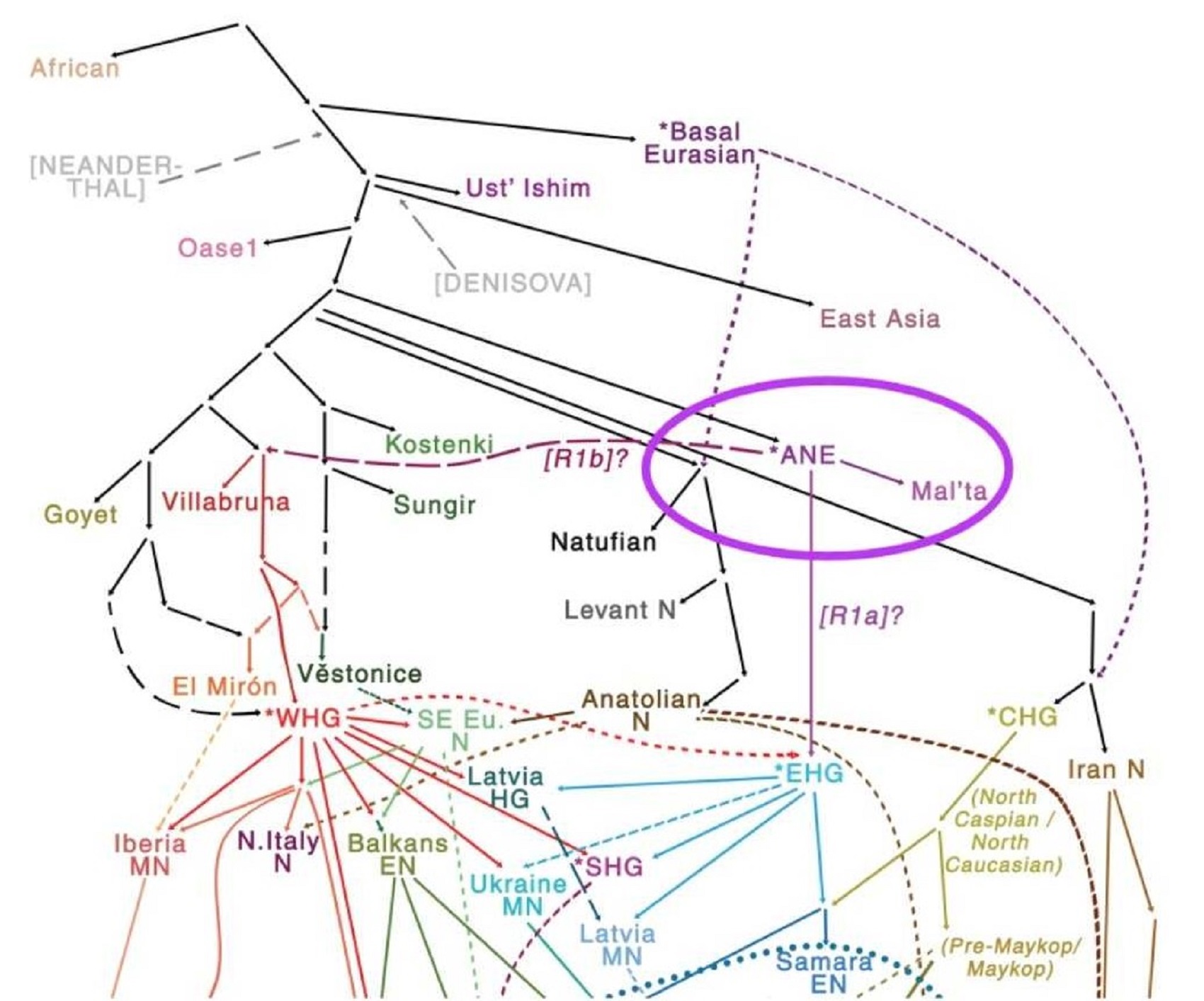
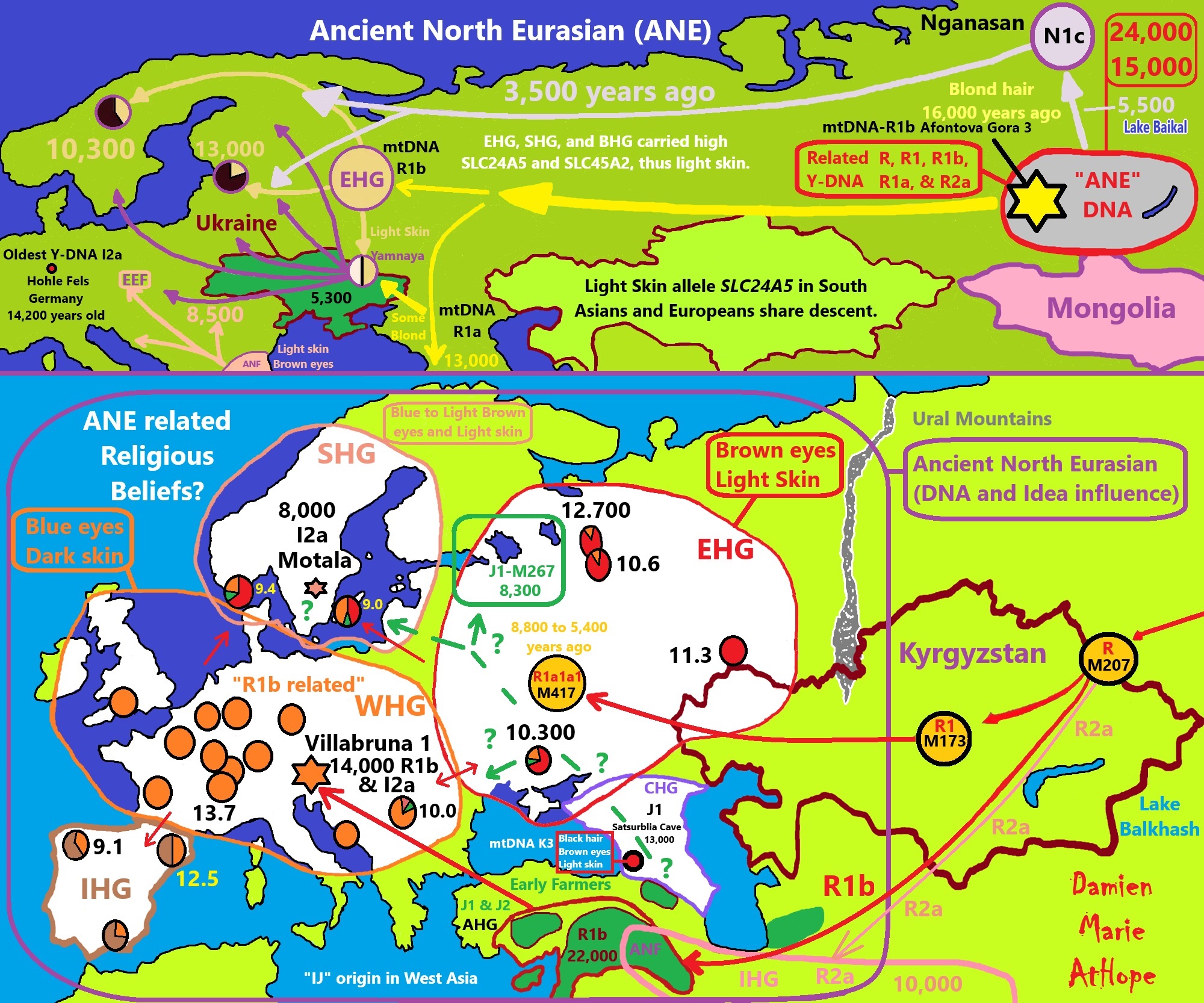
ref, ref, ref, ref, ref, ref, ref, ref, ref, ref, ref, ref, ref, ref, ref, ref, ref, ref, ref, ref, ref, ref, ref, ref, ref, ref, ref, ref, ref
Genetic Relations to Ancient North Eurasians (ANE):
Eastern hunter-gatherer (EHG)
Caucasus hunter-gatherer (CHG)
Zagros/Iranian Hunter-Gatherer (IHG)
Iranian Neolithic Farmers (INF)
Anatolian hunter-gatherer (AHG)
Anatolian Neolithic Farmers (ANF)
Early European Farmers (EEF)
Yamnaya/Steppe Herders (WSH)
Villabruna 1 (burial)/Ripari Villabruna rock shelter in northern Italy (14,000 years old)
Satsurblia Cave (burial) in the Country of Georgia (13,000 years old)
Motala (burial) (8,000 years old)
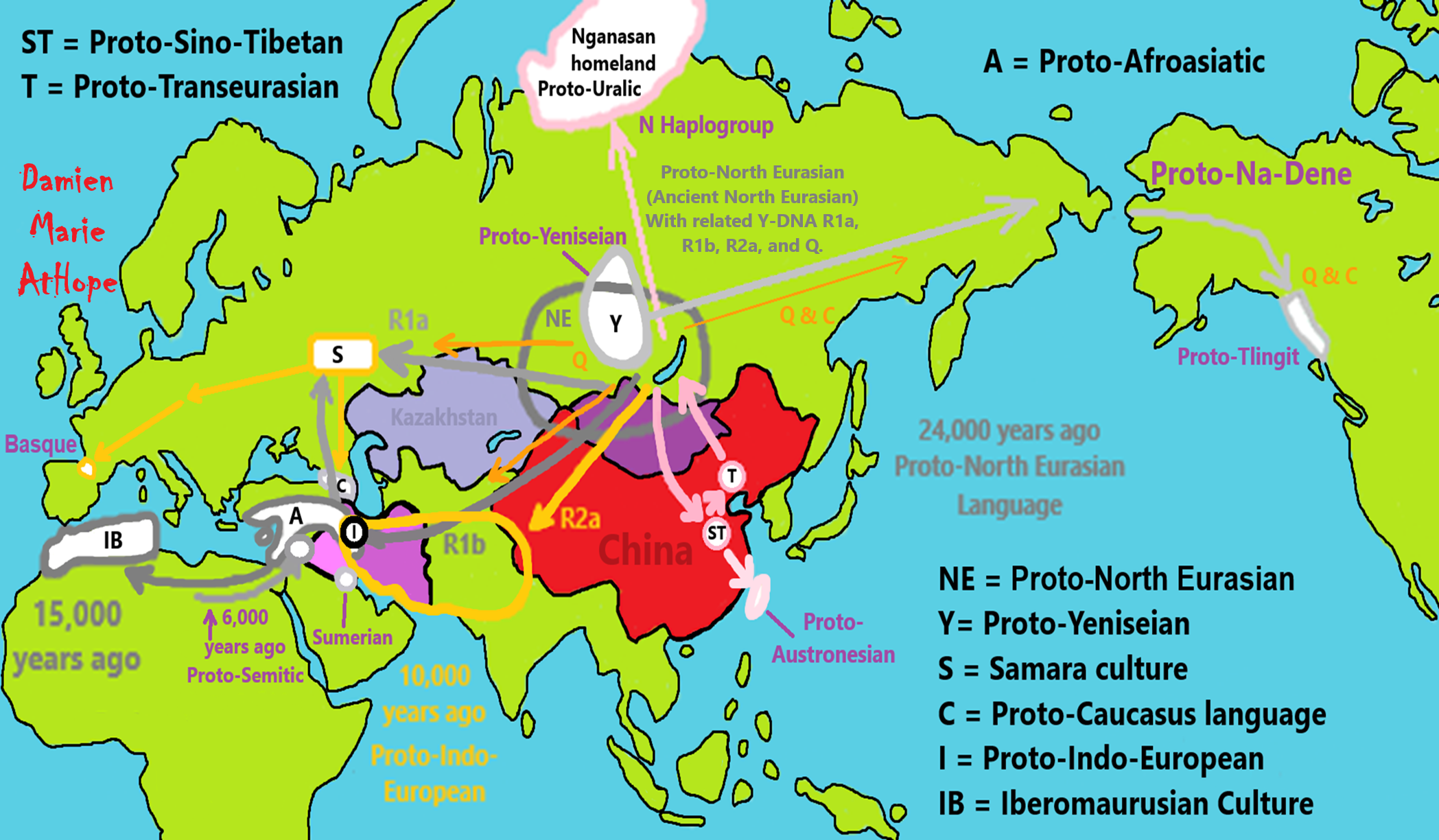
ref, ref, ref, ref, ref, ref, ref, ref, ref, ref, ref, ref, ref, ref, ref, ref, ref, ref, ref, ref, ref, ref, ref, ref, ref, ref, ref, ref, ref, ref, ref
This art above explains my thinking from my life of investigation
I am an anarchist (Social anarchism, Left-wing anarchism, or Socialist anarchism) trying to explain prehistory as I see it after studying it on my own starting 2006. Anarchists are for truth and believe in teaching the plain truth; misinformation is against this, and we would and should fight misinformation and disinformation.
I see anarchism as a social justice issue not limited to some political issue or monetary persuasion. People own themselves, have self/human rights, and deserve freedoms. All humanity is owed respect for its dignity; we are all born equal in dignity and human rights, and no plot of dirt we currently reside on changes this.
I fully enjoy the value (axiology) of archaeology (empirical evidence from fact or artifacts at a site) is knowledge (epistemology) of the past, adding to our anthropology (evidence from cultures both the present and past) intellectual (rational) assumptions of the likely reality of actual events from time past.
I am an Axiological Atheist, Philosopher & Autodidact Pre-Historical Writer/Researcher, Anti-theist, Anti-religionist, Anarcho Humanist, LGBTQI, Race, & Class equality. I am not an academic, I am a revolutionary sharing education and reason to inspire more deep thinking. I do value and appreciate Academics, Archaeologists, Anthropologists, and Historians as they provide us with great knowledge, informing us about our shared humanity.
I am a servant leader, as I serve the people, not myself, not my ego, and not some desire for money, but rather a caring teacher’s heart to help all I can with all I am. From such thoughtfulness may we all see the need for humanism and secularism, respecting all as helpful servant leaders assisting others as often as we can to navigate truth and the beauty of reality.
‘Reality’ ie. real/external world things, facts/evidence such as that confirmed by science, or events taken as a whole documented understanding of what occurred/is likely to have occurred; the accurate state of affairs. “Reason” is not from a mind devoid of “unreason” but rather demonstrates the potential ability to overcome bad thinking. An honest mind, enjoys just correction. Nothing is a justified true belief without valid or reliable reason and evidence; just as everything believed must be open to question, leaving nothing above challenge.
I don’t believe in gods or ghosts, and nor souls either. I don’t believe in heavens or hells, nor any supernatural anything. I don’t believe in Aliens, Bigfoot, nor Atlantis. I strive to follow reason and be a rationalist. Reason is my only master and may we all master reason. Thinking can be random, but reason is organized and sound in its Thinking. Right thinking is reason, right reason is logic, and right logic can be used in math and other scientific methods. I don’t see religious terms Animism, Totemism, Shamanism, or Paganism as primitive but original or core elements that are different parts of world views and their supernatural/non-natural beliefs or thinking.
I am inspired by philosophy, enlightened by archaeology, and grounded by science that religion claims, on the whole, along with their magical gods, are but dogmatic propaganda, myths, and lies. To me, religions can be summed up as conspiracy theories about reality, a reality mind you is only natural and devoid of magic anything. And to me, when people talk as if Atlantis is anything real, I stop taking them seriously. Like asking about the reality of Superman or Batman just because they seem to involve metropolitan cities in their stores. Or if Mother Goose actually lived in a shoe? You got to be kidding.
We are made great in our many acts of kindness, because we rise by helping each other.
NE = Proto-North Eurasian/Ancient North Eurasian/Mal’ta–Buret’ culture/Mal’ta Boy “MA-1” 24,000 years old burial
A = Proto-Afroasiatic/Afroasiatic
S = Samara culture
ST = Proto-Sino-Tibetan/Sino-Tibetan
T = Proto-Transeurasian/Altaic
C = Proto-Northwest Caucasus language/Northwest Caucasian/Languages of the Caucasus
I = Proto-Indo-European/Indo-European
IB = Iberomaurusian Culture/Capsian culture
Natufian culture (15,000–11,500 years ago, Syria, Lebanon, Jordan, the Sinai Peninsula, and the Negev desert)
Nganasan people/Nganasan language
Na-Dene languages/Dené–Yeniseian, Dené–Caucasian
Proto-Semitic/Semitic languages
24,000 years ago, Proto-North Eurasian Language (Ancient North Eurasian) migrations?
My thoughts:
Proto-North Eurasian Language (Ancient North Eurasian) With related Y-DNA R1a, R1b, R2a, and Q Haplogroups.
R1b 22,0000-15,000 years ago in the Middle east creates Proto-Afroasiatic languages moving into Africa around 15,000-10,000 years ago connecting with the Iberomaurusian Culture/Taforalt near the coasts of Morocco, Algeria, and Tunisia.
R2a 10,000 years ago in Iran brings/creates Proto-Indo-European language and also a possibility is R1a in Russia around 9,000 years ago may have had a version of Proto-Indo-European language.
Around 14,000-10,000 years ago??? Proto-North Eurasian Language goes to the Yellow River basin (eventually relating with the Yangshao culture) in China creates Proto-Sino-Tibetan language.
Proto-Sino-Tibetan language then moves to the West Liao River valley (eventually relating with the Hongshan culture) in China creating Proto-Transeurasian (Altaic) language around 9,000 years ago.
N Haplogroups 9,000 years ago with Proto-Transeurasian language possibly moves north to Lake Baikal. Then after living with Proto-North Eurasian Language 24,000-9,000 years ago?/Pre-Proto-Yeniseian language 9,000-7,000 years ago Q Haplogroups (eventually relating with the Ket language and the Ket people) until around 5,500 years ago, then N Haplogroups move north to the Taymyr Peninsula in North Siberia (Nganasan homeland) brings/creates the Proto-Uralic language.
Q Haplogroups with Proto-Yeniseian language /Proto-Na-Dene language likely emerge 8,000/7,000 years ago or so and migrates to the Middle East (either following R2a to Iraq or R1a to Russia (Samara culture) then south to Iraq creates the Sumerian language. It may have also created the Proto-Caucasian languages along the way. And Q Haplogroups with Proto-Yeniseian language to a migration to North America that relates to Na-Dené (and maybe including Haida) languages, of which the first branch was Proto-Tlingit language 5,000 years ago, in the Pacific Northwest.
Sino-Tibetan language then moves more east in China to the Hemudu culture pre-Austronesian culture, next moved to Taiwan creating the Proto-Austronesian language around 6,000-5,500 years ago.
R1b comes to Russia from the Middle East around 7,500 years ago, bringing a version of Proto-Indo-European languages to the (Samara culture), then Q Y-DNA with Proto-Yeniseian language moves south from the (Samara culture) and may have been the language that created the Proto-Caucasian language. And R1b from the (Samara culture) becomes the 4,200 years or so R1b associated with the Basques and Basque language it was taken with R1b, but language similarities with the Proto-Caucasian language implies language ties to Proto-Yeniseian language.

Groups partially derived from the Ancient North Eurasians
“The ANE lineage is defined by association with the MA-1, or “Mal’ta boy”, remains of 24,000 years ago in central Siberia Mal’ta-Buret’ culture 24,000-15,000 years ago. The Ancient North Eurasians (ANE) samples (Afontova Gora 3, Mal’ta 1, and Yana-RHS) show evidence for minor gene flow from an East Asian-related group (simplified by the Amis, Han, or Tianyuan) but no evidence for ANE-related geneflow into East Asians (Amis, Han, Tianyuan), except the Ainu, of North Japan.” ref
“The ANE lineage is defined by association with the MA-1, or “Mal’ta boy”, remains of 24,000 years ago in central Siberia Mal’ta-Buret’ culture 24,000-15,000 years ago “basal to modern-day Europeans”. Some Ancient North Eurasians also carried East Asian populations, such as Tianyuan Man.” ref
“Bronze-age-steppe Yamnaya and Afanasevo cultures were ANE at around 50% and Eastern Hunter-Gatherer (EHG) at around 75% ANE. Karelia culture: Y-DNA R1a-M417 8,400 years ago, Y-DNA J, 7,200 years ago, and Samara, of Y-haplogroup R1b-P297 7,600 years ago is closely related to ANE from Afontova Gora, 18,000 years ago around the time of blond hair first seen there.” ref
Ancient North Eurasian
“In archaeogenetics, the term Ancient North Eurasian (often abbreviated as ANE) is the name given to an ancestral West Eurasian component that represents descent from the people similar to the Mal’ta–Buret’ culture and populations closely related to them, such as from Afontova Gora and the Yana Rhinoceros Horn Site. Significant ANE ancestry are found in some modern populations, including Europeans and Native Americans.” ref
“The ANE lineage is defined by association with the MA-1, or “Mal’ta boy“, the remains of an individual who lived during the Last Glacial Maximum, 24,000 years ago in central Siberia, Ancient North Eurasians are described as a lineage “which is deeply related to Paleolithic/Mesolithic hunter-gatherers in Europe,” meaning that they diverged from Paleolithic Europeans a long time ago.” ref
“The ANE population has also been described as having been “basal to modern-day Europeans” but not especially related to East Asians, and is suggested to have perhaps originated in Europe or Western Asia or the Eurasian Steppe of Central Asia. However, some samples associated with Ancient North Eurasians also carried ancestry from an ancient East Asian population, such as Tianyuan Man. Sikora et al. (2019) found that the Yana RHS sample (31,600 BP) in Northern Siberia “can be modeled as early West Eurasian with an approximately 22% contribution from early East Asians.” ref
“Populations genetically similar to MA-1 were an important genetic contributor to Native Americans, Europeans, Central Asians, South Asians, and some East Asian groups, in order of significance. Lazaridis et al. (2016:10) note “a cline of ANE ancestry across the east-west extent of Eurasia.” The ancient Bronze-age-steppe Yamnaya and Afanasevo cultures were found to have a noteworthy ANE component at ~50%.” ref
“According to Moreno-Mayar et al. 2018 between 14% and 38% of Native American ancestry may originate from gene flow from the Mal’ta–Buret’ people (ANE). This difference is caused by the penetration of posterior Siberian migrations into the Americas, with the lowest percentages of ANE ancestry found in Eskimos and Alaskan Natives, as these groups are the result of migrations into the Americas roughly 5,000 years ago.” ref
“Estimates for ANE ancestry among first wave Native Americans show higher percentages, such as 42% for those belonging to the Andean region in South America. The other gene flow in Native Americans (the remainder of their ancestry) was of East Asian origin. Gene sequencing of another south-central Siberian people (Afontova Gora-2) dating to approximately 17,000 years ago, revealed similar autosomal genetic signatures to that of Mal’ta boy-1, suggesting that the region was continuously occupied by humans throughout the Last Glacial Maximum.” ref
“The earliest known individual with a genetic mutation associated with blonde hair in modern Europeans is an Ancient North Eurasian female dating to around 16000 BCE from the Afontova Gora 3 site in Siberia. It has been suggested that their mythology may have included a narrative, found in both Indo-European and some Native American fables, in which a dog guards the path to the afterlife.” ref
“Genomic studies also indicate that the ANE component was introduced to Western Europe by people related to the Yamnaya culture, long after the Paleolithic. It is reported in modern-day Europeans (7%–25%), but not of Europeans before the Bronze Age. Additional ANE ancestry is found in European populations through paleolithic interactions with Eastern Hunter-Gatherers, which resulted in populations such as Scandinavian Hunter-Gatherers.” ref
“The Ancient North Eurasians (ANE) split from the ancestors of European peoples somewhere in the Middle East or South-central Asia, and used a northern dispersal route through Central Asia into Northern Asia and Siberia. Genetic analyses show that all ANE samples (Afontova Gora 3, Mal’ta 1, and Yana-RHS) show evidence for minor gene flow from an East Asian-related group (simplified by the Amis, Han, or Tianyuan). In contrast, no evidence for ANE-related geneflow into East Asians (Amis, Han, Tianyuan), except the Ainu, was found.” ref
“Genetic data suggests that the ANE formed during the Terminal Upper-Paleolithic (36+-1,5ka) period from a deeply European-related population, which was once widespread in Northern Eurasia, and from an early East Asian-related group, which migrated northwards into Central Asia and Siberia, merging with this deeply European-related population. These population dynamics and constant northwards geneflow of East Asian-related ancestry would later gave rise to the “Ancestral Native Americans” and Paleosiberians, which replaced the ANE as dominant population of Siberia.” ref
Groups partially derived from the Ancient North Eurasians
“Eastern Hunter-Gatherer (EHG) is a lineage derived predominantly (75%) from ANE. It is represented by two individuals from Karelia, one of Y-haplogroup R1a-M417, dated c. 8.4 kya, the other of Y-haplogroup J, dated c. 7.2 kya; and one individual from Samara, of Y-haplogroup R1b-P297, dated c. 7.6 kya. This lineage is closely related to the ANE sample from Afontova Gora, dated c. 18 kya. After the end of the Last Glacial Maximum, the Western Hunter-Gatherers (WHG) and EHG lineages merged in Eastern Europe, accounting for early presence of ANE-derived ancestry in Mesolithic Europe. Evidence suggests that as Ancient North Eurasians migrated West from Eastern Siberia, they absorbed Western Hunter-Gatherers and other West Eurasian populations as well.” ref
“Caucasian Hunter-Gatherer (CHG) is represented by the Satsurblia individual dated ~13 kya (from the Satsurblia cave in Georgia), and carried 36% ANE-derived admixture. While the rest of their ancestry is derived from the Dzudzuana cave individual dated ~26 kya, which lacked ANE-admixture, Dzudzuana affinity in the Caucasus decreased with the arrival of ANE at ~13 kya Satsurblia.” ref
“Scandinavian Hunter-Gatherer (SHG) is represented by several individuals buried at Motala, Sweden ca. 6000 BC. They were descended from Western Hunter-Gatherers who initially settled Scandinavia from the south, and later populations of EHG who entered Scandinavia from the north through the coast of Norway.” ref
“Iran Neolithic (Iran_N) individuals dated ~8.5 kya carried 50% ANE-derived admixture and 50% Dzudzuana-related admixture, marking them as different from other Near-Eastern and Anatolian Neolithics who didn’t have ANE admixture. Iran Neolithics were later replaced by Iran Chalcolithics, who were a mixture of Iran Neolithic and Near Eastern Levant Neolithic.” ref
“Ancient Beringian/Ancestral Native American are specific archaeogenetic lineages, based on the genome of an infant found at the Upward Sun River site (dubbed USR1), dated to 11,500 years ago. The AB lineage diverged from the Ancestral Native American (ANA) lineage about 20,000 years ago.” ref
“West Siberian Hunter-Gatherer (WSHG) are a specific archaeogenetic lineage, first reported in a genetic study published in Science in September 2019. WSGs were found to be of about 30% EHG ancestry, 50% ANE ancestry, and 20% to 38% East Asian ancestry.” ref
“Western Steppe Herders (WSH) is the name given to a distinct ancestral component that represents descent closely related to the Yamnaya culture of the Pontic–Caspian steppe. This ancestry is often referred to as Yamnaya ancestry or Steppe ancestry.” ref
“Late Upper Paeolithic Lake Baikal – Ust’Kyakhta-3 (UKY) 14,050-13,770 BP were mixture of 30% ANE ancestry and 70% East Asian ancestry.” ref
“Lake Baikal Holocene – Baikal Eneolithic (Baikal_EN) and Baikal Early Bronze Age (Baikal_EBA) derived 6.4% to 20.1% ancestry from ANE, while rest of their ancestry was derived from East Asians. Fofonovo_EN near by Lake Baikal were mixture of 12-17% ANE ancestry and 83-87% East Asian ancestry.” ref
“Hokkaido Jōmon people specifically refers to the Jōmon period population of Hokkaido in northernmost Japan. Though the Jōmon people themselves descended mainly from East Asian lineages, one study found an affinity between Hokkaido Jōmon with the Northern Eurasian Yana sample (an ANE-related group, related to Mal’ta), and suggest as an explanation the possibility of minor Yana gene flow into the Hokkaido Jōmon population (as well as other possibilities). A more recent study by Cooke et al. 2021, confirmed ANE-related geneflow among the Jōmon people, partially ancestral to the Ainu people. ANE ancestry among Jōmon people is estimated at 21%, however, there is a North to South cline within the Japanese archipelago, with the highest amount of ANE ancestry in Hokkaido and Tohoku.” ref
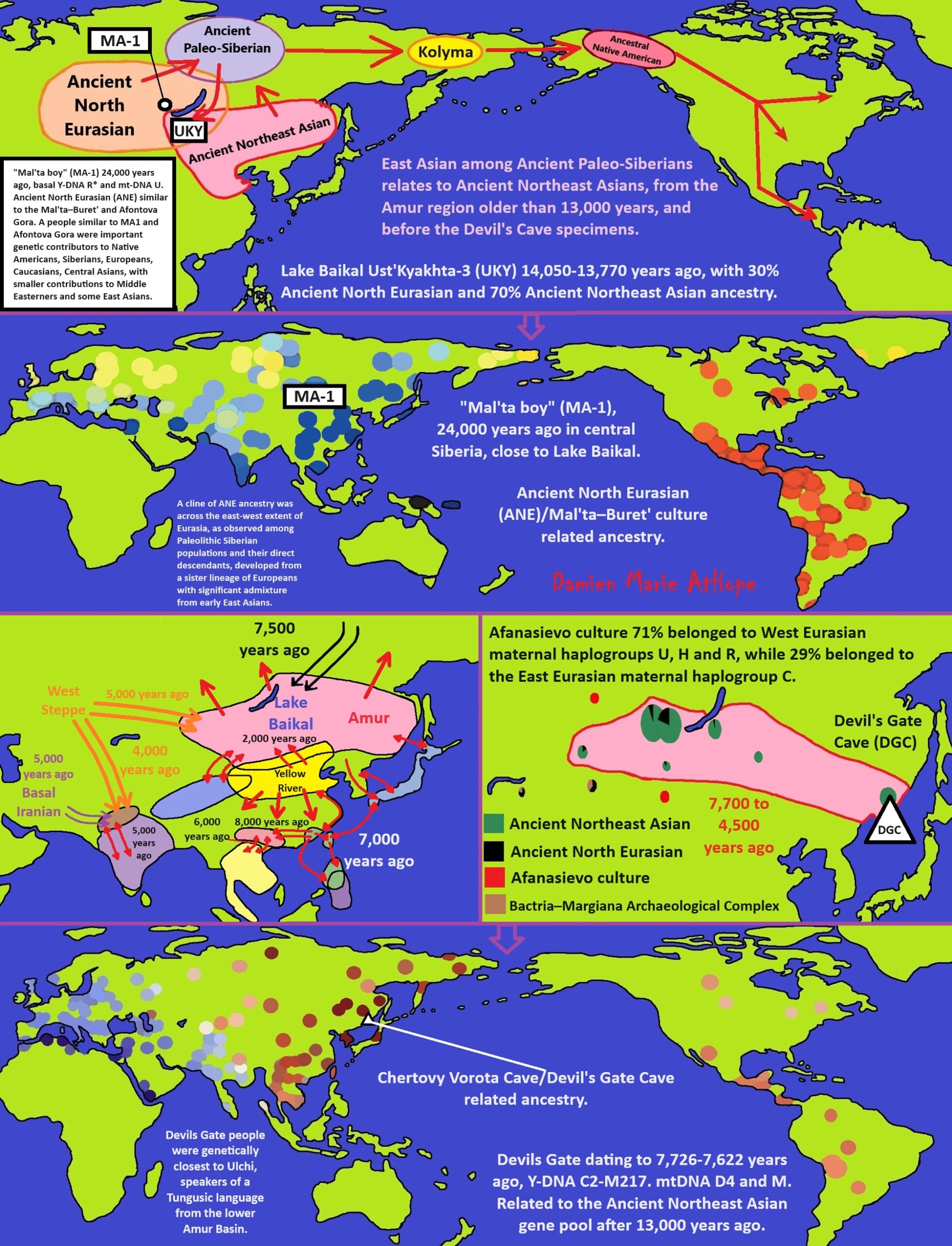
ref, ref, ref, ref, ref, ref, ref, ref, ref, ref, ref, ref, ref, ref, ref
“A 2016 study found that the global maximum of Ancient North Eurasian (ANE) ancestry occurs in modern-day Kets, Mansi, Native Americans, and Selkups. ANE ancestry has spread throughout Eurasia and the Americas in various migrations since the Upper Paleolithic, and more than half of the world’s population today derives between 5 and 42% of their genomes from the Ancient North Eurasians. Significant ANE ancestry can be found in Native Americans, as well as in regions of northern Europe, South Asia, Central Asia, and Siberia. It has been suggested that their mythology may have featured narratives shared by both Indo-European and some Native American cultures, such as the existence of a metaphysical world tree and a fable in which a dog guards the path to the afterlife.” ref
Ancient Northern East Asian/ later became Ancient Northeast Asian
Ancient Paleo-Siberian
Mal’ta–Buret’ culture (Mal’ta boy MA-1)
The Kolyma Shaitans: Legends and Reality (I only use just a small part)
“A unique “shaitan” burial was discovered on the bank of Omuk-Kuel Lake in the Middle-Kolyma ulus in Yakutia. According to the legends, buried in it are mummified remains of a shaman woman who died during a devastating smallpox epidemics in the 18th c. In an attempt to overcome the deadly disease, the shaman’s relatives used her remains as an emeget fetish. The author believes that these legends reflect the real events of those far-away years. The Arabic word “shaitan” came to the Russian language from Turkic languages. According to Islamic tradition, a shaitan is a genie, an evil spirit, a demon. During Russian colonization and Christianization of Siberia, all sacred things used by the aborigines as fetishes, patron spirits of the family, and the tribe, grew to be called “shaitans.” There are various facts, dating to the 18th and 19th cc., confirming that this word also referred to the mummified remains of outstanding shamans.” ref
“In the 1740s, a member of the Second Kamchatka Expedition Yakov Lindenau wrote, “Meat is scratched off the [shaman’s] bones and the bones are put together to form a skeleton, which is dressed in human’s clothes and worshipped as a deity. The Yukagirs place such dressed bones…in their yurts, their number can sometimes reach 10 or 15. If somebody commits even a minor sacrilege with respect to these bones, he stirs up rancor on the part of the Yukagirs… While traveling and hunting, the Yukagirs carry these bones in their sledges, and moreover, in their best sledges pulled by their best deer. When the Yukagirs are going to undertake something really important, they tell fortune using these skeletons: lift a skeleton up, and if it seems light, it means that their enterprise will have a favorable outcome. The Yukagirs call these skeletons stariks (old men), endow them with their best furs, and sit them on beds covered with deer hides, in a circle, as though they are alive.” (Lindenau, 1983, p. 155)” ref
“In the late 19th c., a famous explorer of aboriginal culture V. I. Jochelson noted the changes that occurred in the ritual in the last century and a half. So, the Yukagirs divided among themselves the shaman’s meat dried in the sun and then put it in separate tents. The dead bodies of killed dogs were left there as well. “After that,” V. I. Jochelson writes, “they would divide the shaman’s bones, dry them and wrap in clothes. The skull was an object of worshipping. It was put on top of a trunk (body) cut out of wood. A caftan and two hats – a winter and a summer one – were sewn for the idol. The caftan was all embroidered. On the skull, a special mask was put, with holes for the eyes and the mouth… The figure was placed in the front corner of the home. Before a meal, a piece of food was thrown into the fire and the idol was held above it. This feeding of the idol… was committed before each meal.” (V. I. Jochelson, 2005, pp. 236—237)” ref
“The idol was kept by the children of the dead shaman. One of them was inducted into the shamanism mysteries while his father was still alive. The idol was carried in a wooden box. Sometimes, in line with the air burial ritual, the box was erected on poles or trees, and the idol was taken out only before hunting or a long journey so that the outcome of the enterprise planned could be predicted. With time, the Yukagirs began using wooden idols as charms. V. I. Jochelson notes that by the late 19th c. the Yukagirs had developed a skeptical attitude towards idols and referred to them as “shaitans.” In this way, under the influence of Christianity, the worshipped ancestor’s spirit turned into its opposite – an evil spirit, a devil, a Satan.” ref
Ancestral Native American, Ancient Beringian
14,000-year-old Ust-Kyakhta-3 (UKY) individual found near Lake Baikal
Chertovy Vorota Cave/Devil’s Gate Cave
Bactria–Margiana Archaeological Complex
32,000-21,000 years ago Yana Culture, at the Yana Woolly Rhinoceros Horn Site in Siberia, with genetic proximity to Ancient North Eurasian populations (Mal’ta and Afontova Gora), but also Ust-Ishim, Sunghir, and to a lesser extent Tianyuan, as well as similarities with the Clovis culture
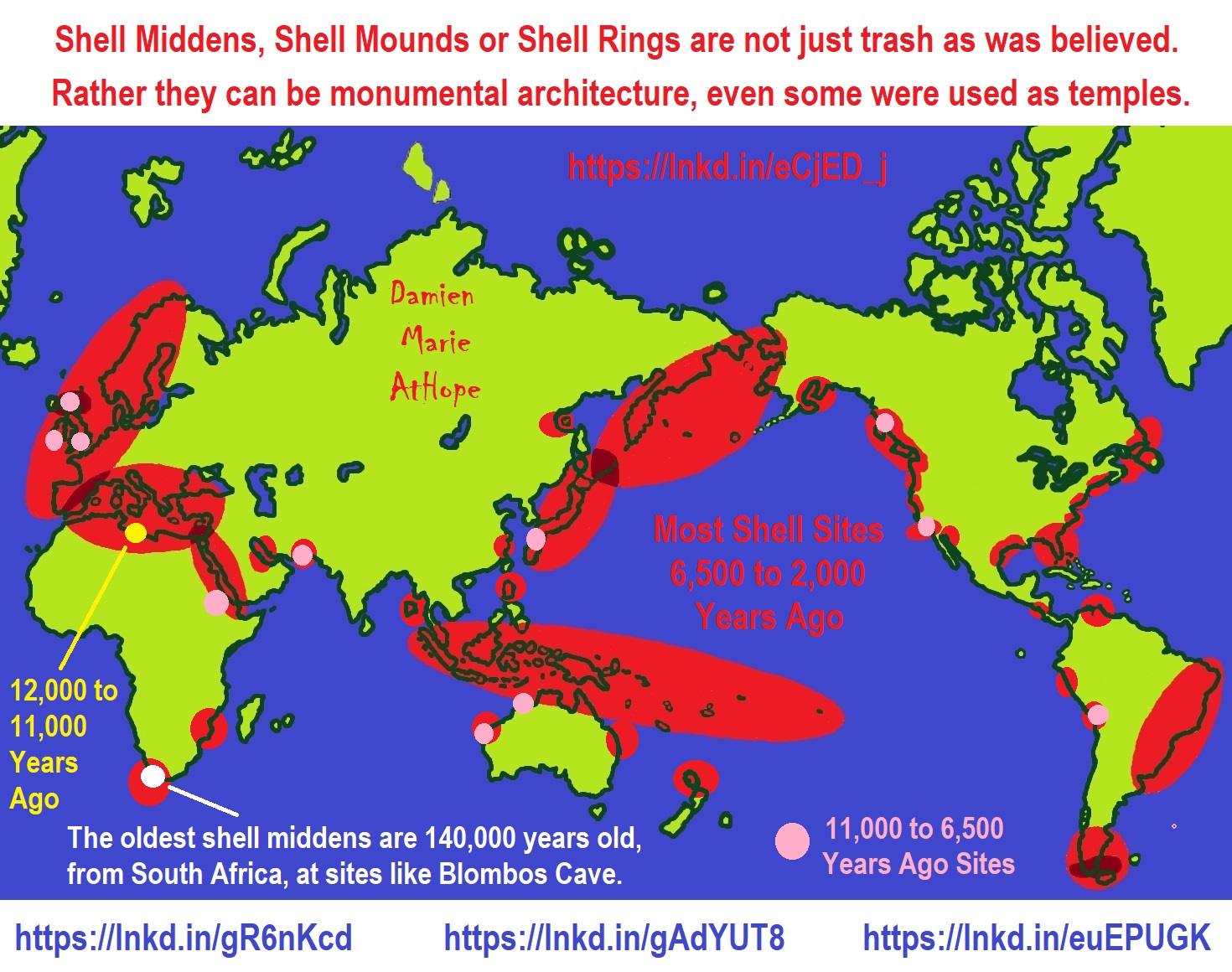
Religion ideas moved both directly by movements or migrations of people as well as by trade or transfer not related to migration. I see actual movements or migrations having more influence on the similar religion beliefs, to me. But both were involved in how religions evolved.
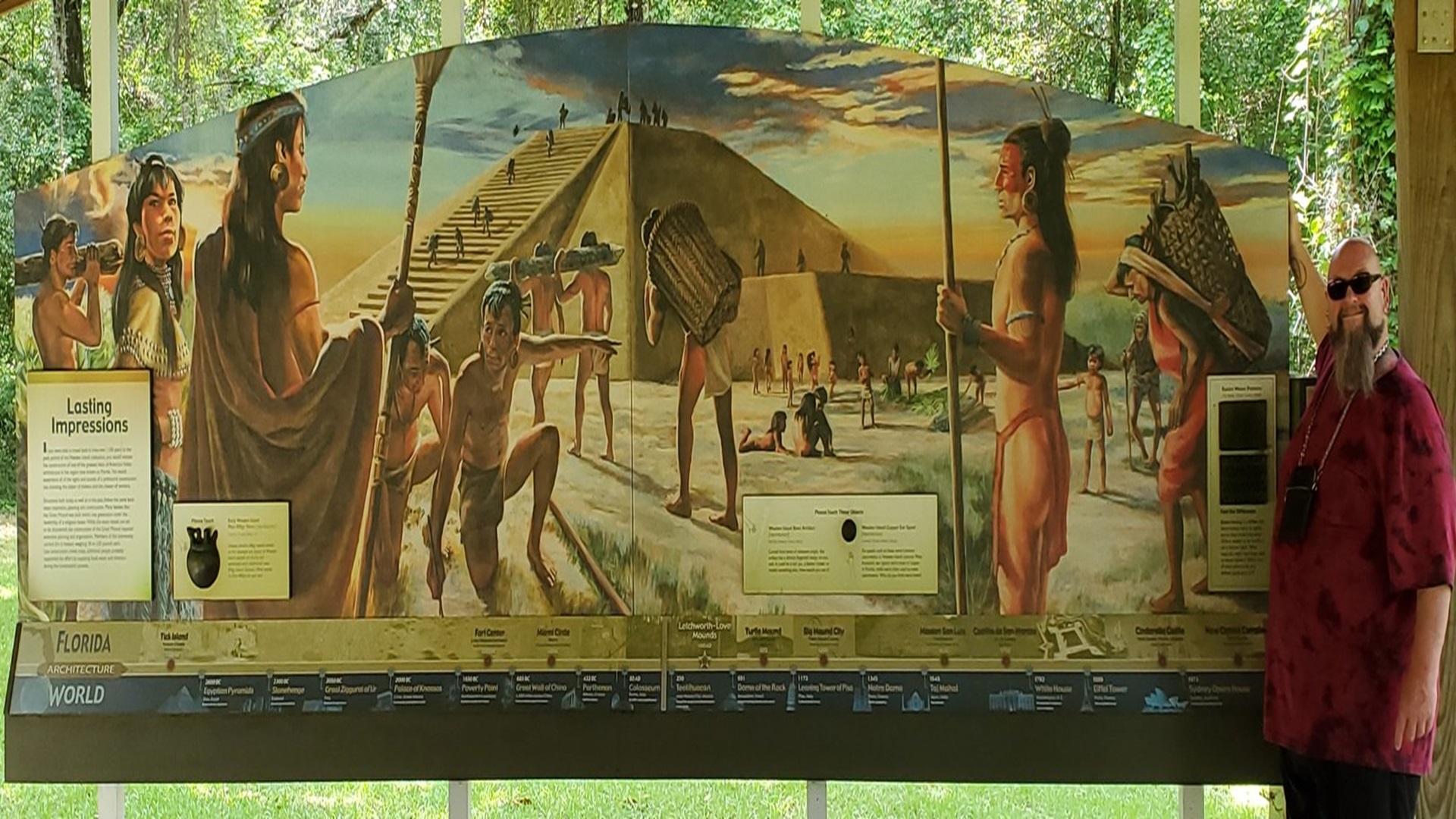
Letchworth-Love Mounds site photo by Shayna Marie AtHope
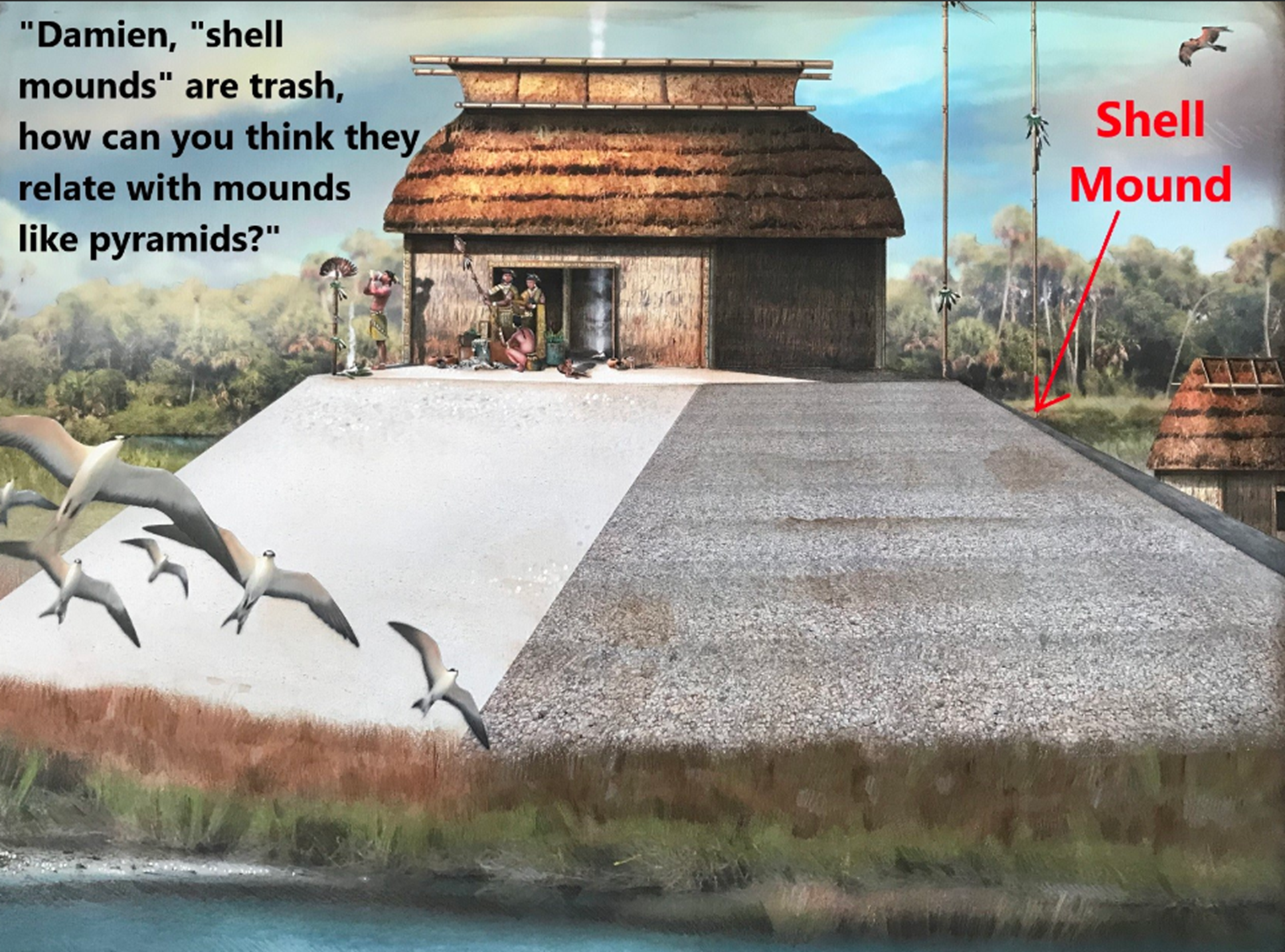
“Damien, “shell mounds” are trash, how can you think they relate with mounds like pyramids?”
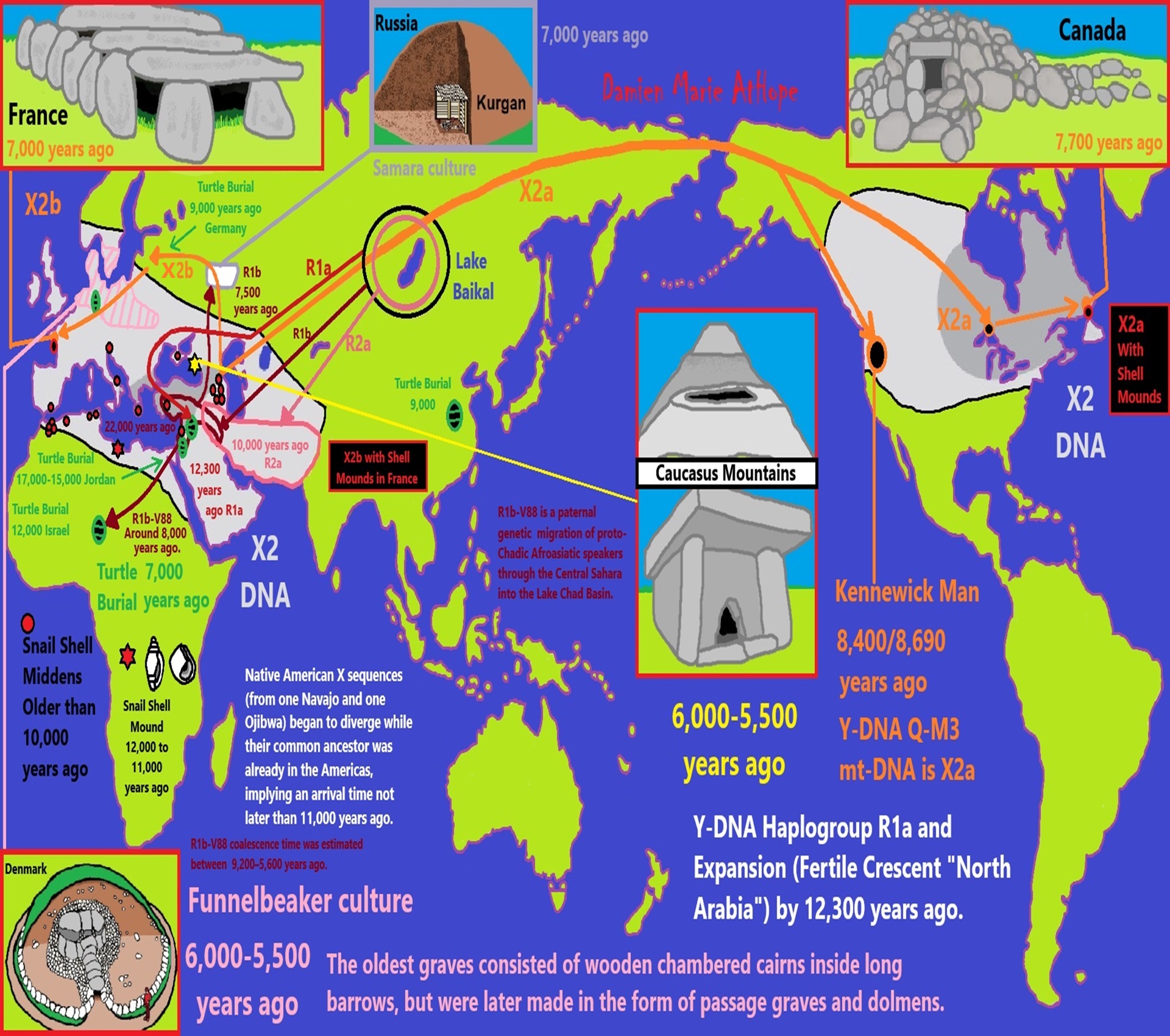
ref, ref, ref, ref, ref, ref, ref, ref, ref, ref, ref, ref, ref, ref, ref, ref, ref, ref, ref, ref, ref, ref, ref, ref, ref, ref, ref, ref, ref, ref, ref, ref, ref, ref, ref, ref, ref, ref, ref
Earth diver mythology or something similar??? Could be. In a way, snails are a kind of mound shape, thus similar to turtle shells, both may represent a mound of creation in the earth-diver myth. In Peru, there were snail shells, and snail shells are also used in the earth diver.
My thoughts on Dolmen origins and migrations, as well as Snail Shell Middens or Snail Burials/Turtle Shell Burials, and links from “Y-DNA R (R1a, R1b, and R2a)” migrations, maybe R2a leading to Proto-Indo-European, transferring it to R1b, taking it to the steppe 7,500 years ago.
Religion is a cultural product. So, it has been part of the human experience, similar to languages, from before we left Africa, spreading humanity across the world.

ref, ref, ref, ref, ref, ref, ref, ref, ref, ref, ref, ref, ref, ref, ref, ref, ref, ref, ref, ref, ref, ref, ref, ref, ref, ref, ref, ref
The earliest centers of pottery origin in the Russian Far East and Siberia: Review of chronology for the oldest Neolithic cultures
“Abstract: The earliest pottery from the Russian Far East, Osipovka and Gromatukha cultural complexes, was radiocarbon-dated to c. 13,300-12,300 years ago. In Siberia, the earliest pottery is known from the Ust-Karenga complex, dated to c. 11,200-10,800 years ago. The Osipovka and Gromatukha complexes belong to the Initial Neolithic, and they are contemporaneous with the earliest Neolithic cultures in southern China and Japan. In spite of the very early emergence of pottery in the Russian Far East, there is no evidence of agriculture at the beginning of the Neolithic, and subsistence remains based on hunting and fishing, including anadromous salmonids in the Amur River and its tributaries.” ref
The earliest Neolithic complex in Siberia: the Ust-Karenga 12 site and its significance for the Neolithisation process in Eurasia
“Abstract: The discovery of Neolithic (i.e. pottery-containing) components at the Ust-Karenga 12 site in northern Transbaikal brought to light new data on the appearance of pottery in Siberia. Excavations and geoarchaeological studies identified the pottery complex in layer 7, 14C-dated to c. 12,180–10,750 years ago (charcoal dates) and c. 11,070–10,600 years ago (pottery organics dates). The pottery is thin and plant fibre-tempered; vessels are round-bottomed and with a comb-pattern design. Ust-Karenga 12 thus preserves by far the earliest Neolithic assemblage in Siberia, and is only slightly younger than the Initial Neolithic complexes of the Amur River basin, Russian Far East (c. 13,300–12,400 years ago).” ref
I think the “kurgan Origin” is found in “Stratified Ritual Mounds”
“From the later seventh-millennium cal BCE, in west Siberia, a new site type emerged in this period, the large, stratified mound (Russian kholm), with examples reaching 50m in diameter and up to 6m in height. These Mounds are characterized by unusual features such as groups of human skulls, clay figurines, bone and antler, hearths, and post-row structures, and are interpreted as ritual or sacrificial sites.” ref
“A kurgan is a type of tumulus constructed over a grave, often characterized by containing a single human body along with grave vessels, weapons, and horses. Some scepter graves could have been covered with a tumulus, placing the first kurgans as early as the 5th millennium BCE in Eastern Europe. Within the burial chamber at the heart of the kurgan, elite individuals were buried with grave goods and sacrificial offerings, sometimes including horses and chariots. These structures are of the earlier Neolithic period from the 4th to the 3rd millenniums BCE.” ref
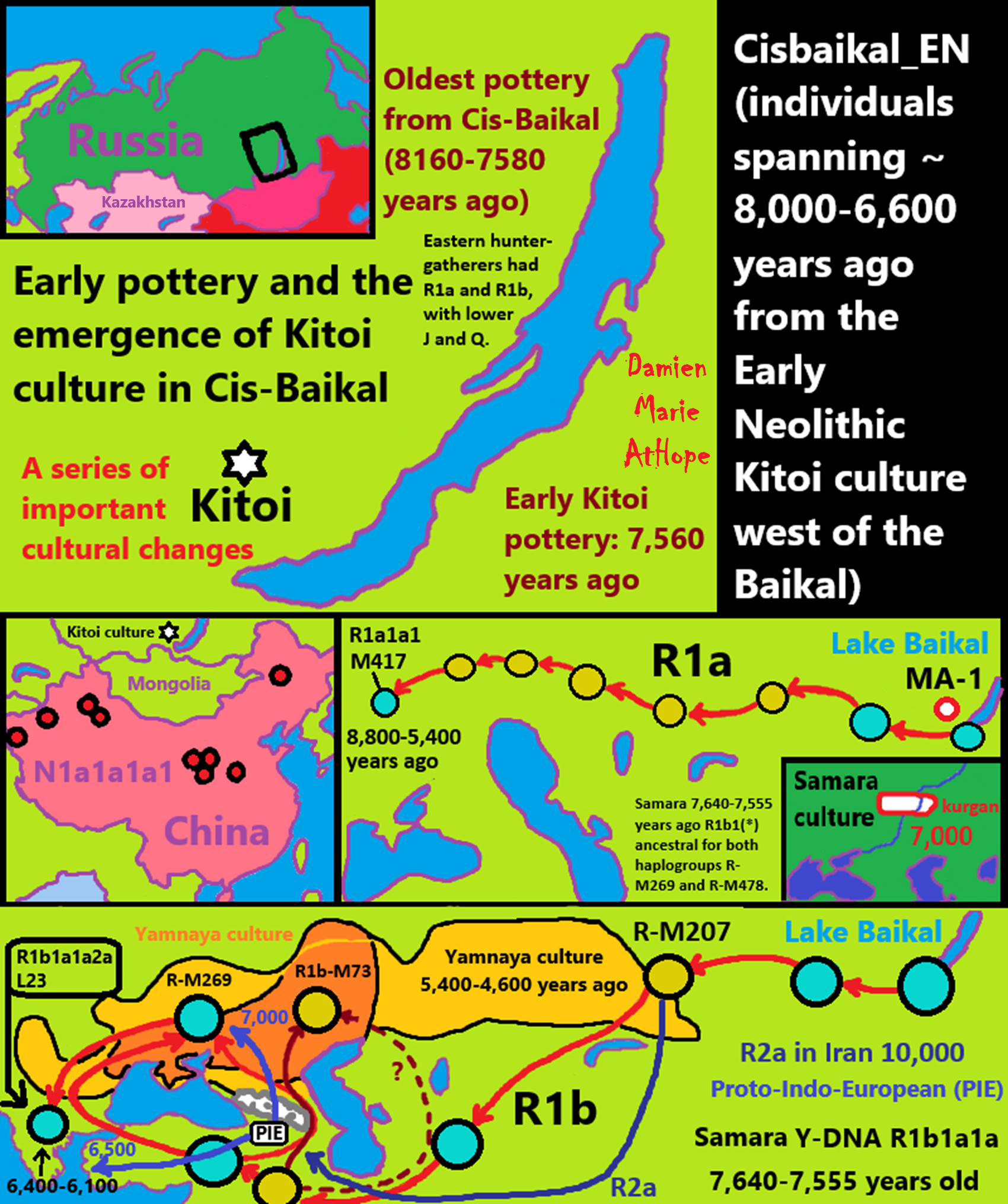
ref, ref, ref, ref, ref, ref, ref, ref, ref, ref, ref, ref, ref, ref, ref, ref, ref, ref, ref
Early Russian Pottery in Cisbaikal Kitoi culture 7,500 years ago, Samara culture 7,000 years ago, and Yamnaya culture 5,600–4,600 years ago, as well as Proto-Indo-European emergence
“The area east of Lake Baikal in Siberia is one of the few regions in Eurasia where pottery was already used during the Late Pleistocene and Early Holocene. Such early pottery complexes were identified in Ust’-Karenga XII, Studenoye 1, Ust’-Menza 1, and Ust’-Khyakhta 3, dated at about 12-000-11,000 years ago. While around 20,000 years ago East Asian hunter-gatherers were already making ceramic pots. (It seems to Damien) that ceramics spread continually from the earliest centers in China, then Japan, and next the Russian Far East, lastly towards the west, all the way to Europe.” ref
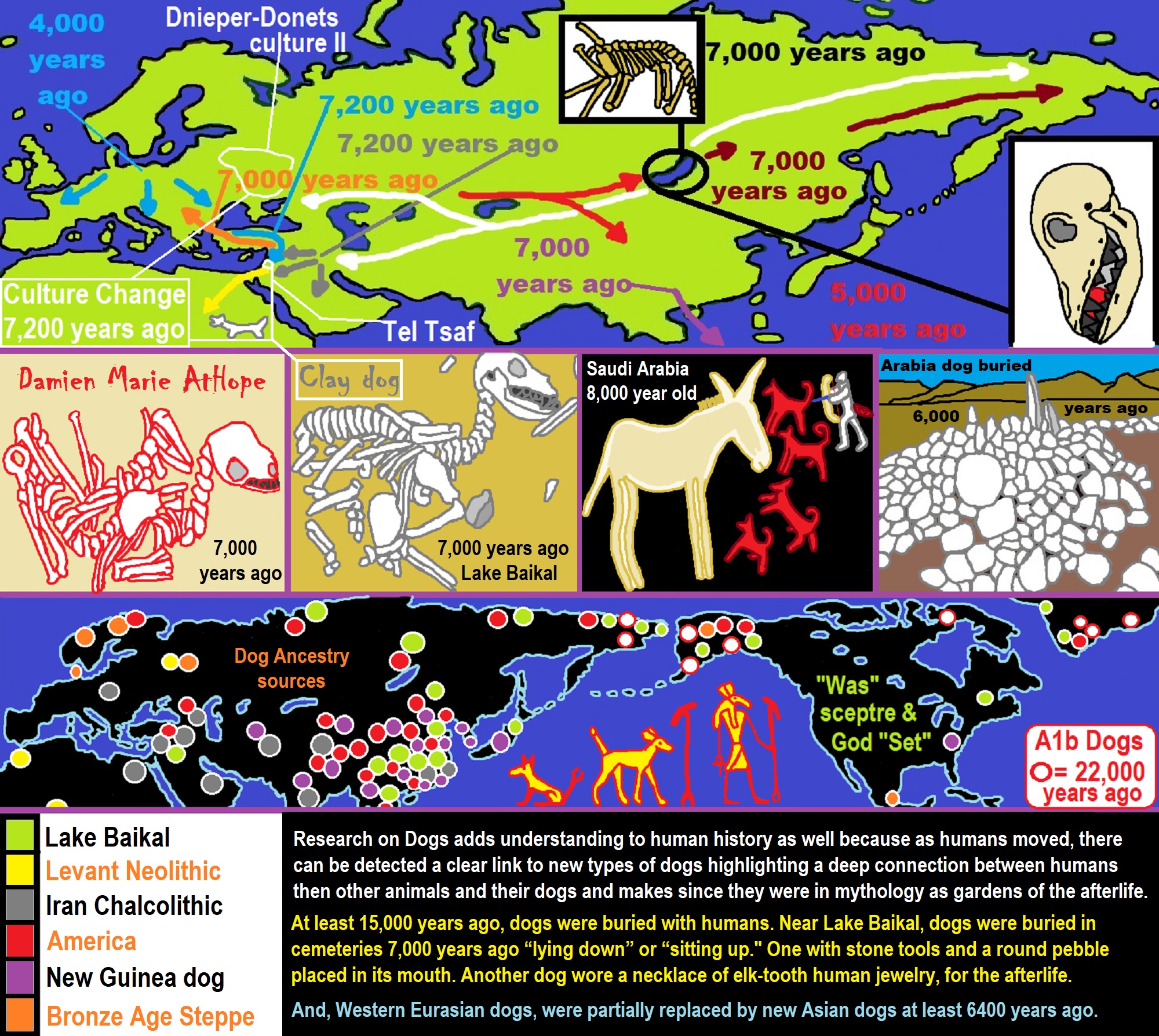
FOLKLORE PARALLELS BETWEEN SIBERIA AND SOUTH ASIA AND THE MYTHOLOGY OF THE EURASIAN STEPPES*
“According to the myth about the origin of man recorded among the people of Eastern Europe and Siberia, the creator set a dog to guard the half-made human figures, but the antagonist bribed the guard and spoiled the creation, making humans vulnerable to disease. The creator told the dog to become the servant of man. Texts recorded in India (mostly among the Munda-speaking groups), the Dards of the Hindu Kush and the Abkhasians, though partly similar to the Northern Eurasian ones, do not share some important details: the antagonist is a horse, it tried to destroy man but a dog drove it away. In the Mongolian (more precisely, the Oirat) version, a cow acts instead of a horse, but in other respects, this variant is similar to the Abkhasian ones. Negative associations related to the horse are rather widespread
in Europe and Central Asia. Stories about the creation of man recorded in northern and southern Eurasia stemmed from the anthropogenic myth that was known to the Indo-Europeans of the Bronze Age. South Asia and the European–Siberian zone also share other tales, in particular the Earth-diver myth. Their analysis opens possibilities for reconstructing the early mythology of the inhabitants of the Eurasian steppe.” ref
Comparative Mythology
“Since the term ‘Ancient North Eurasian’ refers to a genetic bridge of connected mating networks, scholars of comparative mythology have argued that they probably shared myths and beliefs that could be reconstructed via the comparison of stories attested within cultures that were not in contact for millennia and stretched from the Pontic–Caspian steppe to the American continent. The mytheme of the dog guarding the Otherworld possibly stems from an older Ancient North Eurasian belief, as suggested by similar motifs found in Indo-European, Native American and Siberian mythology. In Siouan, Algonquian, Iroquoian, and in Central and South American beliefs, a fierce guard dog was located in the Milky Way, perceived as the path of souls in the afterlife, and getting past it was a test.” ref
“The Siberian Chukchi and Tungus believed in a guardian-of-the-afterlife dog and a spirit dog that would absorb the dead man’s soul and act as a guide in the afterlife. In Indo-European myths, the figure of the dog is embodied by Cerberus, Sarvarā, and Garmr. In Zoroastrianism, two four-eyed dogs guard the bridge to the afterlife called Chinvat Bridge. Anthony and Brown note that it might be one of the oldest mythemes recoverable through comparative mythology.” ref
“A second canid-related series of beliefs, myths and rituals connected dogs with healing rather than death. For instance, Ancient Near Eastern and Turkic–Kipchaq myths are prone to associate dogs with healing and generally categorised dogs as impure. A similar myth-pattern is assumed for the Eneolithic site of Botai in Kazakhstan, dated to 3500 BC, which might represent the dog as absorber of illness and guardian of the household against disease and evil. In Mesopotamia, the goddess Nintinugga, associated with healing, was accompanied or symbolized by dogs. Similar absorbent-puppy healing and sacrifice rituals were practiced in Greece and Italy, among the Hittites, again possibly influenced by Near Eastern traditions.” ref
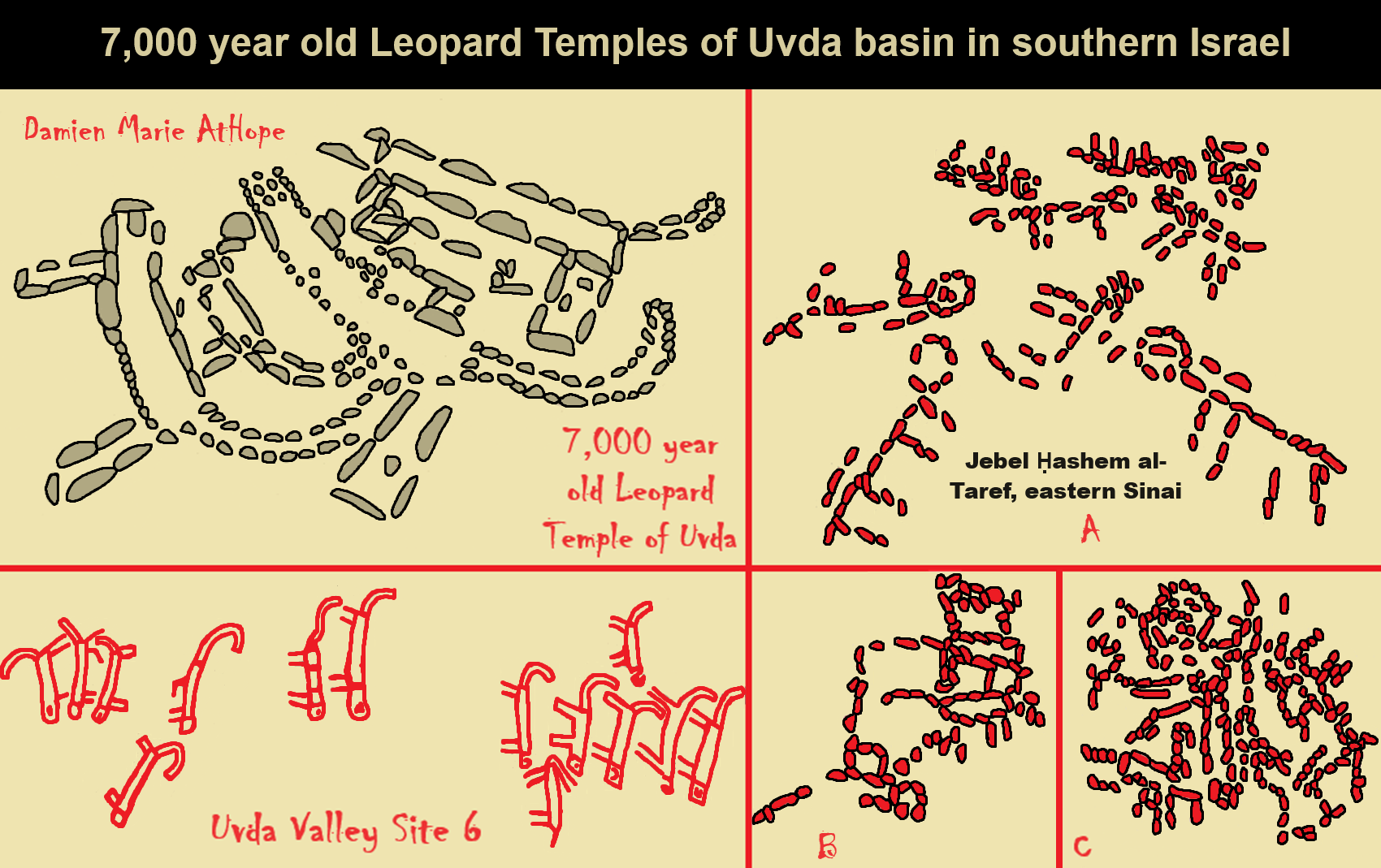
7,000-year-old Leopard (Or Dog?) Temples of Uvda basin in southern Israel
“7,000-year-old Leopard Temple of Uvda, in the Uvda basin in the desert of southern Israel. Uvda (Hebrew: עובדה) is the name of a region in the southern Negev desert, directly north of Eilat. The name derives from the Hebrew word uvda (meaning fact). The Uvda Valley is known for the 7000-year-old Leopard Temple archaeological site. They also began to worship something, perhaps the sun, perhaps their own ancestors, and intriguingly, perhaps the local scourge, the wild leopard.” ref, ref
“Uvda Valley Site 6, “stone drawings” of 15 leopards and one oryx, next to an open-air sanctuary, a vertical view (small stones indicate reconstruction).” ref
“Jebel Ḥashem al-Taref, eastern Sinai, three examples of “stone drawings” built next to pairs of open-air sanctuaries: (a) Excavated; (b,c) Unexcavated, dark stones—vertically set, light stones—fallen. Radiometric dates available to date from open sanctuaries are of the 6th and 5th millennia BCE. Nevertheless, Pre-Pottery Neolithic B flint items were also found in some of them (8th–7th millennia BCE), while other finds indicate continuation through the third millennium BCE, even the early second (Middle Bronze Age).” ref
“All open sanctuaries were built next to ancient roads (Figure 21c and Figure 27), while clusters of sanctuaries were built next to road junctions, for example, a cluster of 33 open sanctuaries near Jebel Ḥashem al-Taref in Sinai, 35 km west of Eilat; 4 pairs of sanctuaries at Ramat Saharonim; and 28 sanctuaries near Har Tzuriʻaz, in the southern Negev. Some sanctuaries were built in burial sites, also located next to ancient roads and road junctions.” ref
“This is also the female’s position in the drawing of a couple from Kuntilat ʻAjrud (Figure 17), slightly behind the male, presented as standing on a higher-like level, and her right leg is hidden behind the male’s left leg. Many open sanctuaries are circular, (Figure 21, Figure 28, and Figure 33). Most of them are 6–18 m in diameter, but tiny circular sanctuaries are also known, ca. 3 m in diameter (Figure 33), as well as large circular cult enclosures up to 70 m in diameter (Figure 33b). Stone alignments are attached to most of the circular sanctuaries, mainly in the form of “ladders,” which are chains of square cells made of a single line of stones or of small flagstones set vertically into the ground (Figure 34 and Figure 36). Their length ranges from a few meters to 78 m, and they present one of the combination of lines and circles.” ref
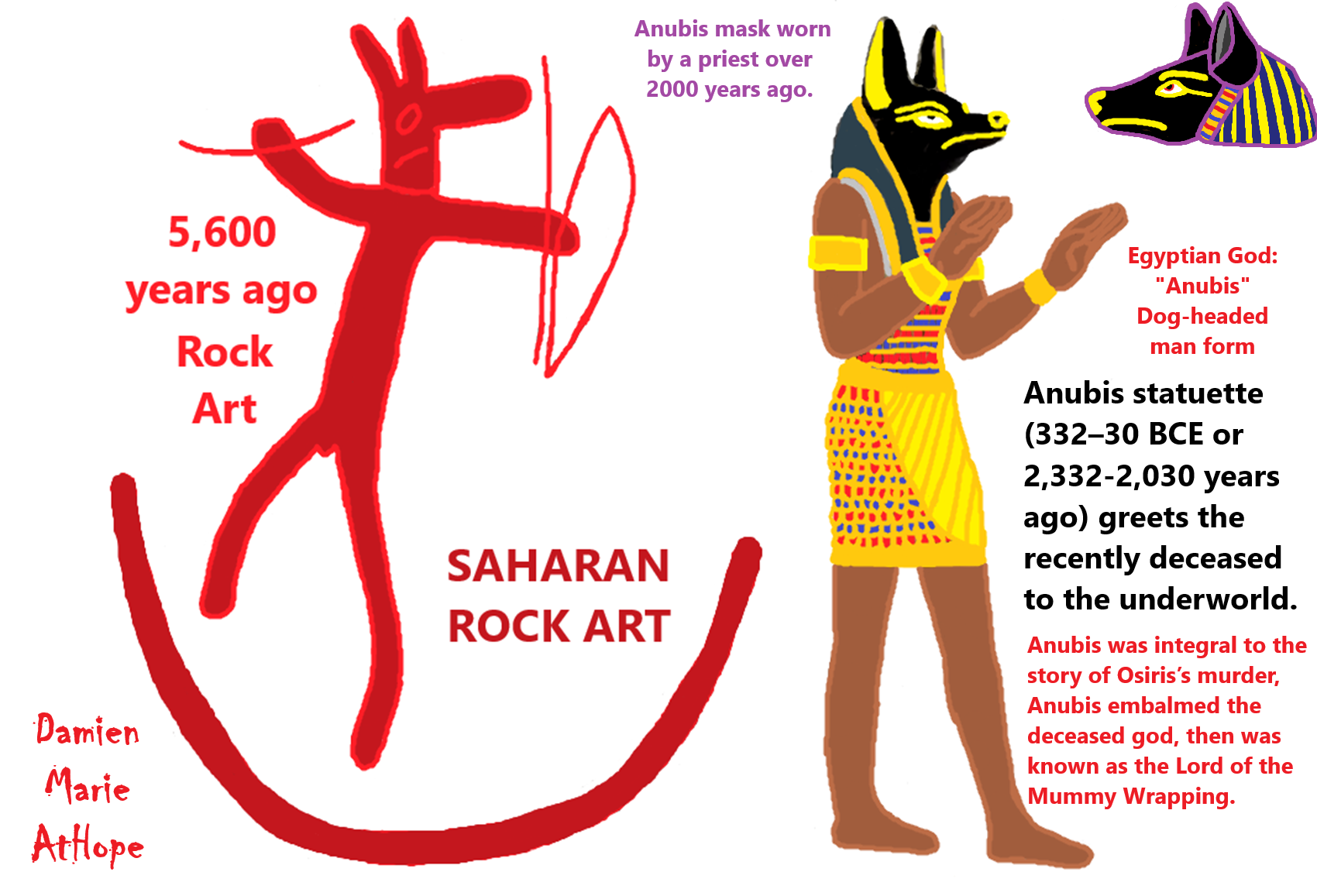
Anubis
“Anubis, also known as Inpu, Inpw, Jnpw, or Anpu in Ancient Egyptian (Coptic: ⲁⲛⲟⲩⲡ, romanized: Anoup), is the god of funerary rites, protector of graves, and guide to the underworld, in ancient Egyptian religion, usually depicted as a canine or a man with a canine head. Like many ancient Egyptian deities, Anubis assumed different roles in various contexts. Depicted as a protector of graves as early as the First Dynasty (c. 3100 – c. 2890 BCE), Anubis was also an embalmer. By the Middle Kingdom (c. 2055–1650 BCE) he was replaced by Osiris in his role as lord of the underworld. One of his prominent roles was as a god who ushered souls into the afterlife. He attended the weighing scale during the “Weighing of the Heart”, in which it was determined whether a soul would be allowed to enter the realm of the dead.” ref
“Anubis is one of the most frequently depicted and mentioned gods in the Egyptian pantheon; however, no relevant myth involved him. Anubis was depicted in black, a color that symbolized regeneration, life, the soil of the Nile River, and the discoloration of the corpse after embalming. Anubis is associated with his brother Wepwawet, another Egyptian god portrayed with a dog’s head or in canine form, but with grey or white fur. Historians assume that the two figures were eventually combined. Anubis’ female counterpart is Anput. His daughter is the serpent goddess Kebechet.” ref
““Anubis” is a Greek rendering of this god’s Egyptian name. Before the Greeks arrived in Egypt, around the 7th century BC, the god was known as Anpu or Inpu. The root of the name in ancient Egyptian language means “a royal child.” Inpu has a root to “inp”, which means “to decay.” The god was also known as “First of the Westerners,” “Lord of the Sacred Land,” “He Who is Upon his Sacred Mountain,” “Ruler of the Nine Bows,” “The Dog who Swallows Millions,” “Master of Secrets,” “He Who is in the Place of Embalming,” and “Foremost of the Divine Booth.” The positions that he had were also reflected in the titles he held such as “He Who Is upon His Mountain,” “Lord of the Sacred Land,” “Foremost of the Westerners,” and “He Who Is in the Place of Embalming.” ref
“In Egypt’s Early Dynastic period (c. 3100 – c. 2686 BCE), Anubis was portrayed in full animal form, with a “jackal” head and body. A jackal god, probably Anubis, is depicted in stone inscriptions from the reigns of Hor-Aha, Djer, and other pharaohs of the First Dynasty. Since Predynastic Egypt, when the dead were buried in shallow graves, jackals had been strongly associated with cemeteries because they were scavengers which uncovered human bodies and ate their flesh. In the spirit of “fighting like with like,” a jackal was chosen to protect the dead, because “a common problem (and cause of concern) must have been the digging up of bodies, shortly after burial, by jackals and other wild dogs which lived on the margins of the cultivation.” ref
“In the Old Kingdom, Anubis was the most important god of the dead. He was replaced in that role by Osiris during the Middle Kingdom (2000–1700 BCE). In the Roman era, which started in 30 BCE, tomb paintings depict him holding the hand of deceased persons to guide them to Osiris. The parentage of Anubis varied between myths, times and sources. In early mythology, he was portrayed as a son of Ra. In the Coffin Texts, which were written in the First Intermediate Period (c. 2181–2055 BCE), Anubis is the son of either the cow goddess Hesat or the cat-headed Bastet. Another tradition depicted him as the son of Ra and Nephthys.” ref
“The Greek Plutarch (c. 40–120 AD) reported a tradition that Anubis was the illegitimate son of Nephthys and Osiris, but that he was adopted by Osiris’s wife Isis:
For when Isis found out that Osiris loved her sister and had relations with her in mistaking her sister for herself, and when she saw a proof of it in the form of a garland of clover that he had left to Nephthys – she was looking for a baby, because Nephthys abandoned it at once after it had been born for fear of Set; and when Isis found the baby helped by the dogs which with great difficulties lead her there, she raised him and he became her guard and ally by the name of Anubis.” ref
“George Hart sees this story as an “attempt to incorporate the independent deity Anubis into the Osirian pantheon.” An Egyptian papyrus from the Roman period (30–380 CE) simply called Anubis the “son of Isis.” In Nubia, Anubis was seen as the husband of his mother Nephthys. In the Ptolemaic period (350–30 BCE), when Egypt became a Hellenistic kingdom ruled by Greek pharaohs, Anubis was merged with the Greek god Hermes, becoming Hermanubis. The two gods were considered similar because they both guided souls to the afterlife.” ref
“The center of this cult was in uten-ha/Sa-ka/ Cynopolis, a place whose Greek name means “city of dogs.” In Book XI of The Golden Ass by Apuleius, there is evidence that the worship of this god was continued in Rome through at least the 2nd century. Indeed, Hermanubis also appears in the alchemical and hermetical literature of the Middle Ages and the Renaissance. Although the Greeks and Romans typically scorned Egyptian animal-headed gods as bizarre and primitive (Anubis was mockingly called “Barker” by the Greeks), Anubis was sometimes associated with Sirius in the heavens and Cerberus and Hades in the underworld. In his dialogues, Plato often has Socrates utter oaths “by the dog” (Greek: kai me ton kuna), “by the dog of Egypt”, and “by the dog, the god of the Egyptians”, both for emphasis and to appeal to Anubis as an arbiter of truth in the underworld.” ref
Anubis Roles
Embalmer
As jmy-wt (Imiut or the Imiut fetish) “He who is in the place of embalming“, Anubis was associated with mummification. He was also called ḫnty zḥ-nṯr “He who presides over the god’s booth”, in which “booth” could refer either to the place where embalming was carried out or the pharaoh’s burial chamber. In the Osiris myth, Anubis helped Isis to embalm Osiris. Indeed, when the Osiris myth emerged, it was said that after Osiris had been killed by Set, Osiris’s organs were given to Anubis as a gift. With this connection, Anubis became the patron god of embalmers; during the rites of mummification, illustrations from the Book of the Dead often show a wolf-mask-wearing priest supporting the upright mummy.” ref
Protector of tombs
Anubis was a protector of graves and cemeteries. Several epithets attached to his name in Egyptian texts and inscriptions referred to that role. Khenty-Amentiu, which means “foremost of the westerners” and was also the name of a different canine funerary god, alluded to his protecting function because the dead were usually buried on the west bank of the Nile. He took other names in connection with his funerary role, such as tpy-ḏw.f (Tepy-djuef) “He who is upon his mountain” (i.e. keeping guard over tombs from above) and nb-t3-ḏsr (Neb-ta-djeser) “Lord of the sacred land”, which designates him as a god of the desert necropolis.” ref
“The Jumilhac papyrus recounts another tale where Anubis protected the body of Osiris from Set. Set attempted to attack the body of Osiris by transforming himself into a leopard. Anubis stopped and subdued Set, however, and he branded Set’s skin with a hot iron rod. Anubis then flayed Set and wore his skin as a warning against evil-doers who would desecrate the tombs of the dead. Priests who attended to the dead wore leopard skin in order to commemorate Anubis’ victory over Set. The legend of Anubis branding the hide of Set in leopard form was used to explain how the leopard got its spots. Most ancient tombs had prayers to Anubis carved on them.” ref
Guide of Dead Souls
“By the late pharaonic era (664–332 BCE), Anubis was often depicted as guiding individuals across the threshold from the world of the living to the afterlife. Though a similar role was sometimes performed by the cow-headed Hathor, Anubis was more commonly chosen to fulfill that function. Greek writers from the Roman period of Egyptian history designated that role as that of “psychopomp“, a Greek term meaning “guide of souls” that they used to refer to their own god Hermes, who also played that role in Greek religion. Funerary art from that period represents Anubis guiding either men or women dressed in Greek clothes into the presence of Osiris, who by then had long replaced Anubis as ruler of the underworld.” ref
Weigher of hearts
“One of the roles of Anubis was as the “Guardian of the Scales.” The critical scene depicting the weighing of the heart, in the Book of the Dead, shows Anubis performing a measurement that determined whether the person was worthy of entering the realm of the dead (the underworld, known as Duat). By weighing the heart of a deceased person against ma’at, who was often represented as an ostrich feather, Anubis dictated the fate of souls. Souls heavier than a feather would be devoured by Ammit, and souls lighter than a feather would ascend to a heavenly existence.” ref
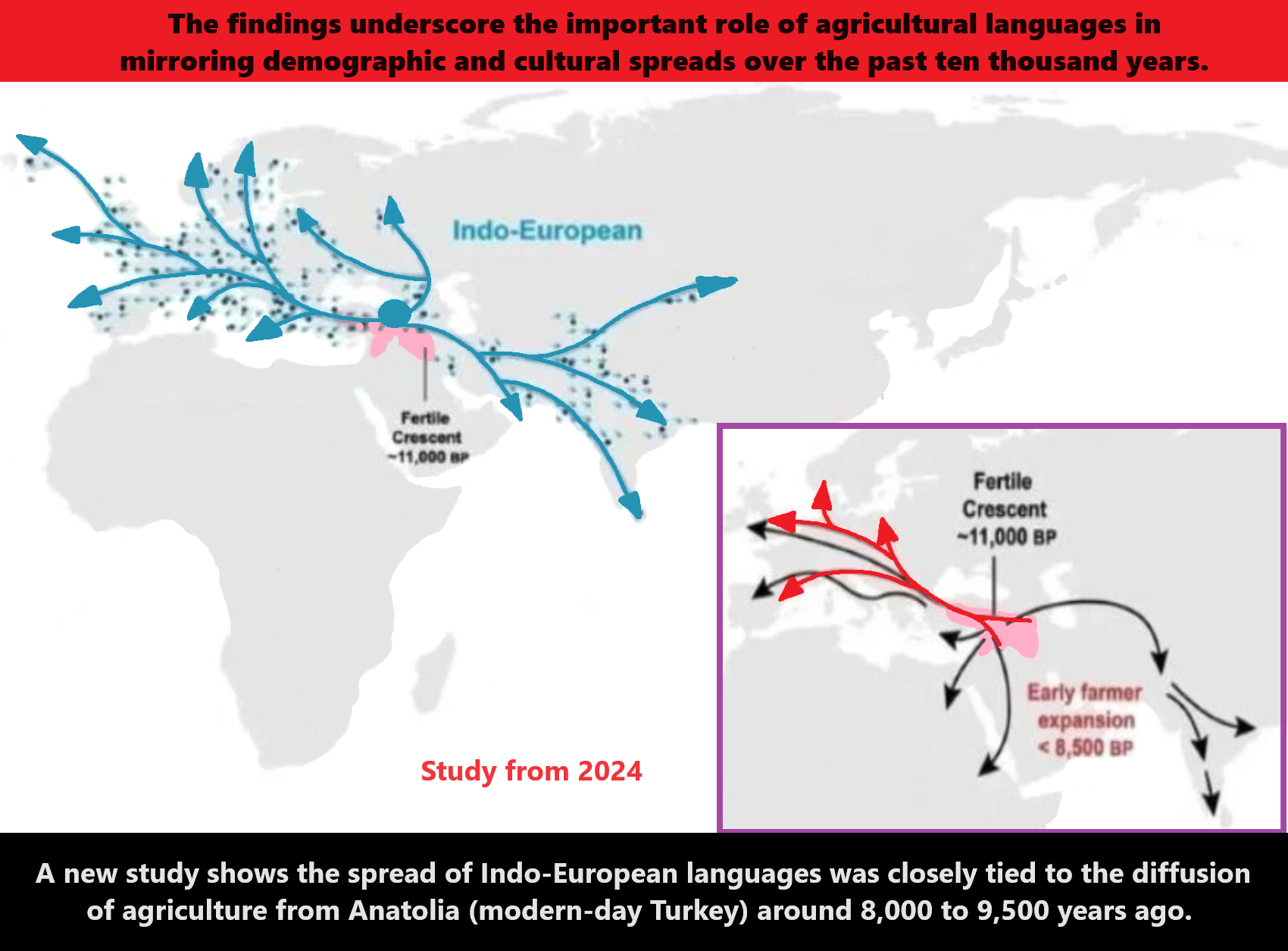
World’s oldest known fort was constructed by hunter-gatherers 8,000 years ago in Siberia
“The fact that this Stone Age fort was built by hunter-gatherers is transforming our understanding of ancient human societies. Hunter-gatherers built the oldest known fort in the world about 8,000 years ago in Siberia, a new study finds. Archaeologists have long associated fortresses with permanent agricultural settlements. However, this cluster of fortified structures reveals that prehistoric groups were constructing protective edifices much earlier than originally thought.” ref
“These hunter-gatherers “defy conventional stereotypes that depict such societies as basic and nomadic, unveiling their capacity to construct intricate structures,” study co-author Tanja Schreiber, an archaeologist at Free University of Berlin, told Live Science in an email. Located along the Amnya River in western Siberia, remains of the Amnya fort include roughly 20 pit-house depressions scattered across the site, which is divided into two sections: Amnya I and Amnya II. Radiocarbon dating confirmed that the settlement was first inhabited during the Mesolithic, or Middle Stone Age, according to the study. When constructed, each pit house would have been protected by earthen walls and wooden palisades — two construction elements that suggest “advanced agricultural and defensive capabilities” by the inhabitants, the archaeologists said in a statement.” ref
“One of the Amnya fort’s most astonishing aspects is the discovery that approximately 8,000 years ago, hunter-gatherers in the Siberian Taiga built intricate defense structures,” Schreiber said. “This challenges traditional assumptions that monumental constructions were solely the work of agricultural communities.” It’s unknown what triggered the need for these fortified structures in the first place, but the strategic location overlooking the river would have not only been an ideal lookout point for potential threats but also allowed hunter-gatherers to keep tabs on their fishing and hunting grounds, the researchers noted.” ref
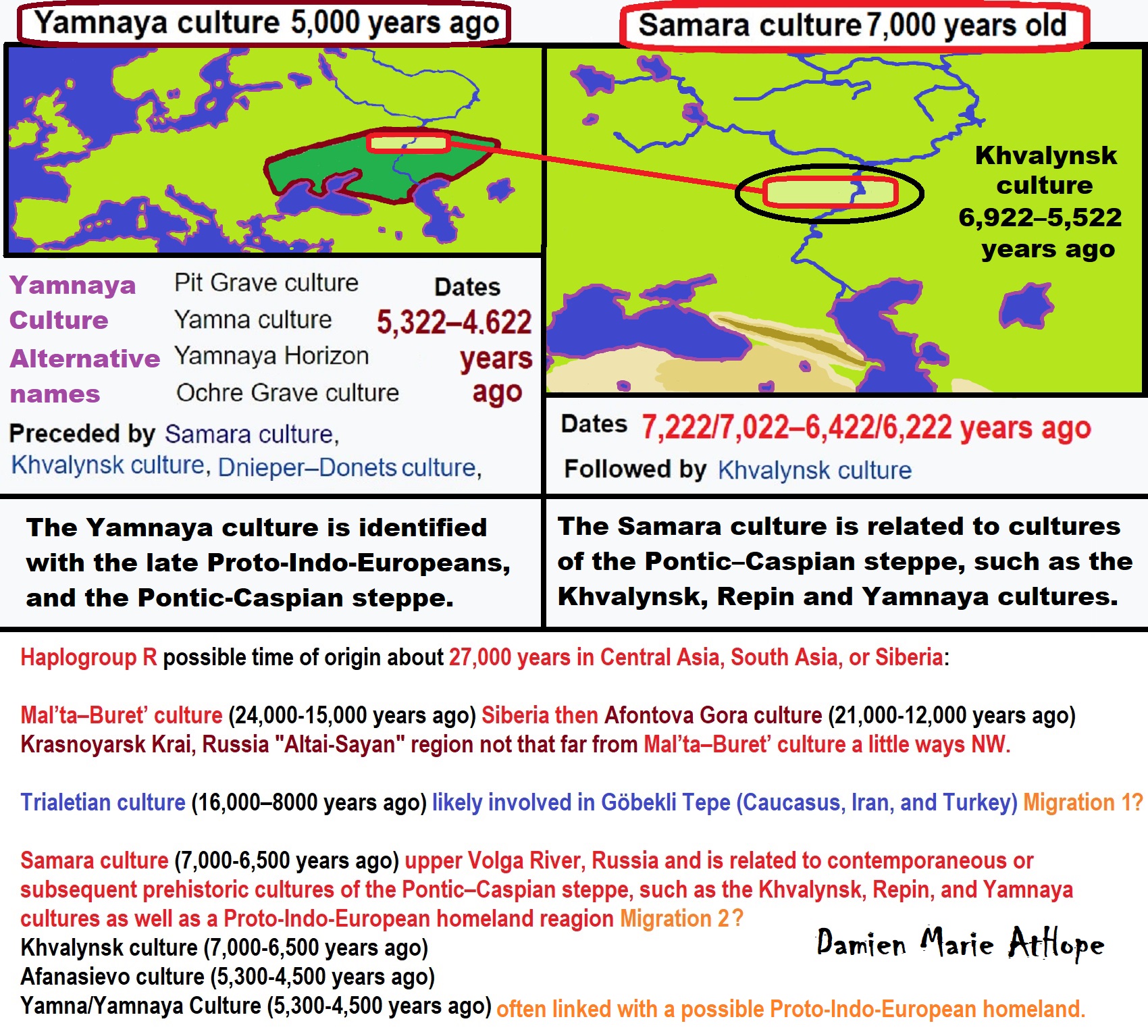
“The Samara culture was an Eneolithic (Copper Age) culture that flourished around the turn of the 5th millennium BCE, at the Samara Bend of the Volga River (modern Russia). The Samara culture is regarded as related to contemporaneous or subsequent prehistoric cultures of the Pontic–Caspian steppe, such as the Khvalynsk, Repin, and Yamna (or Yamnaya) cultures.” ref
“Genetic analyses of a male buried at Lebyazhinka, radiocarbon dated to 5640-5555 BCE, found that he belonged to a population often referred to as “Samara hunter-gatherers”, a group closely associated with Eastern Hunter-Gatherers. The male sample carried Y-haplogroup R1b1a1a and mitochondrial haplogroup U5a1d.” ref
“Pottery consists mainly of egg-shaped beakers with pronounced rims. They were not able to stand on a flat surface, suggesting that some method of supporting or carrying must have been in use, perhaps basketry or slings, for which the rims would have been a useful point of support. The carrier slung the pots over the shoulder or onto an animal. The decoration consists of circumferential motifs: lines, bands, zig-zags, or wavy lines, incised, stabbed, or impressed with a comb. These patterns are best understood when seen from the top. They appear then to be a solar motif, with the mouth of the pot as the sun. Later developments of this theme show that in fact the sun is being represented.” ref
“The culture is characterized by the remains of animal sacrifice, which occur over most of the sites. There is no indisputable evidence of riding, but there were horse burials, the earliest in the Old World. Typically the head and hooves of cattle, sheep, and horses are placed in shallow bowls over the human grave, smothered with ochre. Some have seen the beginning of the horse sacrifice in these remains, but this interpretation has not been more definitely substantiated. We know that the Indo-Europeans sacrificed both animals and people, like many other cultures.” ref
“The graves found are shallow pits for single individuals, but two or three individuals might be placed there. Some of the graves are covered with a stone cairn or a low earthen mound, the very first predecessor of the kurgan. The later, fully developed kurgan was a hill on which the deceased chief might ascend to the sky god, but whether these early mounds had that significance is doubtful.” ref
“Grave offerings included ornaments depicting horses. The graves also had an overburden of horse remains; it cannot yet be determined decisively if these horses were domesticated and ridden or not, but they were certainly used as a meat-animal. Most controversial are bone plaques of horses or double oxen heads, which were pierced. The graves yield well-made daggers of flint and bone, placed at the arm or head of the deceased, one in the grave of a small boy. Weapons in the graves of children are common later. Other weapons are bone spearheads and flint arrowheads. Other carved bone figurines and pendants were found in the graves.” ref
“The Yamnaya culture or the Yamna culture, also known as the Pit Grave culture or Ochre Grave culture, was a late Copper Age to early Bronze Age archaeological culture of the region between the Southern Bug, Dniester, and Ural rivers (the Pontic–Caspian steppe), dating to 3300–2600 BCE or around 5,300 to 4,600 years ago. It was discovered by Vasily Gorodtsov following his archaeological excavations near the Donets River in 1901–1903. Its name derives from its characteristic burial tradition: Я́мная (romanization: yamnaya) is a Russian adjective that means ‘related to pits (yama)’, as these people used to bury their dead in tumuli (kurgans) containing simple pit chambers.” ref
“The Yamnaya economy was based upon animal husbandry, fishing, and foraging, and the manufacture of ceramics, tools, and weapons. The people of the Yamnaya culture lived primarily as nomads, with a chiefdom system and wheeled carts and wagons that allowed them to manage large herds. They are also closely connected to Final Neolithic cultures, which later spread throughout Europe and Central Asia, especially the Corded Ware people and the Bell Beaker culture, as well as the peoples of the Sintashta, Andronovo, and Srubnaya cultures.” ref
“Back migration from Corded Ware also contributed to Sintashta and Andronovo. In these groups, several aspects of the Yamnaya culture are present. Yamnaya material culture was very similar to the Afanasevo culture of South Siberia, and the populations of both cultures are genetically indistinguishable. This suggests that the Afanasevo culture may have originated from the migration of Yamnaya groups to the Altai region or, alternatively, that both cultures developed from an earlier shared cultural source.” ref
“Genetic studies have suggested that the people of the Yamnaya culture can be modelled as a genetic admixture between a population related to Eastern European Hunter-Gatherers (EHG) and people related to hunter-gatherers from the Caucasus (CHG) in roughly equal proportions, an ancestral component which is often named “Steppe ancestry”, with additional admixture from Anatolian, Levantine, or Early European farmers. Genetic studies also indicate that populations associated with the Corded Ware, Bell Beaker, Sintashta, and Andronovo cultures derived large parts of their ancestry from the Yamnaya or a closely related population.” ref
“The origin of the Yamnaya culture continues to be debated, with proposals for its origins pointing to both the Khvalynsk and Sredny Stog cultures. The Khvalynsk culture (4700–3800 BCE) (middle Volga) and the Don-based Repin culture (c. 3950–3300 BCE) in the eastern Pontic-Caspian steppe, and the closely related Sredny Stog culture (c. 4500–3500 BCE) in the western Pontic-Caspian steppe, preceded the Yamnaya culture (3300–2500 BCE). The Yamnaya culture was succeeded in its western range by the Catacomb culture (2800–2200 BCE); in the east, by the Poltavka culture (2700–2100 BCE) at the middle Volga. These two cultures were followed by the Srubnaya culture (18th–12th century BCE).” ref
“Further efforts to pinpoint the location came from Anthony (2007), who suggested that the Yamnaya culture (3300–2600 BCE) originated in the Don–Volga area at c. 3400 BCE, preceded by the middle Volga-based Khvalynsk culture and the Don-based Repin culture (c. 3950–3300 BCE), arguing that late pottery from these two cultures can barely be distinguished from early Yamnaya pottery. Earlier continuity from eneolithic but largely hunter-gatherer Samara culture and influences from the more agricultural Dnieper–Donets II are apparent.” ref
“He argues that the early Yamnaya horizon spread quickly across the Pontic–Caspian steppes between c. 3400 and 3200 BCE:
The spread of the Yamnaya horizon was the material expression of the spread of late Proto-Indo-European across the Pontic–Caspian steppes.
[…] The Yamnaya horizon is the visible archaeological expression of a social adjustment to high mobility – the invention of the political infrastructure to manage larger herds from mobile homes based in the steppes.” ref
“Alternatively, Parpola (2015) relates both the Corded ware culture and the Yamnaya culture to the late Trypillia (Tripolye) culture. He hypothesizes that “the Tripolye culture was taken over by PIE speakers by c. 4000 BCE,” and that in its final phase the Trypillian culture expanded to the steppes, morphing into various regional cultures which fused with the late Sredny Stog (Serednii Stih) pastoralist cultures, which, he suggests, gave rise to the Yamnaya culture. Dmytro Telegin viewed Sredny Stog and Yamna as one cultural continuum and considered Sredny Stog to be the genetic foundation of the Yamna.” ref
“The Yamnaya culture was nomadic or semi-nomadic, with some agriculture practiced near rivers, and a few fortified sites, the largest of which is Mikhaylivka. Characteristic for the culture are the burials in pit graves under kurgans (tumuli), often accompanied by animal offerings. Some graves contain large anthropomorphic stelae, with carved human heads, arms, hands, belts, and weapons. The dead bodies were placed in a supine position with bent knees and covered in ochre. Some kurgans contained “stratified sequences of graves.” ref
“Kurgan burials may have been rare, and were perhaps reserved for special adults, who were predominantly, but not necessarily, male. Status and gender are marked by grave goods and position, and in some areas, elite individuals are buried with complete wooden wagons. Grave goods are more common in eastern Yamnaya burials, which are also characterized by a higher proportion of male burials and more male-centred rituals than western areas.” ref
“The Yamnaya culture had and used two-wheeled carts and four-wheeled wagons, which are thought to have been oxen-drawn at this time, and there is evidence that they rode horses. For instance, several Yamnaya skeletons exhibit specific characteristics in their bone morphology that may have been caused by long-term horseriding. Metallurgists and other craftsmen are given a special status in Yamnaya society, and metal objects are sometimes found in large quantities in elite graves.” ref
“New metalworking technologies and weapon designs are used. Stable isotope ratios of Yamna individuals from the Dnipro Valley suggest the Yamnaya diet was terrestrial protein based with insignificant contribution from freshwater or aquatic resources. Anthony speculates that the Yamnaya ate meat, milk, yogurt, cheese, and soups made from seeds and wild vegetables, and probably consumed mead.” ref
“Mallory and Adams suggest that Yamnaya society may have had a tripartite structure of three differentiated social classes, although the evidence available does not demonstrate the existence of specific classes such as priests, warriors, and farmers.” ref
“According to Jones et al. (2015) and Haak et al. (2015), autosomal tests indicate that the Yamnaya people were the result of a genetic admixture between two different hunter-gatherer populations: distinctive “Eastern Hunter-Gatherers” (EHG), from Eastern Europe, with high affinity to the Mal’ta–Buret’ culture or other, closely related people from Siberia and a population of “Caucasus hunter-gatherers” (CHG) who probably arrived from the Caucasus or Iran. Each of those two populations contributed about half the Yamnaya DNA. This admixture is referred to in archaeogenetics as Western Steppe Herder (WSH) ancestry.” ref
“Admixture between EHGs and CHGs is believed to have occurred on the eastern Pontic-Caspian steppe starting around 5,000 BCE, while admixture with Early European Farmers (EEF) happened in the southern parts of the Pontic-Caspian steppe sometime later. More recent genetic studies have found that the Yamnaya were a mixture of EHGs, CHGs, and to a lesser degree Anatolian farmers and Levantine farmers, but not EEFs from Europe due to lack of WHG DNA in the Yamnaya. This occurred in two distinct admixture events from West Asia into the Pontic-Caspian steppe.” ref
“Haplogroup R1b, specifically the Z2103 subclade of R1b-L23, is the most common Y-DNA haplogroup found among the Yamnaya specimens. This haplogroup is rare in Western Europe and mainly exists in Southeastern Europe today. Additionally, a minority are found to belong to haplogroup I2. They are found to belong to a wider variety of West Eurasian mtDNA haplogroups, including U, T, and haplogroups associated with Caucasus Hunter-Gatherers and Early European Farmers. A small but significant number of Yamnaya kurgan specimens from Northern Ukraine carried the East Asian mtDNA haplogroup C4.” ref
“In 2014, a study discovered a new mtDNA subclade C1f from the remains of 3 people found in north-western Russia and dated to 7,500 years ago. The subclades C1b, C1c, C1d, and C4c are found in the first people of the Americas. C1a is found only in Asia.” ref
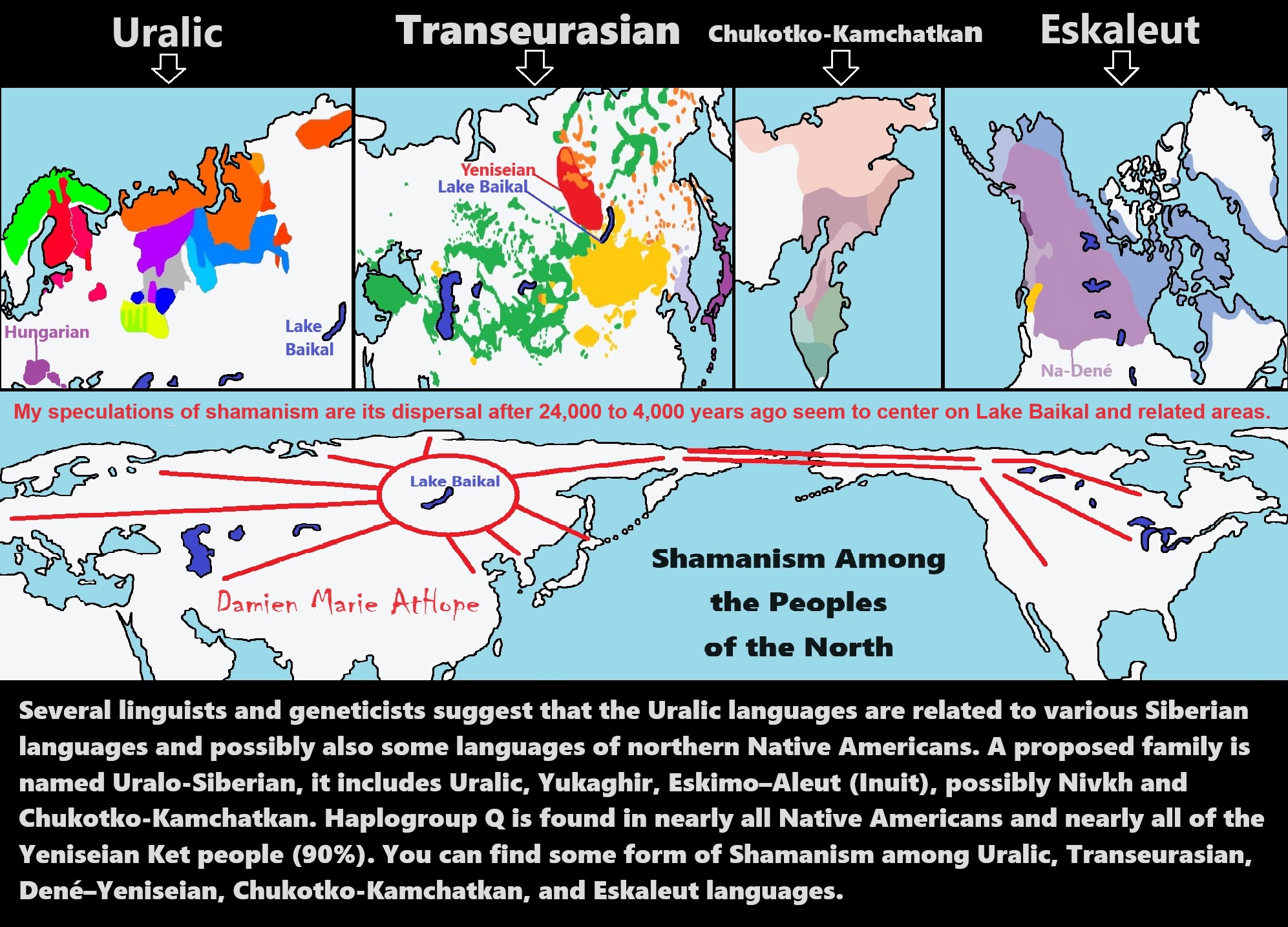
ref, ref, ref, ref, ref, ref, ref, ref, ref
“Several linguists and geneticists suggest that the Uralic languages are related to various Siberian languages and possibly also some languages of northern Native Americans. A proposed family is named Uralo-Siberian, it includes Uralic, Yukaghir, Eskimo–Aleut (Inuit), possibly Nivkh, and Chukotko-Kamchatkan. Haplogroup Q is found in nearly all Native Americans and nearly all of the Yeniseian Ket people (90%).” ref, ref
You can find some form of Shamanism, among Uralic, Transeurasian, Dené–Yeniseian, Chukotko-Kamchatkan, and Eskaleut languages.
My speculations of shamanism are its dispersals, after 24,000 to 4,000 years ago, seem to center on Lake Baikal and related areas. To me, the hotspot of Shamanism goes from west of Lake Baikal in the “Altai Mountains” also encompassing “Lake Baikal” and includes the “Amur Region/Watershed” east of Lake Baikal as the main location Shamanism seems to have radiated out from.
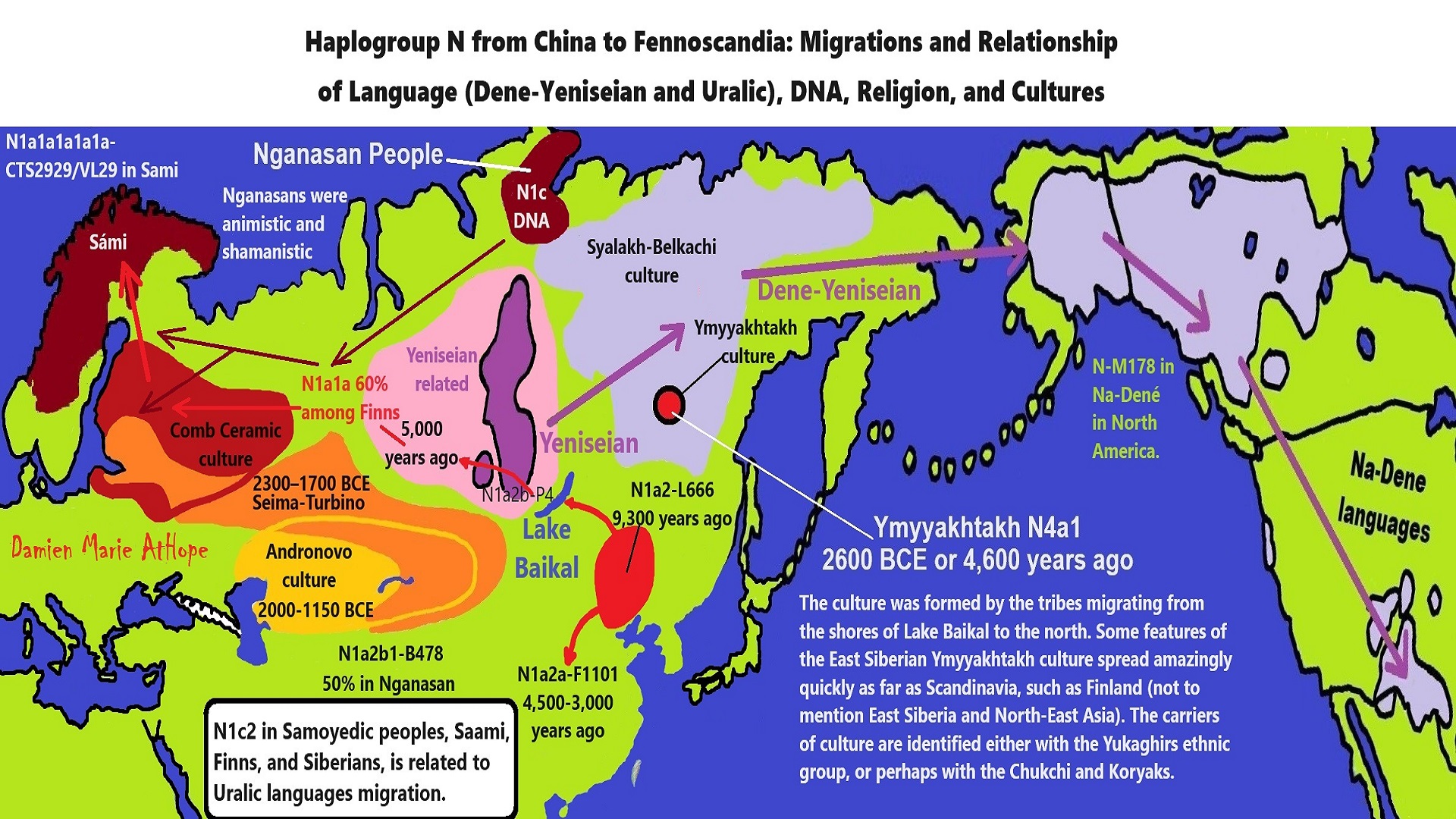
ref, ref, ref, ref, ref, ref, ref, ref, ref, ref, ref, ref, ref, ref, ref, ref
Postglacial genomes from foragers across Northern Eurasia reveal prehistoric
mobility associated with the spread of the Uralic and Yeniseian languages
Abstract
“The North Eurasian forest and forest-steppe zones have sustained millennia of sociocultural connections among northern peoples. We present genome-wide ancient DNA data for 181 individuals from this region spanning the Mesolithic, Neolithic, and Bronze Age. We find that Early to Mid-Holocene hunter-gatherer populations from across the southern forest and forest-steppes of Northern Eurasia can be characterized by a continuous gradient of ancestry that remained stable for millennia, ranging from fully West Eurasian in the Baltic region to fully East Asian in the Transbaikal region. In contrast, cotemporaneous groups in far Northeast Siberia were genetically distinct, retaining high levels of continuity from a population that was the primary source of ancestry for Native Americans. By the mid-Holocene, admixture between this early Northeastern Siberian population and groups from Inland East Asia and the Amur River Basin produced two distinctive populations in eastern Siberia that played an important role in the genetic formation of later people. Ancestry from the first population, Cis-Baikal Late Neolithic-Bronze Age (Cisbaikal_LNBA), is found substantially only among Yeniseian-speaking groups and those known to have admixed with them. Ancestry from the second, Yakutian Late Neolithic-Bronze Age (Yakutia_LNBA), is strongly associated with present-day Uralic speakers. We show how Yakutia_LNBA ancestry spread from an east Siberian origin ~4.5kya, along with subclades of Y-chromosome haplogroup N occurring at high frequencies among present-day Uralic speakers, into Western and Central Siberia in communities associated with Seima-Turbino metallurgy: a suite of advanced bronze casting techniques that spread explosively across an enormous region of Northern Eurasia ~4.0kya. However, the ancestry of the 16 Seima-Turbino-period individuals–the first reported from sites with this metallurgy–was otherwise extraordinarily diverse, with partial descent from Indo-Iranian-speaking pastoralists and multiple hunter-gatherer populations from widely separated regions of Eurasia. Our results provide support for theories suggesting that early Uralic speakers at the beginning of their westward dispersal where involved in the expansion of Seima-Turbino metallurgical traditions, and suggests that both cultural transmission and migration were important in the spread of Seima-Turbino material culture.” ref
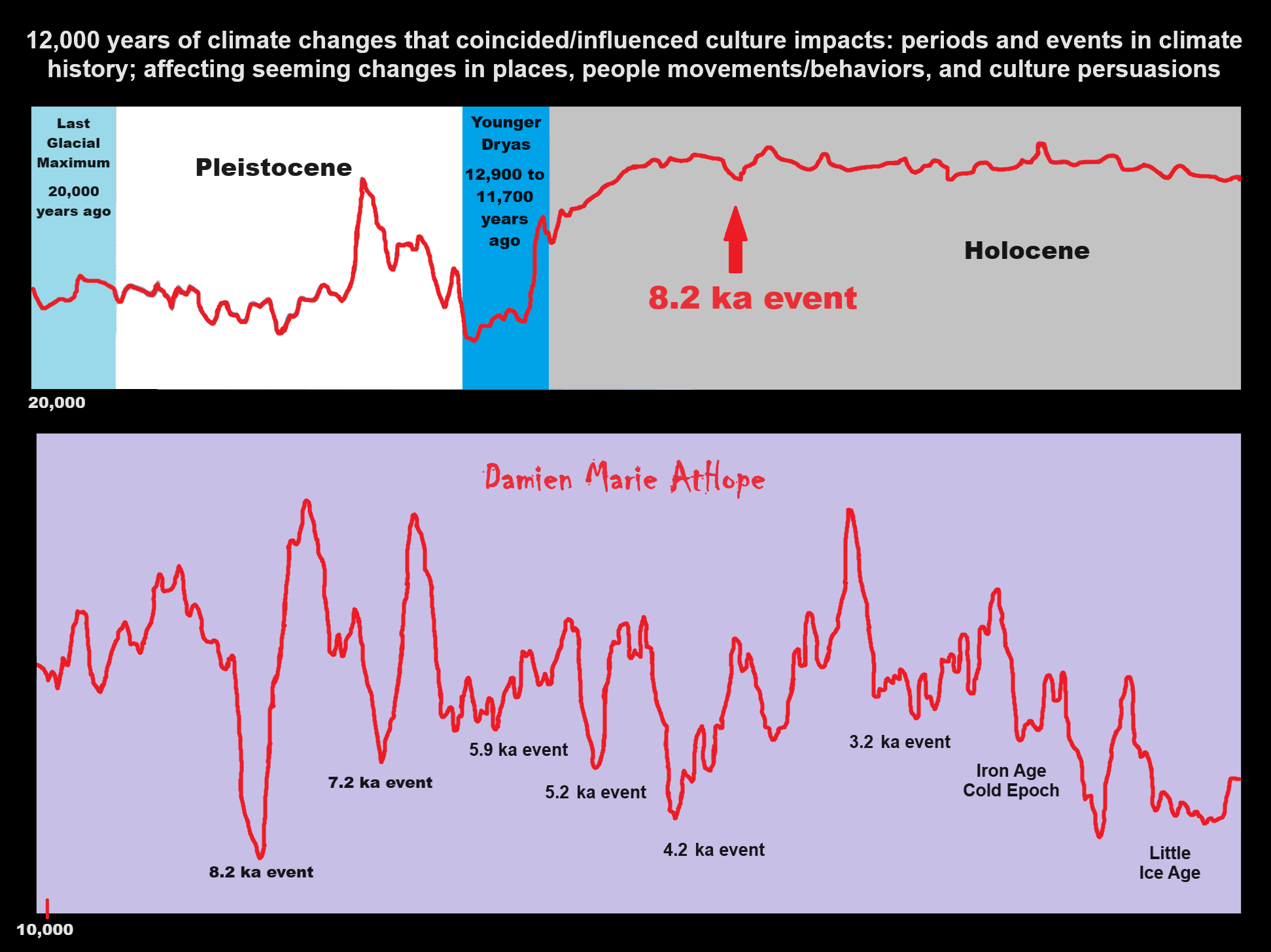
List of Periods and Events in Climate History
* “12,800–11,500 years ago Younger Dryas sudden cold and dry period in Northern Hemisphere” ref
“The Younger Dryas (YD) was a period in Earth’s geologic history that occurred circa 12,900 to 11,700 years ago. The two earlier geologic periods where this flower was abundant in Europe are the Oldest Dryas (approx. 18,500-14,000 years ago) and Older Dryas (~14,050–13,900 years ago), respectively. Younger Dryas ended when the entire globe had warmed consistently, which marks the beginning of the current Holocene epoch. The Younger Dryas was globally synchronous or very nearly so. However, the magnitude of the drop in global mean surface temperature was modest; the Younger Dryas was not a global relapse into peak glacial conditions. A decline in evidence for Natufian hunter-gatherer permanent settlements in the Levant, suggesting a reversion to a more mobile way of life.” ref
“Pre-Pottery Neolithic A (PPNA) denotes the first stage of the Pre-Pottery Neolithic, in early Levantine and Anatolian Neolithic culture, dating to c. 12,000 – c. 10,800 years ago, that is, 10,000–8800 BCE. Archaeological remains are located in the Levantine and Upper Mesopotamian regions of the Fertile Crescent. Granaries were positioned in places between other buildings early on c. 11,500 years ago; however, beginning around 10,500 years ago, they were moved inside houses, and by 9,500 years ago, storage occurred in special rooms. This change might reflect changing systems of ownership and property as granaries shifted from communal use and ownership to becoming under the control of households or individuals.” ref
“As of 2013 Gesher, modern Israel, became the earliest known of all known Neolithic sites (PPNA), with a calibrated Carbon 14 date of 10,459 BCE or 12,459 years ago, analysis suggesting that it may have been the starting point of a Neolithic Revolution. A contemporary site is Mureybet in modern Syria. With more sites becoming known, archaeologists have defined a number of regional variants of Pre-Pottery Neolithic A:
- Mureybetian in the Northern Levant, defined by the finds from Mureybet IIIA, IIIB, typical: Helwan points, sickle-blades with base amenagée or short stem and terminal retouch. Other sites include Sheyk Hasan and Jerf el Ahmar.
- Sites in “Upper Mesopotamia” include Çayönü and Göbekli Tepe, with the latter possibly being the oldest ritual complex yet discovered.” ref
“11,500 years ago, agricultural development.”
“While humans started gathering grains at least 105,000 years ago, nascent farmers only began planting them around 11,500 years ago in the Fertile Crescent. Sheep, goats, pigs, and cattle were domesticated around 10,000 years ago. Sheep were domesticated in Mesopotamia between 13,000 and 11,000 years ago. Rice was domesticated in China between 11,500 years ago. Sheep, goats, pigs, and cattle were domesticated by around 10,000 years ago.” ref
“Agriculture is defined with varying scopes, in its broadest sense using natural resources to “produce commodities which maintain life, including food, fiber, forest products, horticultural crops, and their related services.” Thus defined, it includes arable farming, horticulture, animal husbandry, and forestry, but horticulture and forestry are, in practice, often excluded. It may also be broadly decomposed into plant agriculture, which concerns the cultivation of useful plants, and animal agriculture, the production of agricultural animals.” ref
“Karahan Tepe, an 11,400-year-old village, challenges ideas of when and why humans first settled down, including homes within a vast ritualistic complex that demonstrates that hunter-gatherers built permanent settlements long before the advent of agriculture 10,000 years ago. The findings change the perception, that settled life resulted from farming and animal husbandry. Karahan Tepe shows that it began when humans were still hunter-gatherers and that agriculture is not a cause, but the effect, of settled life. Sacred and secular spaces were built simultaneously at Karahan Tepe, where humans dwelled year-round for about 1,500 years, and no remnants of farmed vegetation have been found. Karahan Tepe is located around 35km from Göbekli Tepe, billed as home to the world’s oldest temple structures. Dating to 9600 BCE or 11,600 years ago, Göbekli Tepe reshaped ideas about early civilization. Previously thought to be a lone destination where nomadic people came to worship, Göbekli Tepe is now considered part of a constellation of contemporaneous settlements that extends over 100km and includes Karahan Tepe and at least 11 other unexcavated sites.” ref
“Slavery and power are connected, and predate written records and have existed in many cultures. Slavery is rare among hunter-gatherer populations because it requires economic surpluses and a substantial population density. Slavery became widespread only with the invention of agriculture during the Neolithic Revolution about 11,000 years ago. Slavery was practiced in almost every ancient civilization.” ref
“Mace heads and the rise of power: archaeological evidence available so far has revealed that the earliest mace heads first appeared in the Near East about 10,000 years ago. along with the early development and spread of agriculture. After that, mace heads began to spread throughout the ancient world: southward to the Ancient Egypt Kingdom in North Africa, northwest to Europe, and then to the Eurasian steppe of central Asia and Siberia. Eventually, this movement gradually arrived in the Northwestern region of China. The earliest mace head examples come from the Near East during the PPNA period. An early example is the stone mace head from the site of Hallan Cemi in Turkey, dated to 9500–8500 BCE or 11,500 to 10,500 years ago. Another contemporary example is the stone mace-head from Körtik Tepe, also a Pre-Pottery Neolithic A site in Turkey. In Mesopotamia, the earliest mace-heads can also be traced back to around this time, or equivalent to the PPN period (8300–6000 BCE or 10,300 to 8,000 years ago). They are mostly ball-shaped or pear-shaped.” ref
“Human violence is rooted in the rivalry that stems from imitation and archaeologists working at the Neolithic sites of Çatalhöyük and Göbekli Tepe in Turkey. At both sites there is evidence of religious practices that center on wild animals, often large and dangerous in form. Is it possible that these wild animals were ritually killed in the ways suggested by Girardian theorists? Were violence and the sacred intimately entwined, and were these the processes that made possible and even stimulated the origins of farming in the ancient Near East? Offering a perspective from Göbekli Tepe and related sites, our team contributed a paper (by , , , , , on “Ritual Practices and Conflict Mitigation at Early Neolithic Körtik Tepe and Göbekli Tepe, Upper Mesopotamia” (pp. 96-128):
“The cognitive principles of the social brain have remained unaltered since their appearance in anatomically modern humans in Africa some 200,000 years ago. However, by the Early Holocene these capacities, were being challenged by the outcomes of newly emerging lifeways , commonly referred to as ‘Neolithic’. Growing levels of sedentism and new and expanding social networks, were prompting a unique series of behavioural and cultural responses. In recent years, research at the early Neolithic (PPNA) occupation site of Körtik Tepe has provided evidence for heightened levels of interpersonal violence and homicide; yet, at the same time, there are no indications in the present archaeological record for between-group fighting (‘warfare’). In this study, we investigate whether this scenario, at a time when we might expect to see a rise in inter community frictions in the wake of adjusting subsistence strategies and socio-political boundaries, can be at least partially explained by René Girard’s mimetic theory. To this end we consult the pictorial repertoire from the contemporaneous and extraordinary site of Göbekli Tepe.” ref
“From 10,000 years ago Holocene glacial retreat, the present Holocene or Postglacial period begins.” ref
* “9,500–5,900 years ago Neolithic Subpluvial/African humid period in North Africa, wet period.” ref
“The African humid period (AHP; also known by other names) is a climate period in Africa during the late Pleistocene and Holocene geologic epochs, when northern Africa was wetter than today. The covering of much of the Sahara desert by grasses, trees and lakes was caused by changes in the Earth’s axial tilt; changes in vegetation and dust in the Sahara which strengthened the African monsoon; and increased greenhouse gases. During the preceding Last Glacial Maximum, the Sahara contained extensive dune fields and was mostly uninhabited.” ref
“Rivers and lakes such as Lake Chad formed or expanded, glaciers grew on Mount Kilimanjaro, and the Sahara retreated. Two major dry fluctuations occurred; during the Younger Dryas and the short 8.2 kiloyear event. The African humid period ended 6,000–5,000 years ago during the Piora Oscillation cold period. While some evidence points to an end 5,500 years ago, in the Sahel, Arabia and East Africa, the end of the period appears to have taken place in several steps, such as the 4.2-kiloyear event.” ref
“The AHP led to a widespread settlement of the Sahara and the Arabian Deserts and had a profound effect on African cultures, such as the birth of the Ancient Egyptian civilization. People in the Sahara lived as hunter-gatherers, and there was an influx of domesticated cattle, goats, and sheep. When the period ended, humans gradually abandoned the desert in favor of regions with more secure water supplies, such as the Nile Valley and Mesopotamia, where they gave rise to early complex societies.” ref
“Neolithic culture and technology were established in the Near East by 7000 BCE or 9,000 years ago. and there is increasing evidence, throughout the millennium, of its spread or introduction to Europe and the Far East. In most of the world, however, including north and western Europe, people still lived in scattered Palaeolithic hunter-gatherer communities. The Mehrgarh chalcolithic civilization began around 7000 BCE. The world population is believed to have been stable and slowly increasing. It has been estimated that there were perhaps ten million people worldwide at the end of this millennium, growing to forty million by 5000 BCE or 7,000 years ago and 100 million by 1600 BCE or 3,600 years ago, an average growth rate of 0.027% p.a. from the beginning of the Neolithic to the Middle Bronze Age.” ref
* 8.2 ka event (increased rise of elite power)
“In climatology, the 8.2-kiloyear event was a sudden decrease in global temperatures that occurred approximately 8,200 years before the present, or c. 6,200 BCE, and which lasted for the next two to four centuries. It defines the start of the Northgrippian age in the Holocene epoch. The cooling was significantly less pronounced than during the Younger Dryas cold period that preceded the beginning of the Holocene. During the event, atmospheric methane concentration decreased by 80 ppb, an emission reduction of 15%, by cooling and drying at a hemispheric scale.” ref
“The world’s oldest-known promontory fort: Amnya and the acceleration of hunter-gatherer diversity in Siberia 8,000 years ago. The subarctic boreal landscapes of the Siberian taiga may seem remote, but it is here, 8000 years ago, that hunter-gatherers built fortified settlements, many centuries before comparable enclosures first appeared in Europe (Figure). The building of fortifications by forager groups has been observed sporadically elsewhere around the world in various—mainly coastal—regions from later prehistory onwards, but the very early onset of this phenomenon in inland western Siberia is unparalleled. This phenomenon, largely unknown to international researchers, can contribute to the critical re-appraisal of narratives of linear pathways to social change increasingly explored in both scientific and popular debates.” ref
“Pit-house settlements with enclosures consisting of banks, ditches and/or palisades appear on promontories and other topographical peaks across the West Siberian Plain from the end of the seventh-millennium cal BCE onwards. These complex settlements are part of a broader set of socio-economic and technological innovations and transformations in western Siberia and thus demarcate a phase of accelerated social change that is only partially understood. Here, we present new results from the key site of Amnya, part of our ongoing systematic programme of research.” ref
“By contextualizing new chronological data and structural evidence of the architectural features and layout of this complex, we put forward various scenarios that might explain the sudden and unprecedented emergence of diversified hunter-gatherer life worlds in the west Siberian taiga 8000 years ago. By diversification, we refer to the societal background of increased heterogeneity, as expressed through new material practices such as pottery production and monumentality at the end of the seventh millennium BCE.” ref
“In mobile societies, fortification can be a strategy to pre-empt the unpredictable behavior of others, such as raiding. Reliable (seasonal) resource abundance and opportunities for mass harvesting can trigger increased territoriality and ownership among hunter-gatherer groups. Permanent sites, for example, the formal cemeteries of the Late Mesolithic increasingly recognized across northern Eurasia, have been linked to such territorial claims.” ref
“Ostensibly defensive architecture, as the long-term construction of space, can likewise have parallel functions, serving as landmarks in collective memory and identity. As manifestations of social inequality, fortifications can also be related to (heritable) property rights, labor obligations, and the restriction of access to resources. Increasing political differentiation is not necessarily accompanied by greater wealth inequality, however, and defensive architecture can also be coordinated without a centralized authority.” ref
* 7.2 ka event (rise of paternal clan wars)
“The 7,200 years ago event is well represented in 58 paleoclimatic records from the global. Varying climatic responses are evidenced in different regions during 7,600–7,000 years ago.” ref
“Some 5,000 to 7,000 years ago, the diversity of Y chromosomes plummeted. A new analysis suggests clan warfare may have been the cause. For example, one recent study found a huge drop in Y chromosome diversity five-to-seven thousand years ago. At the same time, mitochondrial DNA diversity continued to grow, implying a possible crash in the male population, with 17 women to every man. “Essentially, we’re saying the clans fighting one another are built around having the same Y chromosome.” Eventually, Y chromosome diversity bounced back, as smaller clan structures were replaced by large, genetically diverse cities and societies—a cultural innovation that we, too, inherited.” ref
*5,900 ka event
5.9 kiloyear event dry and cold.
“The 4th millennium BC spanned the years 4000 to 3000 BCE. Some of the major changes in human culture during this time included the beginning of the Bronze Age and the invention of writing, which played a major role in starting recorded history. The city states of Sumer and the kingdom of Egypt were established and grew to prominence. Agriculture spread widely across Eurasia. World population growth relaxed after the burst that came about from the Neolithic Revolution. World population was largely stable in this time at roughly 50 million, growing at an average of 0.027% per year.” ref
“4100–3100 BCE or 6,100 to 5,100 years ago– the Uruk period, with emerging Sumerian hegemony during the Uruk Expansion and development of Proto-cuneiform writing; base-60 mathematics, astronomy and astrology, civil law, complex hydrology, the sailboat, potter’s wheel, and wheel; the Chalcolithic proceeds into the Early Bronze Age. 3500–2340 BC – Sumer: wheeled carts, potter’s wheel, White Temple ziggurat, bronze tools and weapons.” ref
“4000–3000 BCE – Naqada culture on the Nile. The first hieroglyphs appear thus far around 3500 BCE as found on labels in a ruler’s tomb at Abydos. Predynastic pharaohs Tiu, Thesh, Hsekiu, Wazner, Ro, Serket, Narmer. 3500–3400 BC – Jar with boat designs, from Hierakonpolis (today in the Brooklyn Museum) is created. . 3150 BC – Predynastic period ended in Ancient Egypt.” ref
“As the grasslands of the Sahara began drying after 3900 BCE or 5,900 years ago, herders spread into the Nile Valley and into eastern Africa (Eburan 5, Elmenteitan). The desiccation of the Sahara and the associated neolithisation of West Africa is also cited as a possible cause for the dispersal of the Niger-Congo linguistic phylum. Sub-Saharan Africa remains in the Paleolithic period, except for the earliest neolithization of the Sahel following the desiccation of the Sahara in c. 3500 BC.” ref
“5,500 years ago, is the end of the African humid period, Neolithic Subpluvial in North Africa, expands Sahara Desert.” ref
*5,200 ka event (rise of rulers)
“The 5.2 ka event has been identified globally as a period of abrupt climate change. 5,200 years ago, the event was caused by prolonged positive North Atlantic Oscillation conditions. This event forms part of a broader period of re-organisation in the Earth’s ocean-atmosphere circulation system between 6,000 and 5,000 years ago. The abrupt termination of the African humid period c. 5.5 ka, following a weakening of the African monsoonal system, was rapid, occurring within several decades to centuries, and provides a striking example of a non-linear response to gradual insolation forcing. A trend towards drier conditions in South America, as recorded in the Cariaco Basin marine sediments, also began c. 5,400 years ago, consistent with numerous other low-latitude records which show a similar drying trend at this time.” ref
“3,200–2,900 BCE or 5,200 to 4,900 years ago, Piora Oscillation, cold, perhaps not global. Wetter in Europe, drier elsewhere, linked to the domestication of the horse in Central Asia.” ref
“3150 BCE – Predynastic period ended in Ancient Egypt. Early Dynastic (Archaic) period started (according to French Egyptologist Nicolas Grimal). The period includes the 1st and 2nd Dynasties. c. 3100 BCE or 5,100 years ago – Narmer Palette.” ref
“3138 BC Ljubljana Marshes Wheel is a wooden wheel that was found in the Ljubljana Marsh in Slovenia. Radiocarbon dating showed that it is approximately 5,150 years old, which makes it the oldest wooden wheel yet discovered. 3100 BC – The earliest phase of the Stonehenge monument (a circular earth bank and ditch).” ref
” 3100 BCE?: The Anu Ziggurat and White Temple are built in Uruk. 3100 BCE?: The first temple of Tarxien is in use by the Neolithic inhabitants of Malta. 3100 BCE: Oldest adobe building in the Americas was built in Peru. 3100 BCE – Invention of writing in Mesopotamia and Egypt.” ref
* 4.2 ka event
“4.2-kiloyear event dry, lasted most of the 22nd century BC, linked to the end of the Old Kingdom in Egypt, and the Akkadian Empire in Mesopotamia, various archaeological cultures in Persia and China.” ref
“Starting around 2200 BCE, it most likely lasted the entire 22nd century BC. It has been hypothesized to have caused the collapse of the Old Kingdom in Egypt, the Akkadian Empire in Mesopotamia, and the Liangzhu culture in the lower Yangtze River area. The drought may also have initiated the collapse of the Indus Valley Civilisation, with some of its population moving southeastward to follow the movement of their desired habitat, as well as the migration of Indo-European-speaking people into India. Some scientists disagree with that conclusion, citing evidence that the event was not a global drought and did not happen in a clear timeline. In the Persian Gulf region, there was a sudden change in settlement pattern, style of pottery, and tombs. The 22nd century BCE drought marks the end of the Umm Al Nar culture and the change to the Wadi Suq culture. A study of fossil corals in Oman provides evidence that prolonged winter shamal seasons, around 4200 years ago, led to the salinization of the irrigated field, which made a dramatic decrease in crop production trigger a widespread famine and eventually the collapse of the ancient Akkadian Empire. In the 2nd millennium BCE, widespread aridification occurred in the Eurasian steppes and in South Asia. On the steppes, the vegetation changed, driving “higher mobility and transition to the nomadic cattle breeding.” ref
“In c. 2150 BCE, Egypt was hit by a series of exceptionally low Nile floods that may have influenced the collapse of the centralised government of the Old Kingdom after a famine. The Akkadian Empire in 2300 BCE was the second civilization to subsume independent societies into a single state (the first being ancient Egypt in around 3100 BCE). It has been claimed that the collapse of the state was influenced by a wide-ranging, centuries-long drought. Archaeological evidence documents widespread abandonment of the agricultural plains of northern Mesopotamia and dramatic influxes of refugees into southern Mesopotamia, around 2170 BCE, which may have weakened the Akkadian state. A 180-km-long wall, the “Repeller of the Amorites“, was built across central Mesopotamia to stem nomadic incursions to the south. Around 2150 BC, the Gutian people, who originally inhabited the Zagros Mountains, defeated the demoralized Akkadian army, took Akkad and destroyed it around 2115 BCE or 4,115 years ago. Widespread agricultural change in the Near East is visible at the end of the 3rd millennium BC. Resettlement of the northern plains by smaller sedentary populations occurred near 1900 BCE, three centuries after the collapse.” ref
“Urban centers of the Indus Valley Civilisation were abandoned and replaced by disparate local cultures because of the same climate change that affected the neighboring regions to the west. As of 2016, many scholars believed that drought and a decline in trade with Egypt and Mesopotamia caused the collapse of the Indus civilization. The drought may have caused the collapse of Neolithic cultures around Central China in the late 3rd millennium BCE. In the Yishu River Basin (a river basin that consists of the Yi River (沂河) of Shandong and Shu River), the flourishing Longshan culture was affected by a cooling that severely reduced rice output and led to a substantial decrease in population and to fewer archaeological sites. In about 2000 BC, Longshan was displaced by the Yueshi culture, which had fewer and less-sophisticated artifacts of ceramic and bronze. The Liangzhu civilization in the lower reaches of the Yangtze River also declined during the same period. The 4.2 ka event is also believed to have helped collapse the Dawenkou culture.” ref
* 3.2 ka event
“1200 to 750 BCE or 3,200 to 2,750 years ago, Late Bronze Age collapse associated with environmental change.” ref
“The Late Bronze Age collapse was a time of widespread societal collapse during the 12th century BCE associated with environmental change, mass migration, and the destruction of cities. The collapse affected a large area of the Eastern Mediterranean (North Africa and Southeast Europe) and the Near East, in particular Egypt, eastern Libya, the Balkans, the Aegean, Anatolia, and, to a lesser degree, the Caucasus. It was sudden, violent, and culturally disruptive for many Bronze Age civilizations, and it brought a sharp economic decline to regional powers, notably ushering in the Greek Dark Ages.” ref
“The palace economy of Mycenaean Greece, the Aegean region, and Anatolia that characterized the Late Bronze Age disintegrated, transforming into the small isolated village cultures of the Greek Dark Ages, which lasted from around 1100 to the beginning of the better-known Archaic age around 750 BCE. The Hittite Empire of Anatolia and the Levant collapsed, while states such as the Middle Assyrian Empire in Mesopotamia and the New Kingdom of Egypt survived in weakened forms. Other cultures, such as the Phoenicians enjoyed increased autonomy and power with the waning military presence of Egypt and Assyria in West Asia.” ref
“The half-century between c. 1200 and 1150 BCE saw the cultural collapse of the Mycenaean kingdoms, the Kassites in Babylonia, the Hittite Empire in Anatolia and the Levant, and the New Kingdom of Egypt, as well as the destruction of Ugarit and the Amorite states in the Levant, the fragmentation of the Luwian states of western Anatolia, and a period of chaos in Canaan. The deterioration of these governments interrupted trade routes and led to severely reduced literacy in much of this area.” ref
“Only a few powerful states survived the Bronze Age collapse, particularly Assyria (albeit temporarily weakened), the New Kingdom of Egypt (also weakened), the Phoenician city-states and Elam. Even among these comparative survivors, success was mixed. By the end of the 12th century BCE, Elam waned after its defeat by Nebuchadnezzar I, who briefly revived Babylonian fortunes before suffering a series of defeats by the Assyrians. After the death of Ashur-bel-kala in 1056 BC, Assyria declined for a century. Its empire shrank significantly by 1020 BC, apparently leaving it in control only of the areas in its immediate vicinity, although its heartland remained well-defended. By the time of Wenamun, Phoenicia had regained independence from Egypt.” ref
* Iron Age Cold Epoch
“The Iron Age Cold Epoch (also referred to as Iron Age climate pessimum or Iron Age neoglaciation) was a period of unusually cold climate in the North Atlantic region, lasting from about 900 to about 300 BCE or about 2,900 to 2,300 years ago, with an especially cold wave in 450 BCE during the expansion of ancient Greece. It was followed by the Roman Warm Period (250 BCE – 400 CE). Gill Plunkett and Graeme T. Swindles of Queen’s University Belfast used volcanic ash layers and radiocarbon dating to constrain the start of Iron Age climate deterioration in Ireland to 750 BCE.” ref
“By the 1st millennium BCE or 3,000 to 2,000 years ago, World population roughly doubled over the course of the millennium, from about 100 million to about 200–250 million. The Neo-Assyrian Empire dominates the Near East in the early centuries of the millennium, supplanted by the Achaemenid Empire in the 6th century. Ancient Egypt is in decline, and falls to the Achaemenids in 525 BCE. In Greece, Classical Antiquity begins with the colonization of Magna Graecia and peaks with the conquest of the Achaemenids and the subsequent flourishing of Hellenistic civilization (4th to 2nd centuries).” ref
“The Roman Republic supplants the Etruscans and then the Carthaginians (5th to 3rd centuries). The close of the millennium sees the rise of the Roman Empire. The early Celtic culture dominate Central Europe while Northern Europe is in the Pre-Roman Iron Age. In East Africa, the Nubian Empire and Aksum arise. The Olmec civilization declines, and the Maya and Zapotec civilizations emerge in Mesoamerica. The Chavín culture flourishes in Peru.” ref
“The first millennium BCE is the formative period of the classical world religions, with the development of early Judaism and Zoroastrianism in the Near East, and Vedic religion and Vedanta, Jainism, and Buddhism in India. Early literature develops in Greek, Latin, Hebrew, Sanskrit, Tamil, and Chinese.” ref
“World population more than doubled over the course of the millennium, from about an estimated 50–100 million to an estimated 170–300 million. Close to 90% of the world’s population at the end of the first millennium BCE lived in the Iron Age civilizations of the Old World (Roman Empire, Parthian Empire, Graeco–Indo-Scythian and Hindu kingdoms, Han China). The population of the Americas was below 20 million, concentrated in Mesoamerica (Epi-Olmec culture); that of Sub-Saharan Africa was likely below 10 million. The population of Oceania was likely less than one million people.” ref
* Little Ice Age
“The Little Ice Age (LIA) was a period of regional cooling, particularly pronounced in the North Atlantic region. It was not a true ice age of global extent. The period has been conventionally defined as extending from the 16th to the 19th centuries, but some experts prefer an alternative timespan from about 1300 to about 1850.” ref
“In contrast, a climate reconstruction based on glacial length shows no great variation from 1600 to 1850 but a strong retreat thereafter. Therefore, any of several dates ranging over 400 years may indicate the beginning of the Little Ice Age:
- 1250 for when Atlantic pack ice began to grow, a cold period that was possibly triggered or enhanced by the massive eruption of the Samalas volcano in 1257 and the associated volcanic winter.
- 1275 to 1300 for when the radiocarbon dating of plants shows that they were killed by glaciation
- 1300 for when warm summers stopped being dependable in Northern Europe
- 1315 for when rains and the Great Famine of 1315–1317 occurred
- 1560 to 1630 for when the worldwide glacial expansion, known as the Grindelwald Fluctuation, began
- 1650, not the start of the Little Ice Age, but the start of the coldest years midway through, i.e., the First Climatic Minimum” ref
“The Little Ice Age ended in the latter half of the 19th century or in the early 20th century. The 6th report of the IPCC describes the coldest period in the last millennium as:
“…a multi-centennial period of relatively low temperature beginning around the 15th century, with GMST averaging –0.03 [–0.30 to 0.06] °C between 1450 and 1850 relative to 1850–1900.” ref

“Israeli Archaeologists Find Earliest Evidence of War in Southern Levant. Industrial production of aerodynamically efficient slingstones almost 8,000 years ago in what is today’s Israel wasn’t done to hunt animals. Almost 8,000 years ago, people in the Galilee and Sharon plain were preparing for war. This postulation is based on the mass production of shaped slingstones at four sites in Israel, starting in the Late Pottery Neolithic – though who they were attacking, or defending against, and why the production of these stone bullets ceased after about a thousand years is anybody’s guess. The current thinking is they were fighting against other local peoples, not invading hordes. That would come later.” ref
“The collections, most recently found at ‘En Esur and ‘En Tzippori but also at two other sites, are the earliest evidence of “formal” slingstones in the southern Levant, say Gil Haklay, Enno Bron, Dr. Dina Shalem, Dr. Ianir Milevski and Nimrod Getzov, archaeologists associated with the Israel Antiquities Authority, reporting in the journal ‘Atiqot. The slingstones were shaped to be biconical, meaning they were bullet-shaped if bullets had two tipped ends. Put otherwise, they look like very big olives, or eggs if there is something wrong with your bird. That double-cone shape is more aerodynamically efficient than just round stones, the archaeologists explain.” ref
“These weren’t the first slingstones in the world, just the earliest found in the southern Levant. Based on the archaeological evidence, the technique of shaping such projectiles emerged in Mesopotamia, spread to western Anatolia in today’s Turkey, from there to the Northern Levant and then to the southern Levant, Haklay explains to Haaretz by phone. Prehistoric contact between these regions has long been established, including through the discovery of obsidian from Turkey in Israel – including in a settlement by Jerusalem from 9,000 years ago.” ref
“The Levantine biconical projectiles were quite uniform, averaging just over 5 centimeters (2 inches) in length and 60 grams (2 ounces) in weight. Made of local dolomite or limestone rock, or basalt, they are similar in shape to recognized slingstones from later times around the world. “Similar slingstones have been found at other sites in the country, mainly from the Hula Valley and the Galilee in the north to the northern Sharon, but this is the first time they have been found in excavations in such large concentrations,” the team said in a statement. This postulated evidence of warfare at ‘En Esur in the plain and ‘En Tzippori in the Lower Galilee is the earliest known in the whole of the southern Levant and certainly modern Israel, though not the world. The earliest known war zone is in Sudan and dates to about 13,000 years ago.” ref
- World’s ‘First War’ 13,400 Years Ago Was Not Isolated Event
- Study reveals the scope of prehistoric violence in the Middle East
- Murder: A Modern Artifact
“The biconical slingstones produced in the southern Levant starting about 7,800 years ago would remain in use for about a thousand years. Then such items abruptly disappeared from the archaeological record, the team says. The legend of David and Goliath from the Iron Age, and giant “flint spheroids” weighing a quarter-kilo apiece found in biblical Lachish, are all well and good. However, respectable “formalized” slingstones would only reappear in the local archaeological record in the Hellenistic period, the authors explain. Come the Late Roman period, the technique would be perfected by the manufacture of “whistling” slingstones, carved to shriek as they traveled, the better to unnerve the enemy. But we digress. Does that mean the locals stopped lobbing stones at one another? It does not.” ref
“The legend of David and Goliath from the Iron Age, and giant “flint spheroids” weighing a quarter-kilo apiece found in biblical Lachish, are all well and good. However, respectable “formalized” slingstones would only reappear in the local archaeological record in the Hellenistic period, the authors explain. Come the Late Roman period, the technique would be perfected by the manufacture of “whistling” slingstones, carved to shriek as they traveled, the better to unnerve the enemy. But we digress. The study discusses 424 slingstones found at ‘En Esur and ‘En Tzippori from the Late Neolithic-Early Chalcolithic. The logical inference of the amounts and circumstances support the thesis that these were weaponry, and the uniformity of the product suggests systematic production: formalization, standardization, and investment in the manufacture, the team explains.” ref
7,000 to 5,000 years ago because of violence genetics dropped to 1 man for every 17 women
“An abrupt population bottleneck specific to human males has been inferred across several Old World (Africa, Europe, Asia) populations 5000–7000 years ago. Previous studies also show trauma marks present on skulls clearly indicate the fighters used axes, clubs, and arrows to kill each other. Scientists from Stanford used mathematical models and computer simulations, in which men fought and died – allowing them to test their theory on the ‘Neolithic Y-chromosome bottleneck’. According to genetic patterns, researchers found the decline was only noticed in men – particularly on the Y chromosome, which is passed on from father to son. The war was so severe that it caused the male population to plummet to extremely low levels, reaching an astonishing one-twentieth of its original level. This results in the loss of Y chromosomes as they slowly deteriorate over time and eventually may get wiped out from the genome.” ref
“Once upon a time, 4,000 to 8,000 years after humanity invented agriculture, something very strange happened to human reproduction. Across the globe, for every 17 women who were reproducing, passing on genes that are still around today—only one man did the same. Another member of the research team, a biological anthropologist, hypothesizes that somehow, only a few men accumulated lots of wealth and power, leaving nothing for others. These men could then pass their wealth on to their sons, perpetuating this pattern of elitist reproductive success. Then, as more thousands of years passed, the numbers of men reproducing, compared to women, rose again. In more recent history, as a global average, about four or five women reproduced for every one man.” ref
“Violence in the ancient Middle East spiked with the formation of states and empires, battered skulls reveal.” ref
“The Mandate of Heaven (Chinese: 天命; pinyin: Tiānmìng; Wade–Giles: T’ien-ming; lit. ‘Heaven’s command’) is a Chinese political ideology that was used in ancient and imperial China to legitimize the rule of the King or Emperor of China. According to this doctrine, heaven (天, Tian) bestows its mandate on a virtuous ruler. This ruler, the Son of Heaven, was the supreme universal monarch, who ruled Tianxia (天下; “all under heaven”, the world). If a ruler was overthrown, this was interpreted as an indication that the ruler was unworthy and had lost the mandate. The Chinese concept of the legitimacy of rulers is similar to Western culture’s Divine right of kings.” ref
“In European Christianity, the divine right of kings, divine right, or God’s mandation, is a political and religious doctrine of political legitimacy of a monarchy. It is also known as the divine-right theory of kingship. Divine right has been a key element of the self-legitimisation of many absolute monarchies, connected with their authority and right to rule. Historically, many notions of rights have been authoritarian and hierarchical, with different people granted different rights and some having more rights than others. For instance, the right of a father to receive respect from his son did not indicate a right for the son to receive a return from that respect. Analogously, the divine right of kings, which permitted absolute power over subjects, provided few rights for the subjects themselves. The Imperial cult of ancient Rome identified Roman emperors and some members of their families with the “divinely sanctioned” authority (auctoritas) of the Roman State. The official offer of cultus to a living emperor acknowledged his office and rule as divinely approved and constitutional: his Principate should therefore demonstrate pious respect for traditional Republican deities and mores. Many of the rites, practices, and status distinctions that characterized the cult to emperors were perpetuated in the theology and politics of the Christianised Empire. The earliest references to kingship in Israel proclaim that “14 “When you come to the land that the Lord your God is giving you, and you possess it and dwell in it and then say, ‘I will set a king over me, like all the nations that are around me,’ 15 you may indeed set a king over you whom the Lord your God will choose. One from among your brothers you shall set as king over you. You may not put a foreigner over you, who is not your brother.” ref
Related concepts in other religions to the divine-right theory of kingship:
- Mandate of Heaven and monarch as the Son of Heaven – Sinosphere
- Madkhalism – Islam
- Monarchs who are also deities:
- Sacred kings – the occupant of the monarchy gains religious significance or has support from a deity
- Cakravartin – South Asia ref
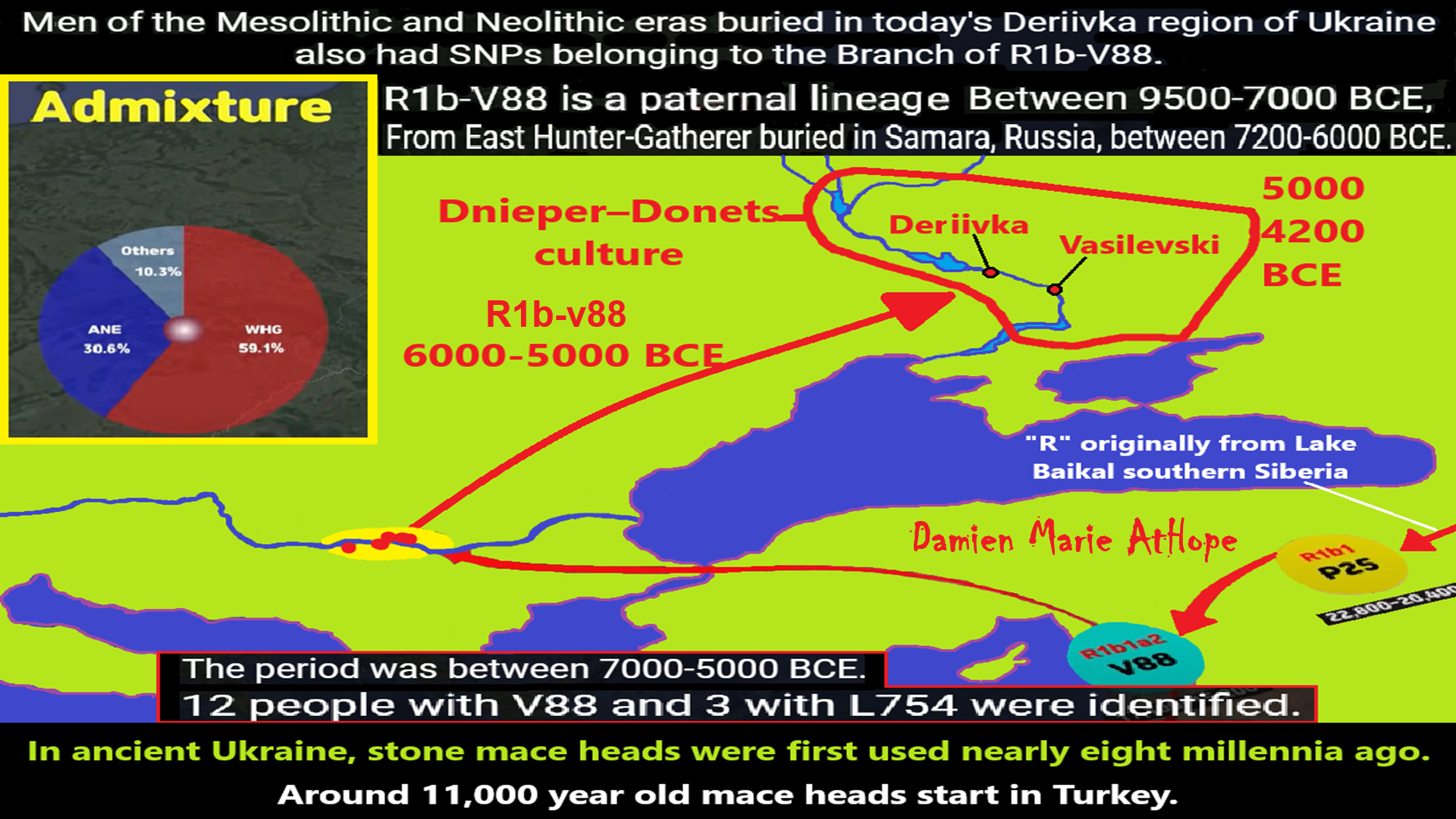
“Mace-heads were symbols of power and were held by people with status.” ref
“The Dnieper–Donets culture complex (DDCC) (ca. 5th—4th millennium BCE) was a Mesolithic and later Neolithic culture which flourished north of the Black Sea ca. 5000-4200 BCE or 7,000 to 6,200 years ago. It has many parallels with the Samara culture, and was succeeded by the Sredny Stog culture. Striking similarities with the Khvalynsk culture have also been detected. The Dnieper–Donets culture was originally a hunter-gatherer culture. David Anthony (2007: 155) dated the beginning of the Dnieper–Donets culture as roughly between 5800/5200 BCE or 7,800/7,200 to 6,200 years ago. It quickly expanded in all directions, eventually absorbing all other local Neolithic groups. According to David W. Anthony, the Indo-European languages were initially spoken by EHGs living in Eastern Europe, such as the Dnieper-Donets people. The precise role of the culture and its language to the derivation of the Pontic-Caspian cultures, such as Sredny Stog and Yamnaya culture, is open to debate, but the display of recurrent traits points to longstanding mutual contacts or to underlying genetic relations.” ref
“The physical remains recovered from graves of the Dnieper–Donets culture have been classified as “Proto-Europoid“. The Dnieper–Donets culture produced no female figurines. By 5200 BCE or 7,200 years ago the Dnieper–Donets culture II followed, which ended between 4400/4200 BCE. From around 5200 BCE, the Dnieper-Donets people began keeping cattle, sheep, and goats. Other domestic animals kept included pigs, horses, and dogs. During the following centuries, domestic animals from the Dnieper further and further east towards the Volga–Ural steppes, where they appeared ca. 4700-4600 BCE. Some scholars suggest that from about 4200 BCE, the Dnieper–Donets culture adopted agriculture.” ref
“Certain Dnieper-Donets burials are accompanied with copper, crystal or porphyry ornaments, shell beads, bird-stone tubes, polished stone maces or ornamental plaques made of boar’s tusk. The items, along with the presence of animal bones and sophisticated burial methods, appear to have been a symbol of power. Certain deceased children were buried with such items, which indicates that wealth was inherited in Dnieper-Donets society. Very similar boar-tusk plaques and copper ornaments have been found at contemporary graves of the Samara culture in the middle Volga area. Maces of a different type than those of Dnieper-Donets have also been found. The wide adoption of such a status symbol attests to the existence of the institute of power in the Dnieper–Donets culture complex.” ref
“The first archaeogenetic analysis involving the Dnieper–Donets culture complex individuals from the Mykilske (Nikols’skoye in Russian) and Yasynuvatka (Yasinovatka) cemeteries held the haplogroups of west Eurasian (H, U3, U5a1a) and east Eurasian (C, C4a) descent have been identified. The authors linked the appearance of east Eurasian haplogroups with potential influence from the northern Lake Baikal area.” ref
“Four identified cultures starting around 5300 BCE or 7,300 years ago, were the Dnieper-Donets, the Narva (eastern Baltic), the Ertebølle (Denmark and northern Germany), and the Swifterbant (Low Countries). They were linked by a common pottery style that had spread westward from Asia: starting in south China, then the Lake Baikal area of Siberia, then west to Europe and is sometimes called “ceramic Mesolithic“, distinguishable by a point or knob base and flared rims.” ref, ref, ref, ref
“The Baikal area, has a long history of human habitation. Some 160 km northwest of the lake, remains of a young human male known as MA-1 or “Mal’ta Boy” are indications of local habitation by the Mal’ta–Buret’ culture ca. 24,000 years old (who I think were involved in Shamanism and may have by their descendants or those with related DNA spread shamanism all over).” ref
“Siberian cultural identity is closely connected with the mythology and ancient religion of the
“The earliest Indigenous peoples of Siberia were hunter-gatherers distantly related to modern Europeans, and diverged from a shared ancestral population around 38kya before populating Siberia. In Siberia, they received geneflow from an East-Eurasian population, most closely related to the 40kya old Tianyuan man (c. 22-50%), representing a deep sister lineage of contemporary East Asian people, giving rise to a distinct Siberian lineage known as Ancient North Eurasian (such as the Mal’ta–Buret’ culture), populations carrying Ancient North Eurasian-related ancestry were probably widely distributed across northeast Eurasia.” ref
“Ceremonial maces originated in the Ancient Near East, where they were used as symbols of rank and authority across the region during the late Stone Age, Bronze Age, and early Iron Age.” ref
“The archaeological evidence available so far has revealed that the earliest mace-heads first appeared in the Near East about 10,000 BP. along with the early development and spread of agriculture. After that maceheads began to spread throughout the ancient world: southward to Ancient Egypt Kingdom in North Africa, and northwest to Europe and then to the Eurasian steppe of central Asia and Siberia. Eventually, this movement gradually arrived at the Northwestern region of China. In China, mace-heads were found only in Xinjiang, Gansu, Qinghai and Western Shaanxi in Northwestern Chine. In fact, the morphology of these objects is quite similar to those found outside China. The author assumes that maces, as they bear special and symbolic functions, are not the original or indigenous cultural trait of Chinese civilization. Instead, they are more likely to be exotic goods coming from out-side. The author argues the reasons can be summarized as follow: first, mace-heads in the Near East significantly predate all counterparts in China. Second, the amounts of mace-heads found in China are relatively limited. Third, mace-head discoveries in China are concentrated only in the northwestern area, a pattern explicitly indicating the Western origin of this type of artifacts.” ref
12,420-11,270 years ago Stone mace-head from Körtik Tepe 12,420-11,270 years ago ref, ref
11,520–10,520 years ago Stone mace heads – Two Hallan Cemi Turkey ref
10,320–8,020 years ago “in Mesopotamia, the earliest mace-heads can also be traced back to around this time, or equivalent to the PPN period (8300–6000 BCE). They are mostly ball-shaped or pear-shaped. Besides boulder and bronze materials, mace-heads were also made by chalcedony or glass, suggesting that they were in fact items of prestige goods. Some of the boulder mace-heads were carved with cuneiforms or figures and animal embossments on their surface.” ref “Mesopotamia occupies the area of present-day Iraq, and parts of Iran, Turkey, Syria, and Kuwait.” ref
9,020-8,020 years ago Calcite mace head Syria ref
8,520-7,720 years ago “Catal Hoyuk (starting more equalitarian, total occupation 9,120-7,720 years ago) signs of inequality begin to emerge. Skulls with depressed fractures in the head, dozens with similar wounds, all showing a consistent pattern of injury to the top back of the skull, but all of them were healed, not fatal injuries, perhaps to control members of the group, and/or to abduct outsiders as wives or slaves.” ref
“The skulls with this characteristic were found primarily in later levels of the site, when more independence and differentiation between households started to emerge. Speculations are that, with these inequalities potentially created new tensions among the community’s members, non-fatal violence may have been a means to keep everyone in check and prevent or diffuse full-fledged conflicts. “The head wounds, in a way, confirm the idea of a controlled society.” ref
8,020-7,020 years ago Can Hasan a copper mace-head ref, ref
“The mace head does not show any trace of having been used. That could indicate that it wasn’t so much a working weapon but a cult object or a status symbol.” ref
7,220 years ago – “Mersin, seaport, south-central Turkey, a planned and constructed fortress, steep mound crowned by a defensive wall, slit windows, and entered protected by flanking towers, containing evidence of military.” ref
6,520-4,920 years ago “stone macehead from a prehistoric site in northeastern Iran. Furthermore, the prehistoric pottery from this area, has close affinities with ceramic materials from Central Asia rather than with contemporary sites in Iran, meaning that in this period its inhabitants were likely culturally linked to their neighbors to the east. Indeed, a very similar stone mace head was excavated at Anau in Turkmenistan in 1904. Nishapur’s location on what later became known as the Great Khorasan Road suggests that it was part of the trade network that facilitated the import of precious stones such as lapis lazuli, carnelian, and turquoise from Central Asia to Mesopotamia.” ref
6,420-5,520 years ago “Earliest mace-heads from the Levant can also be traced back to around the PPN period.” ref
“The archaeological evidence available so far has revealed that the earliest mace-heads first appeared in the Near East about or before 10,000 years ago. along with the early development and spread of agriculture. After that mace-heads began to spread throughout the ancient world: southward to the Ancient Egypt Kingdom in North Africa, and northwest to Europe, and then to the Eurasian steppe of Central Asia and Siberia. Eventually, this movement gradually arrived at the Northwestern region of China. In China, mace-heads were found only in Xinjiang, Gansu, Qinghai, and Western Shaanxi in Northwestern Chine. In fact, the morphology of these objects is quite similar to those found outside China. The author assumes that maces, as they bear special and symbolic functions, are not the original or indigenous cultural trait of Chinese civilization. Instead, they are more likely to be exotic goods coming from outside. The author argues the reasons can be summarized as follow: first, mace-heads in the Near East significantly predate all counterparts in China. Second, the amounts of mace-heads found in China are relatively limited. Third, mace-head discoveries in China are concentrated only in the northwestern area, a pattern explicitly indicating the Western origin of this type of artifacts.” ref
The Chalcolithic Period (Copper Age)
“The transition from the Neolithic to the Chalcolithic phase of cultural evolution is thought to have taken place gradually in the late 7th millennium BCE. At most sites where its progress can be traced, no perceptible break occurs in the continuity of occupation, and there is little reason to assume any major ethnographic upheaval. Archaeologically, the most conspicuous innovation is the decoration of pottery with colored paint, a widespread development in western Anatolia. Late periods at Hacılar were characterized by the production of some of the most competently and attractively decorated pottery in prehistoric Anatolia, and in the subsequent middle phase of the Chalcolithic Period, polychrome wares were produced in south-central Anatolia and Cilicia. Village architecture of this period is undistinguished but provides evidence for the necessity of communal defense, which was accomplished by means of a circuit wall or—as in Hacılar—a continuous wall formed by the outside rear walls of contiguous houses. At Hacılar and Can Hasan, the heavy ground-floor chambers of these houses had no doorways and were evidently entered by ladders from a more fragile upper story. Improvements in architecture at this period, however, can be seen at Mersin, where one of its later phases is represented by a neatly planned and constructed fortress. The steeply revetted slope of the mound was crowned by a continuous defensive wall, pierced by slit windows, and entered through a gateway protected by flanking towers. Inside, there was formally arranged accommodation for the garrison and other evidence of military discipline as conceived in 5200 BCE.” ref
“Metallurgy was beginning to be understood, and copper was used for pins and simple implements. But there are occasional glimpses of a greater sophistication: a copper mace-head from Can Hasan, more developed tools and the first occurrence of silver at Beycesultan, and a stamp-seal in tin bronze at Mersin. Little is known about the late phase of the Chalcolithic Period; soundings into strata below settlements of the Early Bronze Age, which the period anticipates, indicate that in western and central Anatolia this late phase introduced simpler rectangular houses and dark burnished pottery with simple incised, jabbed, polished, or white-painted decoration.” ref
Ghassulian
“Ghassulian refers to a culture and an archaeological stage dating to the Middle and Late Chalcolithic Period in the Southern Levant (c. 4400 – c. 3500 BCE or 6,420-5,520 years ago). Its type-site, Teleilat Ghassul (Teleilat el-Ghassul, Tulaylat al-Ghassul), is located in the eastern Jordan Valley near the northern edge of the Dead Sea, in modern Jordan. The Ghassulian stage was characterized by small hamlet settlements of mixed farming peoples, who had immigrated from the north and settled in the southern Levant – today’s Jordan, Israel, and Palestine. People of the Beersheba Culture (a Ghassulian subculture) lived in underground dwellings – a unique phenomenon in the archaeological history of the region – or in houses that were trapezoid-shaped and built of mud-brick.” ref
“Those were often built partially underground (on top of collapsed underground dwellings) and were covered with remarkable polychrome wall paintings. Their pottery was highly elaborate, including footed bowls and horn-shaped drinking goblets, indicating the cultivation of wine. Several samples display the use of sculptural decoration or of a reserved slip (a clay and water coating partially wiped away while still wet). The Ghassulians were a Chalcolithic culture as they used stone tools but also smelted copper. Funerary customs show evidence that they buried their dead in stone dolmens and also practiced secondary burial.” ref
“Settlements belonging to the Ghassulian culture have been identified at numerous other sites in what is today southern Israel, especially in the region of Beersheba, where elaborate underground dwellings have been excavated. The Ghassulian culture correlates closely with the Amratian of Egypt and also seems to have affinities (e.g., the distinctive churns, or “bird vases”) with early Minoan culture in Crete.” ref
“It should be understood that the mace-head is more than a weapon. It is a unique object that has a ritual role symbolizing one’s authority and prestige. In Dorak, near the Marmara Coast, two magnificent tombs have been unearthed, and one was the final resting place of a local king. A mace mounted with a wooden handle was placed in his arms. The other tomb was a joint burial for a king and his queen. In this case, too, a mace with
a wooden handle was placed above each individual’s arm. The two tombs clearly reflected elite status as they were stacked with luxurious burial articles and date to 4,553–4,539 years ago.” ref
The End of Old Europe and the Rise of the Steppe
“By 4300–4200 BCE Old Europe was at its peak. The Varna cemetery in eastern Bulgaria had the most ostentatious funerals in the world, richer than anything of the same age in the Near East. Among the 281 graves at Varna, 61 (22%) contained more than three thousand golden objects together weighing 6 kg (13.2 lb). Two thousand of these were found in just four graves (1, 4, 36, and 43). Grave 43, an adult male, had golden beads, armrings, and rings totaling 1,516 grams (3.37 lb), including a copper ax-adze with a gold-sheathed handle. Golden ornaments have also been found in tell settlements in the lower Danube valley, at Gumelniţa, Vidra, and at Hotnitsa (a 310-gm cache of golden ornaments). A few men in these communities played prominent social roles as chiefs or clan leaders, symbolized by the public display of shining gold ornaments and cast copper weapons.” ref
“Thousands of settlements with broadly similar ceramics, houses, and female figurines were occupied between about 4500 and 4100 BCE in eastern Bulgaria (Varna), the upland plains of Balkan Thrace (KaranovoVI), the upper part of the Lower Danube valley in western Bulgaria, and Romania (Krivodol-Sălcuta), and the broad riverine plains of the lower Danube valley (Gumelniţa). Beautifully painted ceramic vessels, some almost 1 m tall and fired at temperatures of over 800˚C, lined the walls of their two-storied houses. Conventions in ceramic design and ritual were shared over large regions. The crafts of metallurgy, ceramics, and even flint working became so refined that they must have required master craft specialists who were patronized and supported by chiefs. In spite of this, power was not obviously centralized in any one village. Perhaps, as John Chapman observed, it was a time when the restricted resources (gold, copper, Spondylus shell) were not critical, and the critical resources (land, timber, labor, marriage partners) were not seriously restricted. This could have prevented any one region or town from dominating others.” ref
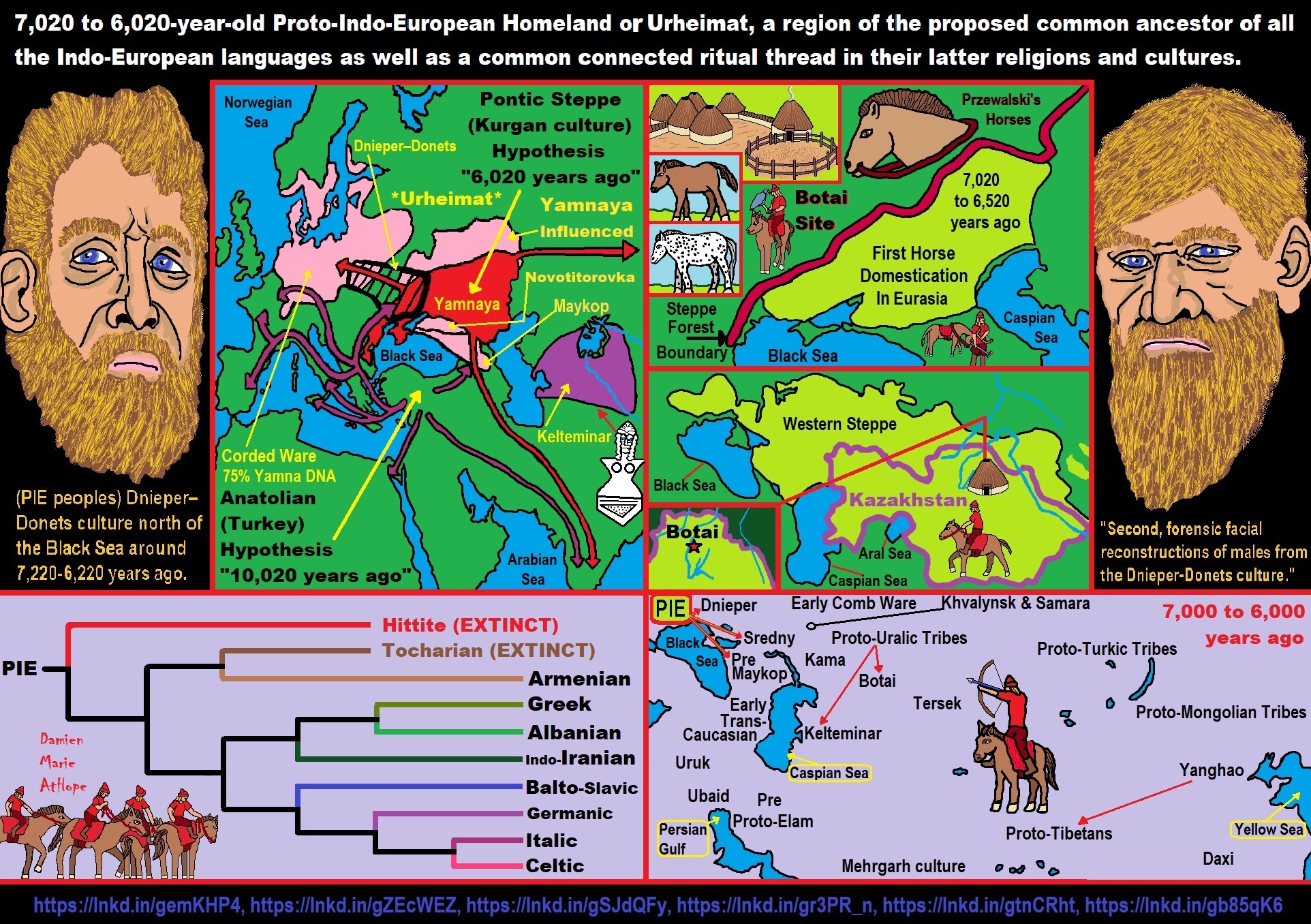
ref, ref, ref, ref, ref, ref, ref, ref, ref, ref, ref, ref, ref, ref
Proto-Indo-Europeans: Western Steppe Herders
“The Proto-Indo-Europeans are a hypothetical prehistoric population of Eurasia who spoke Proto-Indo-European (PIE), the ancestor of the Indo-European languages according to linguistic reconstruction. Knowledge of them comes chiefly from that linguistic reconstruction, along with material evidence from archaeology and archaeogenetics. The Proto-Indo-Europeans likely lived during the late Neolithic, or roughly the 4th millennium BCE. Mainstream scholarship places them in the Pontic–Caspian steppe zone in Eastern Europe (present-day Ukraine and southern Russia).” ref
“Some archaeologists would extend the time depth of PIE to the middle Neolithic (5500 to 4500 BCE or 7,522-6,522 years ago) or even the early Neolithic (7500 to 5500 BCE or 9,522-7,522 years ago), and suggest alternative location hypotheses. By the early second millennium BCE, descendants of the Proto-Indo-Europeans had reached far and wide across Eurasia, including Anatolia (Hittites), the Aegean (the linguistic ancestors of Mycenaean Greece), the north of Europe (Corded Ware culture), the edges of Central Asia (Yamnaya culture), and southern Siberia (Afanasievo culture).” ref
“While ‘Proto-Indo-Europeans’ is used in scholarship to designate the group of speakers associated with the reconstructed proto-language and culture, the term ‘Indo-Europeans’ may refer to any historical people that speak an Indo-European language. In the words of philologist Martin L. West, “If there was an Indo-European language, it follows that there was a people who spoke it: not a people in the sense of a nation, for they may never have formed a political unity, and not a people in any racial sense, for they may have been as genetically mixed as any modern population defined by language.” ref
“Using linguistic reconstruction from old Indo-European languages such as Latin and Sanskrit, hypothetical features of the Proto-Indo-European language are deduced. Assuming that these linguistic features reflect the culture and environment of the Proto-Indo-Europeans, the following cultural and environmental traits are widely proposed:
- pastoralism, including domesticated cattle, horses, and dogs
- agriculture and cereal cultivation, including technology commonly ascribed to late-Neolithic farming communities, e.g., the plow
- transportation by or across water
- the solid wheel, used for wagons, but not yet chariots with spoked wheels
- worship of a sky god, *Dyḗus Ph2tḗr (lit. “sky father”; > Vedic Sanskrit Dyáuṣ Pitṛ́, Ancient Greek Ζεύς (πατήρ) / Zeus (dyeus)), vocative *dyeu ph2ter (> Latin Iūpiter, Illyrian Deipaturos)
- oral heroic poetry or song lyrics that used stock phrases such as imperishable fame (*ḱléwos ń̥dʰgʷʰitom) and the wheel of the sun (*sh₂uens kʷekʷlos).
- a patrilineal kinship-system based on relationships between men” ref
“A 2016 phylogenetic analysis of Indo-European folktales found that one tale, The Smith and the Devil, could be confidently reconstructed to the Proto-Indo-European period. This story, found in contemporary Indo-European folktales from Scandinavia to India, describes a blacksmith who offers his soul to a malevolent being (commonly a devil in modern versions of the tale) in exchange for the ability to weld any kind of materials together. The blacksmith then uses his new ability to stick the devil to an immovable object (often a tree), thus avoiding his end of the bargain. According to the authors, the reconstruction of this folktale to PIE implies that the Proto-Indo-Europeans had metallurgy, which in turn “suggests a plausible context for the cultural evolution of a tale about a cunning smith who attains a superhuman level of mastery over his craft.” ref
“Researchers have made many attempts to identify particular prehistoric cultures with the Proto-Indo-European-speaking peoples, but all such theories remain speculative. The scholars of the 19th century who first tackled the question of the Indo-Europeans’ original homeland (also called Urheimat, from German), had essentially only linguistic evidence. They attempted a rough localization by reconstructing the names of plants and animals (importantly the beech and the salmon) as well as the culture and technology (a Bronze Age culture centered on animal husbandry and having domesticated the horse).” ref
“The scholarly opinions became basically divided between a European hypothesis, positing migration from Europe to Asia, and an Asian hypothesis, holding that the migration took place in the opposite direction. In the early 20th century, the question became associated with the expansion of a supposed “Aryan race“, a now-discredited theory promoted during the expansion of European empires and the rise of “scientific racism“. The question remains contentious within some flavors of ethnic nationalism (see also Indigenous Aryans).” ref
“A series of major advances occurred in the 1970s due to the convergence of several factors. First, the radiocarbon dating method (invented in 1949) had become sufficiently inexpensive to be applied on a mass scale. Through dendrochronology (tree-ring dating), pre-historians could calibrate radiocarbon dates to a much higher degree of accuracy. And finally, before the 1970s, parts of Eastern Europe and Central Asia had been off-limits to Western scholars, while non-Western archaeologists did not have access to publications in Western peer-reviewed journals.” ref
“The pioneering work of Marija Gimbutas, assisted by Colin Renfrew, at least partly addressed this problem by organizing expeditions and arranging for more academic collaboration between Western and non-Western scholars. The Kurgan hypothesis, as of 2017 the most widely held theory, depends on linguistic and archaeological evidence, but is not universally accepted. It suggests PIE origin in the Pontic–Caspian steppe during the Chalcolithic. A minority of scholars prefer the Anatolian hypothesis, suggesting an origin in Anatolia during the Neolithic. Other theories (Armenian hypothesis, Out of India theory, Paleolithic Continuity Theory, Balkan hypothesis) have only marginal scholarly support.” ref
“In regard to terminology, in the 19th and early 20th centuries, the term Aryan was used to refer to the Proto-Indo-Europeans and their descendants. However, Aryan more properly applies to the Indo-Iranians, the Indo-European branch that settled parts of the Middle East and South Asia, as only Indic and Iranian languages explicitly affirm the term as a self-designation referring to the entirety of their people, whereas the same Proto-Indo-European root (*aryo-) is the basis for Greek and Germanic word forms which seem only to denote the ruling elite of Proto-Indo-European (PIE) society.” ref
“In fact, the most accessible evidence available confirms only the existence of a common, but vague, socio-cultural designation of “nobility” associated with PIE society, such that Greek socio-cultural lexicon and Germanic proper names derived from this root remain insufficient to determine whether the concept was limited to the designation of an exclusive, socio-political elite, or whether it could possibly have been applied in the most inclusive sense to an inherent and ancestral “noble” quality which allegedly characterized all ethnic members of PIE society. Only the latter could have served as a true and universal self-designation for the Proto-Indo-European people.” ref
“By the early twentieth century, this term had come to be widely used in a racist context referring to a hypothesized white, blonde, and blue-eyed “master race” (Herrenrasse), culminating with the pogroms of the Nazis in Europe. Subsequently, the term Aryan as a general term for Indo-Europeans has been largely abandoned by scholars (though the term Indo-Aryan is still used to refer to the branch that settled in Southern Asia).” ref
Proto-Indo-European Urheimat hypotheses and Indo-European migrations
“According to some archaeologists, PIE speakers cannot be assumed to have been a single, identifiable people or tribe, but were a group of loosely related populations ancestral to the later, still partially prehistoric, Bronze Age Indo-Europeans. This view is held especially by those archaeologists who posit an original homeland of vast extent and immense time depth. However, this view is not shared by linguists, as proto-languages, like all languages before modern transport and communication, occupied small geographical areas over a limited time span, and were spoken by a set of close-knit communities—a tribe in the broad sense. Researchers have put forward a great variety of proposed locations for the first speakers of Proto-Indo-European. Few of these hypotheses have survived scrutiny by academic specialists in Indo-European studies sufficiently well to be included in modern academic debate.” ref
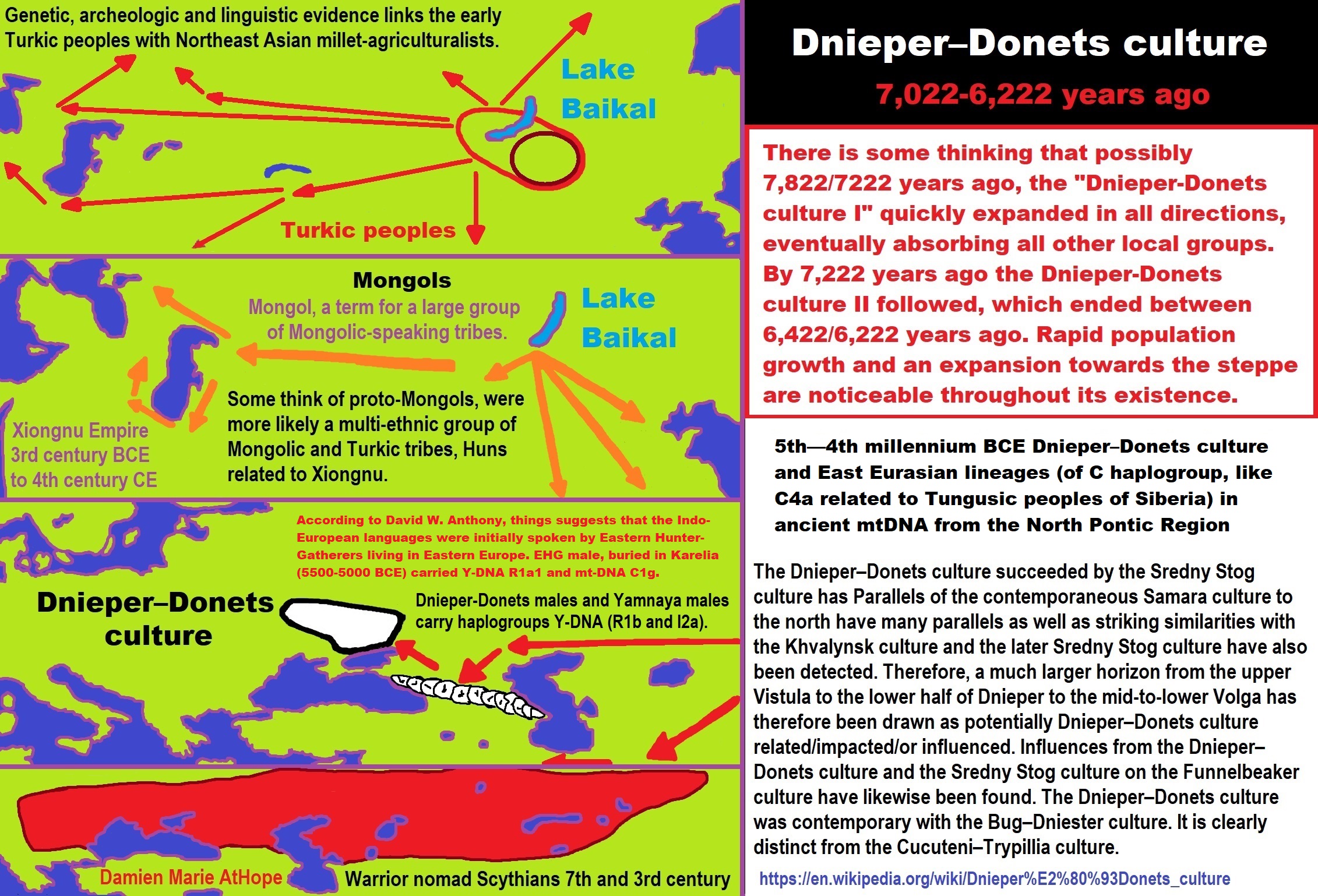
Dnieper–Donets culture
“The Dnieper–Donets culture complex (DDCC) (ca. 5th—4th millennium BCE) was a Mesolithic and later Neolithic culture which flourished north of the Black Sea ca. 5000-4200 BCE. It has many parallels with the Samara culture, and was succeeded by the Sredny Stog culture. The Dnieper–Donets culture complex was defined by the Soviet archaeologist Dmytro Telehin (Dmitriy Telegin) on proposition of another archaeologist Valentyn Danylenko in 1956. At that time Dmytro Telehin worked at the Institute of Archaeology of the Academy of Sciences of the Ukrainian SSR (1952 – 1990). David Anthony (2007: 155) dated the beginning of the Dnieper–Donets culture I roughly between 5800/5200 BCE. It quickly expanded in all directions, eventually absorbing all other local Neolithic groups. By 5200 BCE the Dnieper–Donets culture II followed, which ended between 4400/4200 BCE. Note that the unsourced entry in the Ukrainian graphic contradicts both Telegin’s and Anthony’s chronology and geography.” ref
“The Dnieper–Donets culture was distributed in the steppe and forest-steppe areas north of the Black Sea. Throughout its existence, rapid population growth and an expansion towards the steppe is noticeable. There are parallels with the contemporaneous Samara culture to the north. Striking similarities with the Khvalynsk culture and the Sredny Stog culture have also been detected. A much larger horizon from the upper Vistula to the lower half of Dnieper to the mid-to-lower Volga has therefore been drawn. Influences from the DDCC and the Sredny Stog culture on the Funnelbeaker culture have been suggested. An origin of the Funnelbeaker culture from the Dnieper–Donets culture has been suggested, but this is very controversial. The Dnieper–Donets culture was contemporary with the Bug–Dniester culture. It is clearly distinct from the Cucuteni–Trypillia culture.” ref
“The physical remains recovered from graves of the Dnieper–Donets culture have been classified as “Proto-Europoid“. They have predominantly characterized as large and more massive features than the gracile Mediterranean peoples of the Balkan Neolithic. Males averaged 172 cm in height, which is much taller than contemporary Neolithic populations. Its rugged physical traits are thought to have genetically influenced later Indo-European peoples. Physical anthropologists have pointed out similarities in the physical type of the Dnieper-Donets people with the Mesolithic peoples of Northern Europe. The peoples of the neighboring Sredny Stog culture, which eventually succeeded the Dnieper–Donets culture, were of a more gracile appearance.” ref
“First archaeogenetic analysis involving DDCC individuals was published by Nikitin et al. in 2012. The authors reported mtDNA haplogroups of two individuals from the Mykilske (Nikols’skoye in Russian) and Yasynuvatka (Yasinovatka) DDCC cemeteries. Haplogroups of west Eurasian (H, U3, U5a1a) and east Eurasian (C, C4a) descent have been identified. The authors linked the appearance of east Eurasian haplogroups with potential influence from northern Lake Baikal area. Mathieson et al. (2018) analyzed 32 individuals from three Eneolithic cemeteries at Deriivka, Vilnyanka and Vovnigi, which Anthony (2019a) ascribed to the Dnieper–Donets culture. These individuals belonged exclusively to the paternal haplogroups R and I (mostly R1b and I2), and almost exclusively to the maternal haplogroup U (mostly U5, U4, and U2). This suggests that the Dnieper-Donets people were “distinct, locally derived population” of mostly of Eastern Hunter-Gatherer (EHG) descent, with Western Hunter-Gatherer (WHG) admixture.” ref
“The WHG admixture appears to have increased in the transition from the Mesolithic to the Neolithic. Unlike the Yamnaya culture, whose genetic cluster is known as Western Steppe Herder (WSH), in the Dnieper–Donets culture no Caucasian Hunter-Gatherer (CHG) or Early European Farmer (EEF) ancestry has been detected. At the same time, several Eneolithic individuals from the Deriivka I cemetery carried Anatolian Neolithic Farmer (ANF) – derived as well as WSH ancestry. At the Vilnyanka cemetery, all the males belong to the paternal haplogroup I, which is common among WHGs. David W. Anthony suggests that this influx of WHG ancestry might be the result of EEFs pushing WHGs out of their territories to the east, where WHG males might have mated with EHG females. Dnieper-Donets males and Yamnaya males carry the same paternal haplogroups (R1b and I2a), suggesting that the CHG and EEF admixture among the Yamnaya came through EHG and WHG males mixing with EEF and CHG females. According to Anthony, this suggests that the Indo-European languages were initially spoken by EHGs living in Eastern Europe.” ref
“The Dnieper–Donets culture was succeeded by the Sredny Stog culture, its eastern neighbor, with whom it co-existed for a time before being finally absorbed. The Dnieper–Donets culture and the Sredny Stog culture were in turn succeeded by the Yamnaya culture. The Mikhaylovka culture, the Novodanilovka group, and the Kemi Oba culture displays evidence of continuity from the Dnieper–Donets culture.” ref
5th—4th millennium BCE Dnieper–Donets culture and East Eurasian lineages (of C haplogroup, like C4a related to Tungusic peoples of Siberia) in ancient mtDNA from the North Pontic Region
The Dnieper–Donets culture between 7,800/7,200 to 6,400/6,200 years ago, steppe and forest-steppe areas north of the Black Sea

- My Thoughts on Possible Migrations of “R” DNA and Proto-Indo-European?
- Migrations and Changing Europeans Beginning around 8,000 Years Ago
- My “Steppe-Anatolian-Kurgan hypothesis” 8,000/7,000 years ago
- The Dnieper–Donets culture and Asian varieties of Millet from China to the Black Sea region of Europe by 7,022 years ago
- Kurgan 6,000 years ago/dolmens 7,000 years ago: funeral, ritual, and other?
- 7,020 to 6,020-year-old Proto-Indo-European Homeland of Urheimat or proposed home of their Language and Religion
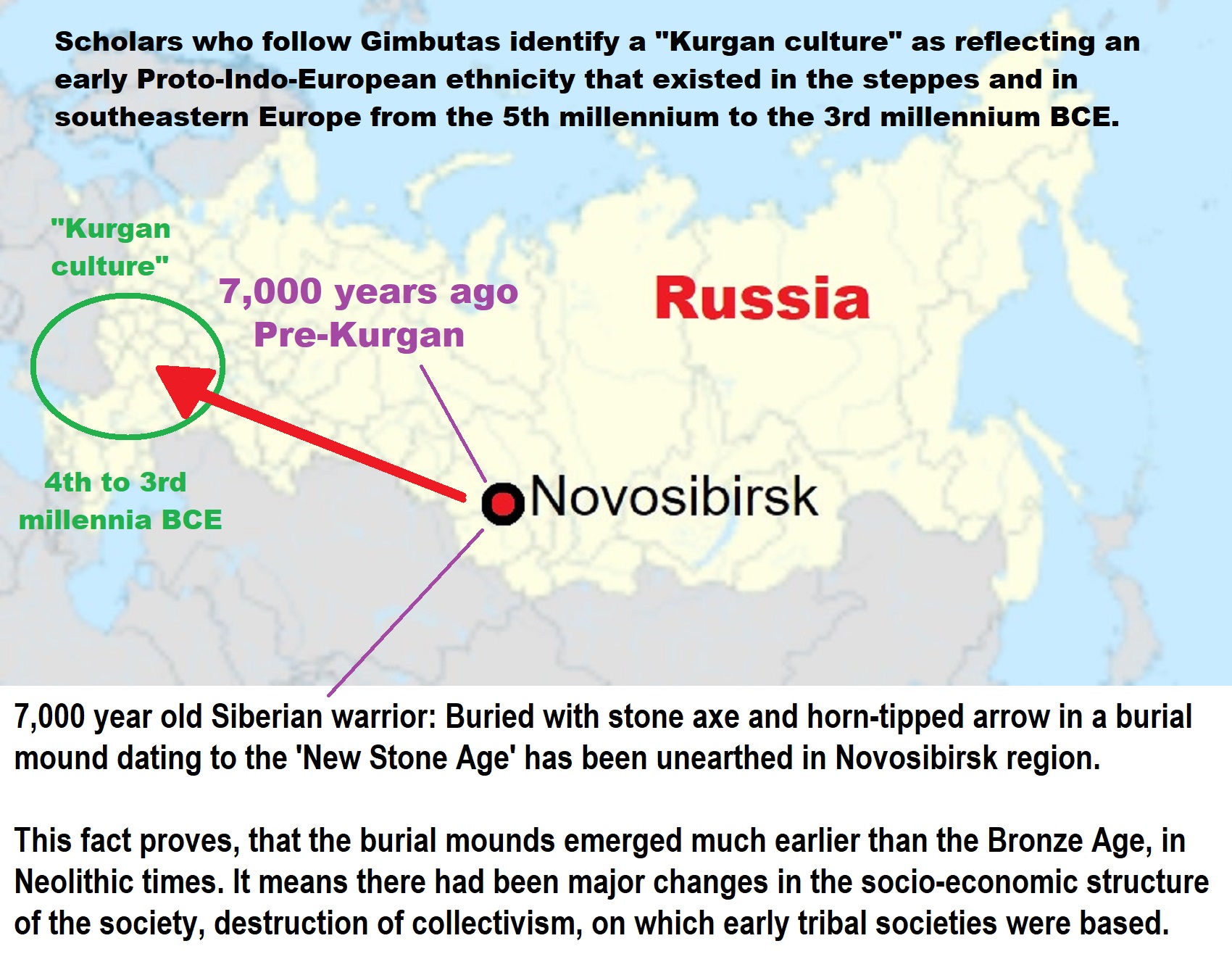
Kurgan Hypothesis
“The Kurgan hypothesis (also known as the Kurgan theory or Kurgan model) or Steppe theory is the most widely accepted proposal to identify the Proto-Indo-European homeland from which the Indo-European languages spread out throughout Europe and parts of Asia. It postulates that the people of a Kurgan culture in the Pontic steppe north of the Black Sea were the most likely speakers of the Proto-Indo-European language (PIE). The term is derived from the Russian kurgan (курга́н), meaning tumulus or burial mound. The Steppe theory was first formulated by Otto Schrader (1883) and V. Gordon Childe (1926), then systematized in the 1950s by Marija Gimbutas, who used the term to group various prehistoric cultures, including the Yamnaya (or Pit Grave) culture and its predecessors. In the 2000s, David Anthony instead used the core Yamnaya culture and its relationship with other cultures as a point of reference.” ref
“Gimbutas defined the Kurgan culture as composed of four successive periods, with the earliest (Kurgan I) including the Samara and Seroglazovo cultures of the Dnieper–Volga region in the Copper Age (early 4th millennium BCE). The people of these cultures were nomadic pastoralists, who, according to the model, by the early 3rd millennium BCE had expanded throughout the Pontic–Caspian steppe and into Eastern Europe. Recent genetics studies have demonstrated that populations bearing specific Y-DNA haplogroups and a distinct genetic signature expanded into Europe and South Asia from the Pontic-Caspian steppe during the third and second millennia BCE. These migrations provide a plausible explanation for the spread of at least some of the Indo-European languages, and suggest that the alternative Anatolian hypothesis, which places the Proto-Indo-European homeland in Neolithic Anatolia, is less likely to be correct.” ref
“Cultures that Gimbutas considered as part of the “Kurgan culture”:
- Bug–Dniester (6th millennium)
- Samara (5th millennium)
- Khvalynsk (5th millennium)
- Dnieper–Donets (5th to 4th millennia)
- Sredny Stog (mid-5th to mid-4th millennia)
- Maikop–Dereivka (mid-4th to mid-3rd millennia)
- Yamnaya (Pit Grave): This is itself a varied cultural horizon, spanning the entire Pontic–Caspian steppe from the mid-4th to the 3rd millennium.
- Usatovo culture (late 4th millennium)” ref
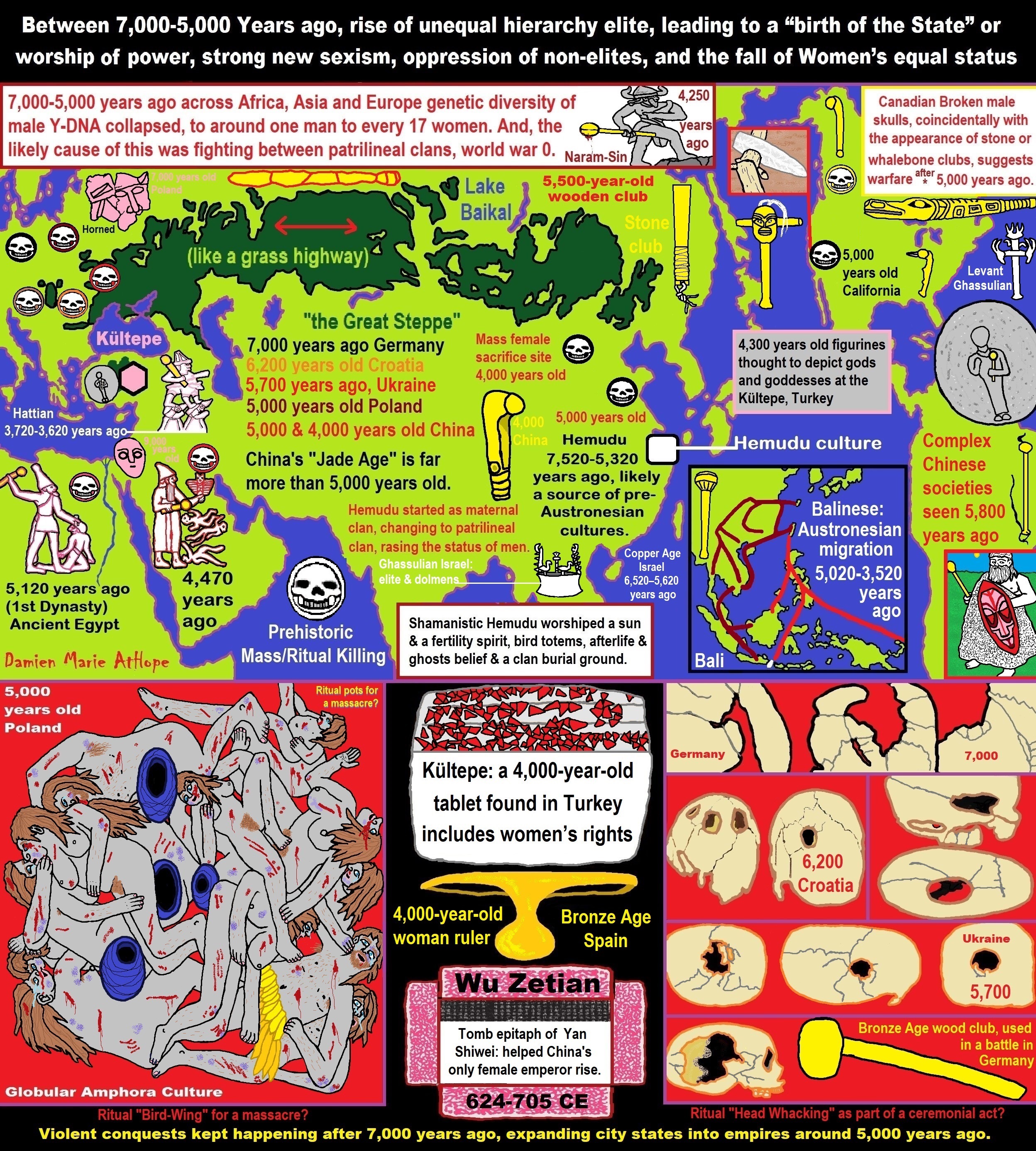
ref, ref, ref, ref, ref, ref, ref, ref, ref, ref, ref, ref, ref, ref, ref, ref, ref, ref, ref, ref, ref, ref, ref, ref, ref, ref, ref, ref, ref, ref, ref, ref, ref, ref, ref, ref, ref, ref, ref, ref, ref, ref, ref, ref, ref, ref, ref, ref, ref, ref, ref, ref, ref, ref, ref, ref, ref, ref, ref, ref, ref, ref, ref, ref, ref, ref, ref, ref, ref, ref, ref, ref, ref, ref, ref, ref, ref, ref, ref, ref, ref, ref, ref, ref, ref, ref, ref, ref, ref, ref

I surmise the first proto-king originates in the Balkans Varna culture’s Bulgarian cemetery dating to around 6,500 years old. Moreover, while 65 out of the 320 burials held 3100 gold objects but only five burials: 1, 4, 36, 41, and 43 comprise over 80% of the gold found. Yet of these five burials only grave 43 shown here contained an actual skeletal while the others are symbolic faces. These metaphorical burial faces, to me, both represent the clay head around 6,500 years old, found submerged in Varna Lake from the Hamangia Culture, of which I think could relate to the emergence of the first male gods.
“The oldest gold treasure in the world, belonging to the Varna culture, was discovered in the Varna Necropolis and dates to 6,600-6,200 years ago. Varna is the third-largest city in Bulgaria and the largest city and seaside resort on the Bulgarian Black Sea Coast. Situated strategically in the Gulf of Varna, the city has been a major economic, social and cultural center for almost three millennia. Varna, historically known as Odessos (Ancient Greek: Ὀδησσός), grew from a Thracian seaside settlement to a major seaport on the Black Sea.” ref, ref
“The Varna culture belongs to the later Neolithic of northeastern Bulgaria, is contemporary and closely related with Gumelnița in southern Romania, often considered as local variants. It is characterized by polychrome pottery and rich cemeteries, the most famous of which are Varna Necropolis, the eponymous site, and the Durankulak complex, which comprises the largest prehistoric cemetery in southeastern Europe.” ref
“The culture had sophisticated religious beliefs about afterlife and developed hierarchical status differences: it constitutes the oldest known burial evidence of an elite male. The end of the fifth millennium BC is the time that Marija Gimbutas, founder of the Kurgan hypothesis claims the transition to male dominance began in Europe. The high status male was buried with remarkable amounts of gold, held a war axe or mace and wore a gold penis sheath. The bull-shaped gold platelets perhaps also venerated virility, instinctive force, and warfare. Gimbutas holds that the artifacts were made largely by local craftspeople.” ref
“Burials at Varna have some of the world’s oldest gold jewelry. There are crouched and extended inhumations. Some graves do not contain a skeleton, but grave gifts (cenotaphs). The symbolic (empty) graves are the richest in gold artifacts. Around 3000 gold artifacts were found, with a weight of approximately 6 kilograms. Grave 43 contained more gold than has been found in the entire rest of the world for that epoch. Three symbolic graves contained masks of unfired clay. The weight and the number of gold finds in the Varna cemetery exceeds by several times the combined weight and number of all of the gold artifacts found in all excavated sites of the same millenium, 5000-4000 BC, from all over the world, including Mesopotamia and Egypt”.” ref
“Varna Culture Decline: The discontinuity of the Varna, Karanovo, Vinča and Lengyel cultures in their main territories and the large scale population shifts to the north and northwest are indirect evidence of a catastrophe of such proportions that cannot be explained by possible climatic change, desertification, or epidemics. Direct evidence of the incursion of horse-ridingwarriors is found, not only in single burials of males under barrows, but in the emergence of a whole complex of Indo-European cultural traits.” ref
Copper Age migrations likely motivated to escape war/violence and climate caused problems brought waves of migration from Turkey and Iran as well as ideas or possibly people as well from the Balkans to north Israel as well small parts of Jordan around 6,500–5,800 years ago.
“The Funnel Beaker Culture – “First Farmers of Scandinavia” around 6,200-4,650 years ago marks the arrival of Megalithic structures in Scandinavia from western Europe. At graves, the people sacrificed ceramic vessels that contained food along with amber jewelry and flint-axes. Flint-axes and vessels were also deposed in streams and lakes near the farmlands, and virtually all Sweden’s 10,000 flint axes that have been found from this culture were probably sacrificed in water. Ancient DNA and the peopling of the British Isles – pattern and process of the Neolithic transition 6000 years ago.” ref
The first human-caused climate change, dramatically changed how nature works, such as the way plant and animal communities were structured on Earth around 6,000 years ago.
The first human migrations spread the first plague is believed to have contributed to the plunge of Europe’s settlements around. As well as the close contact between humans and animals and the accumulation of food, likely led to poorer sanitary conditions and an increased risk of pathogen around 6,000-5,000 years ago.
The first passage tomb thought to lead to the afterlife from Ireland, close to when people first began farming in the region that seems to mark a transition towards a time when religion played a greater role in people’s lives 5,800-5,500 years ago.
The first birth of the State, the rise of Hierarchy, and the fall of Women’s status 5,500-5,000 years ago. And more than 5,000 years ago a nomadic group of shepherds rode out of the steppes of eastern Europe to conquer the rest of the continent. The group, today is known as the Yamna or Kurgan/Pit Grave culture, brought with them an innovative new technology, wheeled carts, which enabled them to quickly occupy new lands.
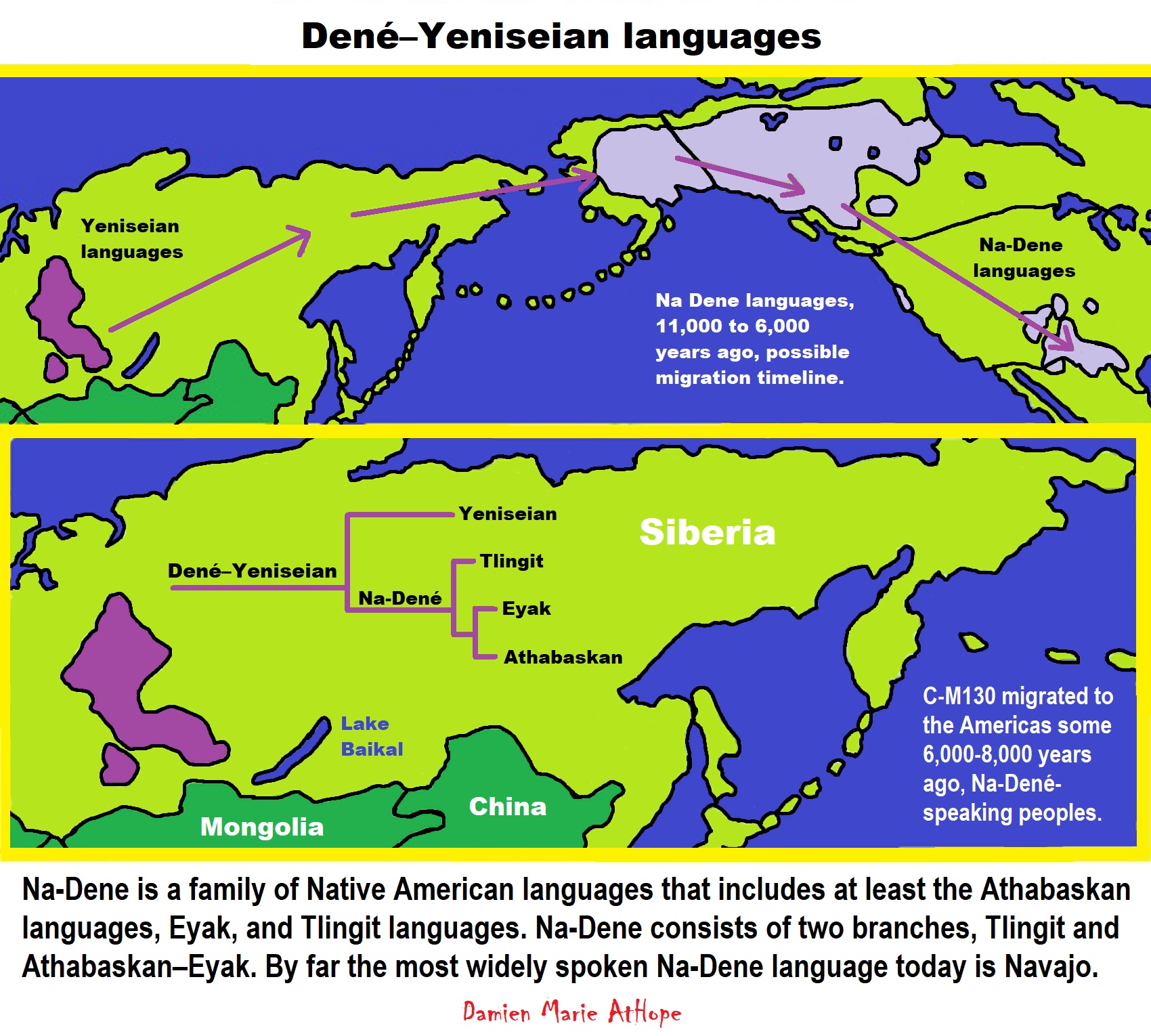
My art and when as well as who may have brought in the new elitism and compulsory authority to the Americas.
C-M217 Na-Dene and Yeniseian Languages and Religion relatedness from Asia connecting to the Americas
“For the Tlingit (branch of the Na-Dené language family), hereditary slavery was practiced extensively until it was outlawed by the United States. Wealth and economic power are important indicators of rank. Scientists suggest that the main ancestor of the Ainu and of the Tlingit can be traced back to Paleolithic groups in Southern Siberia.” ref
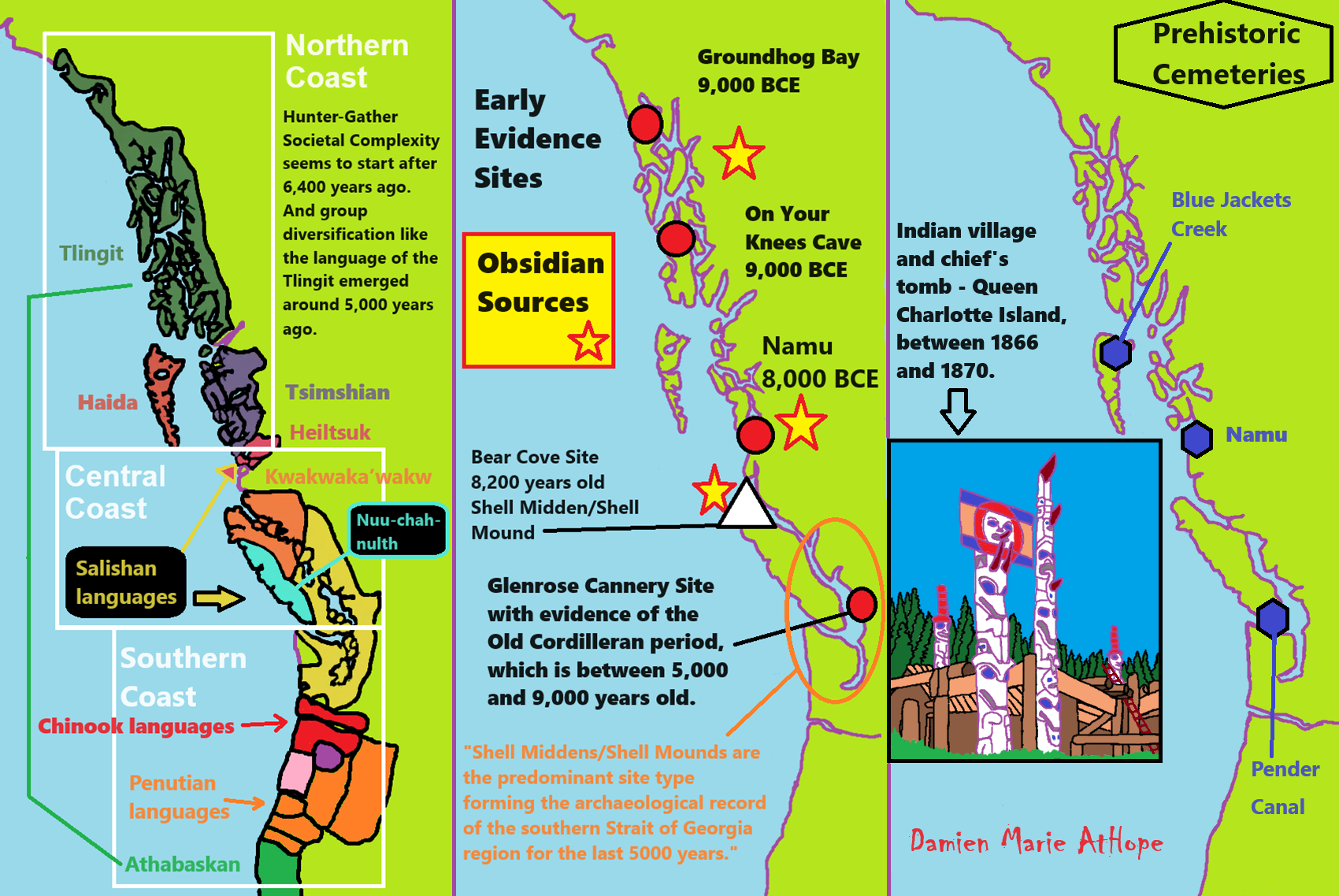
ref, ref, ref, ref, ref, ref, ref, ref, ref, ref, ref, ref, ref, ref, ref, ref, ref, ref, ref
Heiltsuk language (Heiltsuk, also known as Bella Bella, not be confused with Salish-speaking Nuxalk peoples, called Bella Coola)
Athabaskan languages (part of the Na-Dené: Athabaskan–Eyak–Tlingit)
Blue Jackets Creek archaeological site
Pander Canal archaeological site
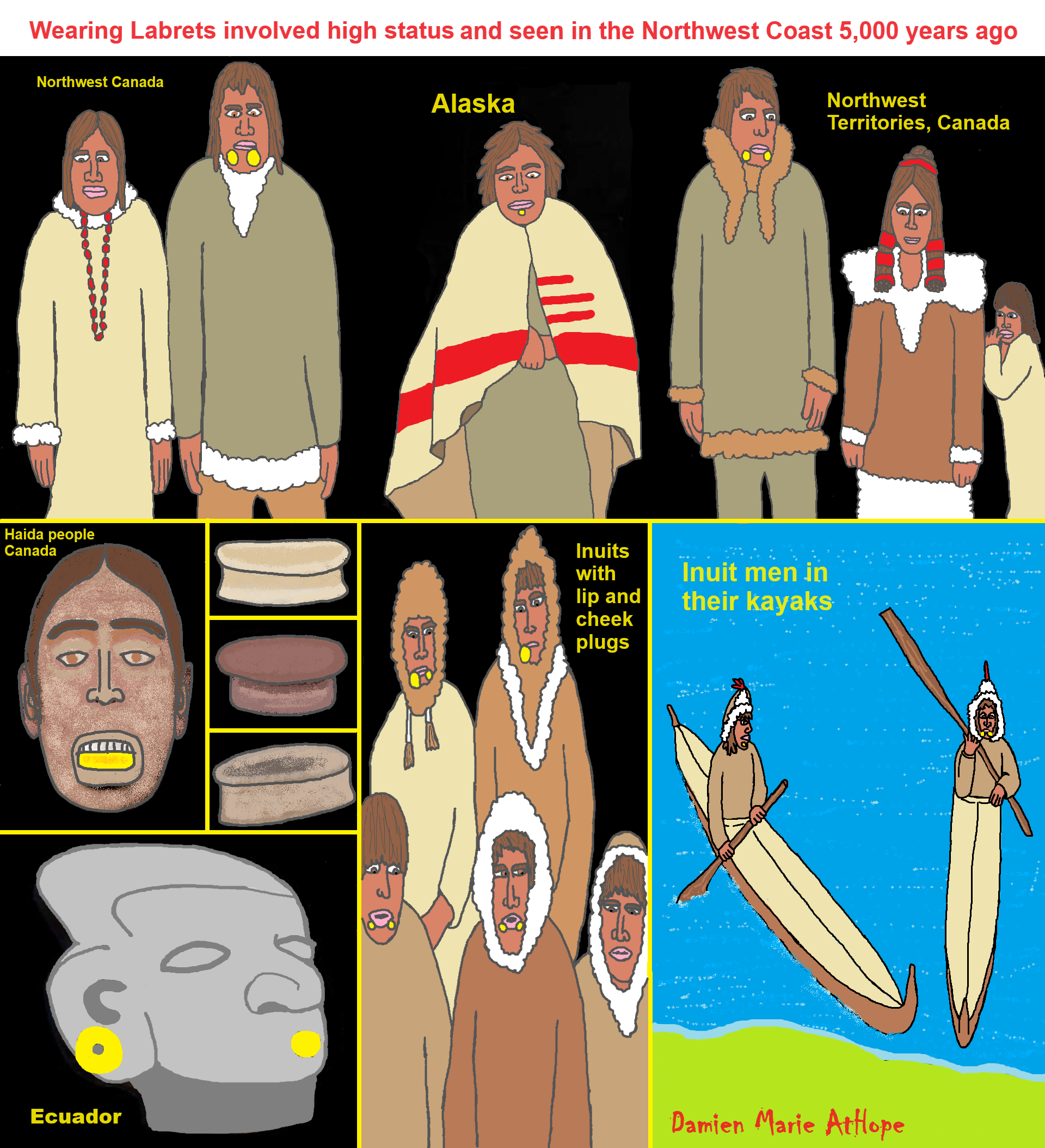
Wearing Labrets involved high status and was seen in the Northwest Coast 5,000 years ago.
Labrets? “a sign of power/status”
“A labret is a form of body piercing. Taken literally, it is any type of adornment that is attached to the lip (labrum). However, the term usually refers to a piercing that is below the bottom lip, above the chin. The labret was a traditional piercing among the American Northwest Coast Indians, where it was related to status:
“access to labrets. After 3,000 years ago, a divergence in labret wear in north and south coasts. In the north from 1500 – 3500 years ago, more labrets worn by males. After 1500 years ago, labrets worn by females. In the south, between 2000 – 3500 years ago, worn by males and females, but from 2000 years ago on, labrets generally disappear and are replaced by cranial deformation by free males and females of whatever class (e.g. elite or commoner). So, for 4,000 years on the northwest coast, it was important to distinguish certain individuals in a very direct manner; either by cranial deformation or by labret wear. Gender and geographical region may also be identified by these methods.” ref
“When a mask was being made to represent someone of high status, that mask would likewise have a labret. The wearing of labrets was widely observed among Tlingit women of high status at the time of European and American arrivals in Southeast Alaska. The Russian term for the Tlingit, Koloshi, derived from an Alutiiq word for labret. Based on analysis of the history and social context of the labret (lip plug) on the Northwest Coast of British Columbia over the last 5,000 years, Marina LaSalle asserts that “while simple correlations of the labret with ‘status’ and ‘gender’ are not wrong, nonetheless they betray the complexity of body ornamentation which, though manifested materially, is highly contextual” and that “the labret is a symbol and expression of social identity that continues to hold significant meaning for the descendants of this heritage.” ref
“Labrets were used as personal adornments that were applied by piercing either the lips or the cheeks. They may date as early as 10,700 years ago at the Ushki I site in the Kamchatka Peninsula in Siberia. The archaeological record suggests they “may have been” independently invented in six locations around the world at the southern Kamchatka Peninsula, Iran, the Balkans, Sudan in Africa, southwestern Mexico and in Ecuador. The long distant movement of labrets between cultures around these regions indicates a wide ranging cultural interaction that may be the result of trade and marriage alliances.” ref
“In some parts of the world, people cut holes in their lips for the insertion of plugs or buttons. To such ornaments the name labret is frequently given”——1926, Clark Wissler, “The Relation Of Nature To Man In Aboriginal America,” p. 61. “The labret, among American aborigines, is well known to be a plug, stud or variously-shaped button, made from various materials, which is inserted at or about the age of puberty through a hole or holes pierced in the thinner portions of the face about the mouth.”——–1884, W. H. Dall, “On Masks, Labrets, And Certain Aboriginal Customs, With An Inquiry Into The Bearing Of Their Geographical Distribution,” Third Annual Report Of The Bureau Of Ethnology To The Secretary Of The Smithsonian Institution, pp. 77-78.” ref
“They (labrets) are worn in some tribes by women only, in others by men only, in still others by both sexes, in which case the style of the labret is different for each sex.”—-1884, W. H. Dall, “On Masks, Labrets, And Certain Aboriginal Customs, With An Inquiry Into The Bearing Of Their Geographical Distribution,” Third Annual Report Of The Bureau Of Ethnology To The Secretary Of The Smithsonian Institution, p. 78. “The first descriptions by Europeans (in 1741) of the use by Alaskan peoples of tattoo and labrets refer to the Aleuts and Pacific Eskimos.”—-1988, Joy Gritton, “Labrets And Tattooing In Native Alaska,” Marks Of Civilization, p. 181.” ref
“Labrets (in Alaska) could be made of a variety of materials: stone (quartz, agate, jadite, serpentine or slate), graphite, glass, bone, wood or ivory.”—-1988, Joy Gritton, “Labrets And Tattooing In Native Alaska,” Marks Of Civilization, p. 186. “The decline of these two permanent modes of adornment (labrets & tattooing) has generally been attributed to intense efforts on the part of Christian missionaries to eradicate aspects of dress, grooming, and ritual they found offensive.”—-1988, Joy Gritton, “Labrets And Tattooing In Native Alaska,” Marks Of Civilization, p. 181.” ref
“The world distribution of labrets is very limited. From my observations independent development of labrets seems to be a rare occurrence. Labrets originate and disperse from a maximum of six localities in the world.”—-1989, Grant Keddie, “Symbolism And Context: The World History Of The Labret And Cultural Diffusion On The Pacific Rim,” p. 7. “I refer to the use of labrets, which for brevity may be called labretifery.”———1884, W. H. Dall, “On Masks, Labrets, And Certain Aboriginal Customs, With An Inquiry Into The Bearing Of Their Geographical Distribution,” Third Annual Report Of The Bureau Of Ethnology To The Secretary Of The Smithsonian Institution, p. 77.” ref
Their use in the southern Kamchatka Peninsula in Siberia likely relates/connects to their use in the Americas, to me.
“At the southern Kamchatka Peninsula in Siberia where Dikov suggests a date of 10,700 years ago, for labrets he discovered in level VI on the Ushki I site. Labrets are believed to have spread to the eastern north Pacific sometime after 5500 years ago. Some of the earliest labrets in North America were found just south of Vancouver on Pender Island. They date to at least 5100 years ago. This labret was collected in western Alaska but it’s also similar to labrets that have been found on the southern coast of British Columbia that date to between 5000 and 2000 years ago. This labret is made of coal. It measures 7/8 of an inch (2.3 cm) wide.” ref
Pacific NW coast mask and labrets Haida people, Haida Gwaii, Canada, 19th century
“From a selection of crafted wood, bone, and pottery lip-plugs or ‘labrets’ (from the Latin labrum meaning ‘lip’ or ‘edge’). Are things like a realistic mask, which was carved before 1868 and depicts the wife of the artist, shows how a labret would be worn in the lower lip. Labrets thought to have been worn exclusively by women of the Northwest Coast including those of the Haida, Tlingit and Tsimshian peoples. Usually inserted into an incision below the lower lip, the labret was a distinctive personal ornament, and highly visible mark of noble status and political influence as well as beauty. However, labrets were not without their problems, resulting in difficulties in eating and drinking, as well as occasional periodontal disease and tooth loss, so for this and other reasons modern Haida women no longer wear them.” ref
“Labrets were the subject of much fascination, discussion and speculation among 18th- and 19th-century explorers, traders, missionaries and ethnographers. Many sources say the lip was pierced on the occasion of the girl’s first menstruation and a small ornament inserted. This was one of several events that accompanied a girl’s puberty ritual including isolation away from the main group and the prohibition of certain foods. The size of the adult labret was associated with how many children the woman had as well as the hierarchical status of her kin group. For example, the red-coloured pottery lip-plug shown here was worn by a woman who had had several children. The most elite women wore the largest labrets, sometimes made of expensive materials such as copper or abalone shell. Haida society is based on a matrilineal system of descent and is divided into two main groups, Eagle and Raven. All Haida men or women are expected to marry a member of the opposite group. Since the mouth, as the locus of speech, was considered a powerful place on a woman’s body, a woman could through her words either mediate or agitate relations between clans of each group.” ref
“The earliest evidence of facial piercing and body modification in Africa has been discovered in the skeletal remains of a man who lived 12,000 years ago. By analyzing his teeth, researchers were able to identify abrasions from an object that had been rubbing against them – indicating that the man’s chin and cheeks had been gauged with jewelry. Finding such examples, as well as other forms of body modification, is tough because the soft tissue that was pierced has often worn away or been regarded beyond recognition. Most cultural piercings tend to take place on surface areas like skin, more serious forms embedded in the muscle that have long since perished on discovering the remains.” ref
“A study published in the American Journal of Physical Anthropology told of the work, led by John C. Willman from the University of Coimbra in Portugal, that saw scientists given access to the skeletal remains of Olduvai Hominid 1 (OH1). It once belonged to a young man who lived towards the end of the Late Pleistocene period, some 20,000 to 12,000 years ago. The skeleton was recovered from Tanzania, with evidence suggesting he had been purposefully buried. Initial research suggested that his teeth has been deliberately filed down in a body modification process known as ablation. This was a common occurrence, where teeth were purposefully removed with the intention of identifying an individual as being part of a group. However, the fresh research suggests the teeth’s wearing away was more likely a case of a lip or chin piercing, so say Mr Willman and his team of researchers.” ref
“This, they say, is hugely significant, as it revises our understanding of the culture and practices of our early ancestors. Mr Willman said: “Our review of the literature shows no evidence for facial piercings in Africa prior to about 10,000 years ago, in individuals from archaeological sites in Sudan.” Ablation, he noted, was common in Africa between 20,000 and 12,000 years ago. What’re, the example of Olduvai Hominid 1’s body modification nestles among a sea of ablation, revealing that the hithero undiscovered practice was likely more common than has ever been considered.” ref
“Similar to body modification jewelry worn in the present day, Olduvai Hominid 1 might have worn large discs at least an inch wide. The jewelry may have been carved out of wood that decomposed over time, or the discs may have been removed on his burial. It is not known when and why the practice of facial modification through gauges and jewelry began. Such present-day modifications are largely done as a symbol of expressing an individuals identity to showing they belong to a specific group, with scientists suggesting this may well be the case for our ancestors.” ref
Ancient Alaskan Labrets: jewelry that spoke louder than words
“Labrets, ornamental lip plugs worn through a perforation in the lower lip or cheek, are a frequent find in coastal Alaskan archaeological sites. From prehistoric times, members of Aleut, Eskimo, and Indian hunter-gatherer tribes wore them for personal adornment, to reflect social affiliation, and to broadcast hereditary rank. Because they were made of durable materials—wood, bone, stone—many have been preserved through the ages, providing important clues to frontier scientists about life in ancient coastal Alaska. (See the video Jewelry Alutiiq Style.)” ref
“According to archaeologist Amy Steffian, who collects and interprets artifacts for the Alutiiq Museum on Kodiak Island, “In many traditions, labrets were used to broadcast messages. They indicated territorial boundaries and social rank. They helped tribes quickly predict how things would go when they encountered others. They helped maintain group cohesion at a time when warfare was common among hunter-gatherers who traveled long distances by boat, and found themselves competing for food, raw materials, and even spouses with their neighbors.” ref
“A good deal of Steffian’s work has focused on prehistoric Gulf of Alaska societies from the Kodiak Archipelago, the northern-most region of the Pacific Ocean, where maritime foragers have lived for the past 7,500 years. Ethnicity, regional affiliation, family ties, gender, age, grade, ownership, rank, and religious beliefs are some of the social categories that are stylistically symbolized by traditional labrets, as noted in a study she co-authored with colleague Patrick Saltonstall. Labret piercing took place in childhood, with labret holes periodically stretched over an individual’s life to accommodate larger ornaments. Plugs were inserted below the lower lip or at the corners of the mouth at either birth or puberty. The initial incision was usually quite small and fit with a slender object to prevent closure. The variation was tremendous: inlays, incised designs, and attachments were common additions to the basic labret forms.” ref
“With the widespread arrival in Alaska of foreign explorers, merchants and missionaries in the 18th century, labrets rapidly disappeared. During the Russian period such piercings were signs of rank, and those individuals were singled out as hostages. Westerners also found labrets a horrifying facial disfigurement, and along with changes in society, the use of such ornaments was quickly abandoned. Interestingly, the purpose and stylistic variety found in this traditional jewelry carry on today, as demonstrated by current fashions. Tattoos, eye-popping hair dyes and piercings are popular ways for youth of today to broadcast their identity not just to puzzled parents but to the world. Modern-day labrets’ function hasn’t changed; they demonstrate membership in a like-minded group, express personal identity, and differentiate the wearers from other groups.” ref
Older than Expected: The Prehistoric Piercings of Turkey
Evidence suggests piercings were used as a sign of adulthood in Neolithic Türkiye
“The little ornaments dating back as late as 10,000 BC were made from limestone, obsidian, flint, serpentine, chlorite, and copper. Of these ornaments, 85 were found in situ in burial contexts. This means archaeologists could determine precisely where the ornaments lay in life, for example, next to the left and right ear lobes or just in front of the mandible.” ref
Neolithic Chic: Body Piercing Fashion from the Arctic Around 5,000 Years Ago
“Ancient items of jewellery found by archeologists on Taymyr peninsula are stone labrets which were inserted into the face below the bottom lip. The discovery was made during the summer 2016 archeological season at a location some 600 kilometers above the Arctic Circle. The site in the far north of Krasnoyarsk region is believed to date as far back as three or four millennium BCE. Labrets are a kind of jewelry, which can be made of shell, bone, or stone, and is inserted into the lip as an ornament in some cultures.” ref
“The discovery was made by archeologists from Krasnoyarsk Geoarkheologia, and spokesman Danil Lysenko said: ‘We found these labrets at the Neolithic site Bolshaya II, which is located on the bank of Novaya River, a tributary of the Katanga River. ‘They were just lying on the ground, along with stone arrowheads. In some places here, the wind blows away the upper layer of tundra and the sand, so the ancient items are there, just on the ground, uncovered. ‘Judging by the stone arrowheads, the site can be preliminarily dated as being from the fourth to the third millennium BCE.’ Archeologists say these facial decorations – two were found this summer in the Arctic – were common among the ancestors of the western Eskimos, Aleuts, the North American Indians. It is believed they were worn by men as well as women.” ref
Evidence for Labret Use in Prehistory
“Abstract: Bull Int Assoc Paleodont. 2020;14(1):1-23. Abstract Aims. Compared to occlusal dental wear, labial/buccal abrasion is seldom documented in prehistoric groups. This type of wear occurs in some ethnographic-present and living populations and leaves telltale facets on non-occlusal vestibular surfaces associated with labrets. Methods and materials. For detailed macroscopic, microscopic (binocular and SEM), and thin-sectioned analysis, we focused on the early Neolithic site of Mehrgarh in Pakistan, where labial/buccal wear is found in mostly older adult males. We studied 215 teeth from ten individuals from the site. From the literature and some personal observations, we review evidence from the Czech early Upper Paleolithic and many later sites in the Old and New Worlds. Results. For Mehrgarh, macroscopic observations revealed numerous teeth with labial and buccal facets that affected nearly every Frayer etal. NO-FEE OPEN ACCESS JOURNAL indexed in Scopus tooth class. Binocular and scanning electron microscopy and one thin-sectioned tooth provided detailed information about the wear characteristics on the facets.” ref
“Comparisons. The most striking parallels to wear at Mehrgarh come from recent Inuit and Northwest Coast Native Americans where labret use was frequent in males and females. Vestibular wear occurs in various specimens from the early Upper Paleolithic to modern patients. Unlike Mehrgarh and earlier prehistoric groups, in many cases, Native American teeth are associated with the actual labrets in the graves. Conclusion. Occlusal wear or attrition caused by dental/oral manipulations where the teeth were used as tools differs, based on the resultant facets left on the teeth and micro-wear features. In prehistoric Europe, labret use extends back, at least, to the early Upper Paleolithic. As in recent humans, the use of labrets in prehistoric groups likely represents personal adornment tied to concepts of beauty and/or achieved/acquired status.” ref
“The practice of inserting lip and cheek plugs is an under-reported area in dental anthropology. In part, this is because most dental anthropologists have focused on occlusal tooth wear and internal dental structure, but also because researchers tend to ignore or not look for vestibular wear on anterior and posterior teeth. In the samples we reviewed, these lesions represent well-defined, sometimes deep facets on the labial and buccal surfaces, which must have taken some time to develop during the lives of the affected individuals. A few studies have documented this type of non-occlusal wear in recent populations, and the pattern seems to extend into the deep past. Wear on the labial/buccal faces was first described more than 100 years ago, which was attributed to abrasive tooth powders and excessive brushing, factors irrelevant to our work.” ref
“For the fossil record, Matiegka first noted buccal wear in some early Upper Paleolithic remains from the Czech early Gravettian site of Předmostí. Others have described similar wear for numerous early Upper Paleolithic specimens from Central Europe. Here, we focus on evidence for labret use in the Pakistani site of Mehrgarh (~9000-5000 years ago) and extend this evidence for labret use to a wide variety of fossil populations ranging from hunter-gatherers to agriculturalists. Similar evidence continues into ethno-historic and contemporary groups and, in some cases, provides ethnographic-present explanations for examples in prehistoric samples. These appear to be nonfunctional body decorations and serve as markers of beauty and status, just as perceived in extant groups. Evidence for lip and cheek plugs merits future surveys of other populations for documentation.” ref
Evidence for labrets in prehistory: South Asia
“Our initial interest in labrets stems from the dental remains of some individuals from the early Neolithic period at Mehrgarh in Baluchistan, Pakistan. This site is an extensive, deeply stratified prehistoric village and cemetery. Located at the foot of the Hindu Kush on the east bank of the Bolan River in the northwestern extension of the Kacchi Plain, it is in a strategic area at the southwest access to the Bolan Pass, Figure 1a. Initial excavations began in 1974 by a French Archaeological Mission in Pakistan (with the collaboration of the Pakistani Department of Archaeology) when erosion exposed a deep stratigraphic sequence. Eleven subsequent field seasons (1977-1985 and 1997-2000) uncovered a large graveyard with skeletons dated as far back as 9000-5000 years ago. Our focus here is on the earliest Neolithic, named MR3, dated to 9000-7800 years ago. Burial grounds for this period extend over 12 hectares, and the absence of breaks in the sequence suggests these Neolithic individuals were buried during a ~1500-year time span, Figure 1b. Dental anthropology at Mehrgarh has been widely reported by Lukacs and colleagues, documenting dental size, pathology, fluorosis, trauma, and activity-induced patterns of dental abrasion in the skeletal collection deriving from the 1977-1985 field. More recently, tooth drilling as a form of prehistoric dentistry was reported on nine individuals.” ref
Other areas in Middle and South Asia and the Near East
“One of the problems we have in attributing, especially the labial/buccal facets, to labret use is that no labrets have been found in the archaeological collections from Mehrgarh. However, as documented in the ethnographic-present samples discussed below, labrets were sometimes made of wood or other perishable materials, which may have been the case at Mehrgarh. As far as the Near East, Middle, and South Asia are concerned, there is some evidence for labrets in other contexts, which is reflected in different materials. Bocquentin et al. report on two Natufian central incisors with extensive labial flattening of the incisor faces. SEM analysis revealed numerous, parallel vertical striations running up the abraded facets, which are flat, not concave like found in labret wear. Although the potentiality of wearing a lip plug was considered, Bocquentin et al. argued the wear was more likely caused by some kind of repetitive action from a tool.” ref
“The earliest and most convincing material evidence for the use of lip plugs comes from the Deh Luran plains of south-western Iran, specifically from the site of Ali Kosh, where in a graveyard dated to the early 6th millennium BCE one individual was buried with a bitumen plug found in place on the lower jaw, with corresponding wear marks on teeth. Objects possibly identified as labrets or lip plugs, but only on morphological grounds, have been reported with variable degrees of plausibility from the early 6th millennium BCE Neolithic site of Tol-e Nurabad and from the early-mid 6th millennium BCE site of Tall-e Mushki in the Marv Dasht plateau, both from south-western Iran and again from other southern Iranian sites in Fars. Labrets have also been identified from mid-late 6th millennium BCE site of Sabi Abyad in Syria, in sites of the Kuwaiti coast of the Persian Gulf. In these and other cases of morphological identification, there is little chance of distinguishing labrets exclusively from tokens used in quite different ways. Statements by Pollock and Bernbeck concerning finds from Mondjukli Tepe, Turkmenistan express doubts about labrets. Similar questions for Tol-e Nurabad are reviewed in length in.” ref
“In the Near Eastern societies of the late 6th-5th millennium BCE and in the so-called sphere of the Ubaid period, objects interpreted as labrets (or as possibly ear spools) become quite common based identifications at the sites of ‘Oueili, Tell Abada, Tepe Gawra, Ra’s al-Amiya, Choga Sefid. Actually, these objects, whatever their ancient function, are considered “significant and easily recognized markers of Ubaid personal identity”. Afterward, the use of labrets expanded geographically with the Ubaid culture and remained in use through the beginning of the 4th millennium BCE (for example, at Choga Mish in Susiana, Iran. After about 3500 BCE or around 5,500 years ago, the ornaments seem to have disappeared at the onset of the Uruk period. The iconographic evidence of the use of labrets in the Near Eastern and Middle Asian regions is quite limited. A terracotta head of a human figurine found at Choga Mish (Khuzistan, Iran), dates back to the early 5th millennium BCE. A round plug is clearly represented as a button-like relief, protruding from the lower lip. The small balafré (scarred men) statues, reportedly from southwestern Iran, but most likely coming from the Oxus region in northern Afghanistan are much later, tentatively dated to the late 3rd millennium BCE.” ref
“These still mysterious images (none were found in a scientific excavation) appear to have pierced upper and lower lips in the region of the central incisors. Yet, no figurine or statue of the same description has been found at Mehrgarh. Moreover, no other statues or carved heads from the Oxus region have lip piercings. Vidale suspects that the holes represent openings for the insertion of piercing plugs. In such a case, the lip holes should be considered as archaic or exotic representations. Except for these, in the Near Eastern and Middle Asian regions, there are no depictions of presumable lip plugs in statues.” ref
Evidence for labrets in prehistory: Europe
“Vanhaeren and d’Errico report the presence of an Aurignacian, ivory labret from Spy Belgium. No lip plugs, but similar buccal lesions to those at Mehrgarh have been documented for various Gravettian sites in Central Europe. Matiegka, Vlček, and Drozdová reviewed the evidence for buccal facets from Předmostí, Pavlov, and Dolní Vestonice involving mandibular and maxillary teeth. All these authors attributed the buccal wear to carrying stones in the mouth to ward off thirst. Trefný and Hillson made a similar argument, although Hillson maintained that “the cheeks might, for example, have been used to hold an implement or in the processing of a food or material”. To produce this kind of buccal wear, the stones or activity must have had sustained use and targeted in just a small area of the mouth. Willman opposed these arguments, suggesting lip and cheek plugs were more likely. We agree, and labret usage can better account for the buccal tooth wear in the Czech Gravettian, although, like Mehrgarh, no labrets have been found in any of these sites.” ref
“There are a series of pendants and other small objects at Dolní Vestonice, but these have never been considered as lip or cheek plugs. Labial/buccal lesions have not been documented in the European Mesolithic or Neolithic, but they also have not been systematically studied. Aubry et al. found no cases of this type of wear in a small sample from the French Chalcolithic, but they focused on abstractions, which are clearly different from labial/buccal abrasive wear. In a Bronze Age burial in southeastern Great Britain, Sheridan et al. describe wooden cheek plugs associated with a cremated burial of a young male, but due to burial practices, human remains were very fragmentary. Likely, there are more cases in prehistoric Europe awaiting description.” ref
Evidence for labrets in prehistoric Africa, East Asia, and Australia
“Compared to Europe, labrets are infrequently reported for prehistoric dentitions from Africa and East Asia, despite the fact they occur in several native people in Africa and Asia. For Africa, the earliest example comes from Olduvai hominid 1, a Tanzanian specimen probably from the Late Pleistocene/Later Stone Age based on associated microlithic tools. It shows extensive lingual erosions on its anterior teeth, which resemble the effect of wearing a labret. Parsche identified the facets as ‘lingual,’ but from our direct observation of OH1 the facets are clearly labial. This identification is confirmed by Willman et al. Originally, these facets were interpreted to be the result of sandstone filing and later as the result of fiber processing. Both of these explanations have been rejected by Willman et al. They found labial flattening on a maxillary canine and buccal flattening on other mandibular and maxillary posterior teeth. Based on microscopic work, they concluded all these flattened surfaces were due to labret abrasion. Later Mesolithic examples come from central Sudan, where lip plugs are found, dating to ~8000 – 7500 years ago.” ref
“Honegger also documents lip plugs in early Neolithic graves of northern Sudan (6605-6960 years ago), but did not describe dental evidence. Labrets were found in Neolithic graves in Mali, Sudan, and Chad. Keddie notes that labrets are found in central Sudan, and their popularity spreads with population movements and along trade lines. The most stunning example of labret use in Africa comes from Jebel Moya in southern Sudan. Here, Addison documented 28,000 labrets in the large cemetery. The cemetery comprises members of a pastoral group associated with the Meroitic state and is dated between 200 BCE and 400 CE. Addison claims that labrets were almost as common as potsherds. Unfortunately, much of this skeletal material was destroyed in flooding at Oxford, and most of the artifacts appear to be missing. However, MacDonald documented a few of the dentitions, which show labial wear on the anterior teeth. According to her survey, “47% of all the females examined had direct evidence for the wearing of labrets in the form of labial wear facets”. Besides labrets, it is probable some of these items were used in ear piercings, as they greatly vary in size and shape. Elsewhere Santoni et al. describe evidence of the use of labial lip plug in a mandible dating to the 14th Century from the Cameroon.” ref
“These are different from the others observed here in that the facets are confined to the mesial aspects of the canines and barely extend to the canine crowns. They seem to relate to a flat lip plug, but these were not found in the grave, and the attribution is not clear. There is some prehistoric evidence for the Near East where Bocquentin et al. report on two Natufian central incisors with extensive labial flattening of the incisor faces. SEM analysis revealed numerous, parallel vertical striations running up the abraded facets, which are flat, not concave like found in the labret wear described above. Although the potentiality of wearing a lip plug was considered, Bocquentin et al. argued the wear was more likely caused by some kind of repetitive action. Lip plugs and associated tooth wear are infrequent in the prehistory of northeast Asia. There are no documented cases of prehistoric or recent labret use in native Australians.” ref
Labrets in prehistory and the ethnographic-present in the Americas
Prehistoric evidence for labret use
“Various authors have mentioned or described actual labrets and, sometimes, dental evidence for labret use in late prehistoric groups in North, Central, and South America. Among the Aztecs and Incas, labrets served as status markers and were made from a variety of materials, from leather to lead. Pollard, describing their use in pre-Hispanic Tarascan (Aztec) groups, notes that “[m]ale members of the elite wore gold ear and lip plugs to signal their status, and at death were buried with these status markers.” Otis Charlton records that lip plugs were sometimes made of chert and obsidian among the Aztecs of Otumba. Further south in Peru, Cordy-Collins documents lip plugs from her study of pottery vessels. These depicted only females and, given the absence of lip plugs in early Moche periods, Cordy-Collins maintains these females are from outside the Moche area. Very few studies have described dental complications from these marks. An exception is the study by Torres-Rouff who reports an edentulous individual, associated with a labret. She argues anterior tooth loss in this male likely was caused by labret use, given that a large labret was found in the tomb. She describes a second case from prehistoric Chile, 400-900 years ago. This male was buried with two small, quartz labrets, which were found in place. Both canines preserved large labial wear facets, extending from the crown to each tooth’s root.” ref
“These facets correspond closely to the position where the labrets were found in the skeletal remains. Torres-Rouff reports that ‘evidence for male use of labret is pervasive in prehistoric Chile.” Reviewing evidence from the El Torín graveyard (2200 – 1000 years ago), she records polishing of the labial faces of incisors and canines, gingival recession in four males, and in all four cases, ante mortem tooth loss. Much farther north, the use of labrets is well documented by various authors for prehistoric Inuit, Athabascan, and Northwest Coast groups. Rorabaugh and Shantry report multiple types of large and small labrets in Salish archaeological deposits from 30+ sites dating from 3200 – 1000 years ago. There are some cases of dental involvement, but mostly, the labrets are isolated from skeletal material. Rorabaugh and Shantry maintain that males and females wore labrets and that they served as “credibility enhancing displays,” marking the special status of the wearer.” ref
“Labret use in the ethnographic-present Using reports by explorers, Hrdlička documented Inuits from Kodiak Island, Alaska, wearing labrets made from a variety of stone, bone, and ivory. A more recent study by Ray writes that “[m]en of the entire area [Bering Strait Eskimos] wore labrets, and it is interesting that many wore extremely large ones made of trade beads or jade, probably as a status symbol, since these huge things must have been very uncomfortable”. Pedersen published an extensive survey of 802 Inuits and found evidence of buccal wear (“abnutzungsfacetten”) in 4.5% of the skulls in collections at the Smithsonian Institution (Washington D.C.), the American Museum of Natural History (New York City) and the Anthropologicum Laboratorium (Copenhagen).” ref
“He also published various lip and cheek labrets and a large labret in a burial affecting four mandibular teeth. These produced buccal abrasions similar to those seen in Mehrgarh and the other prehistoric samples. Labret use among the western Inuits was common and spread all the way to the Aleutian Islands, but was not circumpolar since labrets are not seen in the Inuit eastern range. They also did not extend far northwest into eastern Siberia, but as documented by Keddie labrets are found in the Kamchatka Peninsula natives and in far northern Japan. Cybulski analyzed skeletal material from recent Northwest Coast groups and found evidence of labret use in mandibles of adult males and females. He records a burial preserving a large labret associated with mandibular teeth and documented a frequency of 16% of adult individuals with labrets, all involving anterior teeth.” ref
“For Northwest Coast groups, La Salle records a wide variety of labret raw materials including “antler, basalt, bone, shell, coal, horn, ivory, quartz, quartzite, sandstone, siltstone, slate, soapstone, steatite, clay, limestone, mudstone, serpentine, talc, wood, and copper.” She also reviews ethno-historic sources for Northwest Coast groups and found that: “The older the woman the larger is the ornament, and young girls have only a needle in the lower lip, the married women alone have the right to the bowls”. Dall describes the labret, worn by all women but slaves, as a symbol of vigor, fortitude, and mature development, of sexual freedom, of maturity only, and, of power, privileges, and respect. Moss found evidence for lip and cheek labrets in Catlin’s portraits of Native Americans, which he contended generally signified a higher status of the wearer in both males and females.” ref
The Dentalium Labrets Of The Tlingit
“There’s a legend among the Tlingit that starts by saying, “No one knows where the story of Raven begins, so everyone starts from where they know and goes on from there.” According to the story, Raven was a god-like figure with an abalone shell labret, and he (or sometimes she) made the world. Not the whole universe, mind you, but this particular world. So he had a world, and he needed a light for it. Raven knew a guy, out there in the universe, who had a light, so he went and got that guy’s daughter pregnant. The child that was born cried all the time, and Raven and his new family gave the child all the stars in the sky, the sun and the moon, all the earth it could walk on, the sea to fish in, and a lot of friends. And that’s where the world, and the people in it came from.” ref
“Among the Tlingit, Whose name means “People of the Tides,” that story, the story of how Raven created the world, is as much property as the land you might live on, or the laptop you’re reading this on. Stories, names, dances, and songs were all owned by clans. You might be given a name to pay back a debt, or, if the person who owes you was particularly hard to collect from, you might steal a dance or a song instead. According to one of their other legends, they met a group of people, not Tlingit but “people with whom you could trade” and they were called Athapaskan people. Nomads who’d been robbed and had other troubles along the way. Mighty hunters though, and very knowledgeable about things like dancing and fashion.” ref
“The Athapaskans sported some amazing tattoo work, and some great jewelry. One of their habits, the wearing of nose rings and nose pins and labrets made from slate and abalone, caught on with the Tlingit, and became a tradition practiced over the centuries. They could pierce and stretch their septums with dentalium shells, or porcupine or bird’s quills. The earliest settlements made things like labrets from slate. Later they made ornaments like copper rings and disks. It wasn’t simply a matter of fashion sense either. It’s interesting that the Tlingit legends describe Athapaskans as “People with whom you could trade”, because with the scarcity of food and goods in the northern tundra, people you could trade with were one of their most important assets. War for goods, food, spouses, and among some people (including the Tlingit, at least until the 1860s) slaves was common. A harsh winter could divide clans, and set people against each other.” ref
“But how… Could you know if the people you saw in the distance were friends or foes? If they would kill you or trade with you? The answer is by looking at their jewelry. The way labrets and other jewelry was worn could indicate tribal boundaries, social status, whether you were open to trading or looking for a fight. They were a sign of who you were within your society, what society you belonged to, and how high caste or low caste you might be. People could tell everything about you just by looking at your face. Stem from earlier indigenous peoples that scientists now call “Paleo Hunter Gatherers”, and archeological digs have turned up the same kinds of jewelry that traditional northern indigenous people were still wearing when Edward S. Curtis (see the pics on the right) came through to photograph them in the early 1900s.” ref
“It’s a tradition, just like stories about Raven, that spans clans and cultures across the northern Pacific coast, up into Alaska and across the Yukon Territory, and it goes back a long ways. Digs done in Alaska have found evidence of people, like the paleo hunter-gatherers, dating to 8000 BCE, when a land bridge still connected Siberia and Alaska. When according to legend, the first people who spoke Athapaskan crossed over and met the Tlingit, and they traded things like abalone shells for food and learned about dances and jewelry. And with them came Raven.” ref
“When Raven began journeying between the clans, from the Tlingit and Athapaskan peoples to the Kwakuitl and Inuit, he (and she, because Raven could also be a woman) had many adventures, married men and women, birds and fish and whales. That’s when Raven, as both man and woman, wore an abalone shell labret, and this became popular among the highest caste of people among the Tlingit and Athapaskans. Eventually, it was said that only the highest caste people, chiefs and children of chiefs, knew the whole story of Raven, because they were the only people who had time to learn it. But even then, no one ever knew the beginning, and no one ever will.” ref
Things that are similar in several Indigenous groups in the Pacific Northwest area
1. “Marine/riverine orientation and adapted technology
2. Sedentary life in villages
3. Highly developed woodworking technology
4. High population density
5. Strict social stratification, including slavery
6. No intercommunity organization or political offices” ref
The Evolution of the Pacific Northwest Coast: Abundance, Prosperity & Complexity (VIEDO)
“The Northwest Coast Native Americans can indeed be considered an example of a chiefdom-level society. This social organization in the Pacific Northwest was characterized by a complex hierarchical system where power was concentrated within the leadership of clans. These clans were made up of families recognizing a common ancestor, often symbolized by important regional animals like ravens or whales. The leadership held not only political power but often combined aspects of economic, religious, and sometimes military dominance. Stratification was a notable characteristic, with individual, family, clan, and town rankings. The practice of ‘potlatch’ was central to this society, reinforcing the status and hierarchy among members and other clans through ceremonial gift-giving and feasts.” ref
“The Indigenous peoples of the Pacific Northwest Coast are composed of many nations and tribal affiliations, each with distinctive cultural and political identities. They share certain beliefs, traditions and practices, such as the centrality of salmon as a resource and spiritual symbol, and many cultivation and subsistence practices. The term Northwest Coast or North West Coast is used in anthropology to refer to the groups of Indigenous people residing along the coast of what is now called British Columbia, Washington State, parts of Alaska, Oregon, and Northern California. The term Pacific Northwest is largely used in the American context. At one point, the region had the highest population density of a region inhabited by Indigenous peoples in Canada.” ref
“The Pacific Northwest Coast at one time had the most densely populated areas of indigenous people ever recorded in Canada. The land and waters provided rich natural resources through cedar and salmon, and highly structured cultures developed from relatively dense populations. Within the Pacific Northwest, many different nations developed, each with their own distinct history, culture, and society. Some cultures in this region were very similar and shared certain elements, such as the importance of salmon to their cultures, while others differed. Prior to contact, and for a brief time after colonization, some of these groups regularly conducted war against each other through raids and attacks. Through warfare they gathered captives for slavery.” ref
“The Tlingit are a matrilineal society. They developed a complex hunter-gatherer culture in the temperate rainforest of the Alaska Panhandle and adjoining inland areas of present-day British Columbia. The Haida people (/ˈhaɪdə/ HY-də) are well-known as skilled artisans of wood, metal, and design. They have also shown much perseverance and resolve in the area of forest conservation. The vast forests of cedar and spruce where the Haida make their home are on pre-glacial land, which is believed to be almost 14,000 years old. The Haida were widely known for their art and architecture, both of which focused on the creative embellishment of wood. They decorated utilitarian objects with depictions of supernatural and other beings in a highly conventionalized style.” ref
“Haida communities located in Prince of Wales Island, Alaska and Haida Gwaii, British Columbia (previously referred to as the Queen Charlotte Islands) also share a common border with other Indigenous peoples, such as the Tlingit and the Tsimshian. The Haida were also famous for their long-distance raiding and slaving, going often to California for trading. The Tsimshian (/ˈsɪmʃiən/ SIM-shee-ən), translated as “People Inside the Skeena River,” are indigenous people who live around Terrace and Prince Rupert on the North Coast of British Columbia, and the southernmost corner of Alaska on Annette Island. There are about 10,000 Tsimshian, of whom about 1,300 live in Alaska.” ref
“Succession in Tsimshian society is matrilineal, and one’s place in society was determined by one’s clan or phratry (defined as four equal parts). Four main Tsimshian clans form the basic phratry. The Laxsgiik (Eagle Clan) and Ganhada (Raven Clan) form one half. Gispwudwada (Killer Whale Clan) and Laxgibuu (Wolf Clan) form the other half. Prior to European contact, marriage in Tsimshian society could not take place within a half-group, for example between a Wolf and a Killer Whale. It was considered to be incest even if there was no blood relationship. Marriages were only arranged between people from clans in different halves: for example, between a Killer Whale and a Raven or Eagle.” ref
“The area referred to as the Northwest Coast has a very long history of human occupation, exceptional linguistic diversity, population density and cultural and ceremonial development. Noted by anthropologists for its complexity, there is emerging research that the economies of these people were more complex and intensive than was previously assumed. Coast Salish peoples’ had complex land management practices linked to ecosystem health and resilience. Forest gardens on Canada’s northwest coast included crabapple, hazelnut, cranberry, wild plum, and wild cherry species. Many groups have First Generation Stories – family stories that tell of the origin of the group, and often of humans themselves arising in specific locations along the coast.” ref
Stratification and social structure in the Pacific Northwest
“The Northwest Coast was the outstanding exception to the anthropological truism that hunting and gathering cultures—or, in this case, fishing and gathering cultures—are characterized by simple technologies, sparse possessions, and small egalitarian bands. In this region, food was plentiful; less work was required to meet the subsistence needs of the population than in farming societies of comparable size, and, as with agricultural societies, the food surpluses of the Northwest encouraged the development of social stratification. The region’s traditional cultures typically had a ruling elite that controlled use rights to corporately held or communal property, with a “house society” form of social organization. The best analogues for such cultures are generally agreed to be the medieval societies of Europe, China, and Japan, with their so-called noble houses.” ref
“In house societies, the key social and productive unit was a flexible group of a few dozen to 100 or more people who considered themselves to be related (sometimes only distantly), who were coresident in houses or estates for at least part of the year, and who held common title to important resources; in the Northwest, those resources included sites for fishing, berry picking, hunting, and habitation. House groups also held a variety of less-tangible privileges, including the exclusive use of particular names, songs, dances, and, especially in the north, totemic representations or crests.” ref
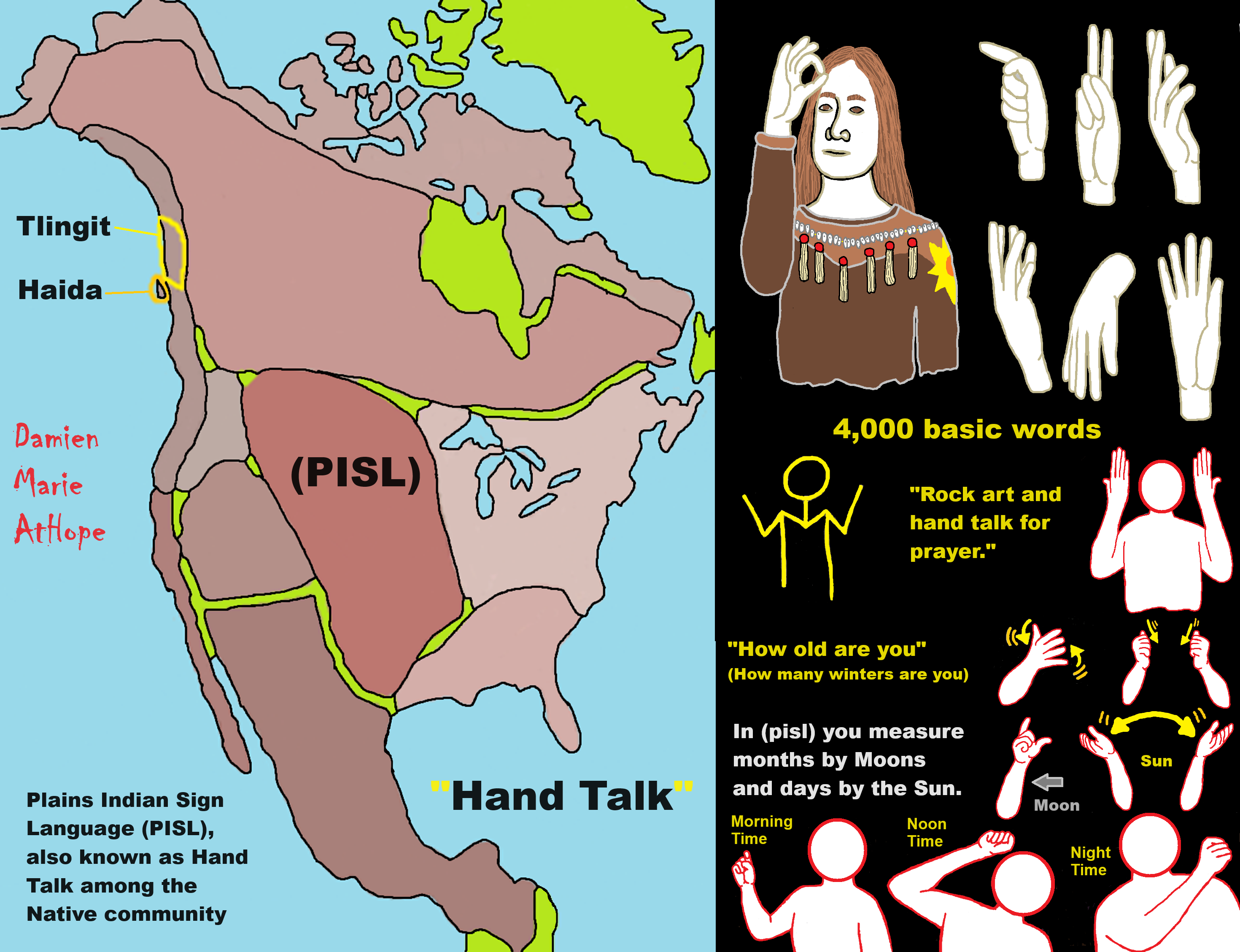
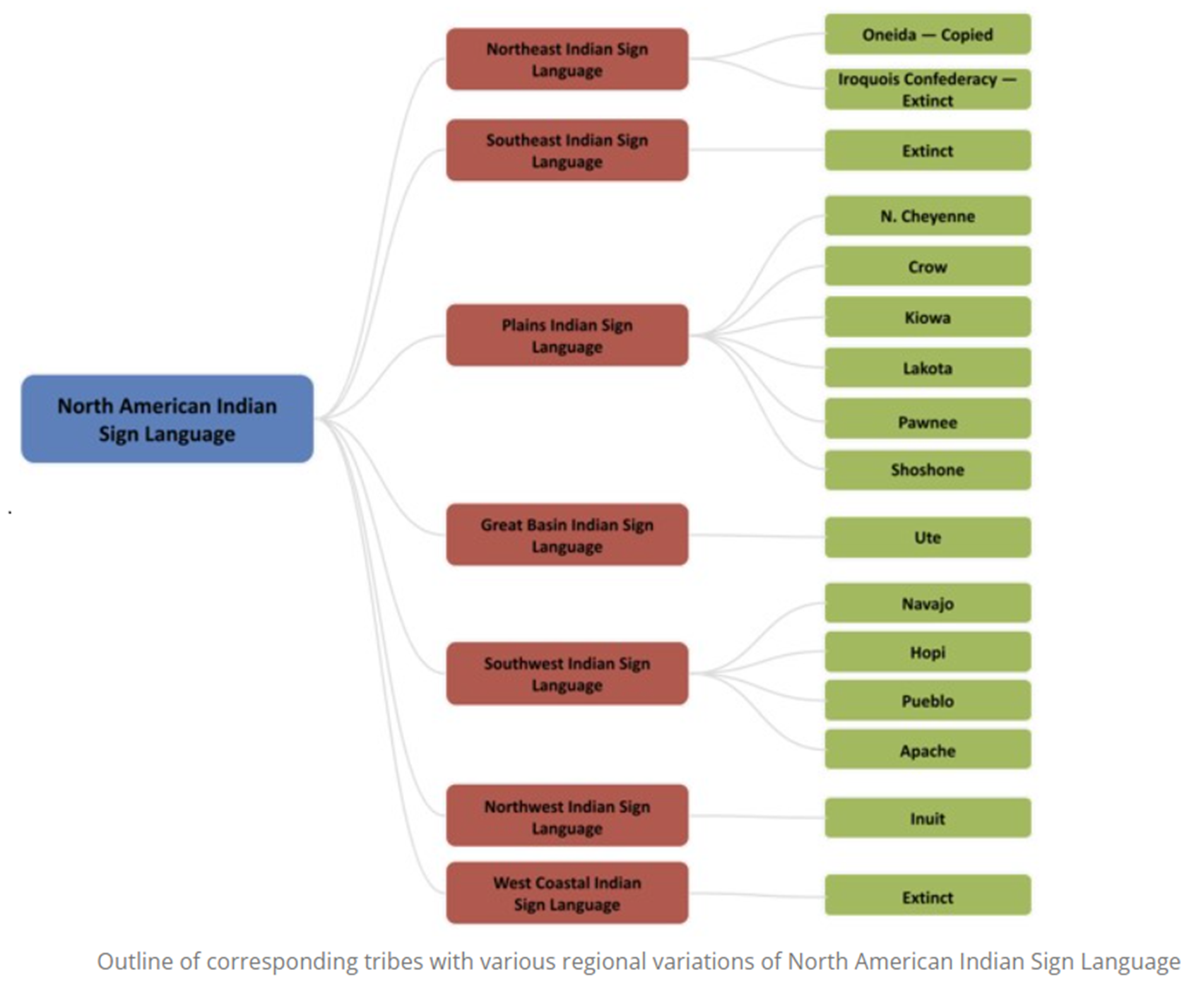
The hidden history of “Hand Talk” A North American lingua franca.
“Centuries before we had American Sign Language, Native sign languages, broadly known as “Hand Talk,” were thriving across North America. Hand Talk would be influential in the formation of American Sign Language, but it has largely been written out of history. One of these Hand Talk variations, Plains Indian Sign Language, was used so widely across the Great Plains that it became a lingua franca — a universal language used by both d/Deaf and hearing people to communicate among tribes that didn’t share a common spoken language.” ref
“At one point, tens of thousands of Indigenous people used Plains Indian Sign Language, or PISL, for everything from trade to hunting, conflict, storytelling, and rituals. But by the late 1800s, the federal government began to implement a policy that would change the course of Indigenous history forever: a boarding school program designed to forcibly assimilate Indigenous children into white American culture — a dark history that we’re still learning more about to this day.” ref
“Because of a forced “English-only” policy, the boarding school era is one of the main reasons the country lost so many Native signers — along with the eventual dominance of ASL in schools for the d/Deaf. Today, there are just a handful of fluent PISL signers left in the US. In the piece above, we hear from two of these signers, Melanie McKay-Cody and Lanny Real Bird, who have dedicated their lives to studying and revitalizing the language. They show us PISL in action and help us explore how this ancient language holds centuries of Indigenous history. This video is part of our award-winning series, Missing Chapter, now in its third season. You can watch more Missing Chapter episodes in this playlist.” ref
Native American Hand Talkers Fight to Keep Sign Language Alive
“In early September 1930, the Blackfeet Nation of Montana hosted a historic Indian Sign Language Grand Council, gathering leaders of a dozen North American Nations and language groups. The three-day council held was organized by Hugh L. Scott, a 77-year-old U.S. Army General who had spent a good portion of his career in the American West, where he observed and learned what users called Hand Talk, and what is today more broadly known as Plains Indian Sign Language (PISL). With $5,000 in federal funding, Scott filmed the proceedings and hoped to produce a film dictionary of more than 1,300 signs. He died before he could finish the project.” ref
“Scott’s films disappeared into the National Archives. Recently rediscovered, they are an important resource for those looking to revitalize PISL. Among them is Ron Garritson, who identifies himself as being of Choctaw and European heritage. He was raised in Billings, Montana, near the Crow Nation. “I learned how to speak Crow to a degree, and I was really interested in the sign language,” he said. “I saw it being used by the Elders, and I thought it was a beautiful form of communication. And so I started asking questions.” Garritson studied Scott’s films, along with works by other ethnographers and now has a vocabulary of about 1,700 signs. He conducts workshops and classes across Montana, in an effort to preserve and spread sign language and native history.” ref
Lingua franca
“Prior to contact with Europeans, North American Native peoples were not a unified culture, but hundreds of different cultures and tribes, each with its own political organization, belief system and language. When speakers of one language met those of another, whether in trade, councils or conflict, they communicated in the lingua franca of Hand Talk. Scholars dispute exactly when, in their 30,000-year history in North America, tribes developed sign language. It was observed among Florida tribes by 16th Century Spanish colonizers.” ref
“Coronado, as he documented in his journals in 1540, was in Texas and met the Comanche,” said Garritson. “He documented that the Comanches made themselves so well-understood with the use of sign talk that there was almost no need for an interpreter. It was that easy to use and easy to understand.” While each tribe had its own dialect, tribes were able to communicate easily. Though universal in North America, Hand Talk was more prominent among the nomadic Plains Nations.” ref
“There were fewer linguistic groups east of the Mississippi River,” said Garritson. “They were mostly woodland tribes, living in permanent villages and were familiar with each other’s languages. They still used sign language to an extent, but not like it was used out here.” Hand Talk was also the first language of deaf Natives. By the late 1800s, tens of thousands of Native Americans still used Hand Talk. That changed when the federal government instituted a policy designed to “civilize” tribal people.” ref
“Children were removed from their families and sent to government-run boarding schools, where they were forbidden to speak their own languages or practice their own spiritual beliefs. Native Deaf children were sent to deaf residential schools, where they were taught to use American Sign Language (ASL). Research has shown that Hand Talk is still being used by a small number of deaf and hearing descendants of the Plains Indian cultures.” ref
“Hand Talk is endangered and dying quickly,” said Melanie McKay-Cody, who identifies herself as Cherokee Deaf and is an expert in anthropological linguistics. McKay-Cody is the first deaf researcher to specialize in North American Hand Talk and today works with tribes to help them preserve their signed languages. She is pushing for PISL to be incorporated into mainstream education of the deaf.” ref
“Easier than hollering”
“Lanny Real Bird, who is Crow, Arikara and Hidatsa, grew up in a household where PISL was used. “My grandmother had hearing loss,” he said. “I’d see my father signing with her in the Plains Indian Sign Language. I picked up basic sign language, enough to say, ‘Yes’ or ‘No,’ ‘I’m hungry.” As a boy, he played with a young relative who was deaf, who helped expand his signing vocabulary.” ref
“Real Bird, a former instructor at Montana’s Little Big Horn College, has worked for 20 years helping tribes preserve their languages, both spoken and signed, and has developed a 400 to 600-sign PISL course, which he teaches at community schools and workshops across the Plains states. “Right now we’re probably at the basic communications phase,” he said. “So in order to expand, we have to go to another level, from listening to understanding to rudimentary communicating to fluency and literacy.” ref
“Real Bird said it took nearly a decade to convince school systems to incorporate PISL into general language instruction. “Later this month, students of the of the Crow Reservation’s Wyola Elementary School will be showcased at the annual Montana Indian Education Conference,” he said. There, they will demonstrate their Crow language skills, both spoken and signed.” ref
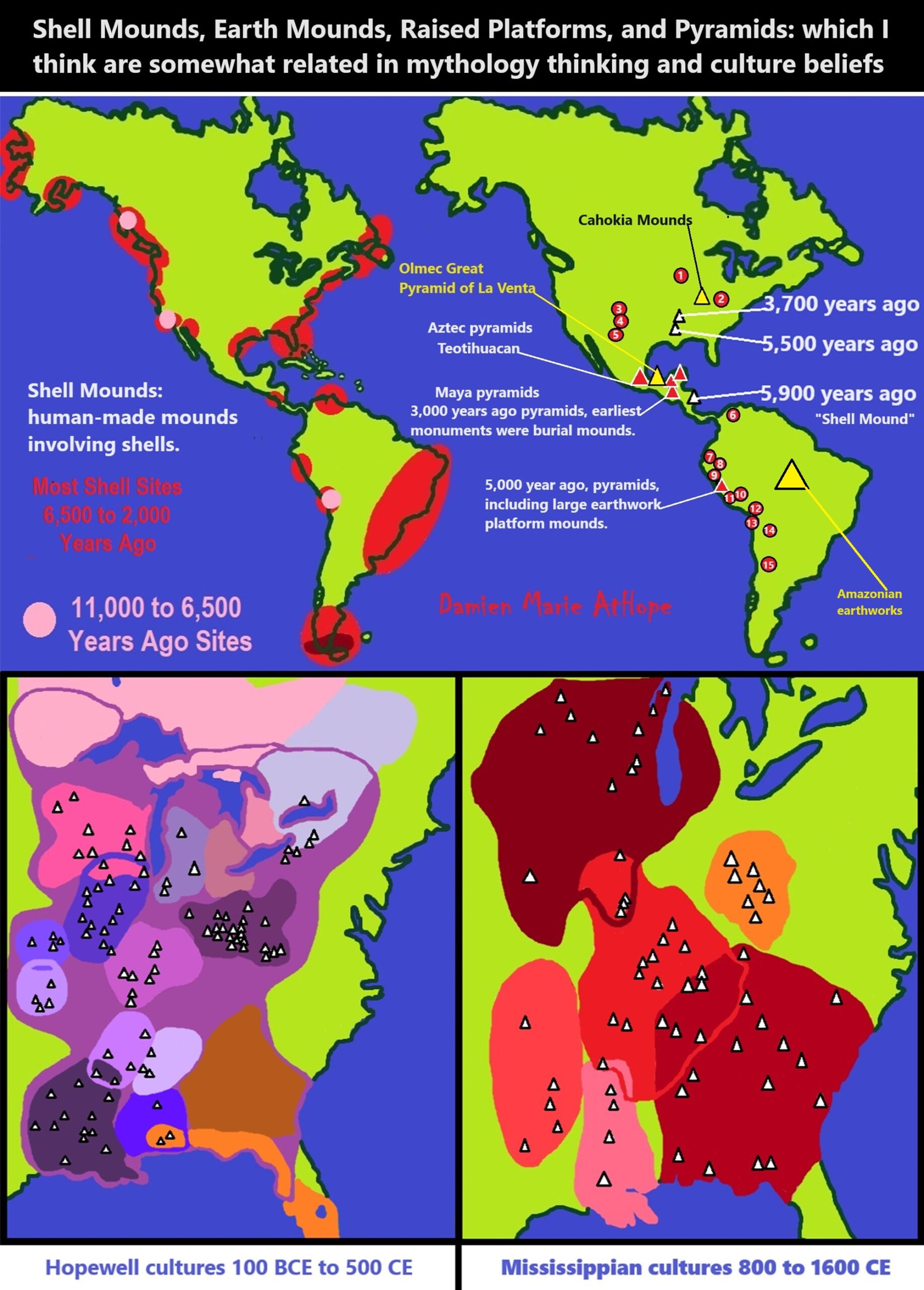
ref, ref, ref, ref, ref, ref, ref, ref, ref, ref, ref, ref, ref, ref, ref, ref, ref
- Medicine Wheel
- Serpent Mound
- Mesa Verde
- Chaco Canyon
- Casas Grandes/Paquime
- Ciudad Perdida “lost city”; Teyuna
- Ingapirca “Inca”
- Chavín de Huántar “pre-Inca”
- Sacred City of Caral-Supe *Caral culture developed between 3000 – 1800 BCE*
- Machu Picchu
- Nazca Lines
- Sacsayhuamán
- Tiwanaku/Tiahuanaco
- Atacama Giant/Lines
- Pucará de Tilcara “pre-Inca”
Mound Builders
“Many pre-Columbian cultures in North America were collectively termed “Mound Builders“, but the term has no formal meaning. It does not refer to specific people or archaeological culture but refers to the characteristic mound earthworks that indigenous peoples erected for an extended period of more than 5,000 years. The “Mound Builder” cultures span the period of roughly 3500 BCE (the construction of Watson Brake) to the 16th century CE, including the Archaic period (Horr’s Island), Woodland period (Caloosahatchee, Adena, and Hopewell cultures), and Mississippian period. Geographically, the cultures were present in the region of the Great Lakes, the Ohio River Valley, Florida, and the Mississippi River Valley and its tributary waters.” ref
“The first mound building was an early marker of political and social complexity among the cultures in the Eastern United States. Watson Brake in Louisiana, constructed about 3500 BCE during the Middle Archaic period, is the oldest known and dated mound complex in North America. It is one of 11 mound complexes from this period found in the Lower Mississippi Valley. These cultures generally had developed hierarchical societies that had an elite. These commanded hundreds or even thousands of workers to dig up tons of earth with the hand tools available, move the soil long distances, and finally, workers to create the shape with layers of soil as directed by the builders. However early mounds found in Louisiana preceded such cultures and were products of hunter-gatherer cultures.” ref
“Radiocarbon dating has established the age of the earliest Archaic mound complex in southeastern Louisiana. One of the two Monte Sano Site mounds, excavated in 1967 before being destroyed for new construction at Baton Rouge, was dated at 6220 BP (plus or minus 140 years). Researchers at the time thought that such hunter-gatherer societies were not organizationally capable of this type of construction. It has since been dated as about 6500 BP or 4500 BCE, although not all agree.” ref
“Watson Brake is located in the floodplain of the Ouachita River near Monroe in northern Louisiana. Securely dated to about 5,400 years ago (around 3500 BCE), in the Middle Archaic period, it consists of a formation of 11 mounds from 3 feet (0.91 m) to 25 feet (7.6 m) tall, connected by ridges to form an oval nearly 900 feet (270 m) across. In the Americas, the building of complex earthwork mounds started at an early date, well before the pyramids of Egypt were constructed. Watson Brake was being constructed nearly 2,000 years before the better-known Poverty Point, and the building continued for 500 years. Middle Archaic mound construction seems to have ceased about 2800 BCE. Scholars have not ascertained the reason, but it may have been because of changes in river patterns or other environmental factors.” ref
“With the 1990s dating of Watson Brake and similar complexes, scholars established that pre-agricultural, pre-ceramic American societies could organize to accomplish complex construction during extended periods, invalidating scholars’ traditional ideas of Archaic society. Watson Brake was built by a hunter-gatherer society, the people of which occupied this area only on a seasonal basis. Successive generations organized to build the complex mounds over 500 years. Their food consisted mostly of fish and deer, as well as available plants.” ref
“Poverty Point, built about 1500 BCE in what is now Louisiana, is a prominent example of Late Archaic mound-builder construction (around 2500 BCE – 1000 BCE). It is a striking complex of more than 1 square mile (2.6 km2), where six earthwork crescent ridges were built in concentric arrangement, interrupted by radial aisles. Three mounds are also part of the main complex, and evidence of residences extends for about 3 miles (4.8 km) along the bank of Bayou Macon. It is the major site among 100 associated with the Poverty Point culture and is one of the best-known early examples of earthwork monumental architecture. Unlike the localized societies during the Middle Archaic, this culture showed evidence of a wide trading network outside its area, which is one of its distinguishing characteristics.” ref
“Horr’s Island, Florida, now a gated community next to Marco Island, was excavated by Michael Russo in 1980. He found an Archaic Indian village site. Mound A was a burial mound that dated to 3400 BCE, making it the oldest known burial mound in North America.” ref
“From about 800 CE, the mound-building cultures were dominated by the Mississippian culture, a large archaeological horizon, whose youngest descendants, the Plaquemine culture and the Fort Ancient culture, were still active at the time of European contact in the 16th century. One tribe of the Fort Ancient culture has been identified as the Mosopelea, presumably of southeast Ohio, who spoke an Ohio Valley Siouan language. The bearers of the Plaquemine culture were presumably speakers of the Natchez language isolate. The first written description of these cultures were made by members of Spanish explorer Hernando de Soto‘s expedition, between 1540 and 1542.” ref
“The namesake cultural trait of the Mound Builders was the building of mounds and other earthworks. These burial and ceremonial structures were typically flat-topped pyramids or platform mounds, flat-topped or rounded cones, elongated ridges, and sometimes a variety of other forms. They were generally built as part of complex villages. The early earthworks built in Louisiana around 3500 BCE are the only ones known to have been built by a hunter-gatherer culture, rather than a more settled culture based on agricultural surpluses.” ref
“The best-known flat-topped pyramidal structure is Monks Mound at Cahokia, near present-day Collinsville, Illinois. This community was the center of the Mississippian culture. This mound appears to have been the main ceremonial and residential mound for the religious and political leaders; it is more than 100 feet (30 m) tall and is the largest pre-Columbian earthwork north of Mexico. This site had numerous mounds, some with conical or ridge tops, as well as palisaded stockades protecting the large settlement and elite quarter. At its maximum about 1150 CE, Cahokia was an urban settlement with 20,000–30,000 people. This population was not exceeded by North American European settlements until after 1800.” ref
“Some effigy mounds were constructed in the shapes or outlines of culturally significant animals. The most famous effigy mound, Serpent Mound in southern Ohio, ranges from 1 foot (0.30 m) to just over 3 feet (0.91 m) tall, 20 feet (6.1 m) wide, more than 1,330 feet (410 m) long, and shaped as an undulating serpent.” ref
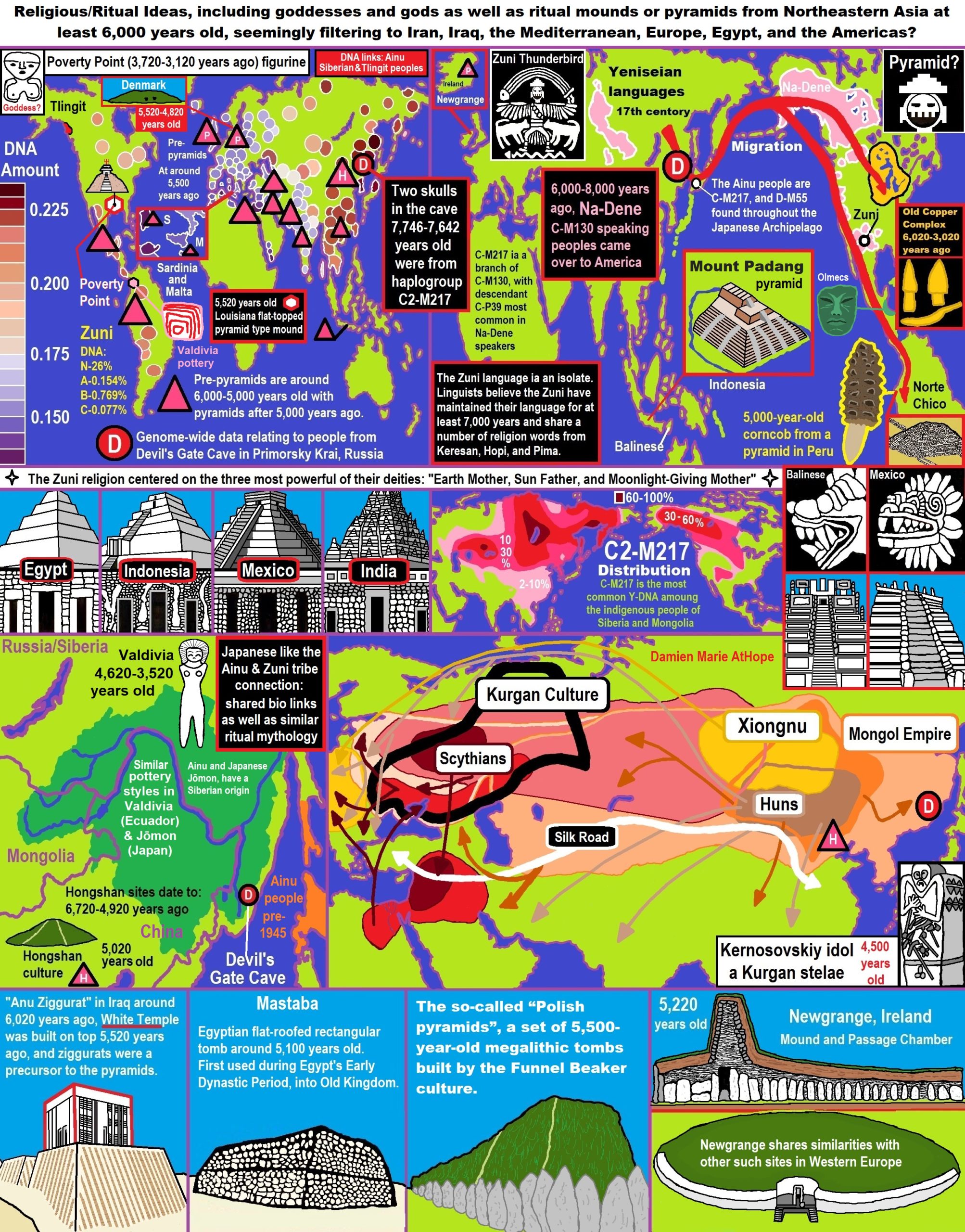
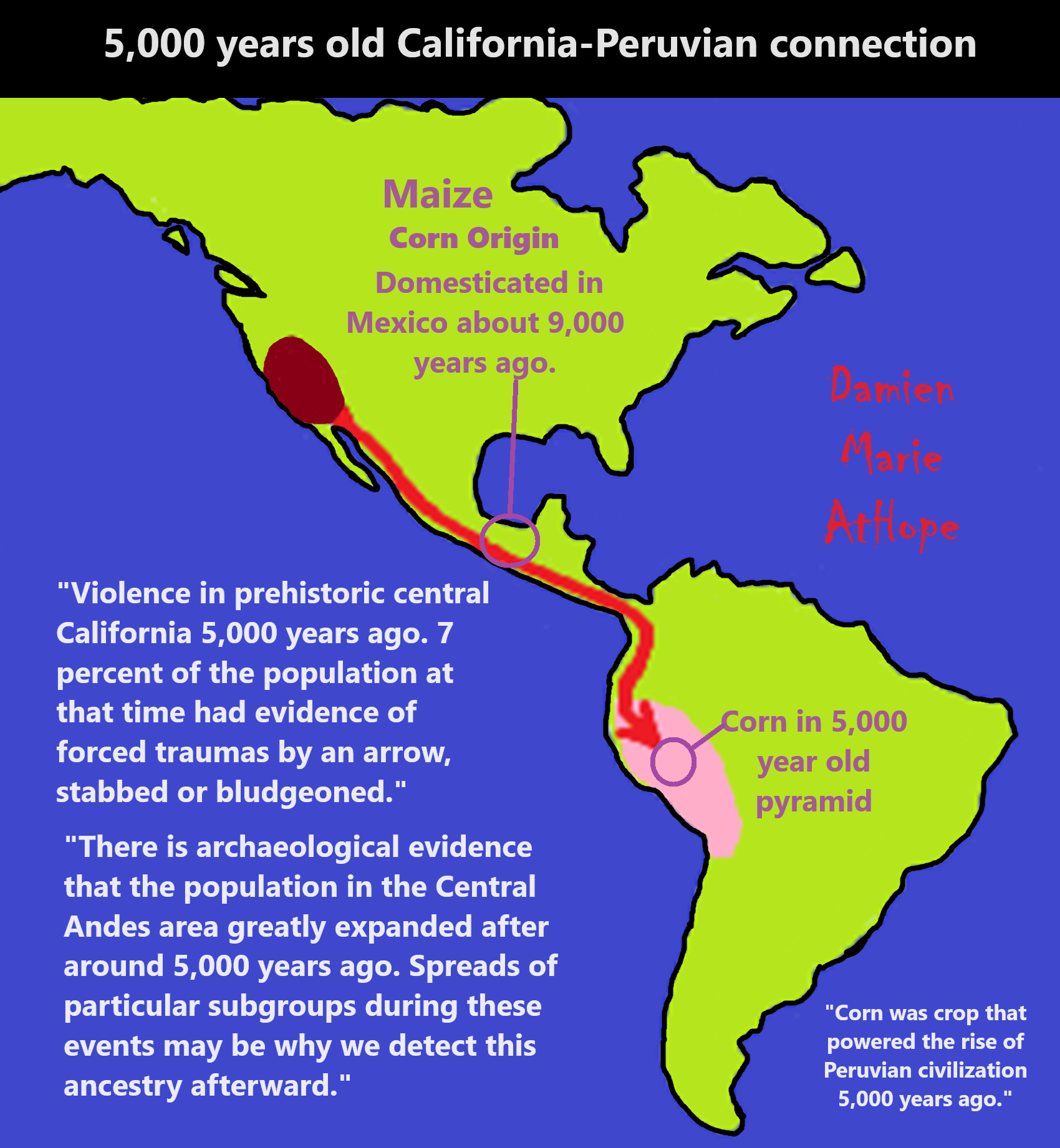
California-Peruvian connection
“The Cell study also revealed a surprising connection between ancient people living in California’s Channel Islands and the southern Peruvian Andes at least 4,200 years ago. It appears that these two geographically distant groups have a shared ancestry, the researchers found. It’s unlikely that people living in the Channel Islands actually traveled south to Peru, the researchers said. Rather, it’s possible that these groups’ ancestors sallied forth thousands of years earlier, with some ending up in the Channel Islands and others in South America. But those genes didn’t become common in Peru until much later, around 4,200 years ago, when the population may have exploded, the researchers said. It could be that this ancestry arrived in South America thousands of years before and we simply don’t have earlier individuals showing it,” study co-lead researcher Nathan Nakatsuka, a research assistant in the Reich lab at Harvard Medical School, said in the statement. “There is archaeological evidence that the population in the Central Andes area greatly expanded after around 5,000 years ago. Spreads of particular subgroups during these events may be why we detect this ancestry afterward.” ref
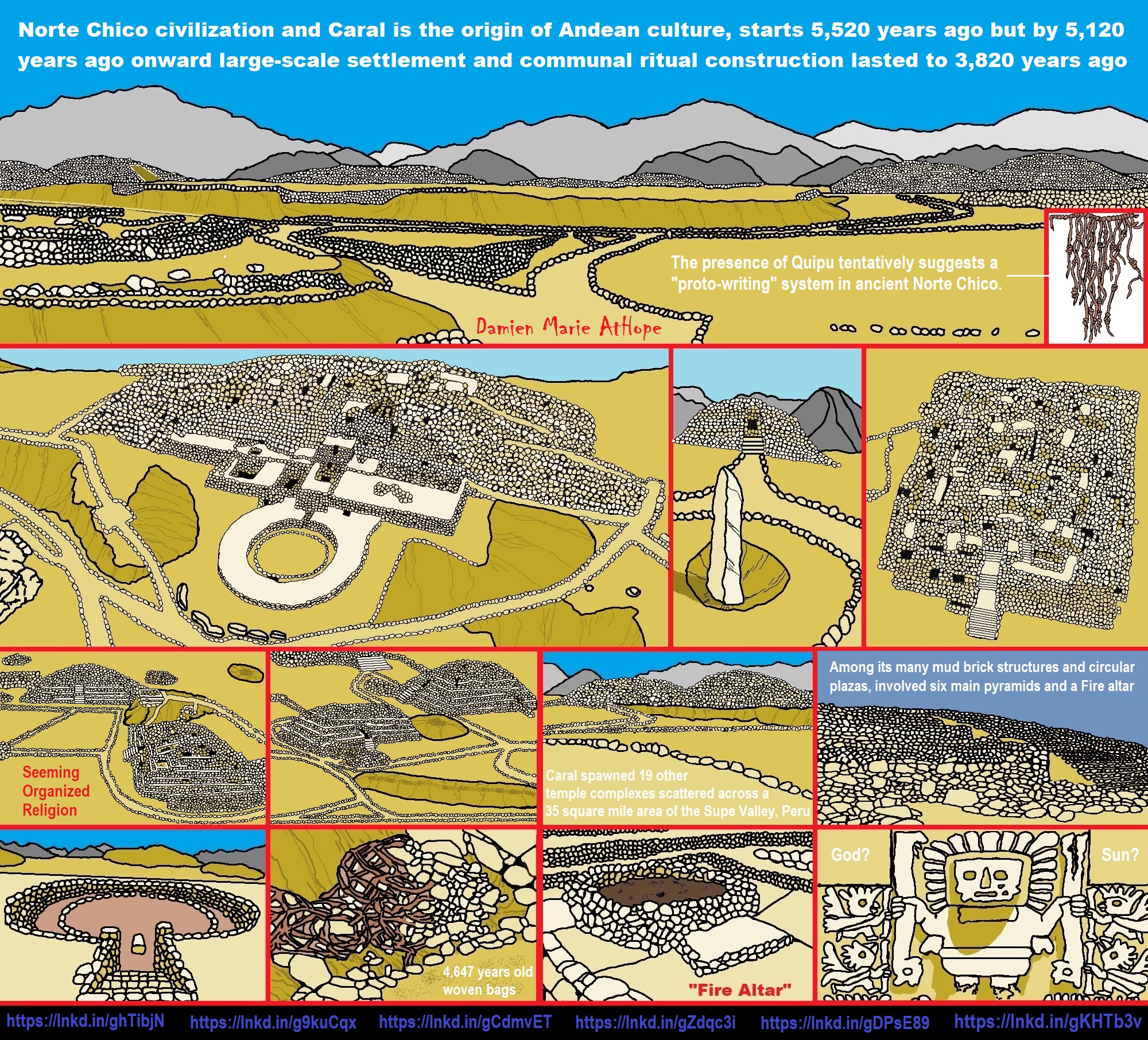

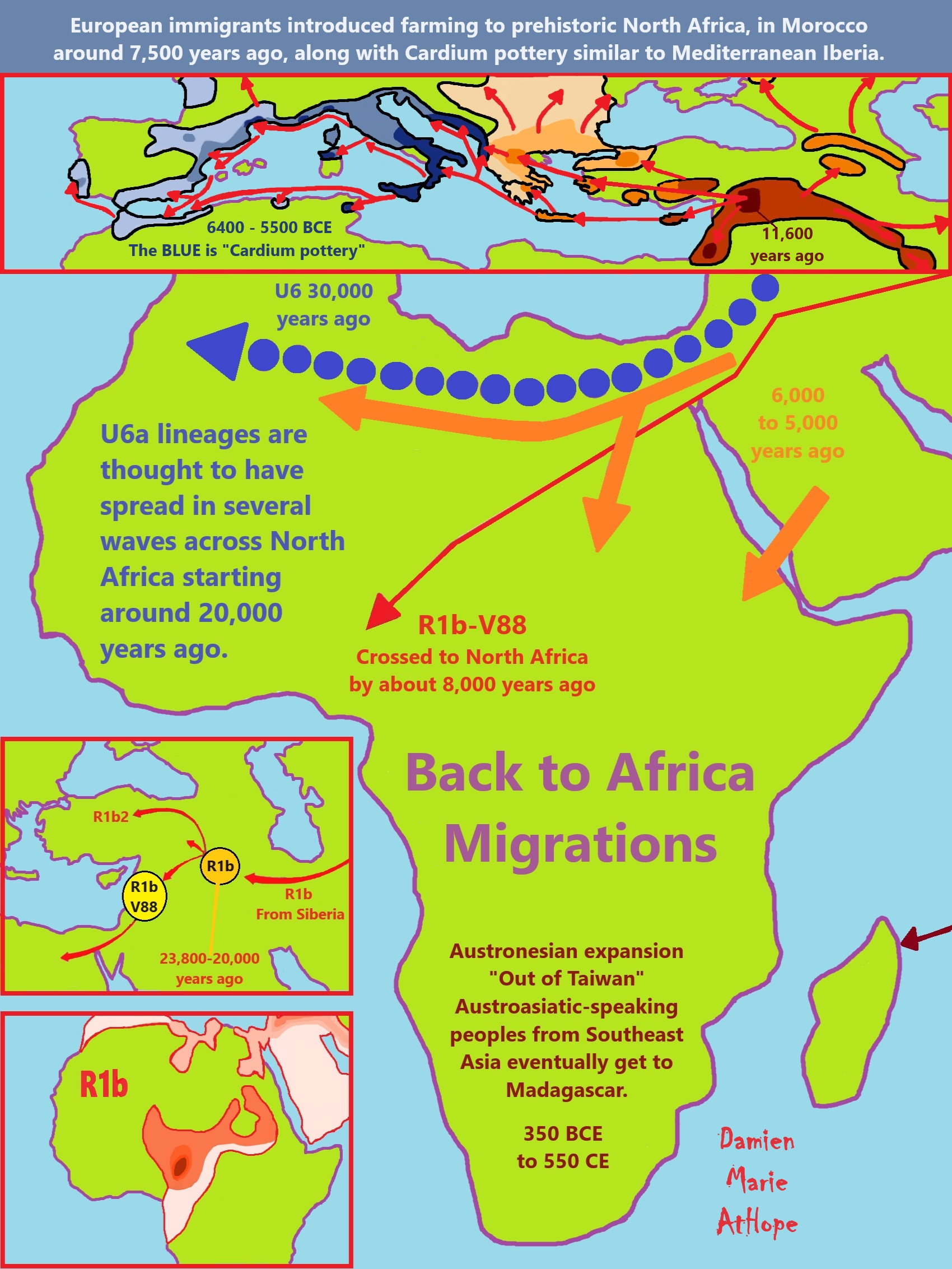
African Back Migrations and the Status of Shamanism Origins as well as its Spreading
“Various DNA studies have found Christian-era and modern Nubians along with modern Afro-Asiatic speaking populations in the Horn of Africa to be descended from a mix of West Eurasian and East African populations.” ref
“The results showed that King Tut belonged to a genetic profile group, known as haplogroup R1b1a2, to which more than 50 percent of all men in Western Europe belong, indicating that they share a common ancestor. Among modern-day Egyptians this haplogroup contingent is below 1 percent, according to iGENEA. Up to 70 percent of British men and half of all Western European men are related to the Egyptian Pharaoh Tutankhamun, geneticists in Switzerland said.” ref
“A 2020 study by Gad, Hawass, et al. analyzed mitochondrial and Y-chromosomal haplogroups from Tutankhamun‘s family members of the 18th Dynasty, using comprehensive control procedures to ensure quality results. The study found that the Y-chromosome haplogroup of the family was R1b. Haplogroup R1b is carried by modern Egyptians. Modern Egypt is also the only African country that is known to harbor all three R1 subtypes, including R1b-M269. The Y-chromosome profiles for Tutankhamun and Amenhotep III were incomplete and the analysis produced differing probability figures despite having concordant allele results. Because the relationships of these two mummies with the KV55 mummy (identified as Akhenaten) had previously been confirmed in an earlier study, the haplogroup prediction of both mummies could be derived from the full profile of the KV55 data.” ref
“Genetic analysis indicated the following haplogroups for the 18th Dynasty:
- Amenhotep III: YDNA R1b& mtDNA H2b.
- Tutankhamun: YDNA R1b & mtDNA K.
- Akhenaten: YDNA R1b & mtDNA K.
- Tiye: mtDNA K.
- Yuya: YDNA G2a& mtDNA K.
- Thuya: mtDNA K.
Both Y-DNA haplogroups R1b and G2a, as well as both mtDNA haplogroups H and K, are carried by modern Egyptians.” ref
“In 2020, three mummies, dating from the 1st millennium BCE, from the Pushkin Museum of Arts collection were tested at the Kurchatov Institute of Moscow for their mitochondrial and Y-chromosomal haplogroups. Two of the mummies were found to belong to the Y-chromosomal haplogroup R1b1a1b (R1b-M269), which originated either in Eastern Europe or in the Near East, and to the Y-chromosome haplogroup E1b1b1a1b2a4b5a, which originated in North Africa. They also belonged to mtDNA haplogroups L3h1 and N5, common in Africans and Middle Easterners, respectively. The third mummy was found to belong to mtDNA haplogroup N, which is widely distributed across Eurasia as well as eastern and northeastern Africa.” ref
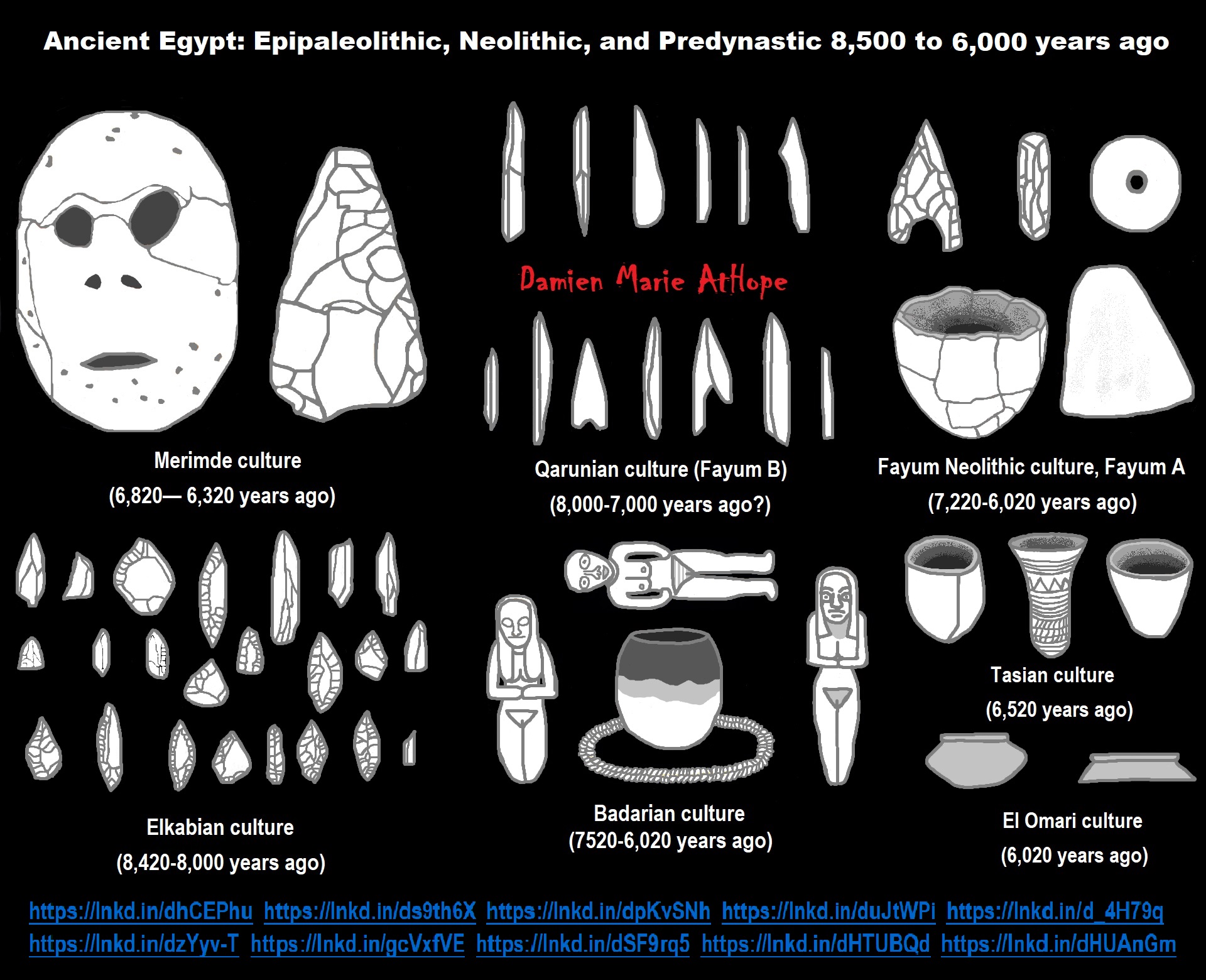
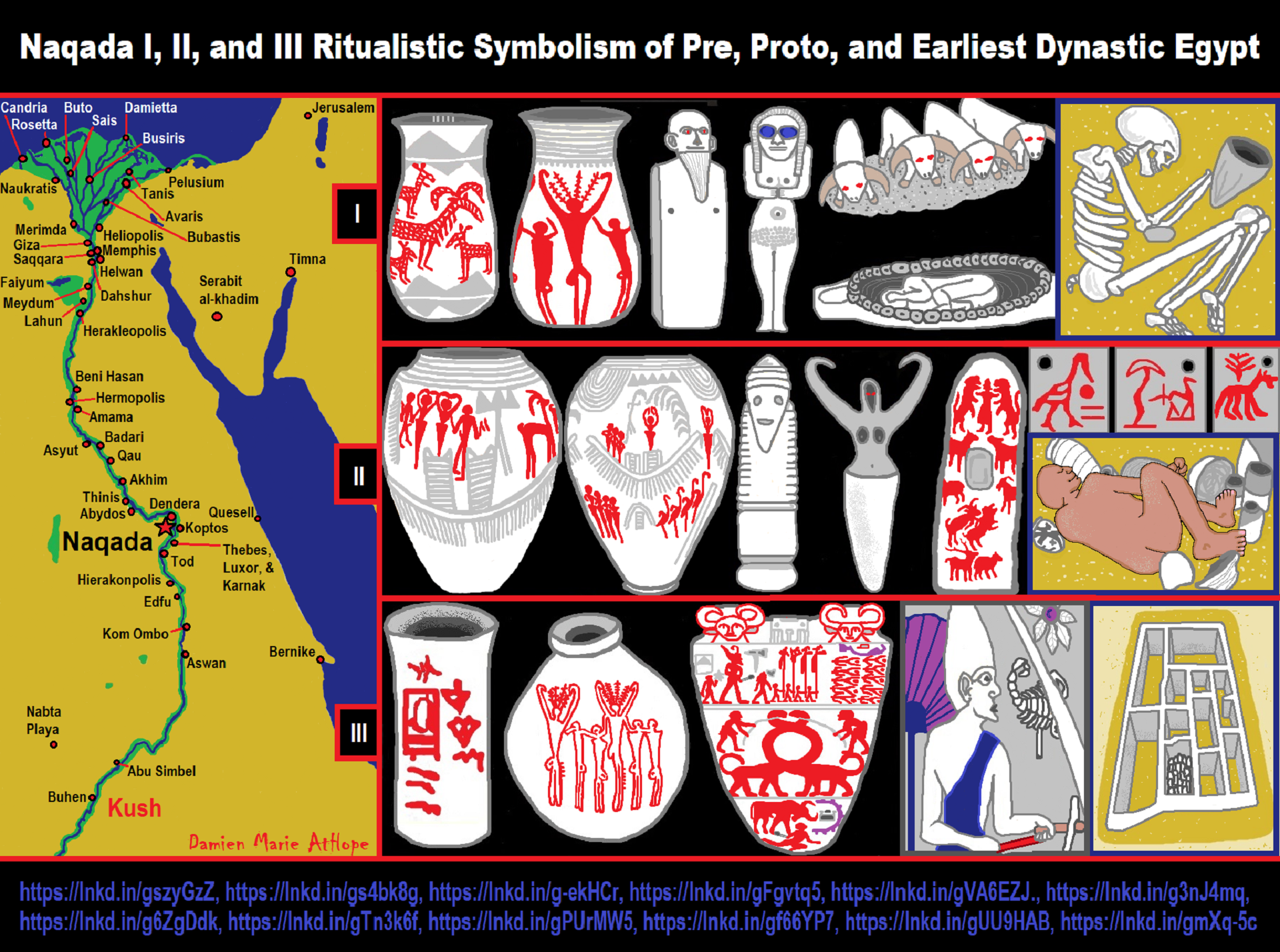
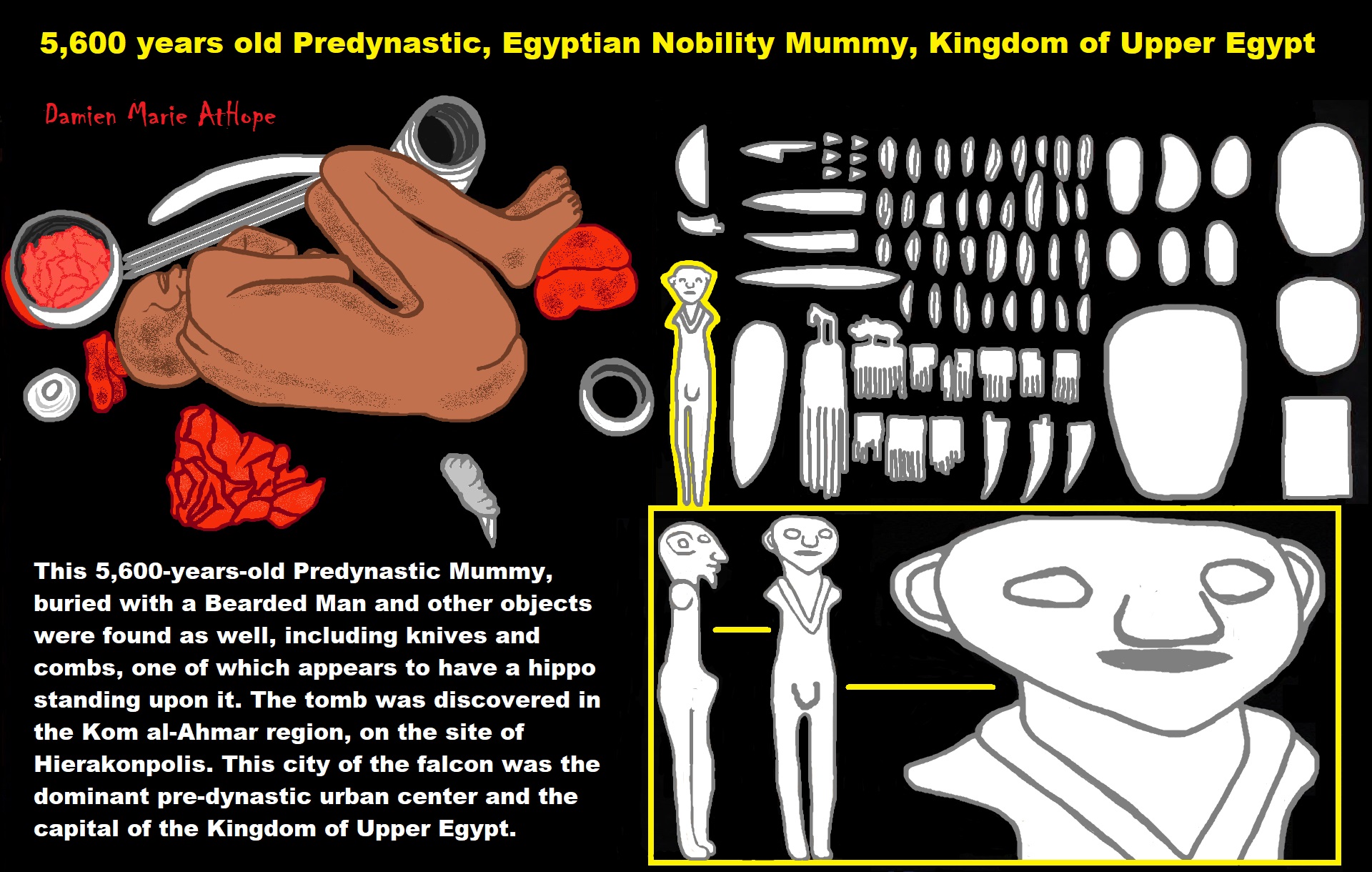


ref, ref, ref, ref, ref, ref, ref, ref, ref, ref, ref, ref
Masseboth similar but much smaller than a European Menhir, dates to around 13,000-11,000 years ago in the Near East. Kurgan a burial mound over a timber burial chamber, dates to around 7,000/6,000 years ago. Dolmen a single-chamber ritual megalith, dates to around 7,000/6,000 years ago. Ziggurat a multi-platform temple around 4,900 years ago. Pyramid a multi-platform tomb, dates to around 4,700 years ago. #3 is a Step Pyramid (or proto pyramid) for the burial of Pharaoh Djoser it went through several revisions and redevelopments. First are three layers of Mastaba “house of eternity” a flat-roofed rectangular structure, then two step pyramid one on top the other, showing the evolution of ideas.
Is there a connection between Dolmans/Kurgans and Ziggurats/Pyramids?
Ziggurat “Step Pyramid-like” mound
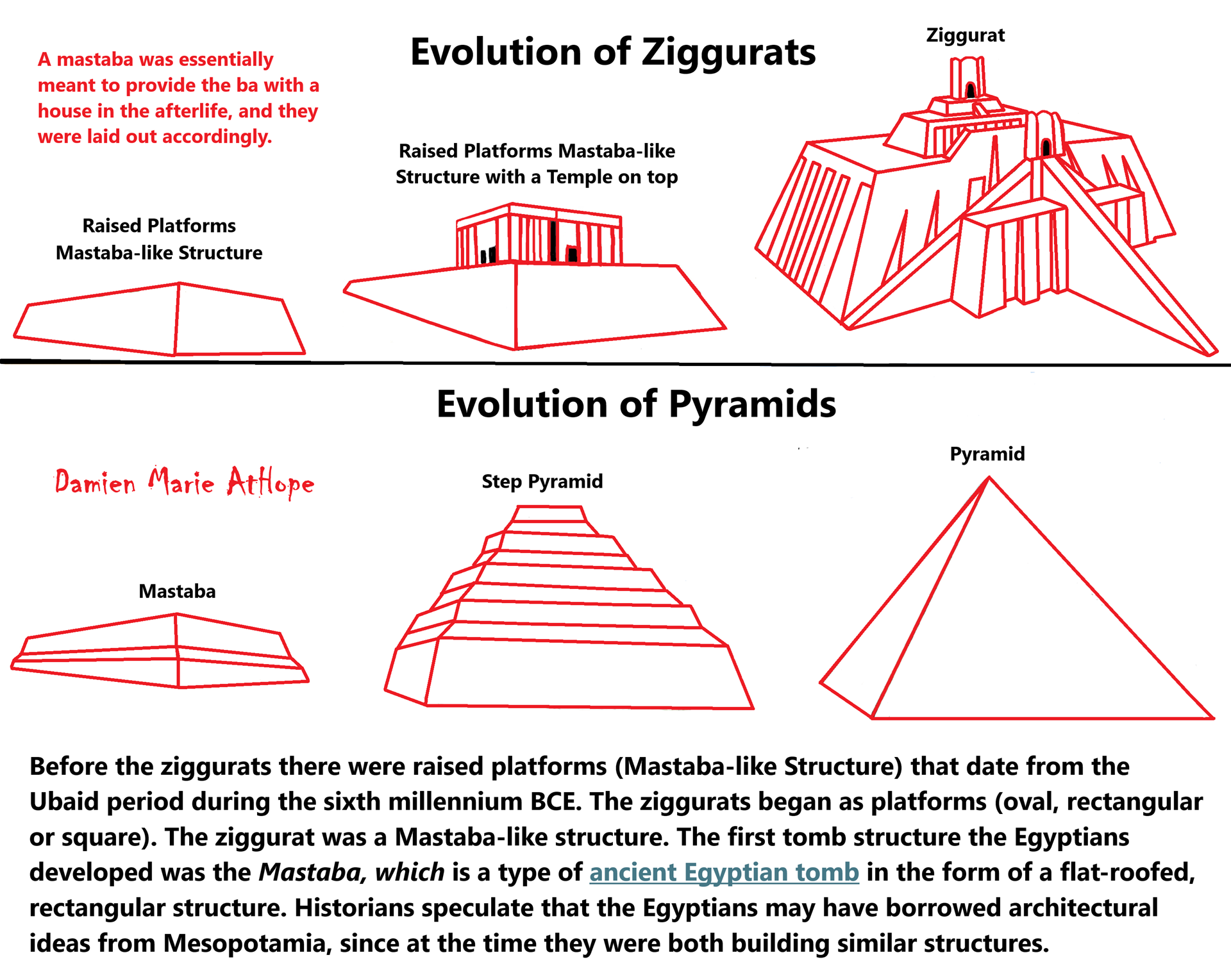
“Before the ziggurats there were raised platforms (Mastaba-like Structure) that date from the Ubaid period during the sixth millennium BCE. The ziggurats began as platforms (oval, rectangular, or square). The ziggurat was a Mastaba-like structure. The first tomb structure the Egyptians developed was the Mastaba, which is a type of ancient Egyptian tomb in the form of a flat-roofed, rectangular structure. Historians speculate that the Egyptians may have borrowed architectural ideas from Mesopotamia since, at the time, they were both building similar structures.” ref, ref
“A mastaba is a type of ancient Egyptian tomb in the form of a flat-roofed, rectangular structure with inward sloping sides, constructed out of mudbricks or limestone. These edifices marked the burial sites of many eminent Egyptians during Egypt’s Early Dynastic Period and Old Kingdom. Non-royal use of mastabas continued for over a thousand years. The Ancient Egyptian name was pr-Djt, meaning “house of stability,” “house of eternity,” or “eternal house.” The afterlife was centralized in the religion of ancient Egyptians. Their architecture reflects this, most prominently by the enormous amounts of time and labor involved in building tombs. Ancient Egyptians believed that the needs from the world of the living would be continued in the afterlife; it was therefore necessary to build tombs that would fulfill them, and be sturdy enough to last for an eternity. These needs would also have to be attended to by the living.” ref
“Starting in the Predynastic era (before 3100 BCE or around 5,100 years ago) and continuing into later dynasties, the ancient Egyptians developed increasingly complex and effective methods for preserving and protecting the bodies of the dead. They first buried their dead in pit graves dug from the sand with the body placed on a mat, usually along with some items believed to help them in the afterlife. The first tomb structure the Egyptians developed was the mastaba, composed of earthen bricks made from soil along the Nile. It provided better protection from scavenging animals and grave robbers. The origins of the mastaba can be seen in Tarkhan, where tombs would be split into two distinct portions. One side would contain a body, oriented in a north-south position, and the other would be open for the living to deliver offerings. As the remains were not in contact with the dry desert sand, natural mummification could not take place; therefore, the Egyptians devised a system of artificial mummification. Until at least the Old Period or First Intermediate Period, only high officials and royalty were buried in these mastabas.” ref
“The above-ground structure of a mastaba is rectangular in shape with inward-sloping sides and a flat roof. The exterior building materials were initially bricks made of the sun-dried mud readily available from the Nile River. Even after more durable materials such as stone came into use, the majority were built from mudbricks. Monumental mastabas, such as those at Saqqara, were often constructed out of limestone. Mastabas were often about four times as long as they were wide, and many rose to at least 10 meters (30 ft) in height. They were oriented north–south, which the Egyptians believed was essential for access to the afterlife. The roofs of the mastabas were of slatted wood or slabs of limestone, with skylights illuminating the tomb. The above-ground structure had space for a small offering chapel equipped with a false door. Priests and family members brought food and other offerings for the soul, or ba, of the deceased, which had to be maintained in order to continue to exist in the afterlife. The construction of mastabas was standardized, with several treatments being common for masonry.” ref
“Mastabas were highly decorated, both with paintings on the walls and ceilings, and carvings of organic elements such as palm trees out of limestone. Due to the spiritual significance of the color, it was preferable to construct mastabas from white limestone. If this was not available, the yellow limestone or mudbrick of the tomb would be whitewashed and plastered. Mastabas for royalty were especially extravagant on the exterior, meant to resemble a palace. The mastaba was the standard type of tomb in pre-dynastic and early dynastic Egypt for both the pharaoh and the social elite. The ancient city of Abydos was the location chosen for many of the cenotaphs. The royal cemetery was at Saqqara, overlooking the capital of early times, Memphis. Mastabas evolved over the early dynastic period (c. 3100–2686 BCE). During the 1st Dynasty, a mastaba was constructed simulating house plans of several rooms, a central one containing the sarcophagus and others surrounding it to receive the abundant funerary offerings. The whole was built in a shallow pit above which a brick superstructure covering a broad area.” ref
“The typical 2nd and 3rd Dynasty (c. 2686–2313) mastabas was the ‘stairway mastaba’, the tomb chamber of which sank deeper than before and was connected to the top with an inclined shaft and stairs. Many of the features of mastabas grew into those of the pyramids, indicating their importance as a transitory construction of tombs. This notably includes the exterior appearance of the tombs, as the sloped sides of the mastabas extended to form a pyramid. The first and most striking example of this was Djoser’s step pyramid, which combined many traditional features of mastabas with a more monumental stone construction. Even after pyramids became more prevalent for pharaohs in the 3rd and 4th Dynasties, members of the nobility continued to be buried in mastaba tombs. This is especially evident on the Giza Plateau, where at least 150 mastaba tombs have been constructed alongside the pyramids.” ref
“A ziggurat (/ˈzɪɡʊˌræt/; Cuneiform: 𒅆𒂍𒉪, Akkadian: ziqqurratum, D-stem of zaqārum ‘to protrude, to build high’, cognate with other Semitic languages like Hebrew zaqar (זָקַר) ‘protrude’) is a type of massive structure built in ancient Mesopotamia. It has the form of a terraced compound of successively receding stories or levels. Notable ziggurats include the Great Ziggurat of Ur near Nasiriyah, the Ziggurat of Aqar Quf near Baghdad, the no longer extant Etemenanki in Babylon, Chogha Zanbil in Khūzestān and Sialk. The Sumerians believed that the gods lived in the temple at the top of the ziggurats, so only priests and other highly-respected individuals could enter. Sumerian society offered these individuals such gifts as music, harvested produce, and the creation of devotional statues to entice them to live in the temple. The word ziggurat comes from ziqqurratum (height, pinnacle), in ancient Assyrian. From zaqārum, to be high up. The Ziggurat of Ur is a Neo-Sumerian ziggurat built by King Ur-Nammu, who dedicated it in honor of Nanna/Sîn in approximately the 21st century BCE during the Third Dynasty of Ur.” ref
“Ziggurats were built by ancient Sumerians, Akkadians, Elamites, Eblaites, and Babylonians for local religions. Each ziggurat was part of a temple complex with other buildings. Before the ziggurats there were raised platforms that date from the Ubaid period during the sixth millennium BCE. The ziggurats began as platforms (usually oval, rectangular or square). The ziggurat was a mastaba-like structure with a flat top. The sun-baked bricks made up the core of the ziggurat with facings of fired bricks on the outside. Each step was slightly smaller than the step below it. The facings were often glazed in different colors and may have had astrological significance. Kings sometimes had their names engraved on these glazed bricks. The number of floors ranged from two to seven.” ref
“Access to the shrine would have been by a series of ramps on one side of the ziggurat or by a spiral ramp from base to summit. The Mesopotamian ziggurats were not places for public worship or ceremonies. They were believed to be dwelling places for the gods, and each city had its own patron god. Only priests were permitted on the ziggurat or in the rooms at its base, and it was their responsibility to care for the gods and attend to their needs. The priests were very powerful members of Sumerian and Assyro-Babylonian society. One of the best-preserved ziggurats is Chogha Zanbil in western Iran. The Sialk ziggurat, in Kashan, Iran, is the oldest known ziggurat, dating to the early 3rd millennium BCE. Ziggurat designs ranged from simple bases upon which a temple sat, to marvels of mathematics and construction which spanned several terraced stories and were topped with a temple.” ref
“An example of a simple ziggurat is the White Temple of Uruk, in ancient Sumer. The ziggurat itself is the base on which the White Temple is set. Its purpose is to get the temple closer to the heavens, and provide access from the ground to it via steps. The Mesopotamians believed that these pyramid temples connected heaven and earth. In fact, the ziggurat at Babylon was known as Etemenanki, which means “House of the foundation of heaven and earth” in Sumerian. The date of its original construction is unknown, with suggested dates ranging from the fourteenth to the ninth century BCE, with textual evidence suggesting it existed in the second millennium. Unfortunately, not much of even the base is left of this massive structure, yet archeological findings and historical accounts put this tower at seven multicolored tiers, topped with a temple of exquisite proportions. The temple is thought to have been painted and maintained an indigo color, matching the tops of the tiers. It is known that there were three staircases leading to the temple, two of which (side flanked) were thought to have only ascended half the ziggurat’s height.” ref
“According to Herodotus, at the top of each ziggurat was a shrine, although none of these shrines has survived. Functionally, ziggurats offered a high place on which priests could escape rising water that annually inundated lowlands and occasionally flooded for hundreds of kilometres. They also offered security; since the shrine was accessible only by way of three stairways, a small number of guards could prevent non-priests from spying on the rituals at the shrine on top of the ziggurat, such as initiation rituals like the Eleusinian mysteries, cooking of sacrificial food and burning of sacrificial animals. Each ziggurat was part of a temple complex that included a courtyard, storage rooms, bathrooms, and living quarters, around which a city spread, as well as a place for the people to worship. It was also a sacred structure.” ref
“According to archaeologist Harriet Crawford,
It is usually assumed that the ziggurats supported a shrine, though the only evidence for this comes fromHerodotus, and physical evidence is non-existent … The likelihood of such a shrine ever being found is remote. Erosion has usually reduced the surviving ziggurats to a fraction of their original height, but textual evidence may yet provide more facts about the purpose of these shrines. In the present state of our knowledge it seems reasonable to adopt as a working hypothesis the suggestion that the ziggurats developed out of the earlier temples on platforms and that small shrines stood on the highest stages …” ref
“The biblical account of the Tower of Babel has been associated by modern scholars to the massive construction undertakings of the ziggurats of Mesopotamia, and in particular to the ziggurat of Etemenanki in Babylon in light of the Tower of Babel Stele describing its restoration by Nebuchadnezzar II. According to some historians, the design of Egyptian pyramids, especially the stepped designs of the oldest pyramids (Pyramid of Zoser at Saqqara, 2600 BCE or around 4,600 years ago), may have been an evolution from the ziggurats built in Mesopotamia. Others say the Pyramid of Zoser and the earliest Egyptian pyramids may have been derived locally from the bench-shaped mastaba tomb. A mound is a heaped pile of earth, gravel, sand, rocks, or debris. Most commonly, mounds are earthen formations such as hills and mountains, particularly if they appear artificial. A mound may be any rounded area of topographically higher elevation on any surface. Artificial mounds have been created for a variety of reasons throughout history, including habitation (see Tell and Terp), ceremonial (platform mound), burial (tumulus), and commemorative purposes (e.g. Kościuszko Mound).” ref, ref
“In the archaeology of the United States and Canada, a mound is a deliberately constructed elevated earthen structure or earthwork, intended for a range of potential uses. In European and Asian archaeology, the word “tumulus” may be used as a synonym for an artificial hill, particularly if the hill is related to particular burial customs. While the term “mound” may be applied to historic constructions, most mounds in the United States are pre-Columbian earthworks, built by Native American peoples. Native Americans built a variety of mounds, including flat-topped pyramids or cones known as platform mounds, rounded cones, and ridge or loaf-shaped mounds. Some mounds took on unusual shapes, such as the outline of cosmologically significant animals. These are known as effigy mounds. Some mounds, such as a few in Wisconsin, have rock formations, or petroforms within them, on them, or near them.” ref
“While these mounds are perhaps not as famous as burial mounds, like their European analogs, Native American mounds also have a variety of other uses. While some prehistoric cultures, like the Adena culture, used mounds preferentially for burial, others used mounds for other ritual and sacred acts, as well as for secular functions. The platform mounds of the Mississippian culture, for example, may have supported temples, the houses of chiefs, council houses, and may have also acted as a platform for public speaking. Other mounds would have been part of defensive walls to protect a certain area. The Hopewell culture used mounds as markers of complex astronomical alignments related to ceremonies. Mounds and related earthworks are the only significant monumental construction in pre-Columbian Eastern and Central North America. peoples. Mounds are given different names depending on which culture they strive from. They can be located all across the world in spots such as Asia, Europe and the Americas. “Mound builders” have more commonly been associated with the mounds in the Americas. They all have different meanings and sometimes are constructed as animals and can be clearly seen from aerial views.” ref
“A step pyramid or stepped pyramid is an architectural structure that uses flat platforms, or steps, receding from the ground up, to achieve a completed shape similar to a geometric pyramid. Step pyramids are structures that characterized several cultures throughout history in several locations throughout the world. These pyramids typically are large and made of several layers of stone. The term refers to pyramids of similar design that emerged separately from one another, as there are no firmly established connections between the different civilizations that built them:
Pyramids are found in Mesopotamia, Africa, Egypt, Europe, the Americas, Asia, and Oceania
“A pyramid (from Ancient Greek πυραμίς (puramís) ‘pyramid’) is a structure whose visible surfaces are triangular in broad outline and converge toward the top, making the appearance roughly a pyramid in the geometric sense. The base of a pyramid can be of any polygon shape, such as triangular or quadrilateral, and its lines either filled or step. A pyramid has the majority of its mass closer to the ground with less mass towards the pyramidion at the apex. This is due to the gradual decrease in the cross-sectional area along the vertical axis with increasing elevation. This offers a weight distribution that allowed early civilizations to create monumental structures. Civilizations in many parts of the world have built pyramids. The largest pyramid by volume is the Mesoamerican Great Pyramid of Cholula, in the Mexican state of Puebla. For millennia, the largest structures on Earth were pyramids—first the Red Pyramid in the Dashur Necropolis and then the Great Pyramid of Khufu, both in Egypt—the latter is the only extant example of the Seven Wonders of the Ancient World.” ref
“The most famous African pyramids are in Egypt — huge structures built of bricks or stones, primarily limestone, some of which are among the world’s largest constructions. They are shaped in reference to the sun’s rays. Most had a smoothed white limestone surface. Many of the facing stones have fallen or were removed and used for construction in Cairo. The capstone was usually made of limestone, granite, or basalt, and some were plated with electrum. Ancient Egyptians built pyramids from 2700 BCE until around 1700 BCE. The first pyramid was erected during the Third Dynasty by the Pharaoh Djoser and his architect Imhotep. This step pyramid consisted of six stacked mastabas. Early kings such as Snefru built pyramids, with subsequent kings adding to the number until the end of the Middle Kingdom. The age of the pyramids reached its zenith at Giza in 2575–2150 BCE.” ref
“The last king to build royal pyramids was Ahmose, with later kings hiding their tombs in the hills, such as those in the Valley of the Kings in Luxor’s West Bank. In Medinat Habu and Deir el-Medina, smaller pyramids were built by individuals. Smaller pyramids with steeper sides were built by the Nubians who ruled Egypt in the Late Period. The Great Pyramid of Giza is the largest in Egypt and one of the largest in the world. At 146.6 metres (481 ft) it was the tallest structure in the world until the Lincoln Cathedral was finished in 1311 CE. Its base covers an area of around 53,000 square metres (570,000 sq ft). The Great Pyramid is the only extant one of the Seven Wonders of the Ancient World. Ancient Egyptian pyramids were, in most cases, placed west of the river Nile because the divine pharaoh’s soul was meant to join with the sun during its descent before continuing with the sun in its eternal round. As of 2008, some 135 pyramids had been discovered in Egypt, most located near Cairo.” ref
“Andean cultures used pyramids in various architectural structures, such as the ones in Caral, Túcume, and Chavín de Huantar, constructed around the same time as early Egyptian pyramids. Several Mesoamerican cultures built pyramid-shaped structures. Mesoamerican pyramids were usually stepped, with temples on top, more similar to the Mesopotamian ziggurat than the Egyptian pyramid. The largest by volume is the Great Pyramid of Cholula, in the Mexican state of Puebla. Constructed from the 3rd century BCE to the 9th century CE, this pyramid is the world’s largest monument, and is still not fully excavated. The third largest pyramid in the world, the Pyramid of the Sun, at Teotihuacan, is also located in Mexico. An unusual pyramid with a circular plan survives at the site of Cuicuilco, now inside Mexico City and mostly covered with lava from an eruption of the Xitle Volcano in the 1st century BCE. Several circular stepped pyramids called Guachimontones survive in Teuchitlán, Jalisco.” ref
“Pyramids in Mexico were often used for human sacrifice. Harner stated that for the dedication of the Great Pyramid of Tenochtitlan in 1487, “one source states 20,000, another 72,344, and several give 80,400” as the number of humans sacrificed. Many pre-Columbian Native American societies of ancient North America built large pyramidal earth structures known as platform mounds. Among the largest and best-known of these structures is Monks Mound at the site of Cahokia in what became Illinois, completed around 1100 CE. It has a base larger than that of the Great Pyramid. Many mounds underwent repeated episodes of expansion. They are believed to have played a central role in the mound-building peoples’ religious life. Documented uses include semi-public chief‘s house platforms, public temple platforms, mortuary platforms, charnel house platforms, earth lodge/town house platforms, residence platforms, square ground and rotunda platforms, and dance platforms. Cultures that built substructure mounds include the Troyville culture, Coles Creek culture, Plaquemine culture, and Mississippian cultures.” ref
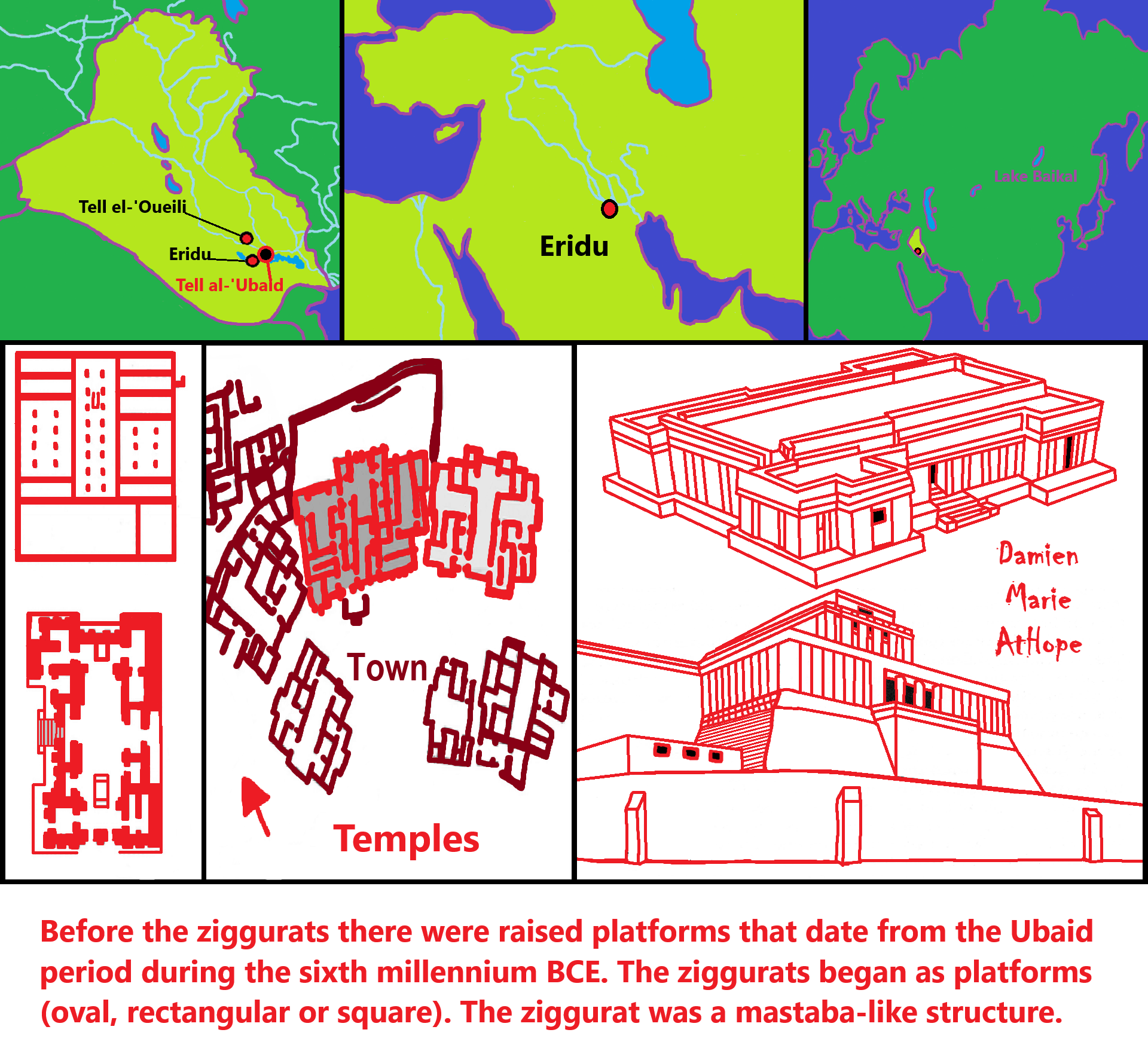
“Mesopotamian buildings of the Ubaid and Uruk periods (fifth–fourth millennia BCE). a: The reconstruction of a large tripartite house from Tell Oueili, Ubaid phase 0; b: Eridu, plan of the level VII ‘temple’; c: Part of the Tell Abada village.” ref
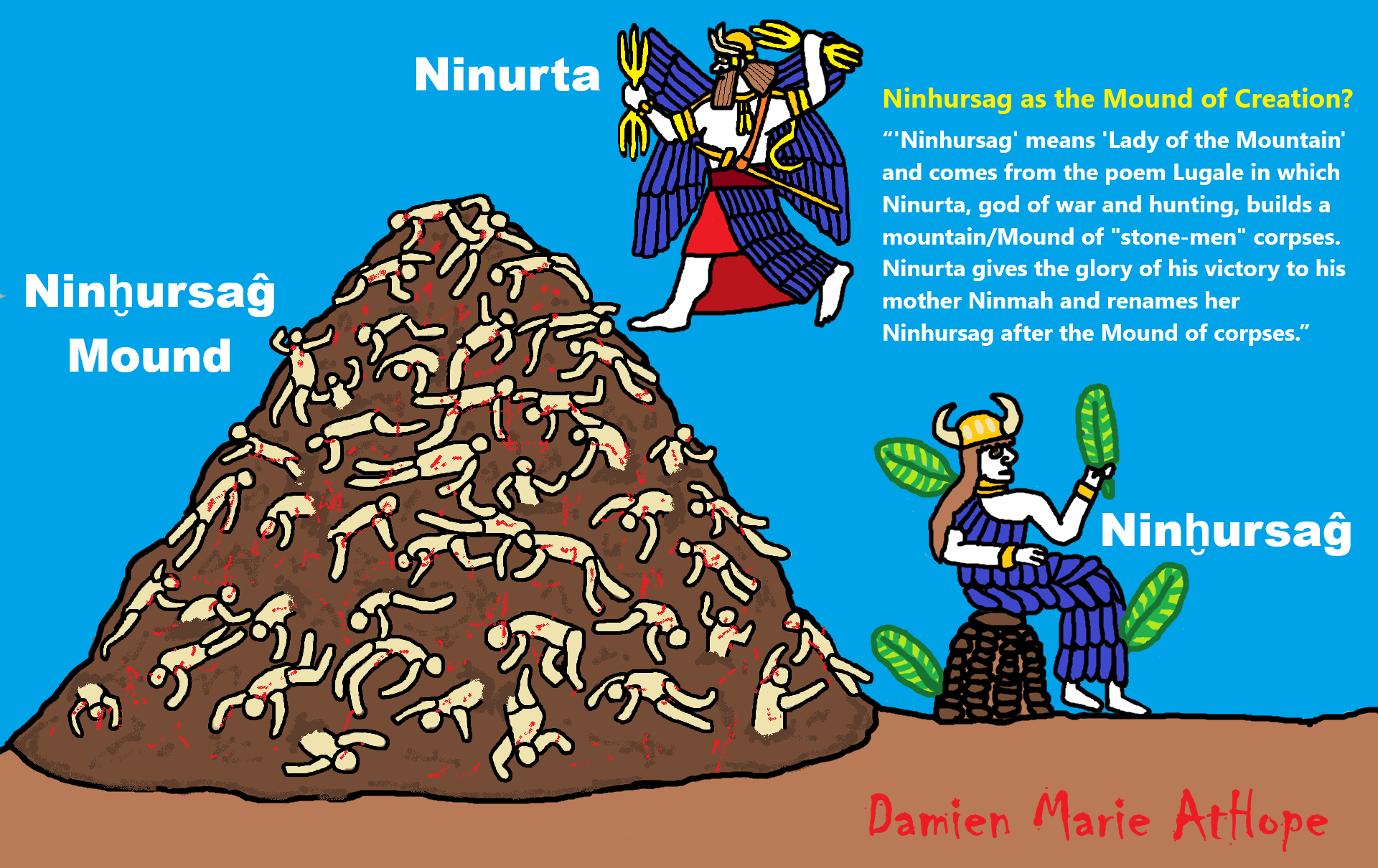
Ninhursag as the Mound of Creation?
“’Ninhursag’ means ‘Lady of the Mountain’ and comes from the poem Lugale in which Ninurta, god of war and hunting, builds a mountain/Mound of “stone-men” corpses. Ninurta gives the glory of his victory to his mother Ninmah (‘Magnificent Queen’) and renames her Ninhursag after the Mound of corpses.” ref
Tell al-‘Ubaid
“Most of the remains are from the Chalcolithic Ubaid period (c. 5500–3700 BCE) is a prehistoric period of Mesopotamia. for which Tell al-‘Ubaid is the type site, with an Early Dynastic temple and cemetery at the highest point. It was a cult center for the goddess Ninhursag.” ref
Mountains in Sumerian Creation Myths
“Near Nippur’s most important temple, Ekur (lit. “mountain house”), they unearthed a cache of clay tablets, which date as far back as the 3rd millennium BCE. They are humanity’s earliest extant written records. One of the tablets contains a creation myth, the so-called Debate between Sheep and Grain. It begins with a mountain: “On the mountain of heaven and earth, Anu spawned the Annunaki gods.” In fact, “mountain” (ḫur-saĝ) is the very first word on the tablet and could be the oldest written word.” ref
“Early in the story, heaven and earth are fused together in a site described as the mountain (ḫur-saĝ) of the supreme sky god Anu. On the slopes of the primordial mountain, primitive man existed, naked and feeding on grasses like cattle. Little else existed, so Anu created the other, lesser gods and goddesses — the Annunaki —, who in turn created sheep and grain for food. Unsatisfied, the gods “sent down” sheep and grain “from the Holy Mound” to “mankind as sustenance.” ref
“There is more to the story than this. But the opening lines of the clay tablet are important because they are the earliest extant textual references linking mountains with gods and fertility. And there are more from the same period. In another Sumerian creation story, Enki and Ninhursag, a certain Mount Dilmun (kur dilmun) is described as a paradise. Indeed, the fertility goddess Ninhursag’s name literally means “lady of the sacred mountain.” ref
“It should be noted here that the god Enki, with whom Ninhursag bears children, is the god of water. In yet another Sumerian story, Debate Between Winter and Summer, the god Enlil copulates with a mountain (hur-saj) and impregnates it “with Summer and Winter, the plenitude and life of the Land.” Mountains also figure prominently in The Epic of Gilgamesh, especially when the eponymous hero seeks Utnapishtim — the Noah-like figure who has learned the secret of eternal life. To get to Utnapishtim, Gilgamesh passes through the terrible Mount Mashu, where he encounters a series of tests, before coming upon a lush, bejeweled garden paradise.” ref
“The mountains are, thus, also safe harbor. Whether the Sumerian creation myths directly influenced Abrahamic traditions or share a common source with them is moot. But in the world’s oldest textual sources, ones that predate all other extant writing, mountains are the abodes of the gods and associated with abundance, life, sustenance, fertility, and paradise.” ref
“An inscribed door socket was found at an unexcavated mound on the Adaim river near where it meets the Tigris river, Khara’ib Ghdairife. It read “Manistusu, king of Kis, builder of the temple of the goddess Ninhursaga in HA.A KI. In another myth involving her son, Ninurta’s Exploits, the titular god goes out to conquer the mountain land to the north of Babylonia, and piles the bodies of its stony kings into a great burial mound. He then dedicates this mountain to his mother, once Ninmah, now renamed Ninhursag after the mound.” ref
Think of Watching: “Ninhursag – The Mother Goddess of Mesopotamian Mythology: Link
Think of Watching: “Ninhursag: The Mother Goddess (Mesopotamian Mythology Explained): Link
Ninhursag | Mother Goddess, Sumerian, Creation
“Ninhursag, in Mesopotamian religion, city goddess of Adab and of Kish in the northern herding regions; she was the goddess of the stony, rocky ground, the hursag.” ref
“Ninhursag had a documented role in Sumerian kingship ideology. The first known royal votive gift, recovered from Kiš, was donated by a king referring to himself as ‘beloved son of Ninḫursaĝa’. Votive objects dedicated to her Diĝirmaḫ name were recovered in Adab, dating to the Early Dynastic Period. Ninhursag could also be understood not simply as affiliated with mountains, but as a personification of mountain (or earth) as well.” ref

“In the creation myth of the Heliopolitan form of ancient Egyptian religion, Benben was the mound that arose from the primordial waters Nu upon which the creator deity Atum settled. The Benben stone (pyramidion) is the top stone of the pyramid.” ref
Mound of Creation
“Ancient Egyptian temples were not just homes for the gods, they were also replicas of the universe at the moment of creation.” ref
A Model of the Universe
“Ancient Egyptian temples were not just homes for the gods, they were also replicas of the universe at the moment of creation. In Egyptian mythology, the universe emerged from a vast cosmic ocean of nothingness. For countless eons, the creator-sun god Atum had drifted asleep in this primordial sea which the Egyptians called Nun. Eventually, the creator god awoke and willed a small island to emerge from out of the cosmic sea. From atop this hill, which the Egyptians called the mound of the “First Event,” Atum proceeded to call all things into existence starting with the male god Shu (the air) and the goddess Tefnut (moisture). Next came a third generation of deities in the form of the male earth god Geb and the sky goddess Nut. After further generations, every feature of nature was born, each with a god or goddess to govern it.” ref
“Egyptian temples were replicas of this early universe with inner sanctuaries representing the primeval hill. As visitors moved from the outer courts, through the hypostyle hall and into the holy of holies, the floor level gradually rose while the ceilings became lower. It also became darker as the open roofed courts and the hypostyle halls with their clerestory windows gave way to dark inner chambers with just one small light shaft in the inner chapel to illuminate the god’s cult statue. This confined and shadowy atmosphere transported the visitors privileged enough to see the god in his home back to the very beginning of time—but just a few priests and Pharaoh himself could enter this holy of holies. Within this sacred model of space and time, a hypostyle hall mimicked a thicket of papyrus reeds that grew in the swampy edges of the primeval mound.” ref
“Ancient Egypt’s still-buried ‘Mound of Creation’ an extremely well-preserved tomb at Saqqara near Cairo. It belonged to a high priest called Wahtye, and is more than 4,000 years old.” ref
Akhilandeshwari and the Lingam: (pillar-like “mound” symbol of Shiva, pseudo-Male Sex-Organ, made of stone, metal, gem, wood, or clay) – “Mound of Creation-like”
“One of the main forms of the Hindu Goddess Adi Parashakti. The goddess’s name is split into three components. “Akhila” means the universe, “Anda” means cosmic egg, and “Ishwari” means the divine mother. Therefore, Goddess, the divine mother who protects the entire universe in her womb (cosmic egg).” ref
“Once Parvati mocked Shiva‘s penance for the betterment of the world. Shiva wanted to condemn her act and directed her to go to the Earth from Mount Kailash (Shiva’s abode) to do penance. Parvati in the form of Akhilandeshwari as per Shiva’s wish found the Jambu forest to conduct her penance. She made a lingam out of the water from the Kaveri river, (also called as Ponni River) under the Venn Naaval tree (the Venn Naaval tree on top of the saint Jambu) and commenced her worship.” ref
“The lingam of the Shaivism tradition is a short cylindrical pillar-like symbol of Shiva, made of stone, metal, gem, wood, clay or precious stones. It is often represented within a disc-shaped platform, the yoni – its feminine counterpart, consisting of a flat element, horizontal compared to the vertical lingam, and designed to allow liquid offerings to drain away for collection.” ref
“The lingam is known as Appu Lingam (Water Lingam). Shiva at last appeared in front of Akhilandeshwari and taught her Shiva Gnana. Akhilandeshwari took Upadesa (lessons) facing East from Shiva, who stood facing west. Just because of this till today during Uchi Kala Puja (Around Noon), the priest of Akhilandeshwari’s temple dresses up like a woman, goes to the sanctum of Jambukeswara Shiva and offers prayers and performs puja to Shiva and Kamadhenu (Cow deity). It is believed that Akhilandeshwari comes in the form of a priest to worship Shiva and the temple cow as Kamadhenu. Thiruvanaikovil is one of the temples where Akhilandeshwari is worshipped as a form of Adi Parashakti.” ref
“Another legend surrounds the Jambukeswarar Temple. Two attendants of Shiva, namely Malyavan and Pushpadanta always quarrelled with each other over one thing or the other. During a quarrel, Malyavan cursed Pushpadanta to become an elephant and the latter cursed the former to become a spider in their next births. The elephant and the spider arrived at Thiruvanaikovil and found the Appu Lingam under the Venn Naaval tree in the Jambu forest. Thus, the animals started their worship of Shiva. The elephant collected water from the nearby Kaveri River and performed abhishekam (ablution) to the lingam. The spider constructed a web to prevent dust, dry leaves and direct sunlight from falling on the lingam. One day, The elephant saw the web over the lingam. It thought there was dust on the lingam and destroyed the web. It later collected water and performed abhishekam again. This went on every day. One day, the spider was angry over the overall destruction of its webs, crawled into the trunk of the elephant and bit the elephant to death. The spider died during the act. Moved by the deep devotion of the two, Shiva appeared and gave moksha (liberation) to the elephant and the spider, who were his attendants in their past lives.” ref
“There’s also another story. After the creation of the heaven, earth and the sky, Brahma created a woman (sometimes identified as Saraswati). Unfortunately, Brahma fell in love with the woman. Due to his lust for the woman, Brahma could not do his duty properly. The woman wanted to get away from the lust of Brahma and tried to move away, but a head of Brahma sprouted wherever she went. Brahma now had 5 heads. The woman went to Shiva and asked for help. Shiva agreed and went to Brahma. Shiva took the form of Bhairava, flung his trident and cut off the 5th head of Brahma, leaving only 4 heads.” ref
“Brahma then repented for his actions and decided to do penance. Moved by his deep devotion, Shiva and Parvati appeared dressed as Parvati and Shiva respectively. When Brahma opened his eyes, he could not recognize them and tell who was who. Brahma later asked for repentance and Shiva agreed as he and Parvati appeared again in their true form. Hence, till the present, the event is recreated in a procession where the procession deities of Shiva and Parvati are dressed and vice versa and carried through all the five outer parts (prakaras) of the temple which is celebrated as Pancha-Prakara Vizha.” ref

“The lingam is an emblem of generative and destructive power. While rooted in representations of the male sexual organ, the lingam is regarded as the “outward symbol” of the “formless Reality”, the symbolization of merging of the ‘primordial matter’ (Prakṛti) with the ‘pure consciousness’ (Purusha) in transcendental context. The lingam-yoni iconography symbolizes the merging of microcosmos and macrocosmos, the divine eternal process of creation and regeneration, and the union of the feminine and the masculine that recreates all of existence. The lingam is typically the primary murti or devotional image in Hindu temples dedicated to Shiva, also found in smaller shrines, or as self-manifested natural objects.” ref
“Some lingams are miniaturized and they are carried on one’s person, such as by Lingayats in a necklace. These are called chala-lingams. The Hindu temple design manuals recommend geometric ratios for the linga, the sanctum and the various architectural features of the temple according to certain mathematical rules it considers perfect and sacred. Anthropologist Christopher John Fuller states that although most sculpted images (murtis) are anthropomorphic or theriomorphic, the aniconic Shiva Linga is an important exception. To some Shaivites the lingam symbolizes the axis of the universe.” ref
“The sexualization is criticized by Stella Kramrisch and Moriz Winternitz who opines that the lingam in the Shiva tradition is “only a symbol of the productive and creative principle of nature as embodied in Shiva”, and it has no historical trace in any obscene phallic cult. Shaiva philosophical texts and spiritual interpretations, “deny that the linga is a phallus.” To the Shaivites, a linga is neither a phallus nor do they practice the worship of erotic penis-vulva, rather the linga-yoni is a symbol of cosmic mysteries, the creative powers and the metaphor for the spiritual truths of their faith.” ref

Lingam and Yoni meaning in Hinduism
“A Shiva temple, and by extension the whole world, is the yoni of the Goddess. The entrance to the is the leaf-shaped through within the temple, which envelopes Shiva’s linga. The Goddess thus draws Shiva’s phallus into the world. The tip of the leaf-shaped through always points to the north, suggesting that Shiva is lying on the ground facing the north. That the Goddess is always visualized as sitting on the top of Shiva is indicative of her proactive role in making Shiva interact with the world. Water is poured on the symbol of Shiva and collected in the symbol of Shakti with aim of drawing the energy of Shiva’s fire into samsara. This highly erotic imagery is highly typical for Tantra. The marriage of Shiva and Shakti transforms both God and Goddess. When she steps on Shiva, Shakti is Kali, nature wild and untamed. Shiva is consciousness that is indifferent. When they marry, Kali becomes Gauri, nature that is nurturing and fertile. Shiva becomes Shankara, consciousness that is attentive. Just as devotees pour water on Shiva to draw his attention towards them, they offer clothes to Shakti when they visit her shrine. They want to see her not as the naked and bloodthirsty Kali but as the maternal Gauri.” ref
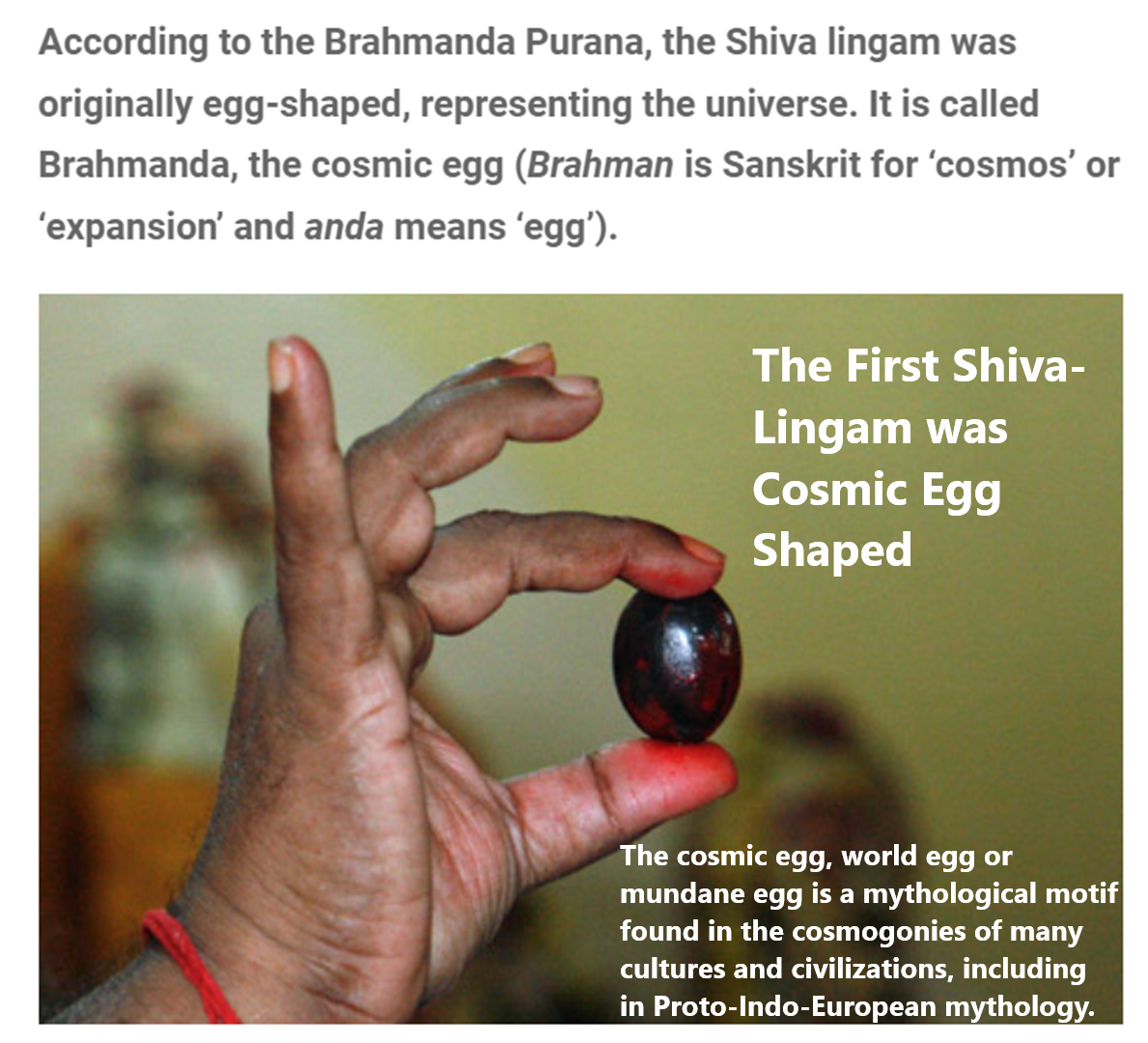
“The First Shiva-Lingam was Cosmic Egg Shaped.” ref, ref
“The cosmic egg, world egg or mundane egg is a mythological motif found in the cosmogonies of many cultures and civilizations, including in Proto-Indo-European mythology. Typically, there is an egg which, upon “hatching”, either gives rise to the universe itself or gives rise to a primordial being who, in turn, creates the universe. The egg is sometimes lain on the primordial waters of the Earth. Typically, the upper half of the egg, or its outer shell, becomes the heaven (firmament) and the lower half, or the inner yolk, becomes the Earth. The motif likely stems from simple elements of an egg, including its ability to offer nourishment and give rise to new life, as is reflected by the Latin proverb omne vivum ex ovo (‘all life comes from an egg’). The term “cosmic egg” is also used in the modern study of cosmology in the context of emergent Universe scenarios.” ref
“A hymn to Ninkasi states that while this goddess was raised by Ninhursag, her parents were Ninti and Enki. Ninti and Ninkasi occur near each other in a document from the Fara period. The relation between Ninti and Enki is also attested in the god list An = Anum, where she is equated with his spouse Damkina. The masculine equivalent of her name, Enti, is also given as an alternate name of Enki, though in other contexts dEN.TI was instead a logographic representation of the name of Ebiḫ, a mountain god presumed to represent Hamrin Mountains.” ref
“Ebiḫ (Ebih) was a Mesopotamian god presumed to represent the Hamrin Mountains. It has been suggested that while such an approach was not the norm in Mesopotamian religion, no difference existed between the deity and the associated location in his case. It is possible that he was depicted either in a non-anthropomorphic or only partially anthropomorphic form. He appears in theophoric names from the Diyala area, Nuzi and Mari from between the Early Dynastic and Old Babylonian periods, and in later Middle Assyrian ones from Assyria. He was also actively venerated in Assur in the Neo-Assyrian period, and appears in a number of royal Tākultu rituals both as a mountain and as a personified deity.”
“The defeat of Ebiḫ at the hands of the goddess Inanna is described in the myth Inanna and Ebiḫ. Various interpretations of the narrative have been advanced, with individual authors seeing it as royal propaganda of the Akkadian empire, as a critique of its conquests, or as a narrative focused on typical literary motifs, lacking political undertones. Possible references to Ebiḫ’s defeat have been identified in other literary compositions, in god lists, and on cylinder seals.” Known from the god list An = Anum (tablet IV, line 23) and its Old Babylonian forerunner, might have been related to the Ebiḫ myth due to its similarity to a presumed variant name of the mountain god, Enti.” ref
Lugaldukuga “primeval deity” and “prime mover” (Mound of Creation?)
“His name means “lord of the holy mound (the Duku)” in Sumerian. The Duku was regarded as the place where Enlil determined destinies for other deities. It was also believed to be the dwelling of his ancestors. The word has two possible meanings, as the sign du could refer to both a hill and to a brick platform. According to Wilfred G. Lambert, it is possible that they could be interpreted as the cosmic location and its physical representation in Enlil’s Ekur temple complex in Nippur.” ref
Du-Ku
“Du-Ku or dul-kug is a Sumerian word for a sacred place. According to Wasilewska et al., du-ku translates as “holy hill”, “holy mound” […E-dul-kug… (House which is the holy mound), or “great mountain. According to the University of Pennsylvania online dictionary of Sumerian and Akkadian languages, du-ku is actually du6-ku3, with du6 being defined as a mound or ruin mound, and ku3 as either ritually pure or shining: it is used in the texts on the Univ. of Oxford site as “shining”. There is no mention of nor association with the term “holy”, and instead it represents a cultic and cosmic place. The location is otherwise alluded to in sacred texts as a specifically identified place of godly judgement. The hill was the location for ritual offerings to Sumerian god(s) Nungal and the Anunna dwell upon the holy hill in a text written from Gilgamesh.” ref
Sumerian tablet of Ereshkigal
“… Enlil on the shore, where he kept watch over the “Du-Ku, the Holy Mound of Creation,” and Mother Ki, (sometimes Antu, sometimes Ninhursag) his eyes gleaming with fond laughter. But why did they leave the safety of the Duku, the mound of creation, why did they go beyond the Waters of Mother Nammu.” ref
“Ninhursag (also Ninhursaga) is the Sumerian Mother Goddess and one of the oldest and most important in the Mesopotamian Pantheon. She replaced the earlier Mother Goddess, Nammu (also known as Namma) whose worship is attested as early as Dynastic III (2600-2334 BCE) of the Early Dynastic Period (2900-2334 BCE).” ref

It is the first Egyptian Pyramid to be built.
“The pyramid of Djoser, sometimes called the Step Pyramid of Djoser, is an archaeological site in the Saqqara necropolis, Egypt, northwest of the ruins of Memphis. It is the first pyramid to be built. The 6-tier, 4-sided structure is the earliest colossal stone building in Egypt. It was built in the 27th century BCE during the Third Dynasty for the burial of Pharaoh Djoser. The pyramid is the central feature of a vast mortuary complex in an enormous courtyard surrounded by ceremonial structures and decorations. The pyramid went through several revisions and redevelopments of the original plan. The pyramid originally stood 62.5 m (205 ft) tall, with a base of 109 m × 121 m (358 ft × 397 ft), and was clad in polished white limestone. The step pyramid (or proto-pyramid) was considered to be the earliest large-scale cut stone construction made by man as of 1997, although the nearby enclosure wall “Gisr el-Mudir” is suggested by some Egyptologists to predate the complex, and the South American pyramids at Caral are contemporary.” ref
“Djoser was the first or second king of the 3rd Dynasty (c. 2670–2650 BCE) of the Old Kingdom of Egypt (c. 2686 – c. 2125 BCE). He is believed to have ruled for 19 years or, if the 19 years were biennial taxation years, 38 years. He reigned long enough to allow the grandiose plan for his pyramid to be realized in his lifetime. Djoser is best known for his innovative tomb, which dominates the Saqqara landscape. In this tomb, he is referred to by his Horus name Netjerikhet; Djoser is a name given by New Kingdom visitors more than a thousand years later. Djoser’s step pyramid is astounding in its departure from previous architecture. It sets several important precedents, perhaps the most important of which is its status as the first monumental structure made of stone. The social implications of such a large and carefully sculpted stone structure are staggering. The process of building such a structure would be far more labor-intensive than previous monuments of mud-brick.” ref
“This suggests that the state, and therefore the royal government, had a new level of control of resources, both material and human. Also, from this point on, kings of the Old Kingdom are buried in the North, rather than at Abydos. Although the plan of Djoser’s pyramid complex is different from later complexes, many elements persist, and the step pyramid sets the stage for later pyramids of the 4th, 5th, and 6th Dynasties, including the great pyramids of Giza. Though the Dynastic Egyptians themselves did not credit him as such, most Egyptologists credit Djoser’s vizier Imhotep with the design and construction of the complex. This is based on the presence of his statue in the funerary complex of Djoser, his title of “overseer of sculptors and painters,” and a comment made by the 3rd century BCE historian Manetho claiming Imhotep was the “inventor of building in stone.” ref
“Djoser’s Pyramid draws ideas from several precedents. The most relevant precedent is found at Saqqara mastaba 3038 (c. 2900 BCE). The substructure lay in a 4 m (13 ft) deep rectangular pit, and had mudbrick walls rising to 6 m (20 ft). Three sides were extended and built out to create eight shallow steps rising at an angle of 49°. This would have been an elongated step pyramid if the remaining side had not been left uncovered. In another parallel to Djoser’s complex, to complete this mastaba complex a niched enclosure wall was erected. In the early stages (M1 to M3) the structure had the form of a mastaba before alterations (P1 to P2) were made to create its step pyramidal form. In the first stage (M1), the mastaba had a square plan 63 m (207 ft; 120 cu) in length that rose to a height of 8.4 m (28 ft; 16 cu).” ref
“This was built from a core of limestone blocks arranged in horizontal beds and bound with yellow or red clay. A 2.6 m (9 ft; 5 cu) thick casing of fine white Tura limestone was applied to the core arranged in the same horizontal manner. The outer blocks were inclined to ~82°, and the top of the mastaba likely had a slightly convex shape. A second casing of fine white limestone was applied to this which increased the mastaba’s base length to 71.5 m (235 ft; 136 cu) square (M2). The casing was 4.2 m (14 ft; 8 cu) thick at the base and 3.4 m (11 ft; 6.5 cu) thick at the peak, which was 0.65 m (2 ft; 1 cu) lower than the initial mastaba height. The outer blocks of this second coat also had a steeper incline at ~76°. The mastaba was then extended 8.4 m (28 ft; 16 cu) east to cover a series of eleven shafts 33 m (108 ft; 63 cu) deep that ended in passages that led west to the burial chambers of members of Djoser’s family.” ref
“This extension was built from locally sourced limestone rubble and cased by 1.5 m (5 ft; 3 cu) thick limestone coating that formed an extension of M2. The mastaba had a new, rectangular ground plan 71.5 m (235 ft; 136 cu) by 79.5 m (261 ft; 152 cu). At this stage the mastaba still peaked at 8.4 m (28 ft; 16 cu) in height, too short to be seen from outside the 10.5 m (34 ft; 20 cu) high enclosure wall. Egyptologists are split on the motivations behind the conception of the pyramidal form that the mastaba was converted into. Lauer believed that the alteration was made to have the tomb visible from Memphis. The fact of the mastaba’s square plan led Rainer Stadelmann, however, to suggest that it was never the intended final form and that it was planned to be a pyramid from the outset. The conversion (P1) encased the mastaba (M3), extending its length by 5.76 m (19 ft; 11 cu) on each axis, giving it a base length of 85.5 m (281 ft; 163 cu) by 77 m (253 ft; 147 cu). The alteration from mastaba to pyramid came with a shift in construction.” ref
“The builders used larger and better quality, roughly dressed limestone blocks – but instead of horizontal beds, they built successive inclined accretion layers 2–3 m (6.6–9.8 ft) thick. These leaned on each other from opposite ends, providing greater stability and preventing a collapse. The whole was then cased in fine white limestone with a layer of packing in between. This phase of the pyramid had four steps that rose to a height of 42 m (138 ft; 80 cu). The decision was then made to expand the pyramid north and west from four to six steps (P1′) which was then finished with a final layer of limestone casing (P2) that gave the pyramid its final form. On completion, the step pyramid had a base length of 109 m (358 ft; 208 cu) by 121 m (397 ft; 231 cu) that rose to a height of 60–62.5 m (197–205 ft; 115–119 cu) and occupied a volume of 330,400 m3 (11,670,000 cu ft). Much of the rock for the pyramid was likely quarried from the construction of the great trench. It is widely accepted that ramps would have been used to raise heavy stones to construct the pyramid, and many plausible models have been suggested. For transport, apparatuses like rollers were used in which the heavy stone could be placed and then rolled.” ref

It is hierarchy oppression from the earliest proto-kings (powerful chieftains?).
Continuing Iconography of Power: smiting enemies
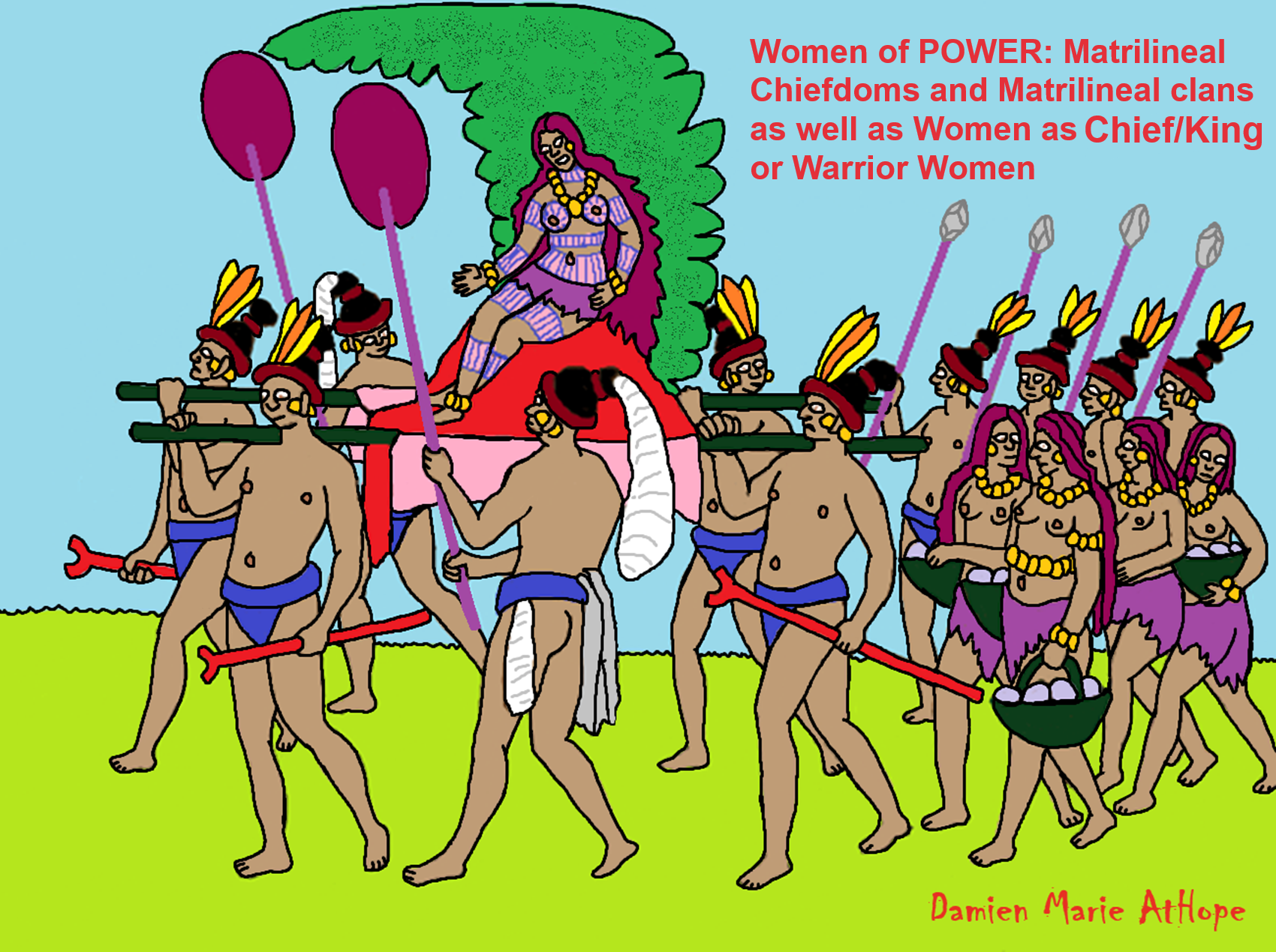
(List of matrilineal or matrilocal societies) “Matrilineal means kinship is passed down through the maternal line, the mother’s lineage, which can involve the inheritance of property and titles.” ref, ref
Chiefdoms are powers that are often believed to mobilize due to surplus labor, food, and prestige items. However, I see it as a cultural package that started with hunter-gather/fisher-foragers in west Siberia with the switch from a Matrilineal society to a patrilineal society from 8,000 to 7,000 years ago and from there spread this new war and powerful male thinking, but some Matrilineal societies changed to the war and power modal as well but kept being female-centered. I often talk as if they were completely wiped out by male clans, but not all were, and some became as horrible as male clans. One such major transfer of such ideas, which I think relates to the Tlingit (Matrilineal Na-Dene language connected to patrilineal Yeniseian languages such as the Ket People of Siberia with mostly to Y-DNA haplogroup Q-M242 linking Tlingit and South America) of the Pacific Northwest Coast of North America, were a Slaveholding, matrilineal clan chiefdom. And like 90% of South America shares their DNA and also, to me, likely somewhat influenced all Mesoamerican cultures and Moundbuilding cultures that had “Big Men/Big Women” pre/proto-chiefdoms, chiefdoms, and then clan monarchs: Kings/Empresses.
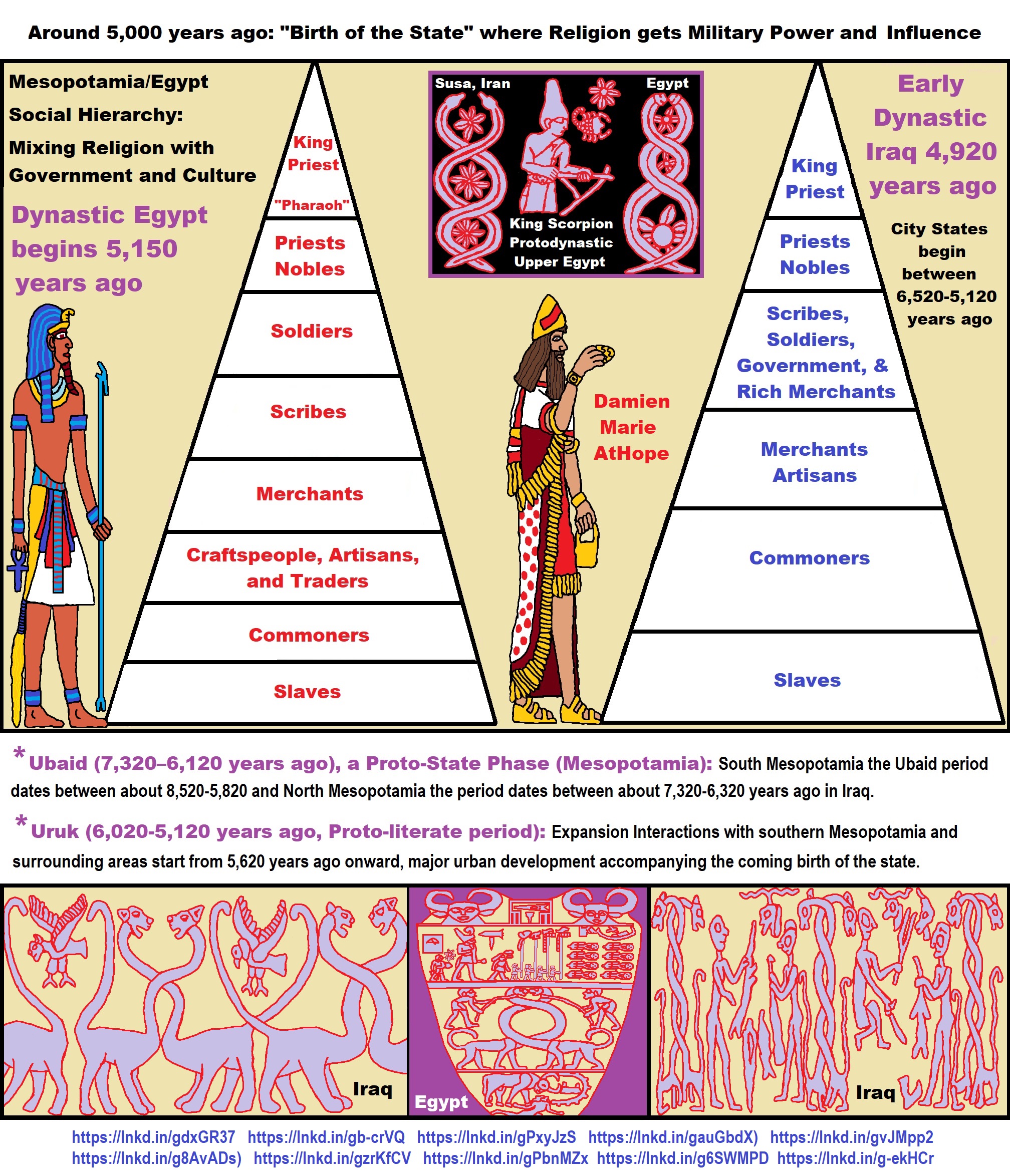
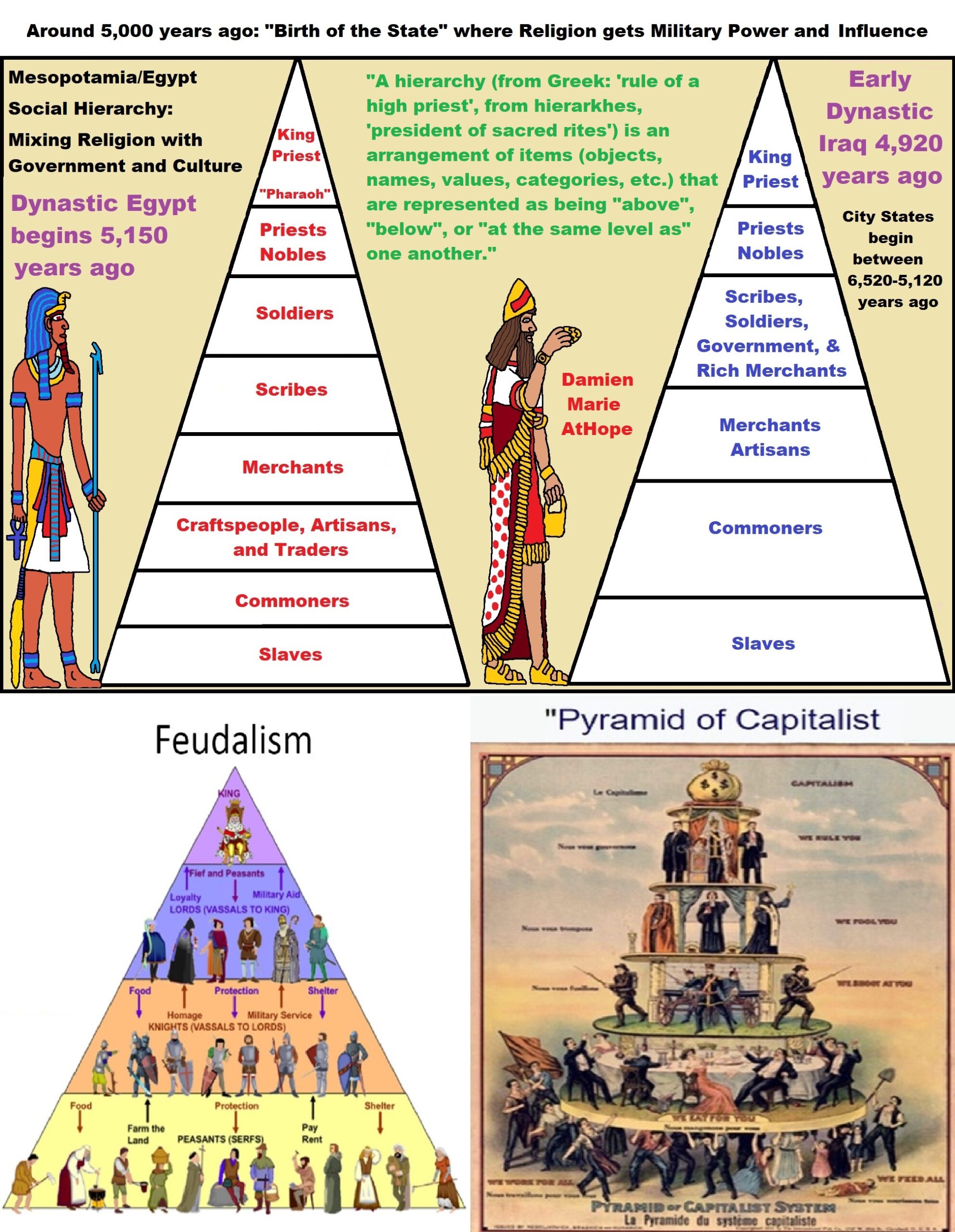
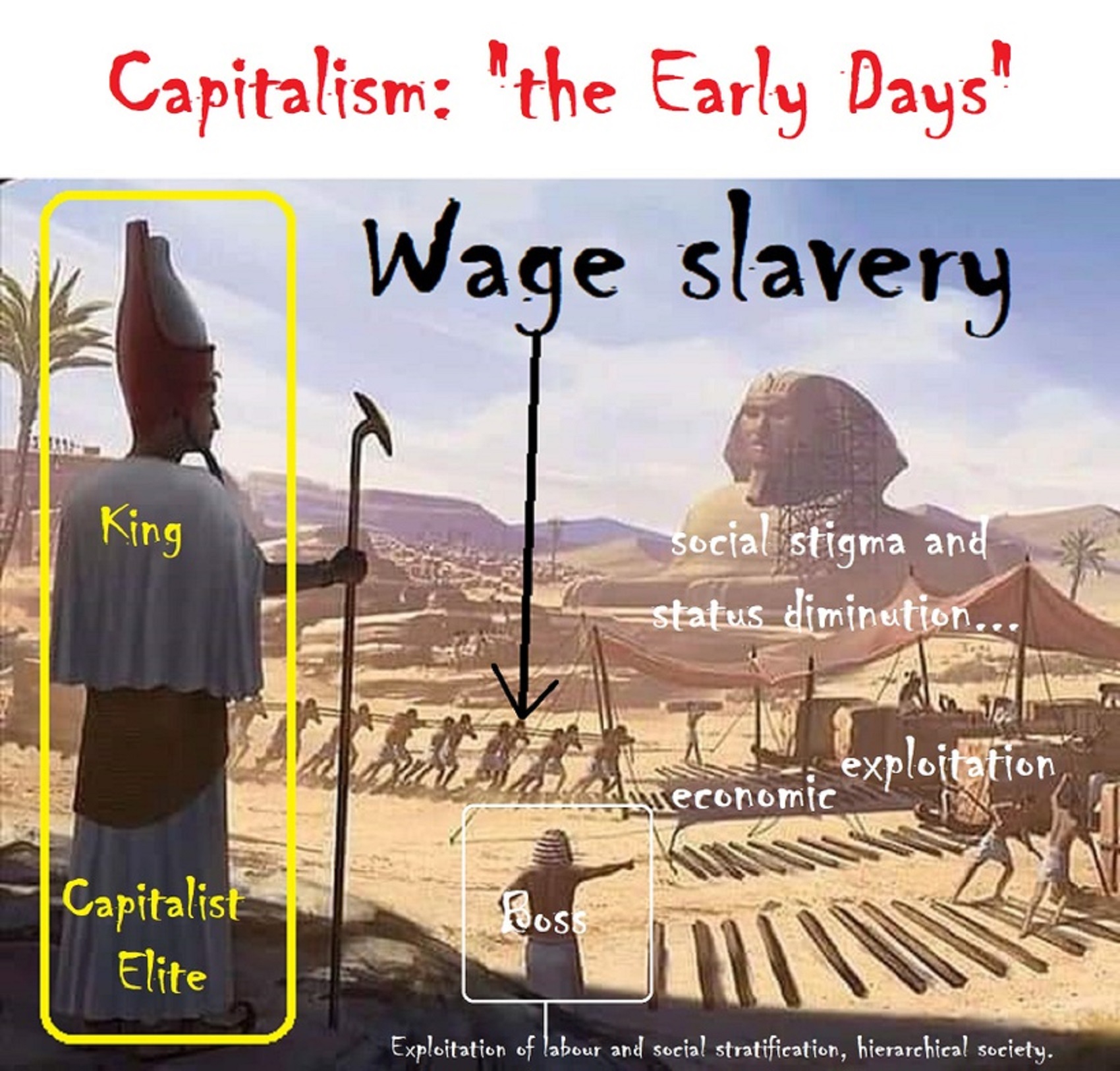
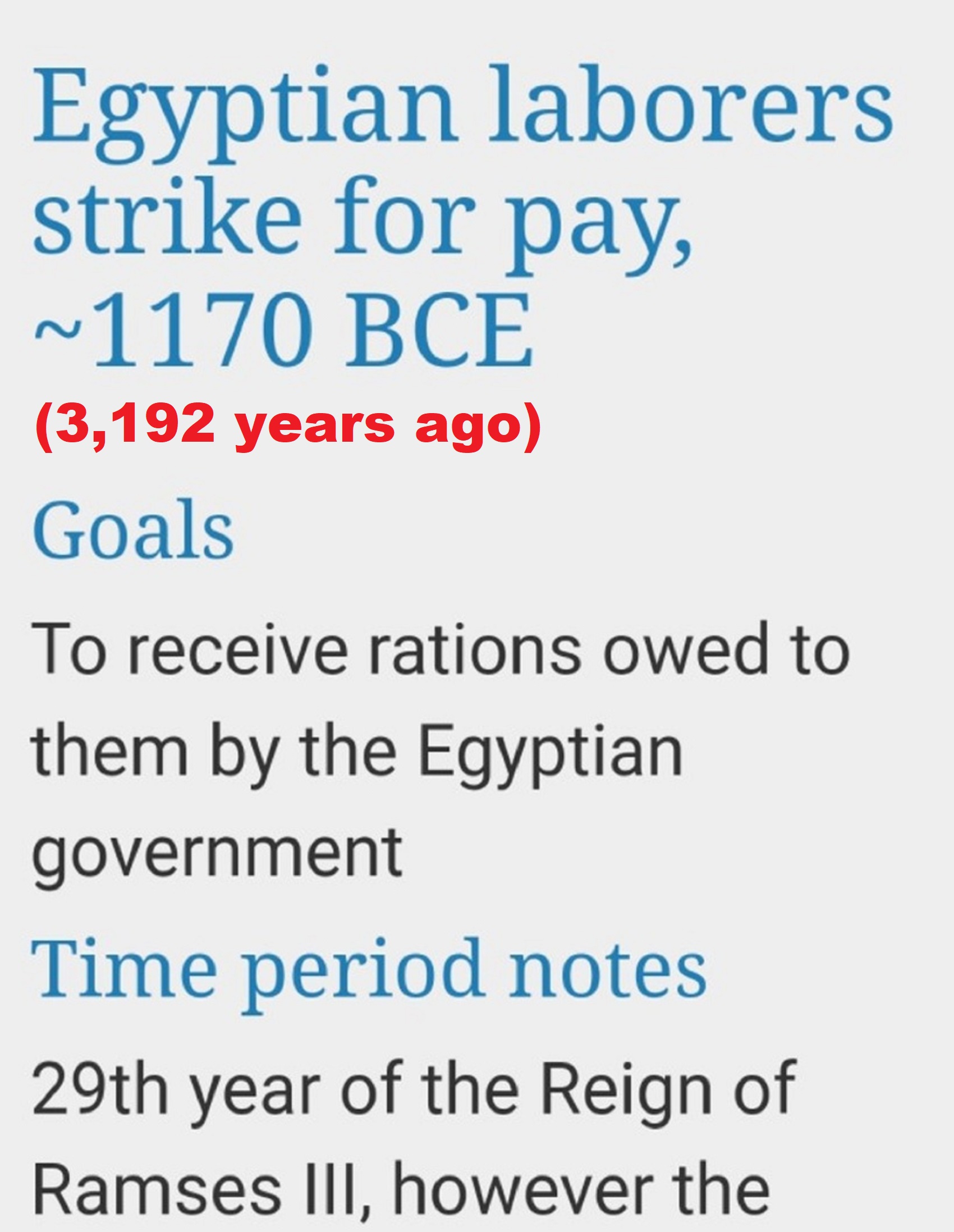
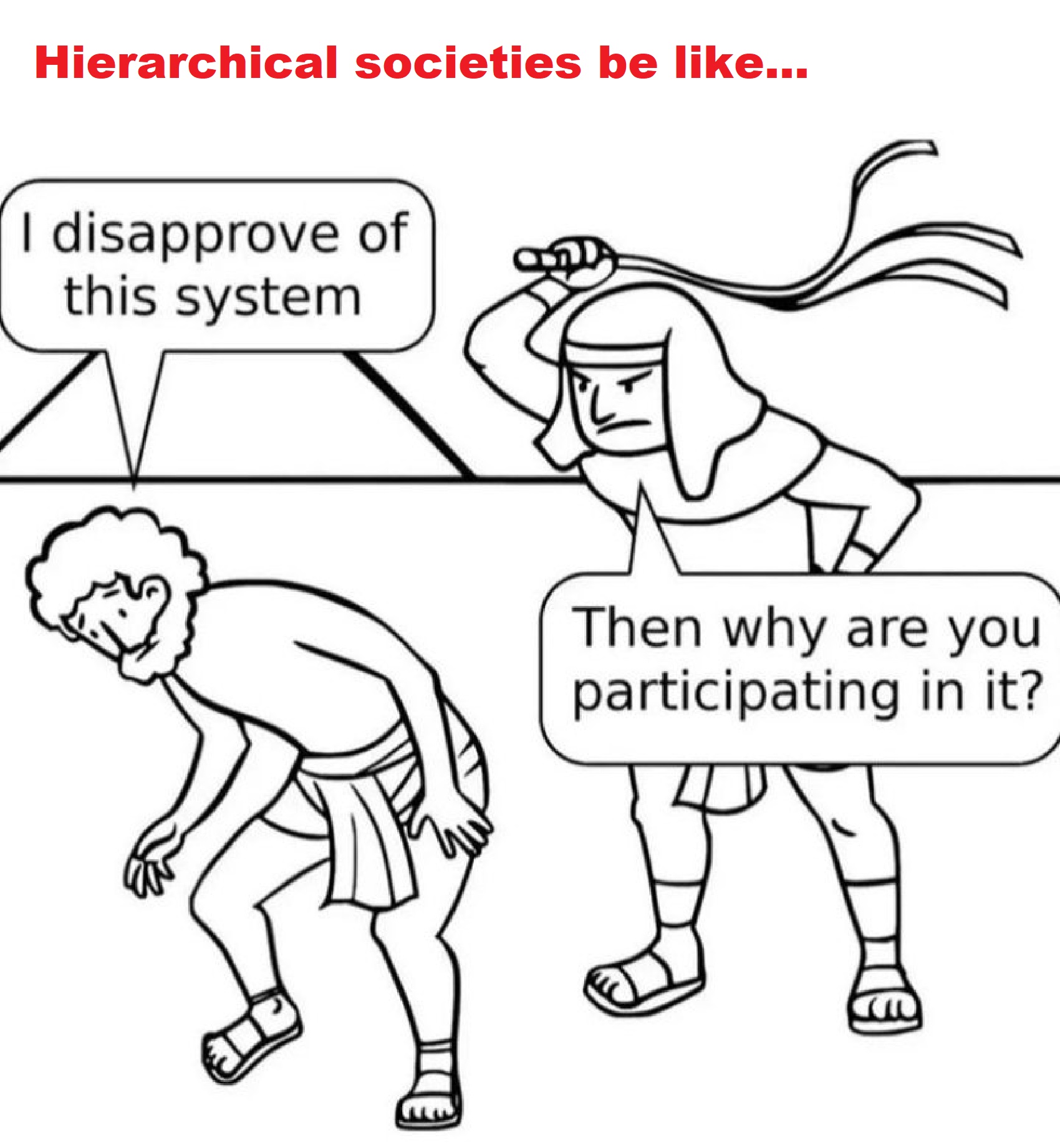

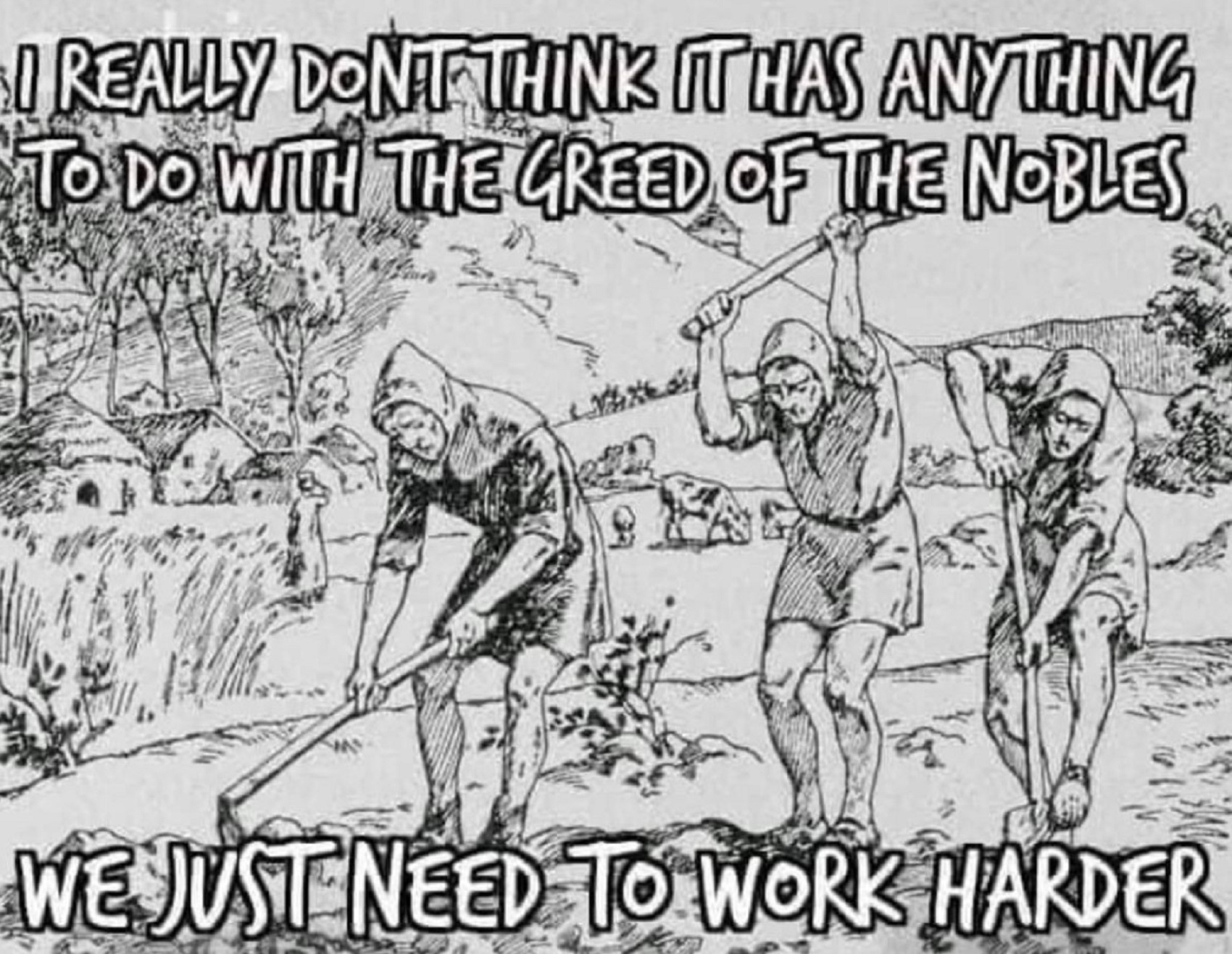

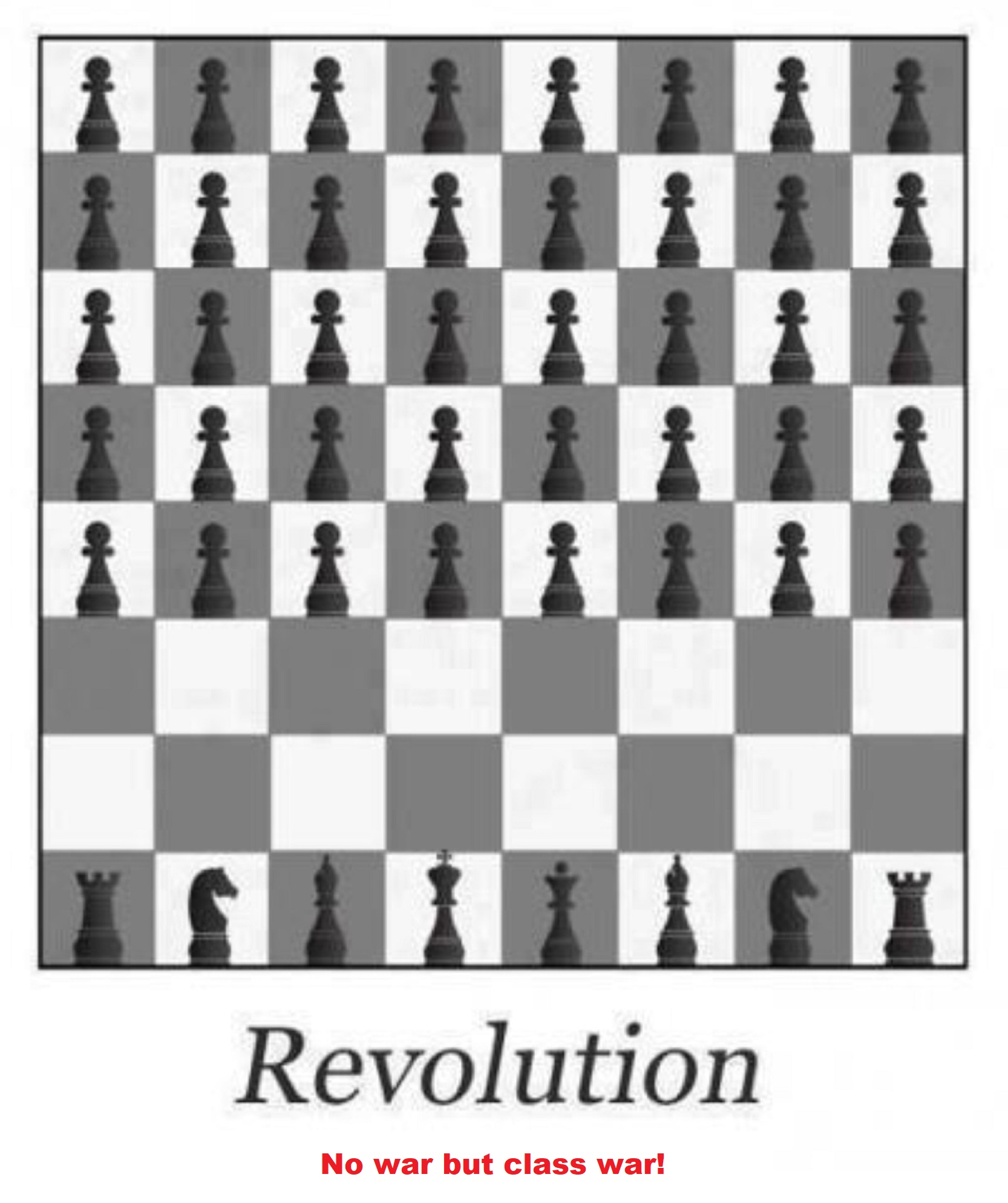
Hopewell Mound Builder culture (200 BCE–500 CE)
“The Hopewell inherited from their Adena Mound Building culture (500 BCE–100 CE) forebears an incipient social stratification.” ref
“These cultures likely accorded certain families a special place of privilege. Some scholars suggest that these societies were marked by the emergence of “big-men/women”, leaders whose influence depended on their skill at persuasion in important matters such as trade and religion. They also perhaps augmented their influence by cultivating reciprocal obligations with other important community members. The emergence of “big-men/women” was a step toward the development of these societies into highly structured and stratified chiefdoms.” ref
On the Significance of Matrilineal Chiefship
” UNDER the term chiefship as here used we include only that civil office in which the incumbent is the head of a family and has under his rule a band of families, a tribe, or a nation. Such chiefs are, for example, the band chiefs of the north and east Algonkian, the chiefs of the households of the Nootka, of the households or matrilineal “families” of the Iroquois; the tribal head chiefs of the Nootka, Coast, and Delt Salish, Tsimshian, etc., and the kings of the Natchez, man African states, modern European nations, etc. The first essential fact we have to note about this office is that universally it is the prerogative of an adult male. Occasionally, it is held by a child, the functions of pending the child chief’s maturity, being exercise warmer” or regent. Occasionally also, which is more the office is held by a female. A child holds office those peoples with whom the chiefship has become hereditary, and the heir presumptive may not be A woman holds office only where the office is strictly a given family, and when no eligible male heir is near enough in blood to be considered acceptable in a closely related female who can be expected soon son and so perpetuate the chiefship through the descent.” ref
“An example of the type of situation which gave rise to the installation of queens even among so-called “primitive” folk may
well be noted at length at this point, in part because of certain remarkable features which will interest us more in a moment. In the year 1660 the Piscottoways (Ganawagas, Conoys) of Maryland applied to the governor of the province for ratification of their choice of an “emperor,” and to his inquiry as to their customs relative to succession they replied that the office went, on the death of an incumbent, to his brother, “and for want of such, to a sister’s son,” and stated that in such wise the office had descended from their first emperor-who had been some one come to rule over them from the eastern Shore of Maryland-for thirteen generations, without interruption, until the time of the emperor Kittamaqund who preceded the emperor just deceased.” ref
“Kittamaqund had died without having brother or sister, (and, presum without a sister’s son) to succeed him, and took it upon him, therefore, to appoint his daughter to be “queen.” The perejected this appointment, however, as contrary to tribal custom and chose as emperor, Weghucasso, who was descended “from of the brothers, which one, they knew not, of the first emperor “And Weghucasso at his death appointed to be king some descendant of one of the first kings.” This appointee was Jan Wizous, which in their language signifies a true king [they] would not suffer us to call him Towzin, which is the they give to the sons of their kings who by their custom ar to succeed in rule, but his brothers, or the sons of his sisters.” To avoid possible misconceptions it is perhaps at this point to consider a practice prevailing among
Kwakiutl of British Columbia.” ref
“For them Boas patrilineal inheritance is the rule for certain circumstances the annual or winter ceremonies of the secret societies, such as that of master-of-ceremonies, those of caretaker of the drum, of the batons, of the eagle-down, etc. Civil privileges also are sometimes so inherited but much the larger number of these are given by a father to his son-in-law expressly in trust for the donor’s grandson. Hill-Tout has noted for the not-distant Siciatl that the chiefship, a civil “privilege” on the Northwest Coast, maybe so inherited, or bestowed; regularly it goes to the eldest son of a chief but where there is no son the son-in-law will succeed,5 as a consequence of which in the third generation the reigning chief will be the grandson of the chief whose son-in-law succeeded, the chiefship, thereby descending in the direct line of succession just as if the daughter herself had actually succeeded to the office and exercised its functions. It has been suggested that the practice of the southern Kwakiutl indicates an adaptation of a former patrilineal inheritance to concepts diffused from the tribes farther up the coast with whom all privileges and property including the privilege of chiefship descend matrilineally.” ref
“However, it has also been pointed out that the kinship terms of the Kwakiutl correspond to a loose organization in which relationship is reckoned bilaterally, as is the case with the closely related Nootka. For the Nootka Sapir has shown that privileges are inherited through both the male and female lines, with a preference for the male line, the inheritance of privileges being in a measure conditioned by the fact that privileges are not only personally owned but also definitely associated with the local group among whom they originate. More data, especially on the inheritance of the particular of chiefship, is desirable, but it seems evident that the Kwa represent simply a people reckoning bilaterally, but who, like peoples whose developing institution of chiefship has not be affected by the influence of a matrilineal kinship reckoning, the develop a patrilineal inheritance of office.” ref
“Rather than an indication of influences from the northern tribes and an addition to the idea of a matrilineal reckoning, the peculiar Kwa inheritance practice we have noted is simply an indication of Kwakiutl concern that privileges, in general, should descend patrilineally. And, in case a chief only has daughters, the Kw, like the Society, with the son-in-law arrangement, are able to the chiefship in the direct line of descent and, at the same, avoid having a woman chief or queen. We may now confine ourselves to the actual chiefship. Typically, though not always, it is cor the mother-sib. Despite the fact that with many whom the sib, and, specifically, the mother-sib, is a institution-such as the Iroquois, the Haida, etc.-this does not include the concept of even a fictitious kin its members, it yet remains obvious that sib member
patrilineally or matrilineally reckoned, is acquired the blood relationship to a father or a mother member obvious, and is perhaps superfluous to observe, also, whether transmitted matrilineally or patrilineally inherited by virtue of actual blood relationship cumbent of the office.” ref
“But a matrilineal reckoning for an which is universally the prerogative of a male and his male cessors appears as a noteworthy phenomenon, particularly of the fact that different types of inheritance reckonings for ent prerogatives, privileges, things, relationships, etc. contained within the same cultural considered in connection with the processes by which chiefship undoubtedly evolved. Definitely, instituted chiefship is itself an office which cannot be placed too far back in social evolution; and the concept and practice of the inheritance of the office exclusively within some one family of the group of families concerned must be placed reltively later, in that obviously intermediary developments remain on record as the existing practice of many peoples-though very definite records of this gradual evolution for any one people are hardly available. This evolution of the concept of ban and higher chiefships as hereditary within a given family and even as with many peoples, through an inflexible rule of picture took place of course concurrently with the of concepts of the inheritance of other things such ship, real, and personal property, songs, names, other office, etc.” ref
The Real Mound Builders of North America: matrilineal chiefdom
Mississippian Chiefdoms
“Although groups speaking several different languages produced Mississippian societies, they shared many cultural traits. The most spectacular features of these societies were the temple- and burial-mound centers they constructed. The largest such site is at Cahokia in what is now Collinsville, Illinois, just east of St. Louis, Missouri; the village area extended for six miles along the Illinois River, contained eighty-five temple and burial mounds, and sustained a population perhaps as high as seventy-five thousand persons. Being master farmers allowed the Mississippians to develop such large societies, although most chiefdoms were much smaller than Cahokia. All Mississippian sites utilized maize or corn as a primary staple and supplemented it with other plants and meats.” ref
“Chiefdoms. Mississippian societies are called chiefdoms because they were governed by small groups of elites or even by a single individual, called a paramount chief. Commoners and outlying satellite villages paid tributes of corn, deer meat, animal skins, and prestige items to the principal town. In some cases new towns joined a chiefdom by military conquest. The labor of commoners built the mounds and suggests that elites held the power to assemble large bodies of people to do their bidding. Leadership passed through hereditary lines in at least some of these chiefdoms, but high status was most likely based upon command of spiritual forces. The general population recognized the large amounts of power that leaders manipulated and honored them with positions of prestige. Matrilineal kinship characterized Mississippian culture, and female paramount chiefs greeted Spanish expeditions, such as the “Lady of Cofitachequi” from the chiefdom of Cofitachequi in present-day South Carolina who welcomed Hernando de Soto in the 1540s.” ref
“Decline. Mississippian chiefdoms still existed in the mid 1500s when de Soto and others traveled through the Southeast, but just a century later, the mound sites were abandoned. Because of this timing, scholars looked to the de Soto campaign as the cause of this phenomenon. It is probable that some of de Soto’s men, or maybe the horses and pigs that accompanied them, carried diseases to which the Indians had no immunity. Pandemics may have wiped the Mississippians from the map, replacing them with refugee groups of survivors who banded together for protection but lacked the numbers to maintain the mounds. Many Mississippian sites became vacant before European contact, however, which suggests that local reasons contributed to abandonment. Perhaps Mississippians overused their resources, depleting the soil for corn and cutting down trees necessary for their buildings and fires. Possibly, climatic changes resulted in drought or a shorter growing season, thus reducing the food supply. Political conflict and war between chiefdoms could have weakened some to the point of being unsustainable. Likely, all of the above factors contributed to the abandonment of the mound sites. The Choctaws, Creeks, Chickasaws, Cherokees, and Seminoles descended from the Mississippian peoples and held many traits in common with their ancestors.” ref
“Although the first people entered what is now the Mississippi about 12,000 years ago, the earliest major phase of earthen mound construction in this area did not begin until some 2100 years ago. Mounds continued to be built sporadically for another 1800 years, or until around 1700 CE. Archeologists, the scientist who study the evidence of past human lifeways, classify moundbuilding Indians of the Southeast into three major chronological/cultural divisions: the Archaic, the Woodland, and the Mississippian traditions. To date, no mounds of the Archaic period (7000 to 1000 BCE) have been positively identified in Mississippi; the mounds described herein all date to the last two cultural periods.” ref
“The Middle Woodland period (100 BCE to 200 CE) was the first era of widespread mound construction in Mississippi. Middle Woodland peoples were primarily hunters and gatherers who occupied semipermanent or permanent settlements. Some mounds of this period were built to bury important members of local tribal groups. These burial mounds were rounded, dome-shaped structures that generally range from about three to 18 feet high, with diameters from 50 to 100 feet. Distinctive artifacts obtained through long-distance trade were sometimes placed with those buried in the mounds. The construction of burial mounds declined after the Middle Woodland, and only a few were built during the Late Woodland period (circa 400 to 1000 CE). Woodland burial mounds can be visited at the Boyd, Bynum, and Pharr sites and at Chewalla Lake in Holy Springs National Forest. (The Chewalla Mound is not included in this itinerary because it is not listed in the National Register of Historic Places).” ref
“The Mississippian period (1000 to 1700 CE) saw a resurgence of mound building across much of the southeastern United States. Most Mississippian mounds are rectangular, flat-topped earthen platforms upon which temples or residences of chiefs were erected. These buildings were constructed of wooden posts covered with mud plaster and had thatched roofs. Mississippian platform mounds range in height from eight to almost 60 feet and are from 60 to as much as 770 feet in width at the base. Mississippian period mounds can be seen at the Winterville, Jaketown, Pocahontas, Emerald, Grand Village, Owl Creek, and Bear Creek sites.” ref
“Mississippian period mound sites mark centers of social and political authority. They are indicators of a way of life more complex than that of the Woodland and earlier periods. In contrast to the relatively simple, egalitarian tribal organization of most societies of the Woodland period, regional Mississippian populations were typically organized into chiefdoms–territorial groups with hereditary, elite leadership classes. Across the Southeast, the chiefdom system of political organization arose as a means of managing increased social complexity caused by steady population growth. This population growth was sustained by agriculture (corn, beans, and squash)–a revolutionary new means of subsistence that became an economic mainstay during the Mississippian period.” ref
“Mound construction was once again in decline by the time the first Europeans came to this region in the 1500s. Shortly thereafter, epidemic diseases introduced by early European explorers decimated native populations across the Southeast, causing catastrophic societal disruption. As a result, by the time sustained contact with European colonists began about 1700 CE, the long tradition of mound building had nearly ended.” ref
Ancient Colombian chiefdoms
“Chiefdoms in Central America were small groups who developed unique art forms in order to distinguish themselves and compete with one another. c. 500 B.C.E.–1600 C.E.” ref
Tribe versus Chiefdom in Lower Central America
“Abstract: It has commonly been argued that chiefdoms were the dominant form of prehispanic political organization in Lower Central America. Reexamination of the data base, however, reveals that tribal forms of organization were also present in Lower Central America at the time of Spanish contact and before. The salient characteristics of both tribes and chiefdoms are discussed, and criteria for identifying tribes and chiefdoms in the archaeological record are outlined. Data from the Central Provinces of Panama and the Gulf of Nicoya are then examined in light of these criteria. We argue that while a chiefdom form of organization prevailed in Panama, the Gulf of Nicoya was occupied by tribal groups immediately prior to contact with the Spanish.” ref
“The customs and social systems of South American peoples are closely and naturally related to the environments in which they live. These environmental relationships are mediated by the systems of technology that the people use to exploit their resources. Four basic types of social and cultural organization of South American peoples emerge from the archaeological and historical records: (1) central Andean irrigation civilizations, (2) chiefdoms of the northern Andes and the circum-Caribbean, (3) tropical-forest farming villages, and (4) nomadic hunters and gatherers. Each type developed in its own fashion during thousands of years, and since the 16th century each has made a distinctive adjustment to the impact of European civilization. The original migrants to the New World had no knowledge of the domestication of plants or animals, with the exception of dogs, which were used in hunting. Recent discoveries in Mexico indicate that agriculture was independently discovered in the New World in roughly the same era that it was established in the Middle East (about 7000–8000 BCE) and that New World civilizations were built on an indigenous agricultural base.” ref
“The evidence on early hunting and gathering peoples in Peru is still sparse. It is not yet possible to reconstruct social patterns, since most of the remains consist only of shellfish middens and small, widely scattered campsites along the coast. It was a period of thousands of years’ duration, however, toward the end of which some knowledge of plant domestication reached the Peruvian coast. The next major era is set off by incipient agriculture and also is characterized by the remains of small, hamlet-type communities along the Pacific Ocean near river mouths, where the alluvial soil was able to support crops. Technology remained simple, irrigation was not practiced, and population remained small.” ref
“After the passage of 1,000 years or so, marked developments appear in the archaeological record. These include many new crops, irrigation ditches that extended the arable area and controlled the supply of water, more and larger communities that attest to a growing population, and important temple mounds that formed the symbolic centres of theocratic government controlled by a priestly class. The formative era saw the development of the basic technologies and life-styles that were to become elaborated into even more complex cultural forms and state institutions. The emergence of city-states and empires in the central Andes is the result of local cultural-ecological adjustments of this sort, based on an irrigation agriculture that supported growing populations and necessitated controls in the hands of priests and nobles, with a warrior class subservient to the state.” ref
Subsistence Economy and Chiefdom Emergence in the Muisca Area
“ABSTRACT: Muisca societies located in the central mountains of Colombia impressed early Spanish arrivals in the sixteenth century with the power and level of respect commanded by their chiefs and the quality and variety of the crafts their artisans produced, sometimes from raw materials obtained from other regions. Early Spanish accounts especially emphasize the “advanced” economic development of Muisca societies, with what seemed to European eyes especially well-organized and flourishing trade and dense populations that were well-provisioned despite the fairly cold, wet, high-elevation zone they inhabited. As several regional chiefdoms in northern South America have been studied archaeologically, it has often turned out that their subsistence and craft economies do not involve very high degrees of trade, tribute, or household interdependence. This emerging pattern contrasts with sixteenth-century descriptions of the Muisca.” ref
“The archaeological evidence of Muisca societies has provided at best only incomplete confirmation of the descriptions in historical sources, particularly in regard to the development of local, regional, and supra-regional patterns of economic interdependence and the importance of such an economy to the emergence of chiefly power. One aspect of economic interdependence specifically discussed in the historical sources, however, has been subject to very little archaeological investigation. This is the agricultural exploitation of warmer low-elevation zones located quite close to some of the principal Muisca chiefly centers. In these areas higher temperatures led to greater productivity as well as protection from the frosts that were a constant risk to agriculture in the Muisca heartland. There are detailed sixteenth-century historical accounts of the importance of these resources for sustaining the very high population densities of the Muisca heartland, high densities fully attested to by both historical and archaeological information.” ref
“Under the supervision of Dr. Robert D. Drennan, Pedro Argüello will carry out a systematic regional survey of some 100 sq km in the Tena region on the slopes leading down from the western edge of the Muisca heartland toward the valley of the Magdalena River. The Tena region, which ranges from 2200 m above sea level down to about 700 m, is specifically mentioned in sixteenth-century documents as a major source of agricultural produce for the Bogotá chiefdom. If its agricultural resources were increasingly intensively exploited as Muisca chiefdoms emerged and developed and population levels in the high-elevation Muisca heartland grew, this will be reflected in changing patterns of distribution of human occupation in the Tena region. Such a result would provide stronger support for the historical accounts of one of the economic foundations of Muisca chiefly power than has been forthcoming from archaeological investigations of other aspects of Muisca economy. It would help to explain the relatively late but extremely rapid development of the Muisca chiefdoms and to position these societies properly in comparative analysis of the pathways toward the consolidation of political power in general.” ref
“The societies of the Muisca area in the eastern highlands of Colombia were described by early Spanish conquerors as among the richest and most highly developed societies they encountered in northern South America. Chiefs were rich and powerful, and controlled regional populations engaged in well-organized intensive agricultural production to sustain quite high population densities. Archaeological evidence tends to agree that these societies developed vigorously during the last few hundred years before the sixteenth-century arrival of the Spanish, but evidence available to date provides conflicting views about their earlier trajectories of development. In several ways archaeological evidence has failed to convincingly substantiate sixteenth-century written accounts. One aspect of Muisca demography and agricultural production is described in these accounts in particular detail. It involves the expansion by Muisca populations from the high-elevation Bogotá Savannah down the slopes toward the Magdalena River at the expense of Panche people who had previously occupied the zone. The driving force behind this expansion was said to be the need to increase and intensify agricultural production in the warmer Tena region in order to sustain burgeoning populations in the Bogotá Savannah.” ref
“The archaeological research confirmed that Muisca people did, in fact, live in the Tena region, not only in the last few hundred years before the Spanish Conquest but in much earlier times as well. The history of this occupation goes back at least 2400 years to the initial period of sedentary farming. During the earliest occupation of the Tena region—during the Herrera period (400 BCE–800 CE)—the majority of the population lived in widely scattered dispersed farmsteads, although a cluster of occupation more like a nucleated village also occurred. This settlement pattern continued in similar form during the next period—Early Muisca (800–1200 CE)—during which the region witnessed quite substantial population growth. During the last prehispanic period—Late Muisca (1200–1550 CE)—a combination of dispersed farmsteads and nucleated villages persisted, but in sharp contrast to the implications of the sixteenth-century accounts, population actually decreased somewhat, making the Tena region extremely unusual among the demographic patterns for the Muisca area at this time.” ref
“The region’s inhabitants, like those of earlier periods, were Muisca farmers living there year-round, and practicing relatively extensive agriculture. There is no sign of a major influx of seasonal occupation by people whose permanent residences were in the higher-elevation Bogotá Savannah. Nor is there indication of more intensive agricultural production. These results question literal interpretations of sixteenth-century written accounts of late Muisca expansion beyond the Altiplano Cundiboyacense and of the intensive and organized exploitation of the agricultural resources of adjacent lower-elevation zones as a source of chiefly wealth and power. They thus add to our knowledge of the variety of pathways followed in the development of very early complex societies, in which the foundations of much modern human social organization were constructed.” ref
Chiefdoms in northern South America
“Abstract: The multiple and varied trajectories of chiefdom development in northern South America (and adjacent Central America) offer a rich opportunity for evaluating generalizations about the processes of chiefdom development. Sequences of the south coast of Ecuador, the Alto Magdalena, Calima, the Muisca region, Barinas, and the Tairona region are well enough documented to attempt to use in this way. Although centralized, hierarchical societies develop in all these regions, there are many differences in the character of centralization and hierarchy and in the pacing of the development, and none of the traditionally proposed forces of social change is entirely adequate to account for these cases. Attention to the role played by competition between aspiring chiefs and their factions offers promise for more satisfactory generalizations that could be evaluated through further comparative study.” ref
Precolumbian Chiefdom Settlements with Stone Spheres of the Diquís
“The property includes four archaeological sites located in the Diquís Delta in southern Costa Rica, which are considered unique examples of the complex social, economic, and political systems of the period CE 500–1500. They contain artificial mounds, paved areas, burial sites, and, most significantly, a collection of stone spheres between 0.7 m and 2.57 m in diameter, whose meaning, use, and production remain largely a mystery. The spheres are distinctive for their perfection, number, size and density, and placement in original locations. Their preservation from the looting that befell the vast majority of archaeological sites in Costa Rica has been attributed to the thick layers of sediment that kept them buried for centuries.” ref
“Four archaeological sites (Finca 6, Batambal, El Silencio, and Grijalba-2) located in the Diquís Delta in southern Costa Rica illustrates a collection of unique stone spheres located in chiefdom settlement structures of the Precolumbian period. The four sites represent different settlement structures of chiefdom societies (500-1500 CE) containing artificial mounds, paved areas, and burial sites. Special objects of wonder and admiration are the distinctive Diquís stone spheres, which are rare in their perfection of large-sized (up to 2.57m diameter) spherical structures but are also distinct for their number and location in their original positions within residential areas.” ref
“The Precolumbian Chiefdom Settlements with Stone Spheres of the Diquís illustrate the physical evidence of the complex political, social, and productive structures of the Precolumbian hierarchical societies. The chiefdoms which inhabited the Diquís Delta created hierarchical settlements expressing the division of different levels of power centers, presented by the different serial components. Likewise, the exceptional stone spheres, which continue to leave researchers speculating about the method and tools of their production, represent an exceptional testimony to the artistic traditions and craft capabilities of these Precolumbian societies.” ref
https://sites.santafe.edu/~bowles/SimpleChiefdoms.ppt
Elite Status and Gender: Women Leaders in Chiefdom Societies of the Southeastern U.S.
“ABSTRACT: This dissertation presents an ethnohistorical study of women chiefs in the Southeastern United States. Women chiefs were a recurring feature of Southeastern chiefdom societies at and following European contact. Knowledge of how and why women filled these public roles helps explain how chiefdom societies were organized, their political structure, and how gender roles were defined. Chiefdom structure, political economy, and chiefly succession are examined to provided a framework for understanding how chiefdoms operate and how chiefs come to power. Ethnohistoric data are presented and analyzed, supporting the conclusion that women chiefs were present at the very dawn of European contact, even when there were high ranking men available to fill the office. Women sometimes served as regents, usually for an immature child, but some of the women identified as regents were actually chiefs. Women chiefs are present because their elite status takes precedence over their gender. Chiefly offices may not necessarily be gendered male or female, since women accessed them regularly. This analysis shows that elite status, personal ability, and strong support from a faction are needed for both women and men to become chiefs, regardless of gender. Women chiefs were present in both matrilineal and patrilineal societies, so the form of kinship reckoning is not a critical or limiting variable for determining the likelihood of women chiefs being present. The most salient variable is the presence of ascribed, elite statuses that women can access. Therefore, the innate structure of chiefdom societies themselves makes it likely that women chiefs will be present. Baseline comparative data from chiefdom societies having women chiefs from outside the U.S.–Tonga and Taíno –are used to generate a hypothesis about the presence of women chiefs.” ref
Paramount Chief
“A paramount chief is the English-language designation for the highest-level political leader in a regional or local polity or country administered politically with a chief-based system. This term is used occasionally in anthropological and archaeological theory to refer to the rulers of multiple chiefdoms or the rulers of exceptionally powerful chiefdoms that have subordinated others. Paramount chiefs were identified by English-speakers as existing in Native American confederacies and regional chiefdoms, such as the Powhatan Confederacy and Piscataway Native Americans encountered by European colonists in the Chesapeake Bay region of North America. During the Victoria era, paramount chief was a formal title created by British colonial administrators in the British Empire and applied in Britain’s colonies in Asia and Africa. They used it as a substitute for the word “king” to ensure that only the British monarch held that title. Since the title “chief” was already used in terms of district and town administrators, the addition of “paramount” was made so as to distinguish between the ruling monarch and the local aristocracy.” ref
In Asia
“Khan, alternately spelled lowercase as khan and sometimes spelled as Han, Xan, Ke-Han, Turkic: khān, Mongolian: qāān, Chinese: 可汗 or 汗, kehan or han) is an originally Central Asian title for a sovereign or military ruler, first used by medieval Turko-Mongol nomadic tribes living to the north of China. ‘Khan’ is first seen as a title in the Xianbei confederation for their chief between 283 and 289 and was used as a state title by the Rouran confederation. It was subsequently adopted by the Göktürks before Turkic peoples and the Mongols brought it to the rest of Asia. In the middle of the sixth century it was known as “Kagan – King of the Turks” to the Persians. It now has many equivalent meanings such as commander, leader, or ruler. The most famous khan was the Great Khan of Mongols: Genghis Khan. Another famous Manchu khan was Nurhachi.” ref
“Sabah, Malaysian Borneo, Huguan Siou is the paramount leader for the Kadazandusun Murut indigenous community in Sabah. The current and the second Huguan Siou is Joseph Pairin Kitingan. The office is near sacred and can be left vacant if no one is deemed worthy to hold the title.” ref
In Oceania
“New Zealand, Ariki Nui of Ngati Tuwharetoa, a Māori tribe in the central North Island – a hereditary chieftainship which still has great influence. In the 1850s the Māori King Movement resulted in the election of a Waikato chief as Māori King.” ref
“Cook Islands, the paramount chief of the Cook Islands was an ariki of the Makea Nui dynasty, a chiefdom of the Te Au O Tonga tribe in Rarotonga, the Kingdom of Rarotonga was established in 1858 and ended in 1888.” ref
“Fiji, during the October–December 1987 secession agitation on one island, known as the Republic of Rotuma, led by Henry Gibson (remained in New Zealand), his style was Gagaj Sau Lagfatmaro, rendered as Paramount chief or King of the Molmahao Clan. NB: This title was not recognized by the Rotuma Island Council as the titles Gagaja and Sau have never been used together. The closest thing to a paramount chief is the position of Fakpure, currently belonging to the district chief (gagaj ‘es itu’u) of Noa’tau. The British Sovereign was recognized as “Paramount Chief“, even after the country became a republic on 7 October 1987; however, this was not an office of state.” ref
“Polynesia, Rapa Nui (Easter Island) paramount chief or king, the ariki henua or ariki mau*. Samoa, paramount titles in the fa’amatai chiefly system include; Malietoa, Mata’afa, Tupua Tamasese, and Tuimaleali’ifano. American Samoa, paramount chief titles in the fa’amatai chiefly system include; Tui Manu’a, Le’iato.” ref
In Africa
“Eastern African paramount chieftainships and titles, Kenya: Title since 1904 of the former laibon of all the Maasai in Kenya (not in Tanzania), Kenya: Title held by supreme ruler Lago Ogom, after the advent of British colonial rule in Northern Kenya. Sudan: In South Sudan, the title of the chief responsible for a payam (district) elected by the chiefs of each buma (village). The Paramount Chief works with the government-appointed Payam Director, both of whom report to a county Commissioner.” ref
“West African paramount chieftains and their countries, Cameroon: Charles Atangana, Nigeria: Ladapo Ademola, Sierra Leone: Bai Bureh, and Ghana: Otumfuo Nana Osei Tutu II.” ref
“Southern African paramount chieftainships and titles,
- Kgôsi
- In present Lesotho since it emerged as a polity in 1822, a British protectorate as Basutoland since 12 March 1868 (11 August 1871 – 18 March 1884 Annexed to Cape Colony as Basutoland territory, then as a separate colony, as one of the High Commission Territories). The title changed to king on 4 October 1966, which was the date of the country’s independence from the British Empire.
- In Namibia
- In Swaziland the term paramount chief was imposed by the British government over Swazi royal objections in 1903, was never recognized by the Swazi royalty, and was changed to “king” in English upon independence in 1968. The SiSwati name for the office is Ngwenyama, a ceremonial term for “lion.”
- In South Africa
- Khosikulu of the vhaVenda; after the people’s split, (only?) of the haMphaphuli
- title Inkosi Enkhulu of the Xhosa people’s following polities: amaGcaleka, amaMbalu, amaRharhabe, amaNdlambe, imiDushane, imiQhayi, amaGasela, amaGwali, amaHleke, imiDange, amaNtinde, amaGqunukhwebe
- title Inkosi Enkhulu of the amaBhaca (until 1830 called abakwaZelemu)
- title Inkosi Enkhulu of the amaKhonjwayo (currently ruled by Dumisani Gwadiso)
- title Inkosi Enkhulu of the amaMpondo, currently ruled by Ndamase NDAMASE (West) and Jongilanga Sigcau (East) .
- title Inkosi Enkhulu of the amaMpondomise
- title Inkosi Enkhulu of the abaThembu, currently ruled by Buyelekhaya Zwelinbanzi Dalindyebo.
- title Inkosi Enkhulu of the Nhlangwini, currently ruled by Melizwe Dlamini” ref
Former chiefdoms in North America
“A Chiefdom of Ameca, C Cahokia polity, Casqui, Chiefdoms of Hispaniola, and Coosa chiefdom, G Guale, J Jaega, M Mocoso, O Ocute, P Pohoy, S Saturiwa, T Tacatacuru, Tocobaga, U Utinahica, Uzita (Florida).”
Chiefdoms and Chieftaincy in the Americas
“Much has been learned about the ways chiefdoms were organized, their origins, and their ultimate fates from poring over historical accounts, sifting through archaeological sites, and observing contemporary peoples. This book, which focuses on the Americas, includes general statements on the development of chiefdoms (Elsa Redmond, Robert Carniero, and Pita Kelekna) and case studies of groups in South America (Elsa Redmond, Charles Spencer, William Sturtevant, Neil Whitehead, and Doris Kurella), the Caribbean (William Keegan and coauthors), and the United States (Winifred Creamer and Jonathan Haas, Helen Rountree and Randolph Turner, and Jerald Milanich).” ref
“These authors concentrate on the societies that gave rise to chiefdoms and the process of chiefdom formation. Redmond introduces chieftaincy to cover short-term leadership achieved by especially capable and charismatic people within the context of essentially autonomous villages. A chieftain is like a Melanesian big man, but without the latter’s geographical and cultural connotations. Chieftains exercise some control over their fellow villagers, the scope and duration of their authority are determined by the exigencies of various situations, and their reputation and influence extend to neighboring settlements. A chieftaincy is thus a society with recognized leaders, but their influence is short-lived, limited, and tied to particular circumstances. In contrast, chiefdoms are kin-based societies with social hierarchies headed by permanent chiefs, who inherit their positions of authority over the inhabitants of multiple villages. Chieftaincies came and went over time; only some of them developed into full-blown chiefdoms.” ref
“Whatever the merits of new sociopolitical categories, classification systems reveal nothing about the processes behind cultural change. What is really of interest are the circumstances that led to the crystallization of situationally advantageous leadership positions and intervillage alliances to form institutionalized social hierarchies, including chiefs, and permanent ties among dominant and subordinate villages. Carneiro refers to this transformation as the “flashpoint,” which is appropriate considering its likely suddenness. It makes considerable sense to argue that under the right conditions politically autonomous villages with presumptive leadership positions—Redmond’s chieftaincies—developed into multicommunity societies with fixed chiefly positions embedded within kin-based social hierarchies. But just what combination of circumstances gave rise to chiefdoms? Carneiro argues that whatever factors were behind chiefdom formation, they were few in number. Separate explanations are not needed in all of the many places where these societies arose. His position is arguably the most important and provocative point in this book. It is a challenge to look for ultimate causes, rather than being content with an uninterpretable hotchpotch of context-specific details.” ref
“Simplifying greatly, most scenarios for chiefdom origins invoke either warfare or economic relations, especially the role of chiefs as managers of critical resources or as major players in exchanges of highly coveted prestige goods. Contributors to this book emphasize the part played by warfare in chiefdom development. These societies arose in places where there was little chance of flight to escape severe endemic warfare. This position is argued strongly by Carneiro in an elaboration of his thirty-year-old environmental circumscription and warfare model. In short, the first chief was a highly successful and influential war leader who was determined to hold onto his position of dominance in the affairs of multiple villages located in places where the pressure on resources and harrassment by enemies could not be relieved by movement elsewhere.” ref
The Origin of State Societies in South America
“Abstract: The earliest states developed in the central Andean highlands and along the central Pacific coast of western South America. The consensus in the archaeological literature is that state societies first developed in the central Andes in the early part of the first millennium CE. A minority opinion holds that first-generation states developed as early as the late second millennium BCE in the same area. The Andean region constitutes one of a few areas of first-generation state development in the world. This area, therefore, represents an important case study for the comparative analysis of state formation. This article outlines the arguments for state formation in South America, presents the evidence, analyzes the underlying assumptions about these arguments, and assesses the South American data in terms of contemporary anthropological theory of state evolution.” ref
MATRILINY AND PATRILINY BETWEEN COHABITATION EQUILIBRIUM AND MODERNITY IN THE CAMEROON GRASSFIELDS
“ABSTRACT: The paper explores the principles in the kinship structure of the cluster of speakers of the Ring Group of Grassfield Bantu, who are at once matrilineal and patrilineal, living in the south-western edge of the western Cameroon highlands. Although operating in an inverted mirror image, the seemingly opposed kinship structures have a common logic where the basic kinship unit is residential (household). There is an attempt to strike a balance between descent groups without constituting double descent, and women occupy positions that stress symmetry rather than subordination, although there is patriarchy. The impact of modernity on matriliny in a context of generalized patriliny is also examined with the conclusion that the drift towards “patrilineal” practices does not imply a change of system but implies adaptations that leave the system unmodified.” ref
Traditional leaders in Zambia shift gender norms and strengthen women’s land rights
How community-level dialogues uprooted harmful gender norms that hinder women’s rights to land.
“Across much of Africa, land is not allocated and inherited under statutory law but through customary practices rooted in kinship. In patrilineal systems, land belongs to men’s families and is inherited through the paternal line. In Zambia, many ethnic groups follow a matrilineal system, where women own land and pass it down the maternal line. But ownership does not necessarily translate into access, use and control of land. Even in matrilineal societies, social and gender norms undermine women’s decision-making power. Traditionally – regardless of patrilineal or matrilineal systems − men have authority over household resources, including land − so when it comes to land rights, women are left out.In Zambia’s customary systems chiefs and their advisors – known as indunas – and village headpersons allocate land. These customary leaders are usually men and, as custodians of tradition and culture, heavily influence whether harmful gender norms and practices persist or change.” ref
“A woman headperson in the Nyamphande chiefdom addressed a pressing form of gender-based violence related to land: the use of traditional funeral rites to deny widows’ access to their deceased spouse’s land. Indunas and village headpersons who participated in the dialogues encouraged men in their communities to include their wives in land documentation. And the indunas led by example, committing to share their own land with their wives and children, both boys and girls. Induna Jacob Phiri, from Mnukwa chiefdom, was the first to share his land after the first dialogue session, saying “My wife had access to my land and planted crops of her own choice, but I never thought about what could happen to her if I died. I knew I needed to act while I was still alive, so I gave her a portion of land to be her own. After that, I felt empowered to tell people in my village to do the same.” ref
“Not all indunas embrace change. Despite promising shifts in behaviors and gender norms, many indunas did not support change − taking a backseat or even attempting to block and discourage those willing to drive it forward. Although bringing together indunas from different chiefdoms intended to foster collaboration, the pilot initiative found that individual action by the indunas was much more successful than collective action. Some of the indunas resisted changes in social norms, and it is important to invest more time in supporting the indunas and headpersons to have a deeper understanding of existing gender norms that should be changed before moving to planning and implementation. Change starts with community. The pilot showed that shifting harmful gender norms at the community level is crucial in supporting women to access land rights. Given their role in regulating local culture and advising the traditional authority on land administration, customary leaders like indunas and village headpersons are a key entry point for that shift. Change can be slow. But spaces for dialogue, critical reflection, and support for action-planning enabled the indunas to not only change their own beliefs, but also begin to see their role and their communities in a different light.” ref
Powhatan Complex paramount chiefdom (male) or, more rarely, a (female)
“The Powhatan were a matrilineal society, so his right to be chief was inherited from his mother.” ref
“The Powhatan people are Native Americans who belong to member tribes of the Powhatan Confederacy, or Tsenacommacah. They are Algonquian peoples whose historic territories were in eastern Virginia, and their Powhatan language is an Eastern Algonquian language. All of Virginia’s Native peoples practiced agriculture. Powhatans made offerings and prayed at sunrise. Although, they also prayed and made offerings to specific gods, who were believed to be in control of the harvest. They used the land differently, and their religion was a Native one. Significantly, one of the major duties of Powhatan priests was controlling the weather. Various tribes each held some individual powers locally, and each had a chief known as a weroance (male) or, more rarely, a weroansqua (female), meaning “commander. As early as the era of John Smith, the individual tribes of this grouping were recognized by English colonists as falling under the greater authority of the centralized power led by the chiefdom of Powhatan (c. 1545 – c. 1618), whose proper name was Wahunsenacawh or (in 17th century English spelling) Wahunsunacock.” ref
“In 1607, when the first permanent English colonial settlement in North America was founded at Jamestown, he ruled primarily from Werowocomoco, which was located on the northern shore of the York River. This site of Werowocomoco was rediscovered in the early 21st century; it was central to the tribes of the Confederacy. The improvements discovered at the site during archaeological research have confirmed that Powhatan had a paramount chiefdom over the other tribes in the power hierarchy. Anthropologist Robert L. Carneiro in his The Chiefdom: Precursor of the State. The Transition to Statehood in the New World (1981), deeply explores the political structure of the chiefdom and confederacy. Powhatan (and his several successors) ruled what is called a complex chiefdom, referred to by scholars as the Powhatan Paramount Chiefdom. Research work continues at Werowocomoco and elsewhere that deepens understanding of the Powhatan world. Wahunsenacawh had inherited control over six tribes but dominated more than 30 by 1607 when the English settlers established their Virginia Colony at Jamestown. The original six tribes under Wahunsenacawh were: the Powhatan (proper), the Arrohateck, the Appamattuck, the Pamunkey, the Mattaponi, and the Chiskiack.” ref
“He added the Kecoughtan to his fold by 1598. Some other affiliated groups included the Rappahannock, Moraughtacund, Weyanoak, Paspahegh, Quiyoughcohannock, Warraskoyack, and Nansemond. Another closely related tribe of the same language group was the Chickahominy, but they managed to preserve their autonomy from the Powhatan Paramount Chiefdom. The Accawmacke, located on the Eastern Shore across the Chesapeake Bay, were nominally tributary to the Powhatan Chiefdom but enjoyed autonomy under their own Paramount Chief or “Emperor”, Debedeavon (aka “The Laughing King”). Half a million Native Americans were living in the Allegheny Mountains around the year 1600. 30,000 of those 500,000 lived in the Chesapeake region under Powhatan’s rule, by 1677 only five percent of his population remained. The huge jump in deaths was caused by exposure and contact with Europeans. In his Notes on the State of Virginia (1781–82), Thomas Jefferson estimated that the Powhatan Confederacy occupied about 8,000 square miles (20,000 km2) of territory, with a population of about 8,000 people, of whom 2400 were warriors. Later scholars estimated the total population of the paramountcy as 15,000.” ref
“Powhatan (died April 1618, Virginia [U.S.]) was a North American Indian leader, father of Pocahontas. He presided over the Powhatan empire at the time the English established the Jamestown Colony (1607). Powhatan had inherited rulership of an empire of six tribes from his father. After succeeding his father, Powhatan brought about two dozen other tribes into the empire that was named for him; at the peak of his power, he is estimated to have ruled between 13,000 and 34,000 people. Powhatan was an astute and energetic ruler, but he was also noted as being strict and occasionally cruel toward his subjects. In the Algonquian language of his people, his title as emperor was mamanatowick, and his territory was known as Tsenacommacah. Each tribe within the Powhatan empire had its own chief, or weroance, and Powhatan ruled as the chief of these chiefs.” ref
“English colonists established a settlement, known as Jamestown, on an uninhabited peninsula within his territory in 1607. The Powhatan empire at the time of the colonists’ arrival essentially covered present-day eastern Virginia, extending from the Potomac River to the Great Dismal Swamp, and its capital was at the village of Werowocomoco. Powhatan initially acted ambivalently toward the English settlement, sometimes ordering or permitting attacks against the colonists while at other times trading tribal food for sought-after English goods such as metal tools. During the colony’s early years, he appears to have viewed the English as potential allies against his own enemies—namely, the Monacan, Mannahoac, and Massawomeck tribes to the north and west. In his trading and negotiation with the colony in those years, the English were generally represented by John Smith, with whom Powhatan played a cat-and-mouse game as each side assessed the other’s capabilities and intentions.” ref
“Among the Algonquian-speaking Virginia Indians, succession to the status of chief, or weroance, was matrilineal, meaning that Wahunsonacock must have been the son of a sister of a Powhatan weroance, taking his place as chief on the death of his uncle. Despite his status, Wahunsonacock’s childhood likely was no different from other boys; until he was about five, he went to the gardens, marshes, and forests with his mother, probably practicing archery, with her encouragement, on any creature that moved there. As an adolescent, having proved himself a proficient hunter, he endured the huskanaw ritual initiating him into manhood, after which he returned to his family and joined the ranks of the tribe’s warriors and hunters. His status as an heir to the rank of chief probably made him a cockarouse, or member of his uncle’s council.” ref
“Powhatan’s given name was Wahunsenacawh, also spelled Wahunsunacock. Little of his early life is known apart from what we can assume. We know that he came to power in the town of Powhatan, which was located near present-day Richmond. As a boy he would have aided his mother in tasks like farming and gathering useful plants. As a teenager, he would undergo a coming-of-age ritual called a huskanaw. Now considered an adult, he would have joined the other men in hunting, and might have also served as a member of the chief’s council due to his high rank. At an unknown age, he became the weroance, or chief, of Powhatan. In order to become a weroance in a matrilineal, or female-based system of inheritance, he could have been the son of the previous weroance’s sister. The new weroance of the Powhatan people would expand his political influence using several methods. One such method was force. Warfare was an expected and frequent reality of life in Powhatan’s time, and all men would have been trained as warriors.” ref
Proto-Oceanic Society was Matrilineal
“This article considers the distribution of matrilineality in the daughters of Proto Oceanic (POc) society and asserts that this distribution is most conveniently explained by Per Hage’s (1998) suggestion that POc society/Ancestral Lapita society may have been matrilineal. Proto Oceanic was the Austronesian interstage ancestral to all the Austronesian languages in Oceania with the exception of two—the Western Micronesian languages Palauan (Palau Island) and Chamorro (Mariana Islands). POc speakers were the bearers of Early Western Lapita culture which appears in the archaeological record in the Bismarck Archipelago between 3400 and 3300 years ago.” ref
Matrilineality and the Melanesian Origin of Polynesian Y Chromosomes
“Linguists and archaeologists are in general agreement that the Austronesian languages originated in Southeast Asia on or near Taiwan around 3000 b.c. and that Austronesian-speakers dispersed through Island Southeast Asia, reaching Melanesia by 1450 b.c. and Western Polynesia by 950 BCE. This model is supported by genetic data showing a predominantly Asian origin of Polynesian mitochondrial DNA (mtDNA). Recently, however, Kayser et al. (2000) have shown a Melanesian origin of Polynesian Y chromosomes favoring a Slow Boat to Polynesia model with substantial population interaction components in relation to indigenous non-Austronesian (Papuan) populations in Melanesia. Our hypothesis is that the predominance of maternally transmitted mtDNA of Asian origin and the significant presence of paternally transmitted Y chromosomes of Melanesian origin in Polynesian ancestry can be accounted for as an effect of matrilocal residence and matrilineal descent in ProtoOceanic society.” ref
“For present purposes matrilineal descent groups are lineages or clans in which membership is traced exclusively through female links to a founding ancestor. In matrilocal residence a married couple lives “with or near the female matrilineal kinsmen of the wife”. In a matrilineal chiefdom, as hypothesized for Proto-Oceanic, a man is succeeded by his sister’s son. In a patrilineal descent, group membership is traced exclusively through male links to a founding ancestor, and a man is succeeded by his son. In patrilocal residence a married couple lives “with or near the male patrilineal kinsmen of the husband.” In a cognatic descent group membership is traced through either male or female links. Double descent (not to be confused with cognatic descent) refers to the presence of both matrilineal and patrilineal descent groups in the same society.” ref
There are three lineages of Polynesian mtDNA. The predominant lineage, accounting for 90–95% of Polynesian mtDNA, is a haplotype possessing a 9-base-pair intergenic deletion shared with Asian populations. The greater diversity of this haplotype in Indonesia, the Philippines, and Taiwan implies an Asian origin and an eastward expansion of Austronesian-speakers into Polynesia. A second haplotype, accounting for 3.5% of Polynesian mtDNA, is also found in Melanesia, in Vanuatu and in coastal New Guinea. Kayser et al. (2000) have discovered three haplotypes (lineages) of Polynesian Y chromosomes. The dominant haplotype, DYS 390.3del/RPS4Y711T, accounts for 82% of Cook Island, 70% of Western Samoan, 26% of Coastal Papua New Guinean, and 9–12% of Indonesian Y chromosomes. This haplotype is not found in any other Southeast Asian or Asian population.” ref
“It originated in Melanesia an estimated 11,500 years ago, long before the intrusion of Austronesian-speakers into Melanesia about 3,500 years ago. A second haplotype, M122C/M9G, is infrequent in Polynesia, accounting for 7.1–10.7% of Polynesian Y chromosomes, but frequent in East and Southeast Asia. It probably originated in Asia on the order of 11,000 years ago. Kayser et al. conclude from the Y-chromosome data that the express-train model should be replaced by a slow-boat model in which the Austronesian-speaking (Oceanic) ancestors of the Polynesians moved slowly across Melanesia, “mixing extensively” with indigenous non-Austronesian-speaking (Papuan) populations, leaving behind their genes and “incorporating” many Melanesian non-Austronesian genes. This model is consistent with cultural and archaeological evidence of Austronesian–non-Austronesian interaction and with the linguistic “pause” in the spread of the Austronesian languages between the arrival of the Lapita archaeological culture in 1450 BCE and about 1100 BCE.” ref
“On general comparative grounds, some century or centuries of change would seem to be required to account for the common linguistic innovations that mark all Austronesian Oceanic languages (and no other [living] Austronesian languages) matrilocal residence and matrilineal descent in proto-oceanic society Kayser et al.’s model does not specify the type of “intermixing” between Austronesian- and non-Austronesian-speaking populations in Melanesia, but we suggest that it took place in the framework of matrilocal residence and matrilineal descent in Proto-Oceanic society. By “Proto-Oceanic” we mean the language at the end point of its common development in the Bismarcks before the various incremental and abrupt dispersals that led to more localized varieties of speech. By “Proto-Oceanic society” we mean, formally, what can be reconstructed, linguistically, about the social vocabulary of Proto-Oceanic-speakers and what we infer from that about their society.” ref
By “Lapita society” the archaeologists mean what was surely the same community and what can be inferred about it through archaeology, comparative ethnography, and comparative linguistics. Proto-Oceanic (Lapita) society was a sophisticated maritime and horticultural society of Austronesian origin that developed in the region of the Bismarck Archipelago in western Melanesia around 1500 BCE. The society was based on an extensive voyaging and exchange network. By 1100 to 1200 BCE daughter societies were expanding eastward, arriving in the Fiji-Tonga-Samoa area by 950 BCE. After a “long pause” in Western Polynesia of as much as 1,000 years, as evidenced by numerous innovations in ProtoPolynesian, colonization resumed, reaching all islands in Eastern Polynesia by 1000 BCE.” ref
Trobriander people
“Trobriander, any of the Melanesian people of the Kiriwina (Trobriand) Islands, lying off eastern New Guinea. Subsistence is based on yams and other vegetables, domesticated pigs, and fish. Storage houses for yams and the chief’s house stand in the middle of the village, surrounded by dwellings arranged in circles. Each hut is occupied by a single family. Trobrianders are divided into totemic clans, the members of which trace their descent matrilineally (i.e., from a common ancestor through the female line). The village is the major social unit; members make their gardens together under the guidance of a garden magician, perform ceremonies, and travel together on trading expeditions. Each village has a headman, and high-ranking headmen, or chiefs, may have authority over several villages.” ref
“Wealth is extremely important as a sign of power and the means of exercising it. The Trobrianders are noted for their elaborate intertribal trading system, the kula (q.v.), which was described in the anthropological classic Argonauts of the Western Pacific (1922) by Bronisław Malinowski. Red shell necklaces are traded between permanent trading partners in a clockwise direction around a ring of islands; white shell bracelets are traded counterclockwise. Large seagoing dugout canoes are constructed for the interisland trading expeditions.” ref
Daughter Preference and Contraceptive-use in Matrilineal Tribal Societies in Meghalaya, India
“Abstract: Although son preference in patrilineal society is an established fact, daughter preference in matrilineal society is not thoroughly examined. Very few studies have been carried out on the issue. This paper attempts to explore the daughter preference and contraceptive-use in matrilineal tribal societies in Meghalaya, India. Data from the National Family Health Survey 1998-1999 have been used in this study because, among the large-scale surveys, only this dataset allows identification of matrilineal sample. Mean, percentage, and standard deviation are computed in the present study. Further, the data have been cross-tabulated, and logistic regression has been run through SPSS (version 15). Among the ever-married matrilineal women, 17% desired more sons than daughters but 18.2% desired more daughters than sons. About 11% of ever-married women could achieve their desired sex composition of children. However, a very striking finding suggests that, even after achieving desired sex composition of children, as high as 61.8% of women were still not using contraception mainly because of programme factors while one-fourth were still depending on temporary methods. The rest 13.2% adopted terminal method of contraception, which calls for immediate attention of planners. With the increase in the number of sons but without daughter, contraceptive-use drastically decreased. The most desired sex composition of children seems to be two daughters and a son. Absence of daughter with increase in the total number of sons increased the desire for additional children. Every woman with two or more sons but without daughter wanted the next child to be a daughter. Thus, there are ample evidences to draw the conclusion that there is, in fact, a daughter preference in the matrilineal tribal societies in Meghalaya, India. Policy-makers may, thus, target the women who have achieved fertility and should ensure that daughter preference does not lead to the negligence to sons.” ref

The Need for Social Justice is nothing new.
“Nanshe (Sumerian c. 4,000 to 3,100 BCE; also known as Protoliterate period) was a Mesopotamian goddess in various contexts associated with social justice and social welfare.” ref
Damien does not make art to demonstrate Damien’s highest skill as an artist. No, Damien’s art is Damien’s favorite way to do activism. Damien makes art for reason and evidence, not if Damien thinks people will think it is trying to just be artistic. Damien wants to help make a difference in the world, and Damien’s art helps in this.
But is Atlantis real?
No. Atlantis (an allegory: “face story” interpreted to reveal a hidden meaning) can’t be found any more than one can locate the Jolly Green Giant that is said to watch over frozen vegetables. Lol


May Reason Set You Free
There are a lot of truly great things said by anarchists in history, and also some deeply vile things, too, from not supporting Women’s rights to Anti-Semitism. There are those who also reject those supporting women’s rights as well as fight anti-Semitism. This is why I push reason as my only master, not anarchist thinking, though anarchism, to me, should see all humans everywhere as equal in dignity and rights.
We—Cory and Damien—are following the greatness that can be found in anarchist thinking.
As an Anarchist Educator, Damien strives to teach the plain truth. Damien does not support violence as my method to change. Rather, I choose education that builds Enlightenment and Empowerment. I champion Dignity and Equality. We rise by helping each other. What is the price of a tear? What is the cost of a smile? How can we see clearly when others pay the cost of our indifference and fear? We should help people in need. Why is that so hard for some people? Rich Ghouls must End. Damien wants “billionaires” to stop being a thing. Tax then into equality. To Damien, there is no debate, Capitalism is unethical. Moreover, as an Anarchist Educator, Damien knows violence is not the way to inspire lasting positive change. But we are not limited to violence, we have education, one of the most lasting and powerful ways to improve the world. We empower the world by championing Truth and its supporters.
Anarchism and Education
“Various alternatives to education and their problems have been proposed by anarchists which have gone from alternative education systems and environments, self-education, advocacy of youth and children rights, and freethought activism.” ref
“Historical accounts of anarchist educational experiments to explore how their pedagogical practices, organization, and content constituted a radical alternative to mainstream forms of educational provision in different historical periods.” ref
“The Ferrer school was an early 20th century libertarian school inspired by the anarchist pedagogy of Francisco Ferrer. He was a proponent of rationalist, secular education that emphasized reason, dignity, self-reliance, and scientific observation. The Ferrer movement’s philosophy had two distinct tendencies: non-didactic freedom from dogma and the more didactic fostering of counter-hegemonic beliefs. Towards non-didactic freedom from dogma, and fulfilled the child-centered tradition.” ref

Teach Real History: all our lives depend on it.
Damien sees lies about history as crimes against humanity. And we all must help humanity by addressing “any and all” who make harmful lies about history.
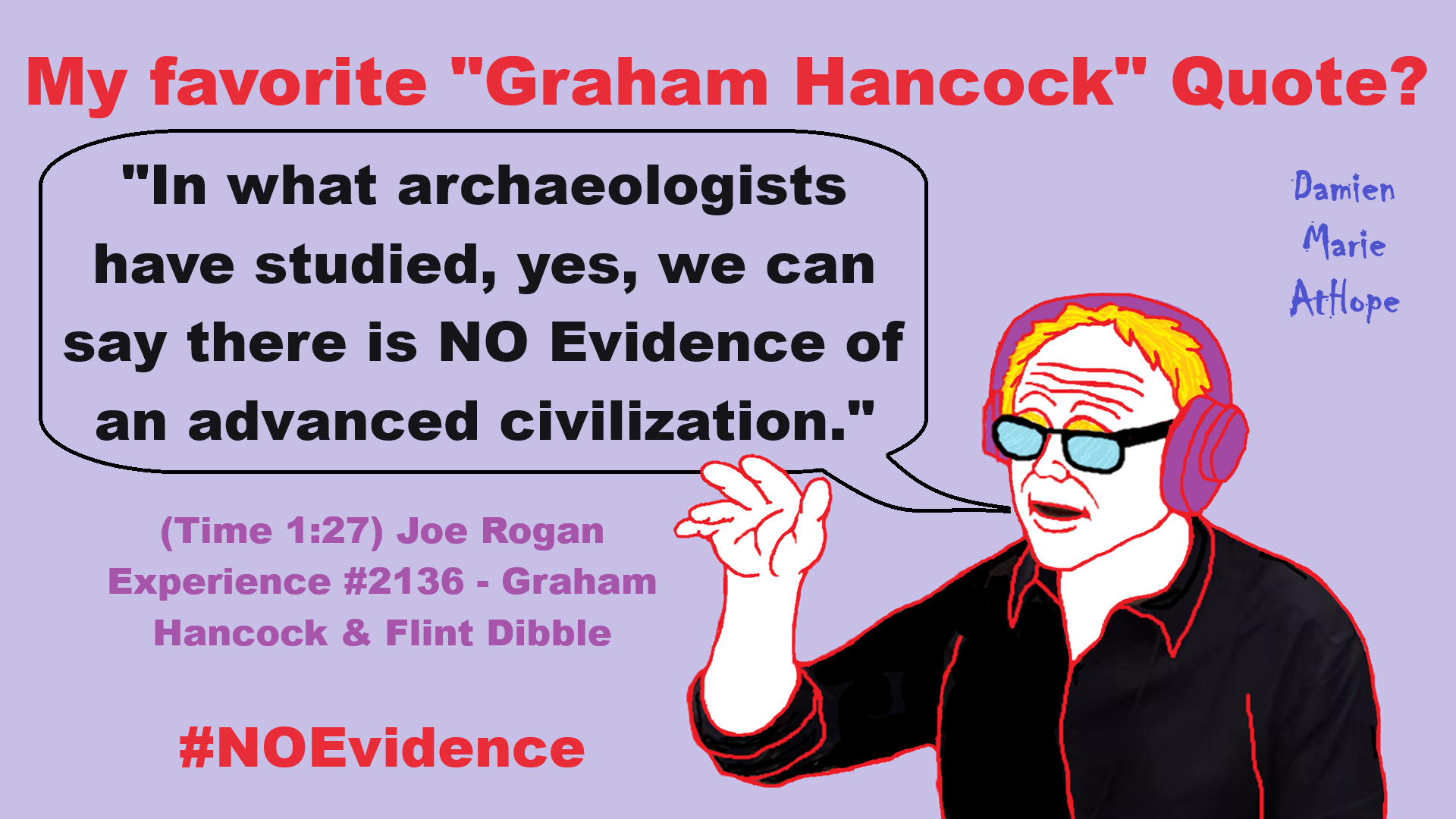
My favorite “Graham Hancock” Quote?
“In what archaeologists have studied, yes, we can say there is NO Evidence of an advanced civilization.” – (Time 1:27) Joe Rogan Experience #2136 – Graham Hancock & Flint Dibble

People don’t commonly teach religious history, even that of their own claimed religion. No, rather they teach a limited “pro their religion” history of their religion from a religious perspective favorable to the religion of choice.

Do you truly think “Religious Belief” is only a matter of some personal choice?
Do you not see how coercive one’s world of choice is limited to the obvious hereditary belief, in most religious choices available to the child of religious parents or caregivers? Religion is more commonly like a family, culture, society, etc. available belief that limits the belief choices of the child and that is when “Religious Belief” is not only a matter of some personal choice and when it becomes hereditary faith, not because of the quality of its alleged facts or proposed truths but because everyone else important to the child believes similarly so they do as well simply mimicking authority beliefs handed to them. Because children are raised in religion rather than being presented all possible choices but rather one limited dogmatic brand of “Religious Belief” where children only have a choice of following the belief as instructed, and then personally claim the faith hereditary belief seen in the confirming to the belief they have held themselves all their lives. This is obvious in statements asked and answered by children claiming a faith they barely understand but they do understand that their family believes “this or that” faith, so they feel obligated to believe it too. While I do agree that “Religious Belief” should only be a matter of some personal choice, it rarely is… End Hereditary Religion!

Animism: Respecting the Living World by Graham Harvey
“How have human cultures engaged with and thought about animals, plants, rocks, clouds, and other elements in their natural surroundings? Do animals and other natural objects have a spirit or soul? What is their relationship to humans? In this new study, Graham Harvey explores current and past animistic beliefs and practices of Native Americans, Maori, Aboriginal Australians, and eco-pagans. He considers the varieties of animism found in these cultures as well as their shared desire to live respectfully within larger natural communities. Drawing on his extensive casework, Harvey also considers the linguistic, performative, ecological, and activist implications of these different animisms.” ref

We are like believing machines we vacuum up ideas, like Velcro sticks to almost everything. We accumulate beliefs that we allow to negatively influence our lives, often without realizing it. Our willingness must be to alter skewed beliefs that impend our balance or reason, which allows us to achieve new positive thinking and accurate outcomes.

My thoughts on Religion Evolution with external links for more info:
- (Pre-Animism Africa mainly, but also Europe, and Asia at least 300,000 years ago), (Pre-Animism – Oxford Dictionaries)
- (Animism Africa around 100,000 years ago), (Animism – Britannica.com)
- (Totemism Europe around 50,000 years ago), (Totemism – Anthropology)
- (Shamanism Siberia around 30,000 years ago), (Shamanism – Britannica.com)
- (Paganism Turkey around 12,000 years ago), (Paganism – BBC Religion)
- (Progressed Organized Religion “Institutional Religion” Egypt around 5,000 years ago), (Ancient Egyptian Religion – Britannica.com)
- (CURRENT “World” RELIGIONS after 4,000 years ago) (Origin of Major Religions – Sacred Texts)
- (Early Atheistic Doubting at least by 2,600 years ago) (History of Atheism – Wikipedia)
“Religion is an Evolved Product” and Yes, Religion is Like Fear Given Wings…
Atheists talk about gods and religions for the same reason doctors talk about cancer, they are looking for a cure, or a firefighter talks about fires because they burn people and they care to stop them. We atheists too often feel a need to help the victims of mental slavery, held in the bondage that is the false beliefs of gods and the conspiracy theories of reality found in religions.
Understanding Religion Evolution:
- Pre-Animism (at least 300,000 years ago)
- Animism (Africa: 100,000 years ago)
- Totemism (Europe: 50,000 years ago)
- Shamanism (Siberia: 30,000 years ago)
- Paganism (Turkey: 12,000 years ago)
- Progressed organized religion (Egypt: 5,000 years ago), (Egypt, the First Dynasty 5,150 years ago)
- CURRENT “World” RELIGIONS (after 4,000 years ago)
- Early Atheistic Doubting (at least by 2,600 years ago)
“An Archaeological/Anthropological Understanding of Religion Evolution”
It seems ancient peoples had to survived amazing threats in a “dangerous universe (by superstition perceived as good and evil),” and human “immorality or imperfection of the soul” which was thought to affect the still living, leading to ancestor worship. This ancestor worship presumably led to the belief in supernatural beings, and then some of these were turned into the belief in gods. This feeble myth called gods were just a human conceived “made from nothing into something over and over, changing, again and again, taking on more as they evolve, all the while they are thought to be special,” but it is just supernatural animistic spirit-belief perceived as sacred.
Quick Evolution of Religion?
Pre-Animism (at least 300,000 years ago) pre-religion is a beginning that evolves into later Animism. So, Religion as we think of it, to me, all starts in a general way with Animism (Africa: 100,000 years ago) (theoretical belief in supernatural powers/spirits), then this is physically expressed in or with Totemism (Europe: 50,000 years ago) (theoretical belief in mythical relationship with powers/spirits through a totem item), which then enlists a full-time specific person to do this worship and believed interacting Shamanism (Siberia/Russia: 30,000 years ago) (theoretical belief in access and influence with spirits through ritual), and then there is the further employment of myths and gods added to all the above giving you Paganism (Turkey: 12,000 years ago) (often a lot more nature-based than most current top world religions, thus hinting to their close link to more ancient religious thinking it stems from). My hypothesis is expressed with an explanation of the building of a theatrical house (modern religions development). Progressed organized religion (Egypt: 5,000 years ago) with CURRENT “World” RELIGIONS (after 4,000 years ago).
Historically, in large city-state societies (such as Egypt or Iraq) starting around 5,000 years ago culminated to make religion something kind of new, a sociocultural-governmental-religious monarchy, where all or at least many of the people of such large city-state societies seem familiar with and committed to the existence of “religion” as the integrated life identity package of control dynamics with a fixed closed magical doctrine, but this juggernaut integrated religion identity package of Dogmatic-Propaganda certainly did not exist or if developed to an extent it was highly limited in most smaller prehistoric societies as they seem to lack most of the strong control dynamics with a fixed closed magical doctrine (magical beliefs could be at times be added or removed). Many people just want to see developed religious dynamics everywhere even if it is not. Instead, all that is found is largely fragments until the domestication of religion.
Religions, as we think of them today, are a new fad, even if they go back to around 6,000 years in the timeline of human existence, this amounts to almost nothing when seen in the long slow evolution of religion at least around 70,000 years ago with one of the oldest ritual worship. Stone Snake of South Africa: “first human worship” 70,000 years ago. This message of how religion and gods among them are clearly a man-made thing that was developed slowly as it was invented and then implemented peace by peace discrediting them all. Which seems to be a simple point some are just not grasping how devastating to any claims of truth when we can see the lie clearly in the archeological sites.
I wish people fought as hard for the actual values as they fight for the group/clan names political or otherwise they think support values. Every amount spent on war is theft to children in need of food or the homeless kept from shelter.
Here are several of my blog posts on history:
- To Find Truth You Must First Look
- (Magdalenian/Iberomaurusian) Connections to the First Paganists of the early Neolithic Near East Dating from around 17,000 to 12,000 Years Ago
- Natufians: an Ancient People at the Origins of Agriculture and Sedentary Life
- Possible Clan Leader/Special “MALE” Ancestor Totem Poles At Least 13,500 years ago?
- Jewish People with DNA at least 13,200 years old, Judaism, and the Origins of Some of its Ideas
- Baltic Reindeer Hunters: Swiderian, Lyngby, Ahrensburgian, and Krasnosillya cultures 12,020 to 11,020 years ago are evidence of powerful migratory waves during the last 13,000 years and a genetic link to Saami and the Finno-Ugric peoples.
- The Rise of Inequality: patriarchy and state hierarchy inequality
- Fertile Crescent 12,500 – 9,500 Years Ago: fertility and death cult belief system?
- 12,400 – 11,700 Years Ago – Kortik Tepe (Turkey) Pre/early-Agriculture Cultic Ritualism
- Ritualistic Bird Symbolism at Gobekli Tepe and its “Ancestor Cult”
- Male-Homosexual (female-like) / Trans-woman (female) Seated Figurine from Gobekli Tepe
- Could a 12,000-year-old Bull Geoglyph at Göbekli Tepe relate to older Bull and Female Art 25,000 years ago and Later Goddess and the Bull cults like Catal Huyuk?
- Sedentism and the Creation of goddesses around 12,000 years ago as well as male gods after 7,000 years ago.
- Alcohol, where Agriculture and Religion Become one? Such as Gobekli Tepe’s Ritualistic use of Grain as Food and Ritual Drink
- Neolithic Ritual Sites with T-Pillars and other Cultic Pillars
- Paganism: Goddesses around 12,000 years ago then Male Gods after 7,000 years ago
- First Patriarchy: Split of Women’s Status around 12,000 years ago & First Hierarchy: fall of Women’s Status around 5,000 years ago.
- Natufians: an Ancient People at the Origins of Agriculture and Sedentary Life
- J DNA and the Spread of Agricultural Religion (paganism)
- Paganism: an approximately 12,000-year-old belief system
- Paganism 12,000 years old: related to “Anarchism and Socialism” (Pre-Capitalism)
- Shaman burial in Israel 12,000 years ago and the Shamanism Phenomena
- Need to Mythicized: gods and goddesses
- 12,000 – 7,000 Years Ago – Paleo-Indian Culture (The Americas)
- 12,000 – 2,000 Years Ago – Indigenous-Scandinavians (Nordic)
- Norse did not wear helmets with horns?
- Pre-Pottery Neolithic Skull Cult around 11,500 to 8,400 Years Ago?
- 10,400 – 10,100 Years Ago, in Turkey the Nevail Cori Religious Settlement
- 9,000-6,500 Years Old Submerged Pre-Pottery/Pottery Neolithic Ritual Settlements off Israel’s Coast
- Catal Huyuk “first religious designed city” around 9,500 to 7,700 years ago (Turkey)
- Cultic Hunting at Catal Huyuk “first religious designed city”
- Special Items and Art as well as Special Elite Burials at Catal Huyuk
- New Rituals and Violence with the appearance of Pottery and People?
- Haplogroup N and its related Uralic Languages and Cultures
- Ainu people, Sámi people, Native Americans, the Ancient North Eurasians, and Paganistic-Shamanism with Totemism
- Ideas, Technology and People from Turkey, Europe, to China and Back again 9,000 to 5,000 years ago?
- First Pottery of Europe and the Related Cultures
- 9,000 years old Neolithic Artifacts Judean Desert and Hills Israel
- 9,000-7,000 years-old Sex and Death Rituals: Cult Sites in Israel, Jordan, and the Sinai
- 9,000-8500 year old Horned Female shaman Bad Dürrenberg Germany
- Neolithic Jewelry and the Spread of Farming in Europe Emerging out of West Turkey
- 8,600-year-old Tortoise Shells in Neolithic graves in central China have Early Writing and Shamanism
- Swing of the Mace: the rise of Elite, Forced Authority, and Inequality begin to Emerge 8,500 years ago?
- Migrations and Changing Europeans Beginning around 8,000 Years Ago
- My “Steppe-Anatolian-Kurgan hypothesis” 8,000/7,000 years ago
- Around 8,000-year-old Shared Idea of the Mistress of Animals, “Ritual” Motif
- Pre-Columbian Red-Paint (red ochre) Maritime Archaic Culture 8,000-3,000 years ago
- 7,522-6,522 years ago Linear Pottery culture which I think relates to Arcane Capitalism’s origins
- Arcane Capitalism: Primitive socialism, Primitive capital, Private ownership, Means of production, Market capitalism, Class discrimination, and Petite bourgeoisie (smaller capitalists)
- 7,500-4,750 years old Ritualistic Cucuteni-Trypillian culture of Moldova, Romania, and Ukraine
- Roots of a changing early society 7,200-6,700 years ago Jordan and Israel
- Agriculture religion (Paganism) with farming reached Britain between about 7,000 to 6,500 or so years ago and seemingly expressed in things like Western Europe’s Long Barrows
- My Thoughts on Possible Migrations of “R” DNA and Proto-Indo-European?
- “Millet” Spreading from China 7,022 years ago to Europe and related Language may have Spread with it leading to Proto-Indo-European
- Proto-Indo-European (PIE), ancestor of Indo-European languages: DNA, Society, Language, and Mythology
- The Dnieper–Donets culture and Asian varieties of Millet from China to the Black Sea region of Europe by 7,022 years ago
- Kurgan 6,000 years ago/dolmens 7,000 years ago: funeral, ritual, and other?
- 7,020 to 6,020-year-old Proto-Indo-European Homeland of Urheimat or proposed home of their Language and Religion
- Ancient Megaliths: Kurgan, Ziggurat, Pyramid, Menhir, Trilithon, Dolman, Kromlech, and Kromlech of Trilithons
- The Mytheme of Ancient North Eurasian Sacred-Dog belief and similar motifs are found in Indo-European, Native American, and Siberian comparative mythology
- Elite Power Accumulation: Ancient Trade, Tokens, Writing, Wealth, Merchants, and Priest-Kings
- Sacred Mounds, Mountains, Kurgans, and Pyramids may hold deep connections?
- Between 7,000-5,000 Years ago, rise of unequal hierarchy elite, leading to a “birth of the State” or worship of power, strong new sexism, oppression of non-elites, and the fall of Women’s equal status
- Paganism 7,000-5,000 years old: related to “Anarchism and Socialism” (Capitalism) (World War 0) Elite & their slaves
- Hell and Underworld mythologies starting maybe as far back as 7,000 to 5,000 years ago with the Proto-Indo-Europeans?
- The First Expression of the Male God around 7,000 years ago?
- White (light complexion skin) Bigotry and Sexism started 7,000 years ago?
- Around 7,000-year-old Shared Idea of the Divine Bird (Tutelary and/or Trickster spirit/deity), “Ritual” Motif
- Nekhbet an Ancient Egyptian Vulture Goddess and Tutelary Deity
- 6,720 to 4,920 years old Ritualistic Hongshan Culture of Inner Mongolia with 5,000-year-old Pyramid Mounds and Temples
- First proto-king in the Balkans, Varna culture around 6,500 years ago?
- 6,500–5,800 years ago in Israel Late Chalcolithic (Copper Age) Period in the Southern Levant Seems to Express Northern Levant Migrations, Cultural and Religious Transfer
- KING OF BEASTS: Master of Animals “Ritual” Motif, around 6,000 years old or older…
- Around 6000-year-old Shared Idea of the Solid Wheel & the Spoked Wheel-Shaped Ritual Motif
- “The Ghassulian Star,” a mysterious 6,000-year-old mural from Jordan; a Proto-Star of Ishtar, Star of Inanna or Star of Venus?
- Religious/Ritual Ideas, including goddesses and gods as well as ritual mounds or pyramids from Northeastern Asia at least 6,000 years old, seemingly filtering to Iran, Iraq, the Mediterranean, Europe, Egypt, and the Americas?
- Maykop (5,720–5,020 years ago) Caucasus region Bronze Age culture-related to Copper Age farmers from the south, influenced by the Ubaid period and Leyla-Tepe culture, as well as influencing the Kura-Araxes culture
- 5-600-year-old Tomb, Mummy, and First Bearded Male Figurine in a Grave
- Kura-Araxes Cultural 5,520 to 4,470 years old DNA traces to the Canaanites, Arabs, and Jews
- Minoan/Cretan (Keftiu) Civilization and Religion around 5,520 to 3,120 years ago
- Evolution Of Science at least by 5,500 years ago
- 5,500 Years old birth of the State, the rise of Hierarchy, and the fall of Women’s status
- “Jiroft culture” 5,100 – 4,200 years ago and the History of Iran
- Stonehenge: Paganistic Burial and Astrological Ritual Complex, England (5,100-3,600 years ago)
- Around 5,000-year-old Shared Idea of the “Tree of Life” Ritual Motif
- Complex rituals for elite, seen from China to Egypt, at least by 5,000 years ago
- Around 5,000 years ago: “Birth of the State” where Religion gets Military Power and Influence
- The Center of the World “Axis Mundi” and/or “Sacred Mountains” Mythology Could Relate to the Altai Mountains, Heart of the Steppe
- Progressed organized religion starts, an approximately 5,000-year-old belief system
- China’s Civilization between 5,000-3,000 years ago, was a time of war and class struggle, violent transition from free clans to a Slave or Elite society
- Origin of Logics is Naturalistic Observation at least by around 5,000 years ago.
- Paganism 5,000 years old: progressed organized religion and the state: related to “Anarchism and Socialism” (Kings and the Rise of the State)
- Ziggurats (multi-platform temples: 4,900 years old) to Pyramids (multi-platform tombs: 4,700 years old)
- Did a 4,520–4,420-year-old Volcano In Turkey Inspire the Bible God?
- Finland’s Horned Shaman and Pre-Horned-God at least 4,500 years ago?
- 4,000-year-Old Dolmens in Israel: A Connected Dolmen Religious Phenomenon?
- Creation myths: From chaos, Ex nihilo, Earth-diver, Emergence, World egg, and World parent
- Bronze Age “Ritual” connections of the Bell Beaker culture with the Corded Ware/Single Grave culture, which were related to the Yamnaya culture and Proto-Indo-European Languages/Religions
- Low Gods (Earth/ Tutelary deity), High Gods (Sky/Supreme deity), and Moralistic Gods (Deity enforcement/divine order)
- The exchange of people, ideas, and material-culture including, to me, the new god (Sky Father) and goddess (Earth Mother) religion between the Cucuteni-Trypillians and others which is then spread far and wide
- Koryaks: Indigenous People of the Russian Far East and Big Raven myths also found in Tlingit, Haida, Tsimshian, and other Indigenous People of North America
- 42 Principles Of Maat (Egyptian Goddess of the justice) around 4,400 years ago, 2000 Years Before Ten Commandments
- “Happy Easter” Well Happy Eostre/Ishter
- 4,320-3,820 years old “Shimao” (North China) site with Totemistic-Shamanistic Paganism and a Stepped Pyramid
- 4,250 to 3,400 Year old Stonehenge from Russia: Arkaim?
- 4,100-year-old beaker with medicinal & flowering plants in a grave of a woman in Scotland
- Early European Farmer ancestry, Kelif el Boroud people with the Cardial Ware culture, and the Bell Beaker culture Paganists too, spread into North Africa, then to the Canary Islands off West Africa
- Flood Accounts: Gilgamesh epic (4,100 years ago) Noah in Genesis (2,600 years ago)
- Paganism 4,000 years old: related to “Anarchism and Socialism” (First Moralistic gods, then the Origin time of Monotheism)
- When was the beginning: TIMELINE OF CURRENT RELIGIONS, which start around 4,000 years ago.
- Early Religions Thought to Express Proto-Monotheistic Systems around 4,000 years ago
- Kultepe? An archaeological site with a 4,000 years old women’s rights document.
- Single God Religions (Monotheism) = “Man-o-theism” started around 4,000 years ago with the Great Sky Spirit/God Tiān (天)?
- Confucianism’s Tiān (Shangdi god 4,000 years old): Supernaturalism, Pantheism or Theism?
- Yes, Your Male God is Ridiculous
- Mythology, a Lunar Deity is a Goddess or God of the Moon
- Sacred Land, Hills, and Mountains: Sami Mythology (Paganistic Shamanism)
- Horse Worship/Sacrifice: mythical union of Ruling Elite/Kingship and the Horse
- The Amorite/Amurru people’s God Amurru “Lord of the Steppe”, relates to the Origins of the Bible God?
- Bronze Age Exotic Trade Routes Spread Quite Far as well as Spread Religious Ideas with Them
- Sami and the Northern Indigenous Peoples Landscape, Language, and its Connection to Religion
- Prototype of Ancient Analemmatic Sundials around 3,900-3,150 years ago and a Possible Solar Connection to gods?
- Judaism is around 3,450 or 3,250 years old. (“Paleo-Hebrew” 3,000 years ago and Torah 2,500 years ago)
- The Weakening of Ancient Trade and the Strengthening of Religions around 3000 years ago?
- Are you aware that there are religions that worship women gods, explain now religion tears women down?
- Animistic, Totemistic, and Paganistic Superstition Origins of bible god and the bible’s Religion.
- Myths and Folklore: “Trickster gods and goddesses”
- Jews, Judaism, and the Origins of Some of its Ideas
- An Old Branch of Religion Still Giving Fruit: Sacred Trees
- Dating the BIBLE: naming names and telling times (written less than 3,000 years ago, provable to 2,200 years ago)
- Did a Volcano Inspire the bible god?
- Dené–Yeniseian language, Old Copper Complex, and Pre-Columbian Mound Builders?
- No “dinosaurs and humans didn’t exist together just because some think they are in the bible itself”
- Sacred Shit and Sacred Animals?
- Everyone Killed in the Bible Flood? “Nephilim” (giants)?
- Hey, Damien dude, I have a question for you regarding “the bible” Exodus.
- Archaeology Disproves the Bible
- Bible Battle, Just More, Bible Babble
- The Jericho Conquest lie?
- Canaanites and Israelites?
- Accurate Account on how did Christianity Began?
- Let’s talk about Christianity.
- So the 10 commandments isn’t anything to go by either right?
- Misinformed christian
- Debunking Jesus?
- Paulism vs Jesus
- Ok, you seem confused so let’s talk about Buddhism.
- Unacknowledged Buddhism: Gods, Savior, Demons, Rebirth, Heavens, Hells, and Terrorism
- His Foolishness The Dalai Lama
- Yin and Yang is sexist with an ORIGIN around 2,300 years ago?
- I Believe Archaeology, not Myths & Why Not, as the Religious Myths Already Violate Reason!
- Archaeological, Scientific, & Philosophic evidence shows the god myth is man-made nonsense.
- Aquatic Ape Theory/Hypothesis? As Always, Just Pseudoscience.
- Ancient Aliens Conspiracy Theorists are Pseudohistorians
- The Pseudohistoric and Pseudoscientific claims about “Bakoni Ruins” of South Africa
- Why do people think Religion is much more than supernaturalism and superstitionism?
- Religion is an Evolved Product
- Was the Value of Ancient Women Different?
- 1000 to 1100 CE, human sacrifice Cahokia Mounds a pre-Columbian Native American site
- Feminist atheists as far back as the 1800s?
- Promoting Religion as Real is Mentally Harmful to a Flourishing Humanity
- Screw All Religions and Their Toxic lies, they are all fraud
- Forget Religions’ Unfounded Myths, I Have Substantiated “Archaeology Facts.”
- Religion Dispersal throughout the World
- I Hate Religion Just as I Hate all Pseudoscience
- Exposing Scientology, Eckankar, Wicca and Other Nonsense?
- Main deity or religious belief systems
- Quit Trying to Invent Your God From the Scraps of Science.
- Archaeological, Scientific, & Philosophic evidence shows the god myth is man-made nonsense.
- Ancient Alien Conspiracy Theorists: Misunderstanding, Rhetoric, Misinformation, Fabrications, and Lies
- Misinformation, Distortion, and Pseudoscience in Talking with a Christian Creationist
- Judging the Lack of Goodness in Gods, Even the Norse God Odin
- Challenging the Belief in God-like Aliens and Gods in General
- A Challenge to Christian use of Torture Devices?
- Yes, Hinduism is a Religion
- Trump is One of the Most Reactionary Forces of Far-right Christian Extremism
- Was the Bull Head a Symbol of God? Yes!
- Primate Death Rituals
- Christian – “God and Christianity are objectively true”
- Australopithecus afarensis Death Ritual?
- You Claim Global Warming is a Hoax?
- Doubter of Science and Defamer of Atheists?
- I think that sounds like the Bible?
- History of the Antifa (“anti-fascist”) Movements
- Indianapolis Anti-Blasphemy Laws #Free Soheil Rally
- Damien, you repeat the golden rule in so many forms then you say religion is dogmatic?
- Science is a Trustable Methodology whereas Faith is not Trustable at all!
- Was I ever a believer, before I was an atheist?
- Atheists rise in reason
- Mistrust of science?
- Open to Talking About the Definition of ‘God’? But first, we address Faith.
- ‘United Monarchy’ full of splendor and power – Saul, David, and Solomon? Most likely not.
- Is there EXODUS ARCHAEOLOGY? The short answer is “no.”
- Lacking Proof of Bigfoots, Unicorns, and Gods is Just a Lack of Research?
- Religion and Politics: Faith Beliefs vs. Rational Thinking
- Hammer of Truth that lying pig RELIGION: challenged by an archaeologist
- “The Hammer of Truth” -ontology question- What do You Mean by That?
- Navigation of a bad argument: Ad Hominem vs. Attack
- Why is it Often Claimed that Gods have a Gender?
- Why are basically all monotheistic religions ones that have a male god?
- Shifting through the Claims in support of Faith
- Dear Mr. AtHope, The 20th Century is an Indictment of Secularism and a Failed Atheist Century
- An Understanding of the Worldwide Statistics and Dynamics of Terrorist Incidents and Suicide Attacks
- Intoxication and Evolution? Addressing and Assessing the “Stoned Ape” or “Drunken Monkey” Theories as Catalysts in Human Evolution
- Sacred Menstrual cloth? Inanna’s knot, Isis knot, and maybe Ma’at’s feather?
- Damien, why don’t the Hebrews accept the bible stories?
- Dealing with a Troll and Arguing Over Word Meaning
- Knowledge without Belief? Justified beliefs or disbeliefs worthy of Knowledge?
- Afrocentrism and African Religions
- Crecganford @crecganford offers history & stories of the people, places, gods, & culture
- Empiricism-Denier?
I am not an academic. I am a revolutionary that teaches in public, in places like social media, and in the streets. I am not a leader by some title given but from my commanding leadership style of simply to start teaching everywhere to everyone, all manner of positive education.



To me, Animism starts in Southern Africa, then to West Europe, and becomes Totemism. Another split goes near the Russia and Siberia border becoming Shamanism, which heads into Central Europe meeting up with Totemism, which also had moved there, mixing the two which then heads to Lake Baikal in Siberia. From there this Shamanism-Totemism heads to Turkey where it becomes Paganism.





Not all “Religions” or “Religious Persuasions” have a god(s) but
All can be said to believe in some imaginary beings or imaginary things like spirits, afterlives, etc.

Paganism 12,000-4,000 years old
12,000-7,000 years old: related to (Pre-Capitalism)
7,000-5,000 years old: related to (Capitalism) (World War 0) Elite and their slaves!
5,000 years old: related to (Kings and the Rise of the State)
4,000 years old: related to (First Moralistic gods, then the Origin time of Monotheism)

ref, ref, ref, ref, ref, ref, ref, ref, ref, ref, ref, ref, ref, ref, ref, ref, ref, ref, ref, ref, ref
Low Gods “Earth” or Tutelary deity and High Gods “Sky” or Supreme deity
“An Earth goddess is a deification of the Earth. Earth goddesses are often associated with the “chthonic” deities of the underworld. Ki and Ninhursag are Mesopotamian earth goddesses. In Greek mythology, the Earth is personified as Gaia, corresponding to Roman Terra, Indic Prithvi/Bhūmi, etc. traced to an “Earth Mother” complementary to the “Sky Father” in Proto-Indo-European religion. Egyptian mythology exceptionally has a sky goddess and an Earth god.” ref
“A mother goddess is a goddess who represents or is a personification of nature, motherhood, fertility, creation, destruction or who embodies the bounty of the Earth. When equated with the Earth or the natural world, such goddesses are sometimes referred to as Mother Earth or as the Earth Mother. In some religious traditions or movements, Heavenly Mother (also referred to as Mother in Heaven or Sky Mother) is the wife or feminine counterpart of the Sky father or God the Father.” ref
“Any masculine sky god is often also king of the gods, taking the position of patriarch within a pantheon. Such king gods are collectively categorized as “sky father” deities, with a polarity between sky and earth often being expressed by pairing a “sky father” god with an “earth mother” goddess (pairings of a sky mother with an earth father are less frequent). A main sky goddess is often the queen of the gods and may be an air/sky goddess in her own right, though she usually has other functions as well with “sky” not being her main. In antiquity, several sky goddesses in ancient Egypt, Mesopotamia, and the Near East were called Queen of Heaven. Neopagans often apply it with impunity to sky goddesses from other regions who were never associated with the term historically. The sky often has important religious significance. Many religions, both polytheistic and monotheistic, have deities associated with the sky.” ref
“In comparative mythology, sky father is a term for a recurring concept in polytheistic religions of a sky god who is addressed as a “father”, often the father of a pantheon and is often either a reigning or former King of the Gods. The concept of “sky father” may also be taken to include Sun gods with similar characteristics, such as Ra. The concept is complementary to an “earth mother“. “Sky Father” is a direct translation of the Vedic Dyaus Pita, etymologically descended from the same Proto-Indo-European deity name as the Greek Zeûs Pater and Roman Jupiter and Germanic Týr, Tir or Tiwaz, all of which are reflexes of the same Proto-Indo-European deity’s name, *Dyēus Ph₂tḗr. While there are numerous parallels adduced from outside of Indo-European mythology, there are exceptions (e.g. In Egyptian mythology, Nut is the sky mother and Geb is the earth father).” ref
Tutelary deity
“A tutelary (also tutelar) is a deity or spirit who is a guardian, patron, or protector of a particular place, geographic feature, person, lineage, nation, culture, or occupation. The etymology of “tutelary” expresses the concept of safety and thus of guardianship. In late Greek and Roman religion, one type of tutelary deity, the genius, functions as the personal deity or daimon of an individual from birth to death. Another form of personal tutelary spirit is the familiar spirit of European folklore.” ref
“A tutelary (also tutelar) in Korean shamanism, jangseung and sotdae were placed at the edge of villages to frighten off demons. They were also worshiped as deities. Seonangshin is the patron deity of the village in Korean tradition and was believed to embody the Seonangdang. In Philippine animism, Diwata or Lambana are deities or spirits that inhabit sacred places like mountains and mounds and serve as guardians. Such as: Maria Makiling is the deity who guards Mt. Makiling and Maria Cacao and Maria Sinukuan. In Shinto, the spirits, or kami, which give life to human bodies come from nature and return to it after death. Ancestors are therefore themselves tutelaries to be worshiped. And similarly, Native American beliefs such as Tonás, tutelary animal spirit among the Zapotec and Totems, familial or clan spirits among the Ojibwe, can be animals.” ref
“A tutelary (also tutelar) in Austronesian beliefs such as: Atua (gods and spirits of the Polynesian peoples such as the Māori or the Hawaiians), Hanitu (Bunun of Taiwan‘s term for spirit), Hyang (Kawi, Sundanese, Javanese, and Balinese Supreme Being, in ancient Java and Bali mythology and this spiritual entity, can be either divine or ancestral), Kaitiaki (New Zealand Māori term used for the concept of guardianship, for the sky, the sea, and the land), Kawas (mythology) (divided into 6 groups: gods, ancestors, souls of the living, spirits of living things, spirits of lifeless objects, and ghosts), Tiki (Māori mythology, Tiki is the first man created by either Tūmatauenga or Tāne and represents deified ancestors found in most Polynesian cultures). ” ref, ref, ref, ref, ref, ref, ref
Mesopotamian Tutelary Deities can be seen as ones related to City-States
“Historical city-states included Sumerian cities such as Uruk and Ur; Ancient Egyptian city-states, such as Thebes and Memphis; the Phoenician cities (such as Tyre and Sidon); the five Philistine city-states; the Berber city-states of the Garamantes; the city-states of ancient Greece (the poleis such as Athens, Sparta, Thebes, and Corinth); the Roman Republic (which grew from a city-state into a vast empire); the Italian city-states from the Middle Ages to the early modern period, such as Florence, Siena, Ferrara, Milan (which as they grew in power began to dominate neighboring cities) and Genoa and Venice, which became powerful thalassocracies; the Mayan and other cultures of pre-Columbian Mesoamerica (including cities such as Chichen Itza, Tikal, Copán and Monte Albán); the central Asian cities along the Silk Road; the city-states of the Swahili coast; Ragusa; states of the medieval Russian lands such as Novgorod and Pskov; and many others.” ref
“The Uruk period (ca. 4000 to 3100 BCE; also known as Protoliterate period) of Mesopotamia, named after the Sumerian city of Uruk, this period saw the emergence of urban life in Mesopotamia and the Sumerian civilization. City-States like Uruk and others had a patron tutelary City Deity along with a Priest-King.” ref
“Chinese folk religion, both past, and present, includes myriad tutelary deities. Exceptional individuals, highly cultivated sages, and prominent ancestors can be deified and honored after death. Lord Guan is the patron of military personnel and police, while Mazu is the patron of fishermen and sailors. Such as Tu Di Gong (Earth Deity) is the tutelary deity of a locality, and each individual locality has its own Earth Deity and Cheng Huang Gong (City God) is the guardian deity of an individual city, worshipped by local officials and locals since imperial times.” ref
“A tutelary (also tutelar) in Hinduism, personal tutelary deities are known as ishta-devata, while family tutelary deities are known as Kuladevata. Gramadevata are guardian deities of villages. Devas can also be seen as tutelary. Shiva is the patron of yogis and renunciants. City goddesses include: Mumbadevi (Mumbai), Sachchika (Osian); Kuladevis include: Ambika (Porwad), and Mahalakshmi. In NorthEast India Meitei mythology and religion (Sanamahism) of Manipur, there are various types of tutelary deities, among which Lam Lais are the most predominant ones. Tibetan Buddhism has Yidam as a tutelary deity. Dakini is the patron of those who seek knowledge.” ref
“A tutelary (also tutelar) The Greeks also thought deities guarded specific places: for instance, Athena was the patron goddess of the city of Athens. Socrates spoke of hearing the voice of his personal spirit or daimonion:
You have often heard me speak of an oracle or sign which comes to me … . This sign I have had ever since I was a child. The sign is a voice which comes to me and always forbids me to do something which I am going to do, but never commands me to do anything, and this is what stands in the way of my being a politician.” ref
“Tutelary deities who guard and preserve a place or a person are fundamental to ancient Roman religion. The tutelary deity of a man was his Genius, that of a woman her Juno. In the Imperial era, the Genius of the Emperor was a focus of Imperial cult. An emperor might also adopt a major deity as his personal patron or tutelary, as Augustus did Apollo. Precedents for claiming the personal protection of a deity were established in the Republican era, when for instance the Roman dictator Sulla advertised the goddess Victory as his tutelary by holding public games (ludi) in her honor.” ref
“Each town or city had one or more tutelary deities, whose protection was considered particularly vital in time of war and siege. Rome itself was protected by a goddess whose name was to be kept ritually secret on pain of death (for a supposed case, see Quintus Valerius Soranus). The Capitoline Triad of Juno, Jupiter, and Minerva were also tutelaries of Rome. The Italic towns had their own tutelary deities. Juno often had this function, as at the Latin town of Lanuvium and the Etruscan city of Veii, and was often housed in an especially grand temple on the arx (citadel) or other prominent or central location. The tutelary deity of Praeneste was Fortuna, whose oracle was renowned.” ref
“The Roman ritual of evocatio was premised on the belief that a town could be made vulnerable to military defeat if the power of its tutelary deity were diverted outside the city, perhaps by the offer of superior cult at Rome. The depiction of some goddesses such as the Magna Mater (Great Mother, or Cybele) as “tower-crowned” represents their capacity to preserve the city. A town in the provinces might adopt a deity from within the Roman religious sphere to serve as its guardian, or syncretize its own tutelary with such; for instance, a community within the civitas of the Remi in Gaul adopted Apollo as its tutelary, and at the capital of the Remi (present-day Rheims), the tutelary was Mars Camulus.” ref
Household deity (a kind of or related to a Tutelary deity)
“A household deity is a deity or spirit that protects the home, looking after the entire household or certain key members. It has been a common belief in paganism as well as in folklore across many parts of the world. Household deities fit into two types; firstly, a specific deity – typically a goddess – often referred to as a hearth goddess or domestic goddess who is associated with the home and hearth, such as the ancient Greek Hestia.” ref
“The second type of household deities are those that are not one singular deity, but a type, or species of animistic deity, who usually have lesser powers than major deities. This type was common in the religions of antiquity, such as the Lares of ancient Roman religion, the Gashin of Korean shamanism, and Cofgodas of Anglo-Saxon paganism. These survived Christianisation as fairy-like creatures existing in folklore, such as the Anglo-Scottish Brownie and Slavic Domovoy.” ref
“Household deities were usually worshipped not in temples but in the home, where they would be represented by small idols (such as the teraphim of the Bible, often translated as “household gods” in Genesis 31:19 for example), amulets, paintings, or reliefs. They could also be found on domestic objects, such as cosmetic articles in the case of Tawaret. The more prosperous houses might have a small shrine to the household god(s); the lararium served this purpose in the case of the Romans. The gods would be treated as members of the family and invited to join in meals, or be given offerings of food and drink.” ref
“In many religions, both ancient and modern, a god would preside over the home. Certain species, or types, of household deities, existed. An example of this was the Roman Lares. Many European cultures retained house spirits into the modern period. Some examples of these include:
- Brownie (Scotland and England) or Hob (England) / Kobold (Germany) / Goblin / Hobgoblin
- Domovoy (Slavic)
- Nisse (Norwegian or Danish) / Tomte (Swedish) / Tonttu (Finnish)
- Húsvættir (Norse)” ref
“Although the cosmic status of household deities was not as lofty as that of the Twelve Olympians or the Aesir, they were also jealous of their dignity and also had to be appeased with shrines and offerings, however humble. Because of their immediacy they had arguably more influence on the day-to-day affairs of men than the remote gods did. Vestiges of their worship persisted long after Christianity and other major religions extirpated nearly every trace of the major pagan pantheons. Elements of the practice can be seen even today, with Christian accretions, where statues to various saints (such as St. Francis) protect gardens and grottos. Even the gargoyles found on older churches, could be viewed as guardians partitioning a sacred space.” ref
“For centuries, Christianity fought a mop-up war against these lingering minor pagan deities, but they proved tenacious. For example, Martin Luther‘s Tischreden have numerous – quite serious – references to dealing with kobolds. Eventually, rationalism and the Industrial Revolution threatened to erase most of these minor deities, until the advent of romantic nationalism rehabilitated them and embellished them into objects of literary curiosity in the 19th century. Since the 20th century this literature has been mined for characters for role-playing games, video games, and other fantasy personae, not infrequently invested with invented traits and hierarchies somewhat different from their mythological and folkloric roots.” ref
“In contradistinction to both Herbert Spencer and Edward Burnett Tylor, who defended theories of animistic origins of ancestor worship, Émile Durkheim saw its origin in totemism. In reality, this distinction is somewhat academic, since totemism may be regarded as a particularized manifestation of animism, and something of a synthesis of the two positions was attempted by Sigmund Freud. In Freud’s Totem and Taboo, both totem and taboo are outward expressions or manifestations of the same psychological tendency, a concept which is complementary to, or which rather reconciles, the apparent conflict. Freud preferred to emphasize the psychoanalytic implications of the reification of metaphysical forces, but with particular emphasis on its familial nature. This emphasis underscores, rather than weakens, the ancestral component.” ref
“William Edward Hearn, a noted classicist, and jurist, traced the origin of domestic deities from the earliest stages as an expression of animism, a belief system thought to have existed also in the neolithic, and the forerunner of Indo-European religion. In his analysis of the Indo-European household, in Chapter II “The House Spirit”, Section 1, he states:
The belief which guided the conduct of our forefathers was … the spirit rule of dead ancestors.” ref
“In Section 2 he proceeds to elaborate:
It is thus certain that the worship of deceased ancestors is a vera causa, and not a mere hypothesis. …
In the other European nations, the Slavs, the Teutons, and the Kelts, the House Spirit appears with no less distinctness. … [T]he existence of that worship does not admit of doubt. … The House Spirits had a multitude of other names which it is needless here to enumerate, but all of which are more or less expressive of their friendly relations with man. … In [England] … [h]e is the Brownie. … In Scotland this same Brownie is well known. He is usually described as attached to particular families, with whom he has been known to reside for centuries, threshing the corn, cleaning the house, and performing similar household tasks. His favorite gratification was milk and honey.” ref

ref, ref, ref, ref, ref, ref, ref, ref, ref, ref, ref, ref, ref, ref, ref, ref, ref
“These ideas are my speculations from the evidence.”
I am still researching the “god‘s origins” all over the world. So you know, it is very complicated but I am smart and willing to look, DEEP, if necessary, which going very deep does seem to be needed here, when trying to actually understand the evolution of gods and goddesses. I am sure of a few things and less sure of others, but even in stuff I am not fully grasping I still am slowly figuring it out, to explain it to others. But as I research more I am understanding things a little better, though I am still working on understanding it all or something close and thus always figuring out more.
Sky Father/Sky God?
“Egyptian: (Nut) Sky Mother and (Geb) Earth Father” (Egypt is different but similar)
Turkic/Mongolic: (Tengri/Tenger Etseg) Sky Father and (Eje/Gazar Eej) Earth Mother *Transeurasian*
Hawaiian: (Wākea) Sky Father and (Papahānaumoku) Earth Mother *Austronesian*
New Zealand/ Māori: (Ranginui) Sky Father and (Papatūānuku) Earth Mother *Austronesian*
Proto-Indo-European: (Dyḗus/Dyḗus ph₂tḗr) Sky Father and (Dʰéǵʰōm/Pleth₂wih₁) Earth Mother
Indo-Aryan: (Dyaus Pita) Sky Father and (Prithvi Mata) Earth Mother *Indo-European*
Italic: (Jupiter) Sky Father and (Juno) Sky Mother *Indo-European*
Etruscan: (Tinia) Sky Father and (Uni) Sky Mother *Tyrsenian/Italy Pre–Indo-European*
Hellenic/Greek: (Zeus) Sky Father and (Hera) Sky Mother who started as an “Earth Goddess” *Indo-European*
Nordic: (Dagr) Sky Father and (Nótt) Sky Mother *Indo-European*
Slavic: (Perun) Sky Father and (Mokosh) Earth Mother *Indo-European*
Illyrian: (Deipaturos) Sky Father and (Messapic Damatura’s “earth-mother” maybe) Earth Mother *Indo-European*
Albanian: (Zojz) Sky Father and (?) *Indo-European*
Baltic: (Perkūnas) Sky Father and (Saulė) Sky Mother *Indo-European*
Germanic: (Týr) Sky Father and (?) *Indo-European*
Colombian-Muisca: (Bochica) Sky Father and (Huythaca) Sky Mother *Chibchan*
Aztec: (Quetzalcoatl) Sky Father and (Xochiquetzal) Sky Mother *Uto-Aztecan*
Incan: (Viracocha) Sky Father and (Mama Runtucaya) Sky Mother *Quechuan*
China: (Tian/Shangdi) Sky Father and (Dì) Earth Mother *Sino-Tibetan*
Sumerian, Assyrian and Babylonian: (An/Anu) Sky Father and (Ki) Earth Mother
Finnish: (Ukko) Sky Father and (Akka) Earth Mother *Finno-Ugric*
Sami: (Horagalles) Sky Father and (Ravdna) Earth Mother *Finno-Ugric*
Puebloan-Zuni: (Ápoyan Ta’chu) Sky Father and (Áwitelin Tsíta) Earth Mother
Puebloan-Hopi: (Tawa) Sky Father and (Kokyangwuti/Spider Woman/Grandmother) Earth Mother *Uto-Aztecan*
Puebloan-Navajo: (Tsohanoai) Sky Father and (Estsanatlehi) Earth Mother *Na-Dene*
ref, ref, ref, ref, ref, ref, ref, ref, ref, ref, ref, ref, ref, ref, ref, ref, ref, ref, ref, ref, ref, ref, ref, ref, ref, ref, ref

Hinduism around 3,700 to 3,500 years old. ref
Judaism around 3,450 or 3,250 years old. (The first writing in the bible was “Paleo-Hebrew” dated to around 3,000 years ago Khirbet Qeiyafa is the site of an ancient fortress city overlooking the Elah Valley. And many believe the religious Jewish texts were completed around 2,500) ref, ref
Judaism is around 3,450 or 3,250 years old. (“Paleo-Hebrew” 3,000 years ago and Torah 2,500 years ago)
“Judaism is an Abrahamic, its roots as an organized religion in the Middle East during the Bronze Age. Some scholars argue that modern Judaism evolved from Yahwism, the religion of ancient Israel and Judah, by the late 6th century BCE, and is thus considered to be one of the oldest monotheistic religions.” ref
“Yahwism is the name given by modern scholars to the religion of ancient Israel, essentially polytheistic, with a plethora of gods and goddesses. Heading the pantheon was Yahweh, the national god of the Israelite kingdoms of Israel and Judah, with his consort, the goddess Asherah; below them were second-tier gods and goddesses such as Baal, Shamash, Yarikh, Mot, and Astarte, all of whom had their own priests and prophets and numbered royalty among their devotees, and a third and fourth tier of minor divine beings, including the mal’ak, the messengers of the higher gods, who in later times became the angels of Judaism, Christianity and Islam. Yahweh, however, was not the ‘original’ god of Israel “Isra-El”; it is El, the head of the Canaanite pantheon, whose name forms the basis of the name “Israel”, and none of the Old Testament patriarchs, the tribes of Israel, the Judges, or the earliest monarchs, have a Yahwistic theophoric name (i.e., one incorporating the name of Yahweh).” ref
“El is a Northwest Semitic word meaning “god” or “deity“, or referring (as a proper name) to any one of multiple major ancient Near Eastern deities. A rarer form, ‘ila, represents the predicate form in Old Akkadian and in Amorite. The word is derived from the Proto-Semitic *ʔil-, meaning “god”. Specific deities known as ‘El or ‘Il include the supreme god of the ancient Canaanite religion and the supreme god of East Semitic speakers in Mesopotamia’s Early Dynastic Period. ʼĒl is listed at the head of many pantheons. In some Canaanite and Ugaritic sources, ʼĒl played a role as father of the gods, of creation, or both. For example, in the Ugaritic texts, ʾil mlk is understood to mean “ʼĒl the King” but ʾil hd as “the god Hadad“. The Semitic root ʾlh (Arabic ʾilāh, Aramaic ʾAlāh, ʾElāh, Hebrew ʾelōah) may be ʾl with a parasitic h, and ʾl may be an abbreviated form of ʾlh. In Ugaritic the plural form meaning “gods” is ʾilhm, equivalent to Hebrew ʾelōhîm “powers”. In the Hebrew texts this word is interpreted as being semantically singular for “god” by biblical commentators. However the documentary hypothesis for the Old Testament (corresponds to the Jewish Torah) developed originally in the 1870s, identifies these that different authors – the Jahwist, Elohist, Deuteronomist, and the Priestly source – were responsible for editing stories from a polytheistic religion into those of a monotheistic religion. Inconsistencies that arise between monotheism and polytheism in the texts are reflective of this hypothesis.” ref
Jainism around 2,599 – 2,527 years old. ref
Confucianism around 2,600 – 2,551 years old. ref
Buddhism around 2,563/2,480 – 2,483/2,400 years old. ref
Christianity around 2,o00 years old. ref
Shinto around 1,305 years old. ref
Islam around 1407–1385 years old. ref

Knowledge to Ponder:
Stars/Astrology:
- Possibly, around 30,000 years ago (in simpler form) to 6,000 years ago, Stars/Astrology are connected to Ancestors, Spirit Animals, and Deities.
- The star also seems to be a possible proto-star for Star of Ishtar, Star of Inanna, or Star of Venus.
- Around 7,000 to 6,000 years ago, Star Constellations/Astrology have connections to the “Kurgan phenomenon” of below-ground “mound” stone/wood burial structures and “Dolmen phenomenon” of above-ground stone burial structures.
- Around 6,500–5,800 years ago, The Northern Levant migrations into Jordon and Israel in the Southern Levant brought new cultural and religious transfer from Turkey and Iran.
- “The Ghassulian Star,” a mysterious 6,000-year-old mural from Jordan may have connections to the European paganstic kurgan/dolmens phenomenon.
“Astrology is a range of divinatory practices, recognized as pseudoscientific since the 18th century, that claim to discern information about human affairs and terrestrial events by studying the apparent positions of celestial objects. Different cultures have employed forms of astrology since at least the 2nd millennium BCE, these practices having originated in calendrical systems used to predict seasonal shifts and to interpret celestial cycles as signs of divine communications. Most, if not all, cultures have attached importance to what they observed in the sky, and some—such as the Hindus, Chinese, and the Maya—developed elaborate systems for predicting terrestrial events from celestial observations. Western astrology, one of the oldest astrological systems still in use, can trace its roots to 19th–17th century BCE Mesopotamia, from where it spread to Ancient Greece, Rome, the Islamicate world and eventually Central and Western Europe. Contemporary Western astrology is often associated with systems of horoscopes that purport to explain aspects of a person’s personality and predict significant events in their lives based on the positions of celestial objects; the majority of professional astrologers rely on such systems.” ref
Around 5,500 years ago, Science evolves, The first evidence of science was 5,500 years ago and was demonstrated by a body of empirical, theoretical, and practical knowledge about the natural world. ref
Around 5,000 years ago, Origin of Logics is a Naturalistic Observation (principles of valid reasoning, inference, & demonstration) ref
Around 4,150 to 4,000 years ago: The earliest surviving versions of the Sumerian Epic of Gilgamesh, which was originally titled “He who Saw the Deep” (Sha naqba īmuru) or “Surpassing All Other Kings” (Shūtur eli sharrī) were written. ref
Hinduism:
- 3,700 years ago or so, the oldest of the Hindu Vedas (scriptures), the Rig Veda was composed.
- 3,500 years ago or so, the Vedic Age began in India after the collapse of the Indus Valley Civilization.
Judaism:
- around 3,000 years ago, the first writing in the bible was “Paleo-Hebrew”
- around 2,500 years ago, many believe the religious Jewish texts were completed
Myths: The bible inspired religion is not just one religion or one myth but a grouping of several religions and myths
- Around 3,450 or 3,250 years ago, according to legend, is the traditionally accepted period in which the Israelite lawgiver, Moses, provided the Ten Commandments.
- Around 2,500 to 2,400 years ago, a collection of ancient religious writings by the Israelites based primarily upon the Hebrew Bible, Tanakh, or Old Testament is the first part of Christianity’s bible.
- Around 2,400 years ago, the most accepted hypothesis is that the canon was formed in stages, first the Pentateuch (Torah).
- Around 2,140 to 2,116 years ago, the Prophets was written during the Hasmonean dynasty, and finally the remaining books.
- Christians traditionally divide the Old Testament into four sections:
- The first five books or Pentateuch (Torah).
- The proposed history books telling the history of the Israelites from their conquest of Canaan to their defeat and exile in Babylon.
- The poetic and proposed “Wisdom books” dealing, in various forms, with questions of good and evil in the world.
- The books of the biblical prophets, warning of the consequences of turning away from God:
- Henotheism:
- Exodus 20:23 “You shall not make other gods besides Me (not saying there are no other gods just not to worship them); gods of silver or gods of gold, you shall not make for yourselves.”
- Polytheism:
- Judges 10:6 “Then the sons of Israel again did evil in the sight of the LORD, served the Baals and the Ashtaroth, the gods of Aram, the gods of Sidon, the gods of Moab, the gods of the sons of Ammon, and the gods of the Philistines; thus they forsook the LORD and did not serve Him.”
- 1 Corinthians 8:5 “For even if there are so-called gods whether in heaven or on earth, as indeed there are many gods and many lords.”
- Monotheism:
- Isaiah 43:10 “You are my witnesses,” declares the LORD, “and my servant whom I have chosen, so that you may know and believe me and understand that I am he. Before me no god was formed, nor will there be one after me.
Around 2,570 to 2,270 Years Ago, there is a confirmation of atheistic doubting as well as atheistic thinking, mainly by Greek philosophers. However, doubting gods is likely as old as the invention of gods and should destroy the thinking that belief in god(s) is the “default belief”. The Greek word is apistos (a “not” and pistos “faithful,”), thus not faithful or faithless because one is unpersuaded and unconvinced by a god(s) claim. Short Definition: unbelieving, unbeliever, or unbelief.

Expressions of Atheistic Thinking:
- Around 2,600 years ago, Ajita Kesakambali, ancient Indian philosopher, who is the first known proponent of Indian materialism. ref
- Around 2,535 to 2,475 years ago, Heraclitus, Greek pre-Socratic philosopher, a native of the Greek city Ephesus, Ionia, on the coast of Anatolia, also known as Asia Minor or modern Turkey. ref
- Around 2,500 to 2,400 years ago, according to The Story of Civilization book series certain African pygmy tribes have no identifiable gods, spirits, or religious beliefs or rituals, and even what burials accrue are without ceremony. ref
- Around 2,490 to 2,430 years ago, Empedocles, Greek pre-Socratic philosopher and a citizen of Agrigentum, a Greek city in Sicily. ref
- Around 2,460 to 2,370 years ago, Democritus, Greek pre-Socratic philosopher considered to be the “father of modern science” possibly had some disbelief amounting to atheism. ref
- Around 2,399 years ago or so, Socrates, a famous Greek philosopher was tried for sinfulness by teaching doubt of state gods. ref
- Around 2,341 to 2,270 years ago, Epicurus, a Greek philosopher known for composing atheistic critics and famously stated, “Is God willing to prevent evil, but not able? Then he is not omnipotent. Is he able, but not willing? Then he is malevolent. Is he both able and willing? Then whence cometh evil? Is he neither able nor willing? Then why call him god?” ref
This last expression by Epicurus, seems to be an expression of Axiological Atheism. To understand and utilize value or actually possess “Value Conscious/Consciousness” to both give a strong moral “axiological” argument (the problem of evil) as well as use it to fortify humanism and positive ethical persuasion of human helping and care responsibilities. Because value-blindness gives rise to sociopathic/psychopathic evil.

“Theists, there has to be a god, as something can not come from nothing.”
Well, thus something (unknown) happened and then there was something. This does not tell us what the something that may have been involved with something coming from nothing. A supposed first cause, thus something (unknown) happened and then there was something is not an open invitation to claim it as known, neither is it justified to call or label such an unknown as anything, especially an unsubstantiated magical thinking belief born of mythology and religious storytelling.


While hallucinogens are associated with shamanism, it is alcohol that is associated with paganism.
The Atheist-Humanist-Leftist Revolutionaries Shows in the prehistory series:
Show two: Pre-animism 300,000 years old and animism 100,000 years old: related to “Anarchism and Socialism”
Show tree: Totemism 50,000 years old: related to “Anarchism and Socialism”
Show four: Shamanism 30,000 years old: related to “Anarchism and Socialism”
Show five: Paganism 12,000 years old: related to “Anarchism and Socialism”
Show six: Emergence of hierarchy, sexism, slavery, and the new male god dominance: Paganism 7,000-5,000 years old: related to “Anarchism and Socialism” (Capitalism) (World War 0) Elite and their slaves!
Prehistory: related to “Anarchism and Socialism” the division of labor, power, rights, and recourses: VIDEO
Pre-animism 300,000 years old and animism 100,000 years old: related to “Anarchism and Socialism”: VIDEO
Totemism 50,000 years old: related to “Anarchism and Socialism”: VIDEO
Shamanism 30,000 years old: related to “Anarchism and Socialism”: VIDEO
Paganism 12,000 years old: related to “Anarchism and Socialism” (Pre-Capitalism): VIDEO
Paganism 7,000-5,000 years old: related to “Anarchism and Socialism” (Capitalism) (World War 0) Elite and their slaves: VIEDO
Paganism 5,000 years old: progressed organized religion and the state: related to “Anarchism and Socialism” (Kings and the Rise of the State): VIEDO
Paganism 4,000 years old: related to “Anarchism and Socialism” (First Moralistic gods, then the Origin time of Monotheism): VIEDO
I do not hate simply because I challenge and expose myths or lies any more than others being thought of as loving simply because of the protection and hiding from challenge their favored myths or lies.
The truth is best championed in the sunlight of challenge.
An archaeologist once said to me “Damien religion and culture are very different”
My response, So are you saying that was always that way, such as would you say Native Americans’ cultures are separate from their religions? And do you think it always was the way you believe?
I had said that religion was a cultural product. That is still how I see it and there are other archaeologists that think close to me as well. Gods too are the myths of cultures that did not understand science or the world around them, seeing magic/supernatural everywhere.
I personally think there is a goddess and not enough evidence to support a male god at Çatalhöyük but if there was both a male and female god and goddess then I know the kind of gods they were like Proto-Indo-European mythology.
This series idea was addressed in, Anarchist Teaching as Free Public Education or Free Education in the Public: VIDEO
Our 12 video series: Organized Oppression: Mesopotamian State Force and the Politics of power (9,000-4,000 years ago), is adapted from: The Complete and Concise History of the Sumerians and Early Bronze Age Mesopotamia (7000-2000 BC): https://www.youtube.com/watch?v=szFjxmY7jQA by “History with Cy“
Show #1: Mesopotamian State Force and the Politics of Power (Samarra, Halaf, Ubaid)
Show #2: Mesopotamian State Force and the Politics of Power
Show #3: Mesopotamian State Force and the Politics of Power (Uruk and the First Cities)
Show #4: Mesopotamian State Force and the Politics of Power (First Kings)
Show #5: Mesopotamian State Force and the Politics of Power (Early Dynastic Period)
Show #6: Mesopotamian State Force and the Politics of Power
Show #7: Mesopotamian State Force and the Politics of Power (Sargon and Akkadian Rule)
Show #9: Mesopotamian State Force and the Politics of Power (Gudea of Lagash and Utu-hegal)
Show #12: Mesopotamian State Force and the Politics of Power (Aftermath and Legacy of Sumer)

The “Atheist-Humanist-Leftist Revolutionaries”
Cory Johnston ☭ Ⓐ Atheist Leftist @Skepticallefty & I (Damien Marie AtHope) @AthopeMarie (my YouTube & related blog) are working jointly in atheist, antitheist, antireligionist, antifascist, anarchist, socialist, and humanist endeavors in our videos together, generally, every other Saturday.
Why Does Power Bring Responsibility?
Think, how often is it the powerless that start wars, oppress others, or commit genocide? So, I guess the question is to us all, to ask, how can power not carry responsibility in a humanity concept? I know I see the deep ethical responsibility that if there is power their must be a humanistic responsibility of ethical and empathic stewardship of that power. Will I be brave enough to be kind? Will I possess enough courage to be compassionate? Will my valor reach its height of empathy? I as everyone, earns our justified respect by our actions, that are good, ethical, just, protecting, and kind. Do I have enough self-respect to put my love for humanity’s flushing, over being brought down by some of its bad actors? May we all be the ones doing good actions in the world, to help human flourishing.
I create the world I want to live in, striving for flourishing. Which is not a place but a positive potential involvement and promotion; a life of humanist goal precision. To master oneself, also means mastering positive prosocial behaviors needed for human flourishing. I may have lost a god myth as an atheist, but I am happy to tell you, my friend, it is exactly because of that, leaving the mental terrorizer, god belief, that I truly regained my connected ethical as well as kind humanity.
Cory and I will talk about prehistory and theism, addressing the relevance to atheism, anarchism, and socialism.
At the same time as the rise of the male god, 7,000 years ago, there was also the very time there was the rise of violence, war, and clans to kingdoms, then empires, then states. It is all connected back to 7,000 years ago, and it moved across the world.
Cory Johnston: https://damienmarieathope.com/2021/04/cory-johnston-mind-of-a-skeptical-leftist/?v=32aec8db952d
The Mind of a Skeptical Leftist (YouTube)
Cory Johnston: Mind of a Skeptical Leftist @Skepticallefty
The Mind of a Skeptical Leftist By Cory Johnston: “Promoting critical thinking, social justice, and left-wing politics by covering current events and talking to a variety of people. Cory Johnston has been thoughtfully talking to people and attempting to promote critical thinking, social justice, and left-wing politics.” http://anchor.fm/skepticalleft
Cory needs our support. We rise by helping each other.
Cory Johnston ☭ Ⓐ @Skepticallefty Evidence-based atheist leftist (he/him) Producer, host, and co-host of 4 podcasts @skeptarchy @skpoliticspod and @AthopeMarie
Damien Marie AtHope (“At Hope”) Axiological Atheist, Anti-theist, Anti-religionist, Secular Humanist. Rationalist, Writer, Artist, Poet, Philosopher, Advocate, Activist, Psychology, and Armchair Archaeology/Anthropology/Historian.
Damien is interested in: Freedom, Liberty, Justice, Equality, Ethics, Humanism, Science, Atheism, Antiteism, Antireligionism, Ignosticism, Left-Libertarianism, Anarchism, Socialism, Mutualism, Axiology, Metaphysics, LGBTQI, Philosophy, Advocacy, Activism, Mental Health, Psychology, Archaeology, Social Work, Sexual Rights, Marriage Rights, Woman’s Rights, Gender Rights, Child Rights, Secular Rights, Race Equality, Ageism/Disability Equality, Etc. And a far-leftist, “Anarcho-Humanist.”
I am not a good fit in the atheist movement that is mostly pro-capitalist, I am anti-capitalist. Mostly pro-skeptic, I am a rationalist not valuing skepticism. Mostly pro-agnostic, I am anti-agnostic. Mostly limited to anti-Abrahamic religions, I am an anti-religionist.
To me, the “male god” seems to have either emerged or become prominent around 7,000 years ago, whereas the now favored monotheism “male god” is more like 4,000 years ago or so. To me, the “female goddess” seems to have either emerged or become prominent around 11,000-10,000 years ago or so, losing the majority of its once prominence around 2,000 years ago due largely to the now favored monotheism “male god” that grow in prominence after 4,000 years ago or so.
My Thought on the Evolution of Gods?
Animal protector deities from old totems/spirit animal beliefs come first to me, 13,000/12,000 years ago, then women as deities 11,000/10,000 years ago, then male gods around 7,000/8,000 years ago. Moralistic gods around 5,000/4,000 years ago, and monotheistic gods around 4,000/3,000 years ago.
To me, animal gods were likely first related to totemism animals around 13,000 to 12,000 years ago or older. Female as goddesses was next to me, 11,000 to 10,000 years ago or so with the emergence of agriculture. Then male gods come about 8,000 to 7,000 years ago with clan wars. Many monotheism-themed religions started in henotheism, emerging out of polytheism/paganism.


Damien Marie AtHope (Said as “At” “Hope”)/(Autodidact Polymath but not good at math):
Axiological Atheist, Anti-theist, Anti-religionist, Secular Humanist, Rationalist, Writer, Artist, Jeweler, Poet, “autodidact” Philosopher, schooled in Psychology, and “autodidact” Armchair Archaeology/Anthropology/Pre-Historian (Knowledgeable in the range of: 1 million to 5,000/4,000 years ago). I am an anarchist socialist politically. Reasons for or Types of Atheism
My Website, My Blog, & Short-writing or Quotes, My YouTube, Twitter: @AthopeMarie, and My Email: damien.marie.athope@gmail.com

